Saab 9 5 Year 2000 Users Manual 95us1m00
Saab-2000-9-5-Owners-Manual-762921 saab-2000-9-5-owners-manual-762921
Year 2000 to the manual bbac91b7-d6cf-4065-8165-40591ea3ed75
2015-02-04
: Saab Saab-Saab-9-5--Year-2000-Users-Manual-388164 saab-saab-9-5--year-2000-users-manual-388164 saab pdf
Open the PDF directly: View PDF ![]() .
.
Page Count: 256 [warning: Documents this large are best viewed by clicking the View PDF Link!]
- Owner’s Manual Saab 9-5, Model Year 2000
- Introduction
- Instrument panel
- Exterior
- Interior
- Engine compartment, 4-cyl engine
- Engine compartment, 6-cyl engine
- Warning labels
- Safety
- Safety belts
- Child safety
- Integrated booster seat
- Airbag (Supplemental Restraint System "SRS")
- Security
- Instruments and controls
- Indicator and warning lights
- Instruments
- Trip computer SID
- Switches
- Automatic climate control (ACC)
- Panel vents
- Temperature control
- Functions
- Air distribution
- Programming I
- Cancelling the programmed settings (I)
- Programming II
- A range of additional functions can be reprogrammed in the ACC system, although this can only be ...
- Calibration
- Useful tips
- Condensation
- Formation of ice and mist in extremes of weather
- Fault diagnosis and maintenance
- Saab 9-5 Audio System
- Interior equipment and trunk
- Starting and driving
- Ignition switch
- Starting the engine
- Important considerations for driving
- Refueling
- Engine Break-In Period
- Gear changing
- Cruise control
- Braking
- Traction Control System
- Economical motoring
- Driving in winter
- Driving in hot weather
- Towing a trailer
- Driving considerations with compact spare wheel/tire fitted
- Driving with the trunk lid/tailgate open
- Driving in deep water
- Driving with a roof rack load
- Driving with a load
- Towing the car
- Jump starting
- Parking brake
- Parking
- Car care and technical information
- Hood release handle
- Engine compartment, 4-cyl. engine
- Engine compartment, 6-cyl. engine
- Engine families
- Emission control systems
- Engine
- Engine oil
- Transmission fluid
- Coolant
- Brake and clutch fluid
- Power steering fluid
- Battery
- Drive belts
- Wipers and washers
- Changing bulbs
- Headlamp bulb for high beam
- Headlamp bulb for low beam
- Parking-light bulb
- Front fog lights / cornering lights
- Front turn signal bulbs
- Rear light cluster, 9-5 Sedan
- Trunk lid light and taillights, 9-5 Sedan
- High-mounted stop lights, 9-5 Sedan
- Tailgate bulbs, 9-5 Wagon
- Rear lights clusters, 9-5 Wagon
- Loading lighting, 9-5 Wagon
- License-plate light
- Side direction indicators
- Courtesy lights (doors and floor) and luggage-compartment lighting
- Dome light, front
- Dome light, rear
- Glove-compartment illumination
- Other bulbs
- Bulb table
- Fuses
- Wheels
- Compact spare wheel
- Flat spotting
- Air conditioning (A/C system)
- Safety belts
- Upholstery and trim
- Textile carpeting
- Washing the car
- Waxing and polishing
- Engine compartment
- Touching up the paint
- Anticorrosion treatment
- For long trips
- Recovery and/or recycling of automotive materials
- Headlamp aiming
- Maintenance and owner assistance
- Specifications
- Index

1
Owner’s Manual
Saab 9-5, Model Year 2000
Safety 11
Security 31
Instruments and controls 45
Saab 9-5 Audio System 77
Interior equipment and trunk 101
Starting and driving 129
Car care and technical information 165
Maintenance and owner assistance 217
Specifications 225
Index 241
© Saab Automobile AB 1998
Service Readiness, Saab Automobile AB, Trollhättan, Sweden
Printed in Sweden

2
Introduction
This manual provides practical guidance on
driving and caring for your Saab.
The Saab 9-5 is available with the following
engine variants:
• 2.3t Ecopower.
• 2.3 Turbo Ecopower.
• 3.0t Ecopower.
Although the manual describes the most
important differences between model vari-
ants, it does not include precise specifica-
tions of the different variants. Some differ-
ences also occur to meet special legal
requirements in different countries.
Importation and distribution of Saab auto-
mobiles, spare parts and accessories are
handled exclusively by General Motors of
Canada Limited in Canada and by Saab
Cars USA, Inc. in the U.S.A.
We recommend that you read through the
manual before taking the car out for the first
time and that you keep it in the car for future
reference.
To find a specific item, use the overviews
given on pages 3-7. A list of contents is
given at the beginning of each section of the
manual, and there is also a comprehensive
index at the back of the book.
Supplied with the car is a Warranties and
Service Record booklet and a tire warranty
folder which specifies the regular mainte-
nance to be carried out. The book also con-
tains important warranty conditions.
Since the policy at Saab is one of continual
improvement, we retain the right to incorpo-
rate modifications and to alter specifications
during production without prior notice.
If you have any queries concerning your car,
its equipment, the warranty conditions or
the like, your Saab dealer will be pleased to
help.
Best wishes,
Saab Automobile AB
The fitting of accessories that are not approved
by Saab Automobile AB can damage other parts
of the car.
The specifications, design particulars and illus-
trations included in the manual are not binding.
WARNING
WARNING texts warn against the danger
of injury if the specified instructions are
not followed.
NOTE
NOTE texts warn of potential damage to
the car if the recommendations are not
followed.
IB337

3
Instrument panel
IB1080
Indicator and warning lights ______ 46
Speedometer _________________ 53
Odometer and trip meter ________ 52
Fuel gauge __________________ 53
Engine temperature gauge ______ 53
Parking lights ____________ 61
High/low beam __________ 61
Daytime running lights _____ 61
Rear fog light ____________ 62
Instrument illumination_____ 62
Changing bulbs _________ 182
High/low beam control stalk 61
Turn signal and lane change
indicator _______________ 62
Cruise control __________ 145
Front fog lights ___________ 63
Ashtrays ___________________ 112
Cigarette lighter ______________ 112
Trip computer
(Saab Information Display, SID) __ 54
Night panel __________________ 59
Clock _______________________ 60
Traction Control (TCS) Switch 51, 147
Wipers and washers ______ 65
Washer fluid ___________ 180
Replacing wiper blades __ 180
Audio system ___________ 77
Steering-wheel controls____ 94
Hazard warning lights _____ 63
Climate control system:
automatic _____________ 67
Air conditioning: simple
fault diagnosis _________ 206
Seat heating controls __________ 106
Ventilated front seats ___________ 105
Audio system steering-wheel
controls________________ 94

4
Exterior
IB580
Roof-rack load _______________ 155
Mounting holes for roof rack ____ 155
Maximum loads ______________ 226
Rearview mirrors _____________ 108
Hood ______________________ 166
Engine compartment: washing __ 210
Central lock ____________ 32
Interior locking buttons ____ 34
Child safety lock catch ____ 35
Trunk/tailgate lid lock _____ 36
Car alarm (anti-theft alarm) 38
Front lights _____________ 61
Headlight switch _________ 61
High/low beam
control stalk ____________ 61
Direction indicators _______ 62
Headlamp wipers ________ 65
Changing bulbs ________ 182
Fuel gauge __________________ 53
Fuel filler flap ________________ 134
Refueling ___________________ 134
Fuel economy _______________ 149
Fuel grade __________________ 228
Brakes and braking ___________ 146
Winter driving ________________ 150
Wheels and tires _____________ 198
Wheel changing ______________ 203
Spare wheel _________________ 154
Wheel and tire specifications ____ 233
Luggage compartment _________ 116
Folding down the rear seat,
9-5 Sedan ___________________ 116
Folding down the rear seat,
9-5 Wagon __________________ 119
Trunk _______________________ 116
Tool kit ______________________ 126
Spare wheel _____________ 126, 154
Jack ________________________ 203
Driving with a trailer ______ 152
Towing ________________ 158
Towrope attachment eyes _ 158
Light switches ___________ 61
Changing bulbs _________ 182
• Tail lights _____________ 185
• Stop lights ____________ 185
Sunroof _______________ 111
Washing the car ________ 209
Waxing and polishing ____ 209
Touching-up of paintwork _ 211
Anticorrosion treatment ___ 211
Service program_________ 221

5
Interior
IB581
Internal rearview mirror ________ 108
Door mirrors _________________ 108
Sun visors___________________ 112
Safety belts _____________ 12
Airbag (SRS) ___________ 23
Child seats _____________ 18
Child safety lock catch ____ 35
Safety belt care ________ 207
Glove compartment _____ 113
Manual transmission ____ 137
Automatic transmission __ 138
Electric windows _____________ 110
Ignition switch _______________ 130
Starting the engine ___________ 131
Break-In period_______________ 137
Driving in hot weather _________ 151
Driving in winter ______________ 150
Parking ____________________ 162
Steering-wheel adjustment 107
Airbag (SRS) ____________ 23
Power steering _________ 176
Steering-wheel controls ____ 94
Seat adjustment ________ 102
Seat heating ___________ 106
Ventilated front seats _____ 105
Safety belts _____________ 12
Child seats _____________ 18
Folding down the rear seat,
9-5 Sedan _____________ 116
Folding down the rear seat,
9-5 Wagon ____________ 119
Upholstery: cleaning _____ 208
Side airbags (SRS) _______ 28
Interior lighting ________________ 64
Sunroof ____________________ 111
Interior lighting: changing bulbs __ 189

6
Engine compartment,
4-cyl engine
IB583
Engine: description ___________ 170
Engine oil level: checking ______ 171
Engine oil: changing __________ 172
Engine oil specification ________ 229
Brakes and braking ___________ 146
ABS brakes _________________ 146
Brake system ________________ 175
Brake fluid __________________ 233
Brake pads __________________ 233
Fuse panels ___________ 192
Changing a fuse ________ 192
Table of fuses __________ 194
Relays _______________ 195
Temperature gauge ______ 53
Driving in hot weather ____ 151
Driving in winter_________ 150
Coolant:
checking/changing __ 174 / 175
Cooling-system capacity _ 228
Power steering __________ 176
Steering fluid: grade _____ 176
Wiper/washer control stalk _ 65
Washer fluid: topping-up __ 181
Washer jets ___________ 181
Jump starting ________________ 177
Battery _____________________ 177
Battery charge _______________ 177
Manual transmission __________ 137
Automatic transmission ________ 138
Manual transmission oil ________ 232
Automatic-transmission fluid ____ 232
Important considerations
for driving ___________________ 132
Turbo unit ___________________ 167
Engine: technical data __________ 228
Ignition system _________ 130
Drive belts _____________ 179
Spark plugs ____________ 230
Catalytic converter ______ 133
Warning labels ___________ 8
V.I.N. number __________ 235
Engine number _________ 235
Gearbox number ________ 235
Color code _____________ 235

7
Engine compartment,
6-cyl engine
IB585
Warning labels ___________ 8
V.I.N. number __________ 235
Engine number _________ 235
Gearbox number ________ 235
Color code _____________ 235
Ignition system _________ 130
Drive belts _____________ 179
Spark plugs ____________ 230
Catalytic converter ______ 133
Important considerations
for driving ___________________ 132
Turbo unit ___________________ 167
Engine: technical data __________ 228
Automatic transmission ________ 138
Automatic-transmission fluid ____ 232
Brakes and braking ___________ 146
ABS brakes _________________ 146
Brake system ________________ 175
Brake fluid __________________ 233
Brake pads __________________ 233
Jump starting ________________ 177
Battery _____________________ 177
Battery charge _______________ 177
Fuse panels ___________ 192
Changing a fuse ________ 192
Table of fuses __________ 194
Relays _______________ 195
Engine temperature gauge _ 53
Driving in hot weather ____ 151
Driving in cold climate ____ 150
Coolant:
checking/changing _ 174 / 175
Cooling-system capacity _ 228
Power steering _________ 176
Steering fluid: grade _____ 176
Wiper/washer control stalk _ 65
Washer fluid: topping-up __ 181
Washer jets ___________ 181
Engine: description ___________ 170
Engine oil level: checking ______ 171
Engine oil: changing __________ 172
Engine oil specification ________ 229

8
Battery
Contains corrosive sulfuric acid (40%)
• FLAMMABLE GASES formed when car running and during charging
of battery
• Always wear eye protection when working on the battery
• Smoking, open flames and sparks can all cause battery to explode
• See Owner’s Manual before using jump leads
• Battery acid can cause SERIOUS BURNS
• Keep battery upright
• Avoid contact with eyes, skin and clothing
• If contact made with acid, flush affected area with water and seek med-
ical help
KEEP OUT OF REACH OF CHILDREN
Brake fluid
CLEAN FILLER CAP BEFORE
REMOVING. USE ONLY DOT 4
FLUID FROM SEALED CON-
TAINER.
Radiator fan
The radiator fan can cut in even
after engine has been switched
off.
WL2
IB336
Drive belt
Danger! Moving belt
WL3
A/C system
Refrigerant at high pressure.
Always drain the A/C system before undoing any connections. Failure to
follow prescribed procedures can result in injury. System to be serviced by
authorized personnel only. See Workshop Service Manual for correct pro-
cedures.
The A/C system complies with SAE J639.
Refrigerant: 875 g of R134a.
Refrigeration oil: 145 cc of PAG ND-8 oil or Saab 4319752 SK 20 oil
Warning labels
IB1081
WL35
Do not loosen or remove the A/C system fitting
before charging the A/C system. Improper
servicing methods may cause personal injury.
SYSTEM TO BE SERVICED BY QUALIFIED PERSONNEL
ONLY. for instructions consult workshop manual.
The A/C system complies with SAE J639
Ne pas desserrer les connexions du systeme A/C
avant l’evacuation du refrigerant. Une methode
de service erronee peut causes des lesions.
L’ENTRETIEN DOIT ETRE FAIT PAR UN PERSONNAL
QUALIFIE. Consulter le manuel de service.
ca systeme eat conforme a la norme SAE J639
Manufactured by SAAB Automobile AB, Trollhatten, Sweden
4756961
Charge: 875 g R134a
Compressor oil:
145cc PAG oil ND-8 alt
SAAB oil 4319752
SK-20
Charge: 875 g R134a
Muile de compresseur
145cc PAG oil ND-8 ou
SAAB oil 4319752
SK-20
R134a
WARNING
Refrigerant under high pressure
ATTENTION
Refrigerant sous haute pression
WL36
• NO SMOKING
• AVOID SPARKS AND NAKED FLAMES
• KEEP OUT OF REACH OF CHILDREN
• SEE OWNER’S MANUAL
• WEAR EYE PROTECTION
• FLAMMABLE GAS
•ACID

9
IB336
AIR BAG
WARNING
Flip visor over
WARNING
DEATH or SERIOUS INJURY can occur.
• Children 12 and under can be killed by the air bag.
• The BACK SEAT is the SAFEST place for children.
• NEVER put a rear-facing child seat in the front.
• Sit as far back as possible from the air bag.
• ALWAYS use SEAT BELTS and CHILD RESTAINTS.
50 10 111
IB1195
CANADA
USA
USA
CANADA
Door mirrors
Do not trap
your fingers
when folding
out the mirrors
Door mirrors
Do not trap
your fingers
when folding
out the mirrors
WL26
Child security lock
Locked.
The door can only be
opened from outside.
Safety catch (9-5 Wagon)
Locked
The tailgate cannot be
opened from the inside.

10
IB336
Jack
– Jack is designed only for changing a tire or
mounting tire snow chains.
– Car must be level and jack must be placed on
firm and level ground.
– Never crawl underneath car when it is jacked
up.
JACKING INSTRUCTIONS
1 Set parking brake and shift transmission to
park.
2 Fit top of jack into jacking point next to wheel
to be changed (See illustrations).
3 Crank jack so that car begins to lift.
4 Remove center cap by inserting a screw
driver under cap and prying up.
5 Using socket wrench in tool kit, loosen wheel
bolts one-half turn.
6 Raise car so that tire clears ground. Loosen
wheel bolts completely and remove wheel.
7 Mount spare wheel and tighten bolts enough
so wheel is not loose.
8 Lower car. Tighten wheel bolts in crosswise
order (See illustrations).
IB963
Jack (Text printed on jack)
Use on Saab 9-5 & 9-3.Use on level ground only.
Use vehicle support stands. Safe working load
2000 lbs. (1,000 kg). For more information see
your owner´s manual.
IB994
IB989
Long loads
Always SECURE LOAD to prevent it from
shifting during transport.
An unsecured load could cause passenger
injuries in braking situations or in the event of
a collision.
Cover sharp edges with a protective wrap.
Max. weight: 33 lbs. (15 kg)
Max. length: 6" 6 inches (2 m)
See your Owner’s Manual before securing
loads.

12 Safety
Safety belts
Three-point inertia-reel safety belts are pro-
vided for all seats.
Research has established that it is danger-
ous for rear-seat passengers not to wear
their safety belts.
Otherwise, in the event of an accident, the
rear-seat passengers can be thrown for-
ward against the front-seat backrests,
imposing much higher stresses on the
front-seat passengers and belts and result-
ing in needless injury to everyone in the car.
Bear in mind that in certain states it is a legal
requirement for all occupants of the car to
wear a seat belt.
Safety-belt reminder
When the ignition is switched on, the ”fasten
belts” reminder will light up until the driver or
front-seat passenger are wearing their
belts. In addition an audible signal sounds
for 6 seconds, or until the driver fastens his
belt.
Safety-belt pretensioners
The belts of the front seats are fitted with
automatic pretensioners, which are acti-
vated in the event of a severe frontal colli-
sion or very violent rear-end collision. They
serve to reduce the forward movement of
the body by tensioning the belt.
The belt pretensioners do not activate in
less severe frontal collisions, nor to side col-
lisions, or rollovers.
WARNING
Safety belts must be worn at all times by
all car occupants.
Child safety, see page 18.
Check that the locking tongue is properly
locked in the belt lock (see page 17).
The A-pillar area (area beside the wind-
shield) and the headlining of your Saab
contain padding designed to reduce head
injuries. No modifications to these areas
should be made unless done so by your
authorized Saab dealer.
WARNING
Adjustments of the safety belt should be
done when the car is stationary so that
attention to traffic is not reduced.
WARNING
If the car is involved in a collision, the
safety belts, belt pretensioners and other
components must be inspected by an
authorized Saab dealer and replaced as
necessary.
Never make any alterations or repairs to
the safety belt yourself but visit an autho-
rized Saab dealer.
IB409
FASTEN BELTS

13Safety
Correct position for safety belt
• The lap portion of the belt should be
pulled as tightly as comfortable and as
low as possible across the hips, so that it
is just touching the top of the thighs. The
shoulder belt should be well in on the
shoulder but not touching the neck.
• Check to ensure that the belt is not twisted
or rubbing against any sharp edges.
• There should not be any slack in the belt.
Pull the belt tight – particularly important
when thick outer clothing is worn.
• Refrain from tilting the backrest more than
necessary, as the safety belt provides
better protection when the seat is in the
more upright position.
• Only one person per safety belt!
• For most of the time a safety belt is worn,
the retractor will allow the wearer freedom
of movement. The retractor locks up auto-
matically if the belt is jerked or withdrawn
sharply, the car tilts, the brakes are
applied hard or a collision occurs.
• Children who have grown out of a child
seat should be restrained by the car’s
standard three-point belts. Make sure that
the shoulder belt is not in contact with the
neck or throat. If it is, a booster seat/cush-
ion may be necessary.
WARNING
Proper positioning of the safety belt is
extremely important. An out of position
safety belt can result in the wearer sliding
underneath the belt in a collision (subma-
rining) and injury can result from the lap
portion cutting into the abdomen.
WARNING
If two people share a belt, they risk injury
by being crushed together in the event of
an accident.
WARNING
Never fasten the safety belt with the
shoulder belt behind the body or pull the
belt off the shoulder and under the arm.
IB410
Correctly positioned safety belt

14 Safety
Front safety belts
Fasten the belt by pulling the belt and insert-
ing the tongue in the buckle. Check that it is
securely fastened.
Grasp the shoulder belt close to the buckle
and pull the belt towards the shoulder to
tighten the lap belt part.
Then grip the belt at the shoulder, pull it out
and, without letting go, allow the slack to be
taken up by the reel. Make sure that the belt
is well in on the shoulder.
Because the lower belt-anchorage points
are on the seat, the belt buckle follows the
movement of the seat during seat adjust-
ment.
To release the belt, press the red button on
the belt buckle, as illustrated.
See page 207 for the checking of belt func-
tion, cleaning, etc.
Belt height adjustment
The front safety belts and the outside belts
in the rear are equipped with automatic
height adjustment.
After fastening the belt, grasp it at chest
height, pull it out and, without letting go,
allow the slack to be taken up by the reel.
Make sure that the belt is well in on the
shoulder.
IB411
To fasten the belt
IB412
Press the red button to release the belt
IB413
Automatic height adjustment on door pillar

15Safety
Safety belt use during pregnancy
Pregnant women must always wear a
safety belt to protect both themselves and
the unborn child.
The lap portion of the belt should be worn as
low as possible across the hips – below the
abdomen throughout the pregnancy.
IB414

16 Safety
Safety belt, rear seat
Three-point safety belts are provided for all
three rear-seat passengers.
Fasten the belt by pulling out the strap care-
fully and inserting the tongue in the lock.
Check that it is securely fastened.
Then grip the diagonal part of the strap near
the lock and pull the belt upwards towards
the shoulder to tighten the lap strap. The lap
strap should lie low over the hips.
The diagonal part should lie as far in on the
shoulder as possible.
To release the belt, press the red button on
the belt lock.
See page 207 for the checking of belt func-
tion, cleaning, etc.
WARNING
• Make sure that the belt does not
become trapped when the backrest is
folded down or raised (see page 116).
• If a cargo has to be placed on a seat,
it must be properly secured with the
safety belt. This reduces the risk of
the cargo being thrown about during
hard braking or a possible collision,
which could cause personal injury.
• Check that the belt is not twisted or
lying against sharp edges.
IB???IB415
Safety belt, rear seat
IB416
Securing an item on the rear seat

17Safety
Lockable belt tongue
In fitting a child seat that is intended to be
secured in position by the lap portion of the
safety belt, make use of the locking function
of the buckle.
Locking the lap portion of the belt lessens
the risk that the seat will work loose while
the car is in motion.
The button for the locking function is located
on the back of the buckle.
1 Position the child seat in the back of the
car.
2 To activate the locking function, move
the locking button on the tongue of the
belt to the position marked
”CHILD SEAT” (item 1 in the figure) in
order to activate the locking function.
3 Secure the base of the child seat with
the lap portion of the safety belt in accor-
dance with the installation instructions
accompanying the child seat.
4 Grasp the shoulder part of the safety belt
and pull it upwards to tighten the lap por-
tion against the child seat.
5 Check for correct locking function by
pulling on the lap portion of the belt. The
belt must not unreel.
WARNING
Safety belts are designed to bear upon
the bony structure of the body, and should
be worn low across the front of the pelvis
or the pelvis, chest and shoulders, as
applicable; wearing the lap portion of the
belt across the abdominal area must be
avoided.
Safety belts should be adjusted as firmly
as possible, consistent with comfort, to
provide the protection for which they have
been designed. A loose belt will greatly
reduce the protection afforded to the
wearer.
Care should be taken to avoid contamina-
tion of the webbing with polishes, oils and
chemicals, and particularly battery acid.
Cleaning may safely be carried out using
mild soap and water. The belt should be
replaced if webbing becomes frayed,
contaminated or damaged.
It is essential to replace the entire assem-
bly after it has been worn in a severe
impact even if damage to the assembly is
not obvious.
Belts should not be worn with straps
twisted.
Each belt assembly must only be used by
one occupant; it is dangerous to put a belt
around a child being carried on the occu-
pant´s lap.
WARNING
No modifications or additions should be
made by the user which will either prevent
the safety belt adjusting device from oper-
ating to remove slack, or prevent the
safety belt assembly from being adjusted
to remove slack.
IB822
Locking the lap belt
1 Locked
2 Unlocked

18 Safety
Child safety
The same attention must be given to child
safety in the car as is given to adults.
Children travel most safely when properly
restrained, but restraints must be suitable
for the size of the child. Always follow the
child seat/booster cushion manufacturer´s
instructions when installing these devices in
your vehicle.
Make sure you are acquainted with the
legal requirements for seating children
in the car.
Make sure that it is possible to fit a child
restraint in accordance with the manufac-
turer’s child seat instructions.
Saab 9-5 Sedan
For child car seats that are approved for
rear-facing installation in the rear seat and
have top tether straps, we recommend that
you position it on one of the outer places.
Fasten such a child seat with the three-point
seat belt and the two underside anchorage
tethers.
The tethers should be attached according to
the manufacturer´s instructions, to the fixing
points beneath the driver´s and passen-
ger´s seat. The fixing points on electrically
adjustable seats are color marked.
If you intend to install another make of child
car seat, make sure that it is possible to fit it
in accordance with the manufacturer’s
instructions.
When fitting child seats in cars you must
always read the instructions supplied by
the car seat manufacturer.
WARNING
• Children must always be suitably
restrained in the car.
• NEVER put a child seat in the front.
• Children 12 and under can be killed by
the airbag.
• The BACK SEAT is the SAFEST place
for children.
• Sit as far back as possible from the air
bag.
WARNING
A special accessory is available for lock-
ing the center armrest so that a child seat
can be installed in the middle seat. See
your Saab dealer for details.
When a rear-facing child seat is fitted in
the center position of the rear seat in the
Saab 9-5 Sedan the center armrest must
be secured in place with this strap. If this
is not done, the center armrest could
swing down in the event of a frontal colli-
sion and cause injury to the child.
IB1204
Fitting the locking strap on the center arm-
rest, Saab 9-5 Sedan.
The locking strap is standard equipment
on certain markets.

19Safety
Saab 9-5 Wagon:
For child car seats that are approved for
rear-facing installation in the rear seat and
have top tether straps, we recommend that
you position the seat in the center seat. This
type of child seat must be secured with the
three-point seat belt and the two underside
anchorage belts. These belts should be
attached to the attachment points beneath
the driver’s and passenger’s seat. The
attachment points on electrically-adjusted
seats are marked in colour.
If a child seat from another manufacturer is
used, ensure that it can be correctly
mounted, according to the child-seat
instructions.
When fitting child seats in cars you must
always follow the instructions supplied
by the car seat manufacturer.
Child tether anchorages
(required in Canada, available at no
charge from Saab in the U.S.)
Child restraints with a tether strap must be
anchored according to Canadian law.
If you have any questions regarding child
tether anchorages please contact your
Saab dealer.
There are two designs of child tether
anchorages.
Upon request, your Saab dealer will obtain
the anchorage hardware kit and install it for
you. Please use the tether anchorage hard-
ware kit available from your Saab dealer as
the hardware was specifically designed for
your vehicle.
9-5 Sedan:
1 Open the cover of the appropriate
anchorage.
2 Place the child restraint in the rear seat.
3 Attach the tether to the anchorage.
WARNING
Child tether anchorages are designed to
withstand only those loads imposed by
correctly fitted child restraints.
Under no circumstances are they to be
used for:
• Adult safety belts.
• Harnesses.
• Attaching other items or equipment to
the vehicle.
• Load securing device.
IB587
Child tether anchorages in parcel shelf,
Saab 9-5 Sedan

20 Safety
Child restraints with a tether strap must be
anchored according to Canadian law.
If you have any questions regarding child
tether anchorages please contact your
Saab dealer.
Design 1 (9-5 Wagon only):
1 Place the child restraint in the rear seat.
2 Raise the head restraint to its upper
position and than route the tether under
the head restraint.
3 Attach the tether to the anchorage.
Design 2 (9-5 Wagon only):
All three child anchorages are installed at
factory.
1 Fold the backrest of the rear seat for-
ward, see page 119.
2 Fold the appropriate anchor to upright
position.
3 Place the child restraint in the rear seat.
4 Raise the head restraint to its upper
position and than route the tether under
the head restraint.
5 Attach the tether to the anchor.
6 Raise the backrest of the rear seat.
Make sure it locks properly.
WARNING
Make sure the child-restraint anchorages
are folded all the way up or down other-
wise it can obstruct locking the rear seat
backrest.
IB1266
Child tether anchorages, Saab 9-5
Wagon. Design 1
IB1352
Child tether anchorages, Saab 9-5
Wagon. Design 2

21Safety
Integrated booster seat
(Accessory)
The integrated booster seat in the back is
intended for children weighing 33-80 lbs.
(15-36 kg) and between 38 and 54 inches
(97 and 137 cm) tall.
When seated in the integrated booster seat,
the child must wear the standard three-point
safety belt.
Whatever the age or weight of the child, it is
vital that the safety belt be worn correctly.
The seat should always be kept clean and
intact to ensure that it continues to function
as intended.
Folding down
To fold the seat down, pull the strap pro-
vided between the seat and the backrest.
Fastening the safety belt
• Seat the child well back in the seat, snug
against the backrest.
• Pull out the safety belt smoothly and
insert the tongue in the lock. Check that it
is securely fastened.
• Ensure that the lap strap is positioned low
across the hips and that the diagonal
strap is well in on the shoulder, although
not touching the neck or in a position that
creates discomfort.
• For optimum protection, the safety belt
should be snug against the body. Pull the
diagonal strap towards the shoulder to
take up any slack.
• After fastening the belt, grasp the strap at
the shoulder, pull it out and, without letting
go, allow the slack to be taken up by the
reel. Make sure that the strap is well in on
the shoulder.
• Check that the belt runs freely between
the reel and the lock.
To fold the seat away
Fold back the seat and ensure that it is
locked in position.
WARNING
Never wear a safety belt with the diagonal
strap positioned behind your back or
slipped off the shoulder and under your
arm.
IB605

22 Safety
WARNING
• The standard safety belt must still
always be used in conjunction with the
integrated booster seat.
• The seat must not be modified in any
way.
• Never leave a child unattended.
• Check to ensure that the belt is not
twisted or rubbing against any sharp
edges.
• Adjust the head restraint so that it pro-
vides the best possible support when
there is a passenger in the rear seat.
WARNING
Failure to follow all the manufacturer’s
instructions on the use of this child
restraint system can cause your child to
strike the vehicle´s interior during a
sudden stop or crash.
Label in integrated booster seat

23Safety
Airbag (Supplemental
Restraint System
"SRS")
The supplementary restraint system (SRS)
comprises an airbag in the steering wheel,
a front passenger airbag and side airbags in
the front seats.
The system supplements the protection
provided by the safety belts to further
enhance the safety of occupants.
If a fault is detected in the SRS, the
AIR BAG warning light on the main instru-
ment panel will come on (see pages 48 and
26).
When the system is triggered by impact of a
frontal collision, the airbags in the steering
wheel and passenger side of the dash board
are inflated, after which they deflate through
vents in the back of the bags.
The entire process takes less than
0.1 second – literally, faster than the blink-
ing of an eye.
These airbags are triggered only by moder-
ate to severe frontal or near-frontal colli-
sions. They will not be activated by minor
front-end impacts, rear-end or side impacts,
or by the car rolling over.
WARNING
To reduce risk of injury:
•Always wear your safety belt.
•Always adjust your seat so that you
are as far back as possible but still
able to reach the steering wheel and
controls comfortably.
• Children 12 and under or shorter than
140 cm (55 inches) should always
travel in the rear as the vehicle is
equipped with an airbag on the pas-
senger side.
WARNING
• Even if the car is equipped with an
SRS (airbag), safety belts must still
always be worn by all occupants.
• Note that because an airbag inflates
and deflates extremely rapidly, it will
not provide protection against a
second impact occurring in the same
incident. Always use your safety belt.
• Always sit with the whole of your back
in contact with the backrest of the seat,
and with your seat as far back as is
practical. This is to reduce the risk of
injury from contact with the backrest of
the seat when the airbag inflates and
also because the airbag needs space
in which to inflate.
• Never attach anything to the steering
wheel or passenger side of the instru-
ment panel, as this could result in
injury if the airbag should inflate. The
same applies to anything you might
have in your mouth, such as a pipe, for
instance.
• Some components of the airbag will
be hot for a short time. In some circum-
stances the airbag can cause burns or
abrasions to the body when the airbag
inflates/deflates.
• Never rest your hands or forearms on
the steering-wheel center padding.
• If the AIR BAG warning light remains
on after the car has been started or
comes on while you are driving, have
the car checked immediately by an
authorized Saab dealer. The warning
light could signify that the airbags may
not inflate in a crash, or they could
even inflate without a crash.

24 Safety
IB417
Moment of impact.
Sensor detects decel-
eration and sends a
signal via the control
module to a gas gen-
erator that inflates the
airbag.
The inflating airbag
cushions the driver.
Airbag now fully
inflated.
The steering column
has collapsed and the
airbag starts to
deflate.
IB419
Inflated airbag (driver side)
Inflation and deflation together take less than
0.1 second.
IB418
51
4
2
6
3
2
6
5
SRS (airbag) system with belt
pretensioners
1 Electronic control module and sensor
2 Belt pretensioners (for both front safety belts)
3 Steering wheel with integral airbag
4 Passenger airbag
5 Side-airbag sensor
6 Side airbag

25Safety
Front passenger seat
The airbags are interconnected and have a
common warning light. The passenger
airbag module is housed in the fascia above
the glove compartment and is marked ”SRS
AIRBAG”.
Both airbags will be inflated in the event of a
moderate to severe frontal, or near-frontal
collision, even if the passenger seat is unoc-
cupied.
WARNING
Never secure a rear-facing child seat in
the right front seat of a car equipped with
a passenger airbag. Inflation of the airbag
in the event of an accident could seriously
injure or kill a child.
WARNING
• Children 12 and
under can be killed by
the airbag
• The back seat is the
safest place for children
• Never allow a child to stand in front of
the seat or to sit on the lap of a
front-seat passenger. Serious injury or
death could result if the airbag is
inflated in a collision.
• Never place anything on the dash or in
front of the seat as, in addition to being
a hazard to passengers, this could
interfere with the function of the airbag
in the event of an accident. The same
applies to the mounting of accessories
on the dash.
• Keep feet on the floor - never put feet
up on the fascia, on the seat or out of
the window.
• Do not carry anything in your lap.
IB420
Passenger airbag and driver’s airbag both
inflated

26 Safety
AIR BAG warning light
SRS servicing
The SRS must be inspected as part of the
normal service program but otherwise may
be regarded as maintenance-free.
Scrapping or working on airbags
and belt pretensioners Frequently asked questions on func-
tion of airbags
Do you still need to wear a
safety b
elt if air-
bags are fitted?
Yes, always! The airbag merely supple-
ments the car’s normal safety system.
Moreover, the airbag will only be actuated in
a moderate to severe frontal, or near-frontal
collision, which means, of course, that it pro-
vides no protection in minor frontal colli-
sions, major rear-end or side-on collisions
or if the car rolls over.
The safety belts help reduce the chance of
the car occupants from being thrown around
and injured inside the car.
But they also ensure that, if a collision
occurs in which the airbags are inflated, the
airbag will make the optimum contact with
the occupant, i.e. square on from the front.
If the occupant meets the airbag in an offset
position, the protection afforded will be
reduced.
In addition, airbags provide no protection
against a secondary impact occurring in the
same incident. So there is no doubt about
the benefit of wearing safety belts at all
times.
Do not sit too close to the airbag: it needs
room to inflate.
The airbag inflates very quickly and power-
fully in order to protect an adult person in a
serious frontal collision.
WARNING
• If the air bag readiness light stays on
after you start your vehicle, it means
the air bag system may not be working
properly.
• The air bags in your vehicle may not
inflate in a crash, or they could even
inflate without a crash.
• To help avoid injury to yourself or oth-
ers, have your vehicle serviced right
away if the air bag readiness light
stays on after you start your vehicle.
WARNING
• Under no circumstances may any
modifications be made that affect the
steering wheel or the airbag’s electri-
cal circuitry.
• Before starting any welding work on
the car, always disconnect the nega-
tive (–) battery lead and cover the con-
ductor.
• Airbags and belt pretensioners must
be deployed under controlled condi-
tions before the car is scrapped or any
of the system’s components are
removed. Airbags or belt pretension-
ers that have been deployed as a
result of an accident must be replaced
by new ones.
• Airbag-system components must
never be transferred for use in another
vehicle.
• All work involving the scrapping or
replacement of airbags or belt preten-
sioners must only be carried out by
knowledgeable personnel.

27Safety
How do I position the seat to leave room for
the airbag to inflate?
Don’t have your seat too far forward.
Recline the seat back to increase the dis-
tance between you and the airbag. For short
drivers, special accessory pedal extensions
are available through your Saab dealer.
Airbags inflate extremely rapidly and with
great force - to be fast enough to protect an
adult in the seat.
When do the front airbags inflate?
The airbag will only be inflated under certain
predetermined conditions in a moderate to
severe frontal, or near-frontal collision,
depending on such factors as the force and
angle of the impact, the speed of the car on
impact, and the resistance to deformation of
the impacting object.
The airbag can only be activated once in the
same incident.
Do not attempt to drive the car after an
airbag has been inflated, even if it is possi-
ble.
What won’t trigger the front airbags?
The airbag will not be activated in all
front-end collisions. For instance, if the car
has hit something relatively soft and yielding
(e.g. a snow drift or a hedge) or a solid
object at a low impact speed, the airbag will
not necessarily be triggered.
How loud is the inflation?
The noise of the inflation is certainly loud,
but it is very short-lived and will not damage
your hearing. For a short time afterwards
you could experience a buzzing noise in
your ears.
Most people who have experienced it
cannot remember the noise of the inflation
at all - all they remember is the noise of the
crash.
Can you still use a child seat in the front if a
passenger airbag is installed?
Definitely not!
Children 12 and under can be injured or
killed by the airbag.
The BACK SEAT is the SAFEST place for
children.
NEVER put a child seat in the front.
Are the smoke and fumes given off when the
airbag operates at all harmful?
Most people who have remained in a car
with little or no ventilation for several min-
utes complained only of minor irritation of
the throat and eyes. Avoid as far as possible
getting dust on your skin as there is a risk of
skin irritation.
If this trouble persists, you should consult a
doctor.
If you suffer from asthma, the incident may
bring on an attack, in which case you should
follow the normal procedure advised by
your doctor. It is advisable to consult a
doctor afterwards.

28 Safety
What should I do if the AIR-BAG warning
light comes on?
If the warning light is on, it means that a fault
has been detected in the system. The
airbag cannot be relied on to operate as
intended and it might even be activated
erroneously. You should therefore take the
car to an authorized Saab dealer as soon as
possible.
Side airbags
Side airbags are housed inside the back-
rests of the front seats and are designed to
protect the driver and front passenger in the
event of a side impact.
In a side impact, only the airbag on that side
will be activated, and only then if certain pre-
determined conditions are met such as the
force and angle of the impact, the speed of
the car on impact, and at which point on the
car’s side the impact occurs.
The sensors, which are fitted in the front
doors, sense the rise in pressure caused by
the door panel being pressed in during an
impact condition. The side airbag trigger will
be commanded based on the characteris-
tics of this pressure rise.
WARNING
When an airbag is inflated there is dust in
the air.
Because the dust sometimes contains
particles of a substance resembling dish
detergent, the following precautions
should be taken:
• As soon as possible, wash any
exposed skin using a mild soap and
water.
• If there is irritation of the eyes, flush
them liberally with clean water for at
least 20 minutes.
IB422
Side airbag inflated

29Safety
WARNING
• This car is equipped with side airbags
and no extra interior trim should be fit-
ted. Failure to observe this warning
could result in the side airbags not
inflating as intended and thus not pro-
viding the intended protection either.
• Never place any object in the area that
would be occupied by the inflated air-
bag.
• For optimum protection, sit upright in
the seat, with your safety belt correctly
fastened.
• The sensors for the side airbags are
fitted in the doors.
• We advise against doing any work on
the doors that could affect the mois-
ture barrier in the door or the airbag
sensors. It is essential that the mois-
ture barrier (thick plastic film) in the
door is not damaged in any way.
• Improvement of the anticorrosion
treatment of the doors should only be
carried out by an authorized Saab
dealer. Otherwise there is a risk that
the side impact sensor and the mois-
ture barrier in the door could be dam-
aged.
• The side airbags will inflate only in the
event of a side impact not in the event
of a front or rear-end collision or of the
car’s rolling over.
• Damage to the seat cover, or the seat
seam, in the area of the side airbag
must immediately be repaired by an
authorized Saab dealer.
• Do not modify the speaker installation
in the front doors or install speakers
other than those specifically approved
by Saab.
IB592
Side airbag components
1 Side airbag
2 Sensor
3 Moisture barrier
4 Label on seat

30 Safety

32 Security
Doors
Door handles
Pull the handle to open the door.
If the door is stuck (e.g. if frozen), hold the
handle from above to secure a better grip.
Central locking
Key / Remote control
The key fits all the locks on the car.
The key supplied with the car has a code
number that needs to be quoted for ordering
additional keys. You should therefore make
a careful note of the number.
The key contains a unique electronic code
for your car. When the key is inserted in the
ignition, the code is checked. If it matches,
the car can be started.
Two keys/remote controls are supplied with
the car. It is possible to have up to four at
one time that are coded for your car. If one
is lost, contact your authorized Saab dealer
to obtain a replacement.
WARNING
Leaving children or pets unattended in a
locked car is dangerous. It is also danger-
ous to leave children in a vehicle with the
ignition key. A child or others could be
badly injured or even killed.
IB447
Door handle Key / Remote control
1To lock
2 To unlock
3 Opening the trunk (9-5 Sedan)
Unlocking the tailgate (9-5 Wagon)
IB1116
1
2
3

33Security
If a new key/remote control is to be
obtained, one of the original ones is needed
so that the control module can learn to rec-
ognize the replacement key. For this rea-
son, we strongly advise you to take two keys
with you on long journeys and to keep them
separate.
Electronic starting interlock
(immobilizer)
Each time the key is removed from the igni-
tion, the electronic starting interlock is acti-
vated and the car is thus immobilized, see
also page 39.)
Locking/unlocking the car
To lock by remote control (1)
Press once on the control: all doors
locked.
Hazard warning lights flash once
(0.5 seconds) and horn chirps once.
The tailgate cannot be opened using the
switch on the driver´s door.
To unlock by remote control (2)
Press once on the control: the driver´s
door unlocked.
Press twice on the control: all doors
unlocked.
Hazard warning lights flash twice and horn
chirps twice.
Locking by key (1)
Turn the key clockwise: all doors locked.
The trunk cannot be opened using the
switch on the driver’s door.
Unlocking by key (2)
Turn the key counterclockwise once: the
driver´s door will unlock.
Turn the key counterclockwise twice: all
doors unlocked.
IB449
1
2
Locking/unlocking by key
1To lock
2 To unlock
IB1117
2
1
Locking/unlocking by remote control.
Illustration shows the separate remote
1 To lock
2 To unlock

34 Security
The central locking can also be operated
from inside the car by means of the
switch on the center console.
• To lock all doors: press the symbol side of
the switch once.
• To unlock the driver´s door: press the
switch once.
• To unlock all doors: press the switch
twice.
This switch is inoperative when the car is
locked from the outside.
The interior locking buttons on each door
affect only the respective door.
If the car is left with the doors open, the inte-
rior lighting and the courtesy lights in the
doors will be switched off automatically after
20 minutes, to prevent a flat battery.
Opening with key
The driver´s door can be opened mechani-
cally with the key (e.g. defective remote
control or discharged battery).
The car alarm is disarmed when the driver´s
door is unlocked (opened) with the key.
WARNING
Having the doors locked when you are
driving will reduce the likelihood of:
• Passengers, especially children,
opening doors and falling out of the
car.
• Intruders entering the car when it is
moving slowly or stopped.
• Being thrown out of the car in a crash.
IB451
Switch for operation of central locking

35Security
Changing the remote-control
battery
When the battery in the remote control is
running low, the following message will
appear on the SID: ”REPLACE KEY BAT-
TERY”. To acknowledge the message,
press CLEAR on the SID. You should
change the battery as soon as possible,
before the remote control is unable to func-
tion properly. The battery life is 3-4 years in
normal use.
Battery type: Panasonic CR 2032, 3V lith-
ium. Avoid putting fingerprints on the flat
sides of the battery.
After fitting a new battery, press the unlock
button on the remote control at least 5 times
in succession while the car is within the
range of the remote control, so that the car
alarm can recognize the signals from the
control.
Hand in the old battery for disposal when
you buy the new one. These batteries con-
tain substances that are environmentally
hazardous.
Child safety locks
The rear doors are equipped with child
safety locks that are operated by means of
a catch adjacent to the door lock.
Insert a key and turn the catch 45° clockwise
or counterclockwise as indicated by the
label on the door.
When the child safety catch is in the locked
position, the door cannot be opened from
the inside.
For the tailgate safety lock, see page 37.
IB1118
Change of battery, remote control
1Battery
2 Control module
IB455
Child safety lock on rear doors

36 Security
Trunk lid lock, 9-5 Sedan
The trunk lid lock is independent of the cen-
tral-locking system. The trunk lid release
switch on the driver’s door is inoperative
when the car is locked from outside by
remote control or key.
Press the switch on the driver’s door to
unlock the trunk lid.
The trunk lid is locked automatically when
closed.
To unlock it from outside, press on the
remote control or use the key.
When the remote control is used, the hazard
warning lights will flash three times and the
horn chirps three times to confirm that the
trunk lid has been unlocked.
Tailgate, 9-5 Wagon
The tailgate is not unlocked when the other
car doors are unlocked.
Unlocking
The tailgate is unlocked with:
• The button on the driver’s door (if the car
is unlocked).
• The button on the remote control.
• The key in the tailgate lock.
Unlocking with the remote control is con-
firmed by the warning lamps flashing three
times.
The tailgate unlocking button on the
driver’s door is inoperative when the car is
locked.
IB457
Trunk lid switch
IB1119
Opening the trunk with the key,
9-5 Sedan
IB1224
Unlocking the tailgate with a key,
9-5 Wagon

37Security
Locking
The tailgate is locked in the following ways:
• By locking all the car doors with the
button on the remote control.
• With the button on the centre con-
sole.
• With the key in the driver’s door.
Safety lock
The tailgate has a safety lock which is acti-
vated with a button to the right of the tailgate
lock.
When the button is moved to the left, the tail-
gate can only be opened from the outside,
assuming that the locking button (LOCK) by
the inside opening handle has not been
pushed in.
Some central locking functions can
be adjusted to better fit your individ-
ual needs, see page 237.
WARNING
If small children are carried in the rear
seat, the safety locks on the tailgate and
rear doors should be activated to prevent
unintentional opening from the inside.
IB1225
Safety lock
IB1223
Locking button by the tailgate inside open-
ing handle.
The tailgate is locked when closed if the
button LOCK is pushed in before the tail-
gate is closed.

38 Security
Car alarm
The car alarm (anti-theft system) is acti-
vated/deactivated when the car is
locked/unlocked by the remote control or by
the key, see page 33.
The antenna for the alarm system is located
in the center console.
All the doors plus trunk lid and hood are
monitored by microswitches, and win-
dow-glass sensors will trigger the alarm if
any glass is broken.
Electronic starting interlock (immobilizer),
see page 39.
The car alarm is armed 10 seconds after the
car has been locked by the remote control.
During this ten-second delay period, the
doors, trunk lid and hood may still be
opened without the alarm being triggered.
The LED indicator on the instrument panel
fascia will be on continuously during this
period, at the end of which it will start to flash
(once every third second).
If a door or the trunk lid or hood has been left
open when the car is locked, the LED on the
fascia will flash (three times per second) for
ten seconds to indicate that something is
wrong.
Check to ensure that all the doors, plus
trunk lid and hood, are closed properly.
If the fault persists (LED flashing when
renewed attempt made to activate the car
alarm by remote control), lock the car using
the key instead. The car alarm will not have
been activated and you should get in touch
with an authorized Saab dealer.
To avert inconvenience caused by the
alarm being triggered inadvertently, make
sure that anyone else using the car is famil-
iar with how both the car alarm and the lock-
ing system work.
WARNING
Leaving children or pets unattended in a
locked car is dangerous. It is also danger-
ous to leave children in a vehicle with the
ignition key. A child or others could be
badly injured or even killed.
IB1116
1
2
3
Remote control
1 Activate/lock
2 Deactivate/unlock
3 Unlock boot/tailgate

39Security
Activating the car alarm
The car alarm (anti-theft system) is
activated/deactivated when the car is
locked/unlocked by the remote control or by
the key.
The car alarm cannot be activated if the
driver’s door is open or if the ignition switch
is in position ON.
If, on the other hand, one of the other doors
or the trunk or hood is open or opened and
not closed again during the 10-seconds
delay period, it will be excluded from the
alarm function.
If it is then closed, a new delay period of ten
seconds will start, and the door (or trunk or
hood will once again be secured by the
alarm system.
As usual, the LED will be on continuously
during the new delay period and will start to
flash once every third second after the
10-seconds period has elapsed.
Window-glass sensor
The car-alarm system incorporates a
sensor that monitors the window glass for
the sound of breakage. The sensor is fitted
inside the rear dome light.
To avoid false alarms, such as the alarm
being triggered by children or pets left inside
the car, the sensor can be temporarily dis-
abled.
To disable the sensor
To disable the sensor, first ensure that the
ignition has been switched off and key
removed from the switch. Then, press and
hold the NIGHT PANEL button until ”DOOR
ALARM ONLY” appears on the SID and a
chime sounds. The car alarm must now be
activated within three minutes, or the glass
sensor will become active again.
The glass sensor will be enabled again
automatically when the car is next unlocked.
The sensor can also be enabled again by
repeating the procedure for disabling it.
When the sensor has been enabled, ”FULL
THEFT ALARM” will appear on the SID.
If a fault is detected in the glass sensor,
”SERVICE THEFT ALARM” will appear on
the SID.
Electronic starting interlock
(immobilizer)
When the key is inserted in the ignition, a
signal is sent to the receiver. If the signal is
verified, the engine can be started.
Each time the key is removed from the igni-
tion, the electronic immobilizer is activated.
This means that the car cannot be started
without the correct key is inserted in the igni-
tion and the immobilizer is thus deactivated.
If a fault is detected (e.g. in the transmitter)
”KEY NOT ACCEPTED” will appear on the
SID.
In this case, you can still start the car if you
turn the ignition key to ON and press one of
the buttons on the remote control (providing
that the receiver gets the right signal from
the remote control).
Take the car to an authorized Saab dealer to
have the system checked.
The LED double-flashes when the car is
immobilized.

40 Security
Alarm signals
When the car alarm is armed, it will be trig-
gered if any door, or the trunk lid or hood, is
opened or if a window is broken.
The alarm will also be triggered if an attempt
is made to bypass or short-circuit the igni-
tion switch, or to disconnect the battery.
If the alarm is triggered, the following alarm
signals will be set off:
• Flashing of hazard warning lights for five
minutes.
• Siren wailing for 30 seconds.
The alarm signals will stop if the alarm is
deactivated (car unlocked) during the alarm
period.
The alarm siren has a long-life battery
(approx. 10 years), see "SERVICE THEFT
ALARM", on page 42. When the battery
goes dead, the siren must be replaced: it is
not possible to change the batteries.
Panic-function
In the car alarm system is a function called
"Panic-function".
To activate panic function:
• Push and hold one of the buttons on the
remote control for 2 seconds, or if you are
sitting inside the car
• Push the LOCK-switch on the center con-
sole for 2 seconds.
These actions will trigger the alarm (hazard
warning lights and siren).
To deactivate panic function:
• Push one of the buttons on the remote
control, push the LOCK-switch in the
center console, turn the key in one of the
doors or turn the ignition to ON.
When the panic-function is activated the car
will be locked/unlocked depending upon
which button was pushed.
When the ignition is ON the panic-function
cannot be activated.
NOTE
• It is possible to inadvertently deacti-
vate the car alarm and at the same
time unlock the car, if the button on the
remote control is pressed by mistake
when the control is still within range of
the car.
• When locking the car by remote con-
trol in extremely cold weather, it is
advisable to check that the lock
system has operated properly. To do
so, check that the interior locking but-
tons are all down.
If not, unlock and relock the car again.

41Security
Overview of functions
Alarm signals may differ between model variants for different coun-
tries.
Some of the car-alarm functions can be reprogrammed – con-
sult your Saab dealer for further details (see page 237).
Locking/
activation Hazard warning lights flash once and the horn
chirps once.
The LED will come on for 10 seconds.
Unlocking/
deactivation Hazard warning lights flash twice and the horn
chirps twice.
The LED will come on for two seconds.
Unlocking/
deactivation of
trunk lid/tailgate
alarm
Hazard warning lights flash three times and the
horn chirps three times.
The LED will flash three times per second for 10
seconds.
Alarm triggered Hazard warning lights flash for 5 min.
Siren wails for 30 seconds.
To switch off the alarm, deactivate the system in
the normal way (unlocking).
Window-glass
sensor The sensor detects if any window is broken and
triggers the alarm.
To disable the sensor, see page 39.
Remote control The range of the remote control is normally
5-10 yds. (5-10 metres), although it can be sub-
stantially more than this in ideal conditions.
If a remote control or key is lost, the new one will
have to be programmed from one of the remain-
ing remote controls to match the car’s unique
security code. Get in touch with an authorized
Saab dealer.
Battery for
remote control The battery for the remote control will normally
have a life of 3-4 years. When the battery needs
changing, ”REPLACE KEY BATTERY” will
appear on the SID.
After fitting a new battery, press the unlock but-
ton on the remote control at least 5 times in suc-
cession while the car is within the range of the
remote control, so that the car alarm can recog-
nize the signals from the control.
If the remote control has been exposed to very
low temperatures, it may not function properly. If
this happens, warm it in your hands for a few
minutes.
If the remote control is not working, it may be
because the code signal has not been synchro-
nized with that in the control module for the car
alarm. To rectify this, press the unlock button on
the remote control 4-5 times in quick succession.
Car-battery
voltage If the battery is disconnected while the alarm is
active (car is locked), for example during an
attempt to steal the car, the alarm will be trig-
gered.

42 Security
Overview of LED signals and SID messages
Some signals may differ between model variants for different
countries.
Status LED signal
Activation (during 10-second delay). Comes on for 10 seconds.
Alarm activated (after delay). Flashes once every third
second.
Deactivation. Comes on for 2 seconds.
Alarm not activated. Off.
Door, trunk lid/tailgate or hood open
or opened during delay period. Flashes three times per sec-
ond for 10 seconds.
Unlocking the trunk lid/tailgate. Flashes three times per sec-
ond for 10 seconds.
Closing of door, trunk lid/tailgate or
hood after delay period. Comes on for 10 seconds.
Car immobilized but not locked.
Car alarm not activated. Flashes twice at three sec-
onds intervals.
SID message Reason/action
SERVICE THEFT ALARM Probably a fault in one of the sensors
or the alarm siren.
Have the car checked by an autho-
rized Saab dealer.
KEY NOT ACCEPTED Fault in key transmitter or in igni-
tion-switch receiver.
Turn ignition switch to ON and press
the unlock button on the remote con-
trol. Start the engine.
Have the car checked by an autho-
rized Saab dealer.
REPLACE KEY BATTERY Fit a new battery in the remote con-
trol, see page 35.
DOOR ALARM ONLY Window-glass sensor disabled.
FULL THEFT ALARM Window-glass sensor in circuit.
• REMOTE KEY
• TRANSPONDR Turn the ignition key to position ON
and then press the button for open-
ing the trunk lid. SID displays the
number of remote controls and
transmitters (transponders) coded to
the car.

43Security
Canada only:
This device complies with Part 15 of the FCC Rules. Operation is
subject to the following two conditions: (1) this device may not
cause harmful interference, and (2) must accept any interference
received, including interference that may cause undesired oper-
ation.
Changes or modifications not expressly approved by the manu-
facturer could void the user´s authority to operate the equipment.
This device complies with RSS-210 of Industry Canada. Opera-
tion is subject to the following two conditions: (1) this device may
not cause interference, and (2) this device must accept any inter-
ference, including interference that may cause undesired opera-
tion of the device.

44 Security

45Instruments and controls
Instruments and
controls
Indicator and warning
lights ................................. 46
Instruments ........................ 52
Trip computer SID.............. 54
Switches ............................. 61
Automatic climate control
(ACC)................................. 67
ECON OFF ºF
ºC
ECON OFF
CLEAR SET
IB1082
VOL
TRE
BALON
FADBAS
PULLPUSH
RADIO
BAND
WBAS
SEARCH
213
546
DOLBY B NR

46 Instruments and controls
Indicator and warning
lights
A number of indicator and warning lights will
come on when the ignition is switched on
prior to starting. Under normal conditions,
these should go out a few seconds after the
engine has started (see page 52).
Warning, oil pressure
(engine oil)
This light will come on together with if
the engine oil pressure is dangerously low.
If the light flashes or comes on while you are
driving, stop the car, switch off the engine
and check the engine oil level (see page
171).
NOTE
Under no circumstances must the car be
driven when the warning light is on. Low
oil pressure can result in serious engine
damage.
Main instrument panel
1 Tachometer
2 Indicator and warning lights
3 Speedometer
4 Indicator and warning lights
5 Fuel gauge
6 Engine temperature gauge
7 Trip meter reset button
8 Odometer and trip meter
IB1339
20
30
40
50 60 70 80
90
100
110
120
130
140
150
240 220
200
180
160
140
120
100
80
60
40
20
10
8
432
6
75
1

47Instruments and controls
Warning, charging
This light will come on together with if
the battery is not charging. If it comes on
while you are driving, stop the car as soon
as possible and switch off the engine.
Check the alternator drive belt (see page
179). If the belt has broken, the engine may
overheat (cooling system will not function
properly), the battery will not be charged,
the A/C compressor will not run and power
assistance for the steering will be lost.
Brake warning light
This light will come on together with if
there is insufficient brake fluid in the reser-
voir (see pages 175 / 176).
If the ABS warning light is on at the same
time, the ABS system may be inoperative
because of a fault (see “Anti-lock brake
warning”, page 48).
Parking brake warning
light
This light will show when the parking brake
is on (see page 162).
If the car is driven with the parking brake still
on, will also come on and a chime will
sound.
The parking brake is mechanical and oper-
ates on the rear wheels.
WARNING
Never drive the car when these warning
lights are on. Danger of brake failure!
Have the brake system checked by an
authorized Saab dealer.
WARNING
• Always apply the parking brake when
parking.
• Always apply the parking brake before
removing the ignition key.

48 Instruments and controls
Anti-lock brake warning
This light together with and indi-
cates that a fault has occurred in the ABS
system. Conventional braking without the
ABS function will still be available.
For safety reasons, stop the car and check
the level of the brake fluid (see page 175).
If the level is normal, depress the brake
pedal firmly two or three times. Now check
the level again. If the level is still normal, you
may drive the car, with considerable cau-
tion, to the nearest authorized Saab dealer
to have the brake system checked.
Airbag warning light
This light together with will come on if
a potentially serious fault has occurred in
the airbag system.
The light will come on for about three sec-
onds when the ignition switch is turned to
the Start or Drive position. It should go out
after the engine has started.
CHECK message indicator
This light indicates that there is a message
in the SID. A chime will also sound
(see page 58).
Central warning light
This light will come on and a chime will
sound if a fault has been detected in any
system that is critical to safety. Any of the
following can activate the central warning
light and alarm:
• Airbag system.
• Low oil pressure in engine.
• Parking brake is on (when car is moving).
• Brake fluid level low.
• Fault detected in ABS system.
• Engine overheating.
• Alternator not charging properly.
The symbol and audible alarm are also acti-
vated if the ignition key is turned to the ON
position and the engine is not started within
10 seconds.
WARNING
• If the ABS is inoperative, there is a
danger of the rear wheels locking up
on hard braking.
• If the level of brake fluid in the reser-
voir is below the MIN mark, the car
should be towed to an authorized
Saab dealer.
WARNING
• If the airbag readiness light stays on
after you start your vehicle, it means
the airbag system may not be working
properly.
• The airbags in your vehicle may not
inflate in a crash, or they could even
inflate without a crash.
• To help avoid injury to yourself or
others, have your vehicle serviced
right away if the airbag readiness light
stays on after you start your vehicle.

49Instruments and controls
Engine malfunction
This light indicates a malfunction in the
fuel-injection or ignition system. The car
may still be driven with care and with some-
what diminished performance (see page
132).
Indicator, fuel
This light comes on when there is less than
about 2.5 gallons (10 liters) of fuel left in the
tank.
Indicator, cruise control
This light shows when the cruise-control
system is active (see page 145).
Indicator, high beam
This light shows when the headlights are on
high beam (see page 61).
Indicator, rear fog light
This light shows when the rear fog light is on
(see page 62).
The rear fog light is switched off automat-
ically when the engine is switched off. When
the fog light is next needed, it will have to be
switched on manually again.
The rear fog light consists of one light so it
should not be mistaken for rear light.
Indicator, open door
If a door has not been closed properly, the
pictogram will indicate the door concerned
(or tailgate).
WARNING
An illuminated “Engine malfunction” indi-
cator light indicates a serious
engine-related problem. While your car
may be able to be driven with the “Engine
malfunction” indicator light illuminated
(Limp-home mode), you are advised to
have your car serviced at a qualified facil-
ity as soon as possible.
Continued driving without this problem
being corrected might cause serious fur-
ther damage to your car and create
unsafe driving conditions. The operator
should be prepared to take action if such
unsafe conditions arise (e.g., apply the
brakes, disengage transmission, turn off
the ignition etc.).
NOTE
If the car runs out of fuel, air can have
been drawn in with the fuel, which, in turn,
can cause the catalytic converter to be
damaged by overheating.

50 Instruments and controls
Indicator, SPORT-mode
This light will come on in cars with automatic
transmission when the S (SPORT) button
on the selector lever has been pressed
(position D, 3, 2 or 1) see page 144.
In this mode, the gear changes occur later,
at higher engine revs, giving the engine and
transmission a sportier feel.
To cancel the SPORT mode, press the S
button on the selector lever again. The
mode is also deselected automatically
when the selector lever is moved to P or R.
Indicator, WINTER-mode
This light shows when the WINTER mode
has been selected in cars with automatic
transmission (see page 144).
In the WINTER mode, the car pulls away in
3rd gear, to help prevent wheelspin on an
icy road.
To cancel the WINTER mode, press the W
button.
Fault indicator, automatic
transmission
On a car with an automatic transmission,
this warning symbol is illuminated if a fault
has been detected in the transmission.
Switch the ignition off and on again to check
if the fault persists.
Even if the fault persists, it is still possible to
drive the car (see page 140).
Have the automatic transmission checked
by an authorized Saab dealer as soon as
possible.
NOTE
If the control module has actuated the
Limp-home function for the automatic
transmission, the car will remain in 4th
gear when D is selected, making it very
sluggish. To overcome this, move the
selector lever to position 2.
When the indicator light is on, the car
must not be driven with a trailer attached.

51Instruments and controls
Traction-control-system:
OFF
The indicator light goes on when the Trac-
tion Control System is switched off with the
TCS OFF button.
IMPORTANT: the Traction Control System
is automatically engaged every time the
engine is started (see page 147).
The indicator light also goes on when there
is a fault in the Traction Control System. In
this case the light cannot be turned off by
means of the TCS button. If a fault is indi-
cated, have the system checked by an
authorized Saab dealer.
See also "Traction Control System", on
page 147.
TCS modulation in
progress
The TCS indicator light is located in the
lower half of the tachometer and will be illu-
minated when TCS regulation is occurring,
i.e. when there is insufficient traction
between the tires and the road surface to
provide the grip required for the accelera-
tion called for. The driver can also sense
that the engine is not responding normally to
the accelerator.
Operation of the TCS indicates reduced
traction between the tires and the road, and
that extra care should be taken by the driver.
In normal driving, the TCS will improve both
ride comfort and safety, but must not be
regarded as a system to enable the driver to
drive at or maintain a higher rate of speed.
The same precautions for safe cornering
and driving on slippery roads must still be
applied (see page 147).

52 Instruments and controls
Autochecking of lights,
main instrument panel
The above warning and indicator lights
should come on when the ignition is
switched on prior to starting. They should go
out after about 3 seconds.
The following lights light up until the engine
is started, presuming that no fault exists:
• Central warning light .
• Oil pressure warning light .
• Warning, charging .
Instruments
Tachometer
The tachometer indicates the engine speed
in thousands of revolutions per minute. The
needle may be allowed to enter the broken
red zone on the dial only for an instant.
A safety cut-out function (in the fuel system)
prevents the engine speed exceeding
approximately 6,200 rpm.
Odometer and trip meter
The odometer records the distance trav-
elled in miles on U.S. vehicles and on Cana-
dian vehicles the distance indicated is in
kilometres, and the trip meter in miles and
tenths (kilometres and tenths of kilometres
on Canadian vehicles).
Reset button
The reset button has two functions, deter-
mined by whether the ignition is ON or OFF.
• When the ignition is ON, the button will
reset the trip meter.
• When the ignition is OFF, the button will
bring up the display for 20 seconds to
allow the odometer and trip-meter read-
ings to be viewed.
IB1279
IB340
IB341
1 Cars with automatic transmission

53Instruments and controls
Speedometer (U.S. speedometer
shown)
The speedometer receives signals from the
wheel sensors in the ABS system.
If the NIGHT PANEL mode has been
selected, the scale will be illuminated up to
87 mph (140 km/h). The remainder of the
scale will be illuminated if the speed of the
car exceeds 84 mph (135 km/h).
Fuel gauge
Fuel-tank capacity, see page 228.
The fuel gauge shows the amount of fuel left
in the tank. When this is down to about
2.5 gal. (10 liters), a warning light on the
main instrument panel will come on (see
page 49).
Use the Saab Information display (SID) to
check the approximate distance that can be
travelled on the remaining fuel
(see page 55).
Temperature gauge
The temperature gauge shows the temper-
ature of the coolant. The needle should be
in the middle of the scale when the engine
is at normal operating temperature.
If the needle approaches the red zone,
which can occur in very hot weather or when
the engine is under a heavy load, drive in the
highest gear possible, keep the engine revs
low and avoid shifting down.
If the needle enters the red zone, the
warning light will come on and an alarm
chime will sound.
IB606
IB345
IB343

54 Instruments and controls
Check fuse 15 (radiator fan) in the fuse
panel under the hood, see page 196.
If the needle repeatedly enters the red zone,
stop the car as soon as it is safe to do so and
check the coolant level by looking at the
level visible through the plastic tank - do not
remove the cap.
If the coolant level falls below the MIN mark,
the SID will display the message ”FILL
COOLANT FLUID”.
Selector lever indication
(Automatic transmission)
The position of the selector lever is indi-
cated on the main instrument panel.
Trip computer SID
(Saab Information Display (SID)
The SID displays CHECK messages and
has eight trip-computer functions (Saab Car
Computer, SCC)
The SID display is also used by the Audio
System.
NOTE
If the needle, despite the above action,
enters the red zone, stop the car immedi-
ately, let the engine idle.
If the needle stays in the red zone, stop
the engine.
WARNING
Never open the cap of the expansion tank
completely when the engine is hot, open
with care. The over-pressure in the cool-
ing-system can cause hot coolant and
steam to be released.
WARNING
It is strongly recommended that the SID
settings be changed only when the car is
stationary. The driver’s attention can oth-
erwise easily be distracted from the road.
IB1280

55Instruments and controls
SCC
Selecting the function
Use the button to scroll through the
following functions:
Outdoor temperature
(Frost warning)
Regardless of which function has been
selected, except Night Panel Mode, SID will
automatically display the outdoor tempera-
ture when it is between 26° and 38°F (-3°
and +3°C). This also applies if the
temperature has moved outside the range
of 21° to 43°F (-6° to +6°C) but is again
between 26° and 38°F (-3° and +3°C).
Use the button to scroll through the
following functions:
Entering values for the functions
Values can be entered for the following
functions: SPD ∅, DIST, ARRIV, ALARM
and SPD W.
1 Select the desired function using or
.
2 Press the SET button for at least one
second (figures start to flash and a
chime sounds).
3 Use or to increase or decrease
the value (press CLEAR to reset).
4 Press SET to record the value.
DIST Distance to destination / Trip
meter.
ARRIV Estimated time of arrival.
ALARM Alarm function.
SPD W Speed warning (chime).
WARNING
Remember that roads can be icy even at
temperatures of above 38°F (+3°C),
especially on bridges and stretches of
road that are sheltered from the sun.
TEMP Outdoor temperature and Date.
D.T.E. Estimated range (distance to
empty fuel tank).
FUEL ∅ Average fuel consumption
since function last reset.
SPD ∅ Average speed since function
last reset.
NIGHT PANEL
CLEAR SET
IB346

56 Instruments and controls
Setting the date
1 Use to select TEMP.
2 Press the SET button for at least one
second (year starts to flash and a chime
sounds).
3 Set the year using or .
4 Touch SET.
5 Set the month in the same way.
6 Touch SET.
7 Set the day in the same way.
8 Press SET to save the date setting.
Turning the Alarm and Speed
warning on or off
1 Select the Alarm or Speed-warning
function.
2 Press SET to turn on the function.
Press CLEAR to turn off the function.
When either function is on, ALARM/SPD W
respectively will be visible on the display. An
asterisk * will be visible on the far right of the
display when either function is selected.
The Alarm and Speed-warning settings will
not be cancelled when the engine is
switched off.
When the Alarm has been set to come on at
a specified time, it will only be activated
once – it will not come on at the same time
every day. Press SET to turn it on again.
The Alarm will continue to beep for one
minute if not switched off.
Calculation of arrival time and
average speed
The settings must be made before the jour-
ney is started.
Calculation of arrival time:
1 Select DIST using the button.
2 Set the destination distance.
3 Press SET.
When ARRIV is selected during the journey,
the arrival time based on the average speed
over the past 20 minutes will be displayed.
Press DIST and the distance remaining to
the destination will be displayed in the same
way.
After the distance to destination has
decreased to zero, the DIST will function as
a trip meter (see ”Using DIST as a trip
meter”). The starting value for the trip meter
will be the last distance set in the DIST
function.
Example: The DIST setting was 100 miles.
Once 100 miles (160 km) has been cov-
ered, the DIST will start to function as a trip
meter, the initial reading of which will be
100 miles (160 km).

57Instruments and controls
Using DIST as a trip meter
If no value has been set for the DIST func-
tion, DIST will now function as a trip meter
(indicated by an arrow on the far right of the
display).
Press CLEAR to reset the trip meter.
Under 1000 miles the distance will be
shown in increments of 0.1 miles,
there-after, the reading will change in incre-
ments of 1.0 miles.
Metric units: for just under a kilometer, the
distance will be shown in increments of
10 meters, there-after, the reading will
change in increments of 100 meters.
When DIST is functioning as a trip meter,
the ARRIV function will display the current
time.
To calculate the arrival time if a specified
average speed is maintained
1 Select DIST using the button.
2 Set the distance to be covered.
3 Press to select SPD Ø.
4 Set the average speed you intend to
drive at.
5 Press SET to display the estimated
arrival time.
At the beginning of a journey, the SPD Ø
and ARRIV functions will display current
values. If values are set during the journey,
the new values will be displayed after a
delay of about 10 seconds.
Calculating the requisite average speed:
1 Press to select DIST.
2 Set the distance to be covered.
3 Press to select ARRIV.
4 Set the desired arrival time.
5 Press SET to display the average speed
you need to maintain to arrive at the
desired time.
At the beginning of a journey, the SPD Ø
and ARRIV functions will display current
values. If values are set during the journey,
the new values will be displayed after a
delay of about 10 seconds.

58 Instruments and controls
Resetting values
To reset the values, press CLEAR for at
least four seconds.
The following functions will be reset
simultaneously:
• Estimated range on remaining fuel
(function based on a fuel consumption of
28 mpg).
• Average fuel consumption.
• Average speed.
• Arrival time (function based on current
speed).
Programmed values for DIST, ALARM and
SPD W will not be reset (see the respective
function).
CHECK messages
When the engine is started, CHECKING will
appear on the display for about four sec-
onds, while the SID checks are being per-
formed.
When a CHECK message is generated
while the car is being driven, a chime will
sound, INFO DISPL will come on on the
main instrument panel, and the message
will appear on the SID. The number of mes-
sages that can be displayed by the SID
varies with the specification of the car.
If more than one CHECK message has
been generated, the + symbol will appear to
the left of the text on the display. The mes-
sages appear in order of priority.
If a new fault occurs while another message
is being displayed, the message relating to
the new one will appear for 10 seconds,
after which the display will return to the ear-
lier one.
Press CLEAR once to acknowledge a mes-
sage, whereupon it will be cleared from the
display. It will not be displayed again before
the ignition has been switched off and then
on again.
The following messages may be displayed:
Message See
page
FRONT LIGHT FAILURE 182
REAR LIGHT FAILURE 185
FOG LIGHT FAILURE 186
BRAKE LIGHT FAILURE 185
TEST BRAKE LIGHTS 1) 185
WASHER FLUID LEVEL LOW 181
FILL COOLANT FLUID 174
REPLACE KEY BATTERY 35
KEY NOT ACCEPTED 42
SERVICE THEFT ALARM 42
TRANSMISSION OVERHEAT-
ING 141
TIGHTEN FUEL FILLER CAP 134
TIME FOR SERVICE 2) 218

59Instruments and controls
1 This message cannot be removed by pressing
CLEAR. Depress the brake pedal.
2 This message will be displayed approxi-
mately 600 miles (1,000 km) before the next
scheduled service is due, or when 365 days
have elapsed since the last service. The
message should be cleared at the time of that
service (see the Saab Warranties & Service
Record Booklet).
If you have carried out the service yourself,
you can clear the message by pressing
CLEAR once. Reset by pressing CLEAR for
at least eight seconds, until ”SERVICE”
appears on the display and a chime sounds.
Night panel
To improve night-driving conditions inside
the car, the Night Panel mode can be
selected. In this mode, the amount of infor-
mation displayed is reduced, and only the
most important instruments and displays
will be illuminated.
When the Night Panel button is pressed,
only the speedometer will be illuminated (up
to the 87-mph or 140-km/h graduation), all
the other instruments illumination being
extinguished and their needles moved to
zero. Both the SID and the ACC displays will
be extinguished and the backlighting for
switches and other controls will be dimmed.
Note: All indicator and warning lights,
together with the display of CHECK mes-
sages, will operate as normal, except "Frost
warning", see page 55.
The following conditions will wake up the
respective displays in the Night-Panel
mode:
• Setting of the Audio system, SID or ACC
(display comes on for ten seconds).
• CHECK message generated in the SID.
• High engine revs cause the rev counter to
be illuminated until the engine speed has
fallen again.
• If the quantity of fuel remaining falls below
4 gallons (15 liters), the fuel gauge will be
illuminated.
• If the engine temperature rises above nor-
mal, the temperature gauge will be illumi-
nated.
• If the speed of the car exceeds 84 mph
(135 km/h), the entire speedometer will
be illuminated.
• In cars with automatic transmission, if the
selector lever is moved from D to position
3, 2 or 1, the selector indication on the
main instrument panel will be illuminated.
To restore the displays and lighting to the
normal mode, press the Night-Panel button.

60 Instruments and controls
Units and language versions
The SID has four sets of units:
CHECK messages can be displayed in six
language options: English, Swedish,
German, French, Italian and Spanish.
Selecting units and language
1 Press CLEAR and SET simultaneously
for four seconds until a chime sounds.
2 Press or to select the required
units.
3 Touch SET.
4 Press or to select the required
language.
5 Touch SET.
Clock
Set the clock by means of the two buttons
under the digital clock on the left of the dis-
play.
METRIC IMP. 1 IMP. 2 US
km miles miles miles
km/h mph mph mph
liters UK gal UK gal US gal
°C °F °C °F
24-hour 12-hour 12-hour 12-hour
IB1156
CLEAR

61Instruments and controls
Switches
Daytime running lights
The parking lights and daytime running
lights come on automatically when the igni-
tion switch is ON.
Note to owners in the U.S.: If you do not
want Daytime Running Lights, this feature
can be disconnected: switch off the engine
and remove fuse No. 35 (see page 194).
Note to owners in Canada: Daytime Run-
ning Lights must not be disconnected as
they are a Canadian Federal legal require-
ment.
Parking lights
The parking lights can be switched on
regardless of the position of the ignition
switch.
Note:
The lighting switch must be in parking or
headlight position (low beam position only)
to operate the fog lights (see page 63).
Headlights
The headlights come on automatically when
the ignition is ON and go off when the igni-
tion switch is turned to the LOCK position.
The parking lights, however, can be on
when the ignition switch is in the LOCK posi-
tion.
High/low beam
To switch between high and low beam, lift
the control stalk fully towards you
(position 2). When the high beam is on, the
indicator on the main instrument panel will
be illuminated.
High beam flasher
The headlights come on to high beam when
the stalk is lifted to the first spring-loaded
position (position 1) and remain on until the
stalk is released.
Courtesy Headlamp Feature
A delay function allows the headlights to
remain on low beam for about 30 seconds
after the driver’s door has been closed.
To activate this function, switch off the igni-
tion and remove the key. Then, open the
driver’s door and lift the high/low beam con-
trol stalk fully to its second position. The low
beam headlights will come on after the
driver’s door has been closed and will
remain on for about 30 seconds. The length
of time for this function can be adjusted by
your authorized Saab dealer.
IB349
12
1 High beam signal
2 High/low beam switching
IB350
Light switches

62 Instruments and controls
Rear fog light
Press the button to switch on the rear fog
light, which will only come on if the head-
lights are on.
The rear fog light will go off automatically
when the engine is switched off. When the
fog light is next needed, it will have to be
switched on manually again.
The rear fog light consists of one light so it
should not be mistaken for rear light.
Make sure you are familiar with the appli-
cable provincial/state law regarding the
use of rear fog lights.
Instrument illumination
The brightness of the instrument illumina-
tion can be varied by means of the dimmer
switch adjacent to the headlight switch.
(See also Night panel on page 59).
In daylight or other equally bright light, the
instrument and switch illumination is auto-
matically extinguished.
Turn signal and lane change indica-
tors
To switch on the turn signals/lane change
indicators, move the stalk up or down.
The stalk has fixed positions for indicating a
right or left turn, and the indicators are can-
celled automatically (stalk returns to off
position).
The stalk also has an intermediate,
spring-loaded position that is useful for sig-
nalling when changing lanes or passing.
The respective indicator lights on the instru-
ment panel flash at the same frequency as
the direction indicators.
WARNING
In poor visibility, avoid following the tail
lights of the vehicle in front. If the vehicle
stops suddenly, you may be unable to
avoid a collision and therefore risk injury
to yourself and others.
IB351
IB352
IB354
1
0
2
Turn signal and lane change indicators
1 Right indicators
2 Left indicators

63Instruments and controls
Front fog lights
The front fog lights can be activated in both
dimmed headlamp and parking light posi-
tions. Fog lights should only be used in poor
visibility conditions.
Make sure you are familiar with the appli-
cable provincial/state law regarding the
use of fog lights.
Reversing lights
The reversing lights come on automatically
when reverse gear is engaged or selected
with the ignition switched on.
Hazard warning lights
When this button is pressed, all the turn
signal indicators and a symbol in the button
flash simultaneously. If the ignition is on,
both indicator lights on the instrument panel
will also flash.
If the hazard warning lights are left on for
some time, the flasher frequency will be
reduced to save the battery.
Hazard warning lights should only be used
if the car constitutes a hazard to other road
users.
WARNING
Switch on the hazard flashers if the car
has to be left at the roadside on account
of an accident, engine trouble or a punc-
ture. If you carry a warning triangle or
flares, they should be set up along side of
the road 300 ft. (100 m) behind your vehi-
cle. If the car is not clearly visible (e.g.
over the brow of a hill or bridge), place the
triangle/flare even further back.
IB355
IB356
Hazard warning lights

64 Instruments and controls
Interior lighting
The interior lighting consists of one dome
light in the front and one in the back, a
map-reading light in the front, two reading
lights in the back, floor courtesy lights in the
front (in some model variants) and door
courtesy lights on all doors.
The courtesy lights come on automatically
when the respective door is opened. Each
reading light has its own switch adjacent to
the lamp.
The switch for the dome lights is on the front
overhead panel. When the switch is in the
mid-position (door-activated), the interior
lighting will come on:
• When the car is unlocked from the out-
side.
• When any door is opened.
• When the ignition key is withdrawn from
the switch.
When the switch on the overhead panel is in
the mid-position, the lighting is switched off
automatically 30 seconds after the last door
has been closed or when the ignition is
switched ON.
There is also a light in the sun visors. The
light comes on when the cover over the
vanity mirror is opened.
When the ignition is OFF, if a door has been
left open for 20 minutes, the interior lighting
will be switched off automatically to save the
battery.
Luggage-compartment lighting
The luggage-compartment lighting comes
on automatically when the trunk is opened
and goes out when the trunk is closed.
The lighting will also be switched off auto-
matically after 20 minutes if the trunk has
been left open.
1
2
3
IB357
1 Interior lighting on continuously
2 Lighting comes on when a door is opened
3 Lighting always off
12
1
IB358
1 Reading lights
2 Dome light

65Instruments and controls
Wipers and washers
The delay of the intermittent operation can
be adjusted to between 2 and 15 seconds.
Moving the control stalk to the
spring-loaded position between 0 and 2 will
produce a single sweep of the wipers.
The wipers are designed for optimal clean-
ing at all driving speeds. At higher speeds,
it may be possible to detect a slight "sweep-
ing" sound. This may be due to the
increased air pressure on the blades at
higher speeds.
Washers
When the washers are operated, the wipers
will make 3, 4 or 5 sweeps, depending on
how long the washers were kept on. If the
speed of the car is less than 12 mph
(20 km/h), the wipers will make an addi-
tional sweep after 9 seconds.
Headlamp wipers
The headlamp wipers will operate at the
same time as the windshield washers are
activated.
IB359
0
4
1
2
3
0 OFF
1 Windshield wipers: intermittent operation.
The delay can be adjusted to between 2 and
15 seconds
2 Windshield wipers: low speed
3 Windshield wipers: high speed
4 Washers
1
2
IB569
Control for setting wiper delay
1 Long delay
2 Short delay

66 Instruments and controls
Rear-window wiper (9-5 Wagon)
The rear-window wiper and washer are
operated with the same stalk switch as
used for washing and wiping the windshield
and headlights.
This stalk has two additional switches,
ON/OFF and .
The ON position provides intermittent wip-
ing.
The position provides washing and
wiping. After a few sweeps the wiper stops
or reverts to intermittent wiping, if this has
been chosen. About 15 seconds after com-
pletion of the washing/wiping of the rear
window, the wiper makes a single sweep to
wipe away any remaining washer fluid.
A spring-loaded position between the OFF
and ON positions allows for a single sweep
of the rear-window wiper.
Intermittent wiping of the rear window
occurs when reverse gear is engaged if the
windshield wipers are in position 1, 2 or 3,
see page 65.
2
1
IB1207
Rear-window wiper
1 Intermittent wiping
2 Washers

67Instruments and controls
Automatic climate
control (ACC)
The ACC system automatically works to
maintain the desired temperature inside the
car.
The system will achieve the desired temper-
ature in the quickest possible way. Note that
selecting a higher or lower temperature than
that desired will not speed up the process.
For the ACC system to be most effective, all
windows (and sunroof, if fitted) should be
closed.
Fresh air for the cabin is drawn in through an
inlet grille adjacent to the bottom edge of the
windshield. The air flows through a filter
upstream of the ACC system before deliv-
ery to the cabin. Cabin air is evacuated via
openings in the rear parcel shelf and then
through outlets on either side of the car
behind the rear bumper.
The incoming air is treated in three stages:
first it passes through a filter; it is then dehu-
midified and cooled and, finally, if required,
heated.
The ACC system also includes a charcoal
filter which further improves the quality of
the cabin air. This filter is a special benefit to
allergy sufferers, as it reduces concentra-
tions of noxious substances, such as ben-
zene and toluene.
To reduce the likelihood of misting on the
insides of the windows, the glass should be
cleaned with a quality window cleaner. How
often this will need to be done depends on
how clean the air is – if there are smokers in
the car, cleaning will need to be done more
frequently.
AUTO
ECON OFF
AUTO
ºF
ºC ºF
ºC
ECON OFF
IB367
91
5
4
2
36
87
ACC panel
1 Temperature setting: LH side
2 AUTO: All settings selected automatically
3 Manual setting of fan speed
4 Manual setting of air distribution
5 Rear-window heating: ON/OFF
6 Recirculation: ON/OFF
7 A/C compressor: ON/OFF
8 ACC system: ON/OFF
9 Temperature setting: RH side

68 Instruments and controls
The system has five sensors:
• Outdoor temperature sensor.
• Interior temperature sensor.
• Sun sensor (mounted on top of the
fascia).
• Two blended-air temperature sensors
(mounted inside the front floor vents).
Caution If anything is placed over the sun
sensor, the ACC system will not function
properly.
Panel vents
The panel vents swivel universally, so that
air can be directed as desired. In winter, for
instance, the outer vents can be directed
onto the door windows for enhanced
demisting.
The flow of air through the panel vents can
be controlled individually for each vent by
means of the adjacent control. If less air is
required, begin by closing the panel vent
half way.
IB362
Panel vent
IB368
1
2
1 Interior-temperature sensor
2 Sun sensor

69Instruments and controls
Temperature control
The cabin is divided into two temperature
zones:
• The driver’s zone.
• The passenger zone (front and rear
seats).
The desired temperature can be set
between 58 and 82°F (15 and 27°C). In
addition, there are also HI and LO settings
(see below). The HI and LO settings for the
passenger zone can only be selected if they
are also selected for the driver’s zone.
The displayed temperature is not the abso-
lute temperature but corresponds to the
comfort level normally experienced at that
temperature after allowance has been
made for the air flow, relative humidity, solar
radiation, etc., currently prevailing inside
the car.
• The most usual temperature setting is
64-75°F (18-24°C), depending on per-
sonal preference and what clothing is
worn.
• It is recommended that changes in the
temperature setting be made in steps of
2°F (1°C).
• Once the desired climate has been
achieved, the rear center vents can be
closed to prevent warm air being distrib-
uted at face height.
Settings when HI selected:
• Maximum heat.
• Air distribution to windshield and floor.
• Recirculation OFF (even if manually
selected before).
• Fan: high speed.
• Settings shown on ACC display.
Settings when LO selected:
• Maximum cooling (A/C compressor will
run even if ECON manually selected
before).
• Air distribution through panel vents.
• Fan: maximum speed.
• Recirculation ON.
• Settings shown on ACC display.
IB369
Air vent at rear side window
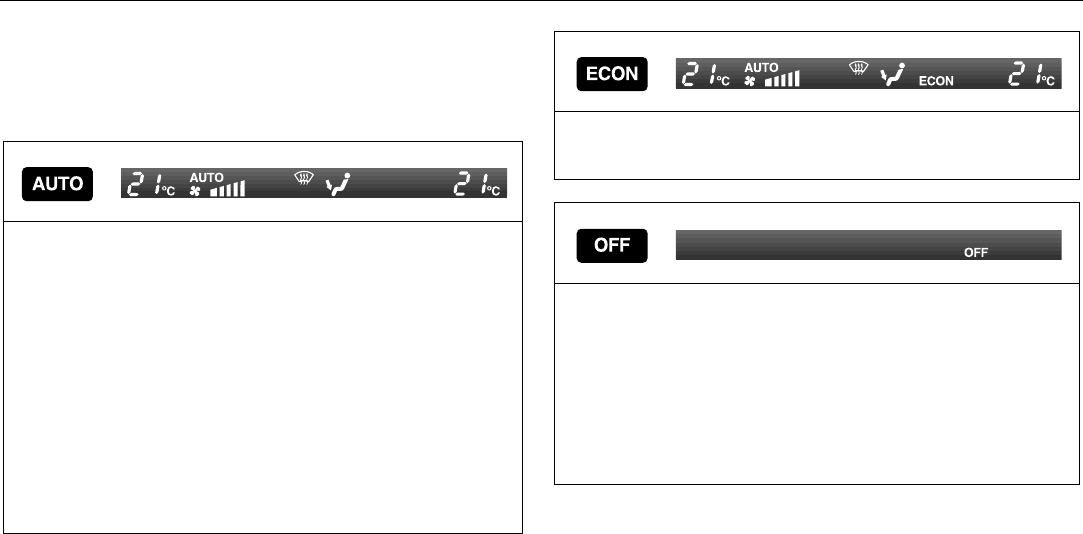
70 Instruments and controls
Functions
Pressing AUTO will cancel all manual settings.
If a manual function is selected it will be locked in but other functions
will be controlled automatically.
The selected temperature is always maintained automatically.
Temperature, air distribution, fan speed and
recirculation will all be controlled automatically.
In falling temperatures the A/C compressor is
switched off at 32°F (0°C).
In rising temperatures the A/C compressor is
switched on at 41°F (+5°C).
If at the start the outside air temperature is 32 - 41°F
(0 – +5°C), the A/C compressor is switched off.
• Pressing AUTO once will cancel all previous
manual selections.
• Pressing AUTO a second time will result in all the
automatically selected settings being displayed.
When the engine is started, the A/C system is in
AUTO mode, apart from any currently set program,
see page 73 and 74).
IB370
A/C compressor OFF.
No cooling of inlet air. Temperature, air distribution
and fan speed still under automatic control.
ACC system OFF.
Fan OFF.
A/C compressor OFF.
Warm air OFF.
Air-distribution selections locked in current settings.
Recirculation can be selected manually.
Pressing the AUTO button will put the system into
automatic mode.
Pressing the OFF button again will result in the sys-
tem reverting to any previous manual settings.
IB371IB372

71Instruments and controls
The rear-window and door-mirror heating is
controlled manually.
Switch off the heating as soon as the rear window
is clear, to avoid imposing a heavy load on the bat-
tery longer than necessary. Note, however, that the
heating will go off automatically after 5-10 minutes
(depending on the outdoor temperature) or sooner
if the voltage in the electrical system falls below
10 V
.
The ACC system can be programmed to switch on
the heating automatically when the outdoor temper-
ature is below 41°F (+5°C) and the temperature
inside the car is below 50°F (+10°C) (see ”Program-
ming I and II”, on pages 73 and 74).
Recirculation is selected automatically for effective
cooling, but it can also be switched on/off manually.
Although recirculation does not substantially affect
the air quality, it is useful to prevent unpleasant
smells or fumes being drawn into the car from
outside.
IB373
IB374
To increase the fan speed in steps.
If, after being off, the ignition is switched on but the
engine is not started, the fan will run at low speed
until the engine is running.
To decrease the fan speed in steps.
If the fan is set to 0, the A/C compressor will cut out
and ECON will appear on the display.
If, after being off, the ignition is switched on but the
engine is not started, the fan will run at low speed
until the engine is running.
IB375IB376

72 Instruments and controls
Air distribution
Press once: Defrosting of all windows will take
place (air flow to rear side windows shut off) with:
• The fan running at high speed.
• Air being distributed to the defroster vents.
• Normal temperature control will operate.
• Recirculation will be OFF.
• Heating of the rear window and door mirrors will
be switched ON.
The defroster function will continue to operate until
a new selection is made, although the heating for
the rear window and door mirrors will be switched
off automatically after 5-10 minutes, depending on
the temperature outside.
Press twice: Air will be directed onto the windshield
with no increase in the fan speed. The heating for
the rear window will not be switched on.
To revert to the previous selection, press the AUTO
button.
ACC65
Defroster & floor vents
Floor vents and rear side windows
Floor & panel vents
ACC66
A
CC67
A
CC68
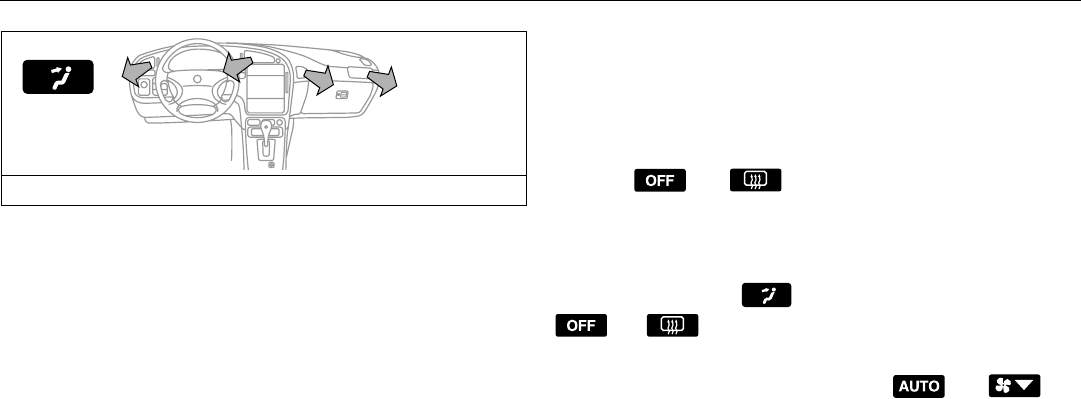
73Instruments and controls
Starting in cold weather
To start with, the system will automatically select the defroster set-
ting, maximum heat and low fan speed.
As the engine warms up, air will also be distributed through the floor
vents and the fan speed will be increased.
As the temperature inside the car nears the selected value, both the
fan speed and the heat will be decreased to a level determined by
the system.
Starting in hot weather
The system will automatically distribute air through the panel vents
at high fan speed and will switch on the A/C compressor (unless the
ECON switch has been pressed).
If the outdoor temperature is above 86
°
F (30°C), the system might
select recirculation after approximately 45 seconds if this is required
in order to reach the desired temperature.
As the temperature inside the car nears the selected value, the fan
speed will be decreased to a value determined by the system.
Programming I
Manual selections can be programmed into the ACC system so that
these will take effect when the car is started. Note that the ignition
must be switched off for at least ten minutes after programming for
the selections to be saved in the system’s memory.
1 Make sure the ignition is ON.
2 Select the desired settings.
3 Press and , simultaneously
(the display will flash to confirm that the settings have been
recorded).
Example: If you want air distribution through the panel vents when
you start the car, press and then save the setting by pressing
and .
Cancelling the programmed settings (I)
To cancel the programmed settings, press and
simultaneously (the display will flash to confirm that the settings
have been cancelled).
Panel (and center rear vent)
A
CC69

74 Instruments and controls
Programming II
It is also possible to customize the ACC system, e.g. to adapt to
driving and weather conditions.
To program a function or to cancel a programmed function, press
and hold in the relevant button until the corresponding symbol has
flashed four times on the display and a chime has sounded.
Make sure the ignition is ON.
Example: To have the ACC system switch the heating for the rear
window and door mirrors ON/OFF automatically, press and hold in
until the symbol has flashed four times on the display and a
chime has sounded.
Function Operation in AUTO mode
after Programming II Standard operation
in AUTO mode
The A/C compressor will not
cut in unless the outdoor
temperature is above 55
°
F
(+13°C).
–This function saves fuel by
delaying the cutting-in of the
A/C compressor. However,
in wet weather it is advisable
to have the A/C compressor
running when outdoor tem-
peratures are below
57°
(+14°C), as the A/C system
reduces the likelihood of the
windows’ misting up.
A/C compressor cuts
in when outdoor tem-
perature is above 41
°
F
(+5°C)
Recirculation will be
switched on if the speed of
the car is less than 6 mph (10
km/h) and will be switched off
when the speed has risen
above 20 mph (30 km/h), but
not if the ECON mode has
been programmed according
to "Programming II".
–This function is useful to
prevent fumes being drawn
into the car in traffic jams.
Recirculation is
switched on about
45 seconds after start-
ing if the outdoor tem-
perature is above 86
°
F
(+30°C) and the
selected temperature
for the cabin is well
below the actual tem-
perature in both tem-
perature zones.
The heating will come on
about five seconds after the
engine has started if the out-
door temperature is below
41
°
F (+5°C).
–This function helps to pre-
vent ice or mist forming on
the rear window in cold,
damp weather. Fuel con-
sumption may increase
slightly.
Rear-window heating
can only be switched
on manually.
Function Text displayed on SID
during programming Text displayed on SID
when cancelling
program
ACC: LO TEMP
A/C CTRL ACC: NORMAL
A/C CTRL
ACC: RECIRC
ACC: SPEED CTRL ACC: RECIRC
ACC: NORMAL CTRL
ACC: AUTO
RDEFR CTRL ACC: MANUAL
RDEFR CTRL

75Instruments and controls
The display shows:
ACC: AUTO
RDEFR CTRL
Once a function has been recorded under ”Programming II”, it will
remain in the system until you cancel the program.
AUTO will still show on the display after a function has been saved
in ”Programming II”.
A range of additional functions can be reprogrammed in
the ACC system, although this can only be done by an
authorized Saab dealer, see page 237.
Calibration
If the battery has been disconnected or has run flat, the system will
need to be recalibrated.
To start the calibration procedure:
1 Start the engine.
2 Press and simultaneously.
Calibration takes about 30 seconds. During this time and for about
3 seconds after the operation has been completed, the number of
fault codes (if any) stored in the system will appear in the tempera-
ture display on the left. The fault codes themselves will be shown in
the temperature display on the right.
Useful tips
(Before driving the car to an authorized Saab dealer)
• If AUTO is not shown on the display, see ”Cancelling the pro-
grammed settings (I)” on page 73.
• If you suspect that the ACC system is not functioning properly,
cancel (delete) all programmed settings and then recalibrate the
system.
See ”Cancelling the programmed settings (I) and (II)”, pages 73
and 74, and ”Calibration” above.
Note that AUTO will show on the display even if you have com-
pleted Programming II, but that this does not apply to Program-
ming I.
• If the battery has been disconnected or has run flat, the ACC
system will need to be recalibrated. See ”Calibration” above.

76 Instruments and controls
Condensation
When the A/C system is running, the intake
air is dehumidified, and the resultant con-
densation is drained off through two outlets
underneath the floor of the car, in the vicinity
of the front doors.
It is therefore perfectly normal for water to
be seen dripping from these outlets when
the car is parked. Greater amounts of con-
densation will result in warmer, more humid
ambient air.
Formation of ice and mist in
extremes of weather
It is only in the most extreme conditions that
icing and misting of window glass are likely
to be a problem, e.g. in torrential rain or
severe cold coupled with high relative
humidity, or when passengers are perspir-
ing heavily or wearing wet clothes.
The following measures are recommended
if such problems should occur:
1 Select AUTO and 70
°
F (21°C) for both
temperature zones.
2 Select Defroster.
If this is not enough...
3 Increase the fan speed.
If this is not enough...
4 Select a higher temperature.
The following measures are recommended
if the occupants feel that it is cold and drafty
in the car:
1 Make sure that all the air vents are fully
open, including the center rear vent.
If this is not enough...
2 Direct the air flow away from the body.
If this is not enough...
3 Raise the temperature setting a degree
or two. If this is not enough...
4 Lower the fan speed.
Fault diagnosis and maintenance,
see page 206.
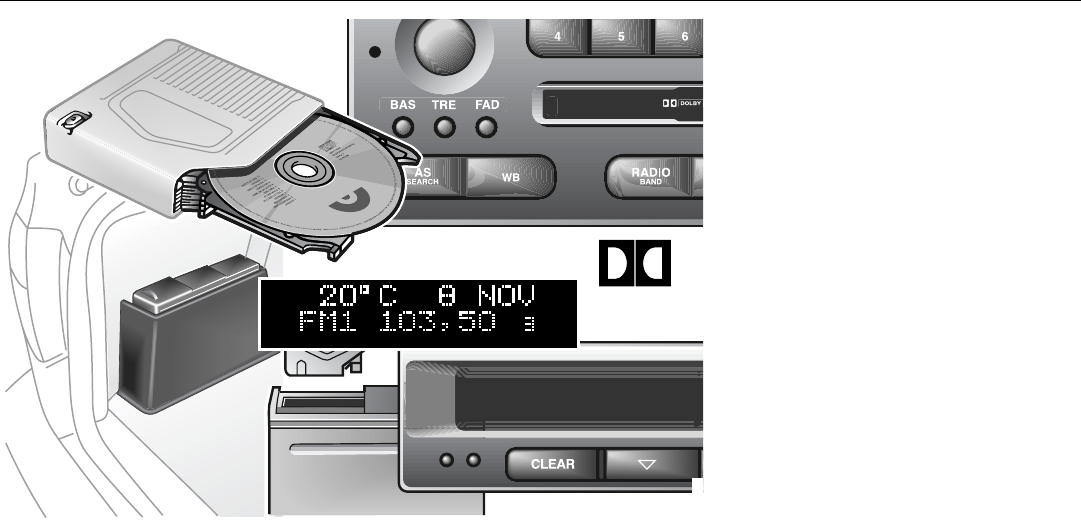
77Saab 9-5 Audio System
Saab 9-5 Audio
System
Quick guide to the Saab 9-5
Audio System ................... 79
Sound controls................... 81
Radio................................... 82
Cassette player .................. 84
CD player ............................ 87
CD changer......................... 89
General functions .............. 93
Steering-wheel controls.... 94
Security lock....................... 94
Technical data.................... 95
Installation of car phone
(option).............................. 98
Fault codes......................... 99
IB1198

78 Saab 9-5 Audio System
To get the best out of your Saab 9-5 Audio
System, we recommend that you read
through this entire section.
The Saab 9-5 Audio System is available in
two versions: Premium on the 9-5 and Pres-
tige on the 9-5 SE (Prestige system is also
available as an option on the 9-5 S model.)
Both models have been specially matched
to the Saab 9-5 cabin.
The two models are comprised of a radio,
CD player and cassette player.
A six-disc CD changer for installation in the
luggage compartment is available as a
dealer-installed accessory/option.
The Premium model has seven speakers:
three mounted in the fascia (the center
speaker further enhances the overall sound
image) and one in each door.
The Prestige model (Harman/Kardon) has
nine speakers (9-5 Wagon has eight speak-
ers): three mounted in the fascia (the center
speaker further enhances the sound
image), one in each door and two subwoof-
ers in the rear window shelf (9-5 Wagon:
one subwoofer in the luggage compart-
ment). The subwoofers enhance reproduc-
tion of the lowest base notes.
The Audio System is connected to the Saab
Information Display (SID), which is at the
top of the main instrument panel. Mes-
sages, indicators and the like for the Audio
System are shown on this display.
Indicator
AS Radio is in Autostore mode
RDM Random playback of CD
tracks when CD player
selected
(DOLBY B/C)
DOLBY B/C noise reduction
on for cassette player

79Saab 9-5 Audio System
Quick guide to the
Saab 9-5 Audio System
Radio (see page 82)
ON
To switch the system ON, press the volume but-
ton. The last settings used will be activated.
If the Audio System is switched on when the igni-
tion key is not in the switch, the system will auto-
matically be switched off after one hour has
elapsed since a control button on the radio was
last pressed.
OFF
To switch the system OFF, press the volume but-
ton or remove the ignition key.
VOL
To adjust the volume, rotate the VOL control.
BAL
To adjust the balance between the left and right
channels, pull out and turn the VOL control.
BAS
Press to release the button, and adjust the base
level. Lock the setting by pushing the button in.
TRE
Press to release the button, and adjust the tre-
ble. Lock the setting by pushing the button in.
FAD
Press to release the button, and adjust the fade
between the front and rear sets of speakers.
Lock the setting by pushing the button in.
VOL BALON PULLPUSH
TRE FADBAS
Preset station buttons
Press once: play the preset station.
Press & hold briefly: store a new station.
Auto tuning
Press once: auto (seek) tuning.
Press & hold briefly: manual tuning.
Press once: Autostore ON/OFF.
Press & hold briefly: automatic tuning and
storing of the 6 strongest stations.
Press once: change waveband.
Press once: activate Weather Band.
213
546
SEEK
AS
SEARCH
RADIO
BAND

80 Saab 9-5 Audio System
Cassette player. See page 84
CD player. See page 87
CD changer (accessory/option). See page 89
Press once: Selects cassette player when
other source active.
When tape playing: Dolby B/C ON/OFF.
Switch to playback other side of tape.
Eject.
Press once: Music search (next track).
Press & hold briefly: Fast forward/rewind.
Press SEEK (mid-segment): Blank skip
ON/OFF.
Press once: switch to CD player when other
source active.
Press & hold briefly: Random playback.
Press once: Track search.
Press & hold briefly: Rapid play (passage
search) or Fast track search.
Press SEEK (mid-segment) once: Switches
between Rapid play (PLAY) and Fast track
search (TRACK).
Press SEEK (mid-segment) & hold briefly:
Scan disc.
SEEK
CD
RDM
SEEK
Remove CD.
Press once: Change to CD changer when CD
player is active.
Press twice: Change to CD changer when radio
or cassette player is active.
Press & hold briefly: Random playback of
entire magazine.
Press once: Track search on current disc.
Press & hold briefly: Rapid play.
Press SEEK (mid-segment) once: Switch
between Rapid play (PLAY) and Fast track
search (TRACK).
Press SEEK (mid-segment) & hold briefly:
Scan/disc.
Press SEEK (mid-segment) & hold
(2 chimes): Scan/magazine.
Selects disc in magazine.
CD
RDM
SEEK
213
546
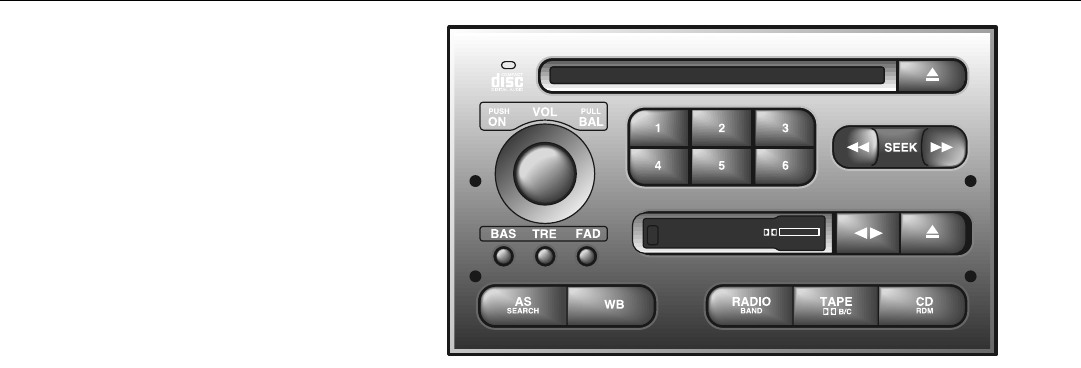
81Saab 9-5 Audio System
Sound controls
ON/OFF
The Audio System will come on:
• When the volume control is pressed.
• When the ignition is switched ON, if the
Audio System was on when the ignition
key was last removed.
The Audio System will be switched off:
• When the volume control is pressed.
• When the ignition key is removed.
• One hour after the ignition was switched
OFF, if the ignition key has not been
removed.
• When one hour has elapsed since a con-
trol button on the Audio System was last
pressed after the ignition key was
removed. VOL - Volume
BAL - Balance
Pull out and rotate the VOL control to adjust
the balance between the left and right
speakers. When the control is released, it
reverts to the volume function.
BAS/TRE/FAD controls:
Rotate clockwise to increase the level and
counterclockwise to reduce it.
BAS - Bass
TRE - Treble
FAD - Fader
The fader control adjusts the balance
between the front and rear sets of speakers.
The Bass, Treble and Fader controls must
be pressed first to release them.
IB1154
DOLBY B NR

82 Saab 9-5 Audio System
Radio
Press the RADIO/BAND button (3) to switch
to the radio when another source is active.
Preset station buttons (1)
Press once (release within a second) to
select a preset station, e.g.
The small figure on the far right of the dis-
play is the number of the preset button
selected.
Presetting a station
Press and hold in the desired button (for
more than a second) to store the currently
tuned station. During this time, the radio will
be mute. The sound will return as soon as
the station has been stored.
Tuning (2)
Automatic seek tuning:
Press SEEK >> briefly to search for higher
frequencies or << SEEK for lower frequen-
cies.
Manual tuning:
To switch to the manual-tuning function,
press SEEK >> or << SEEK and release
quickly (a chime will sound and the M indi-
cator will appear on the display).
The function will revert to automatic seek
tuning two seconds after the last manual fre-
quency change has been made.
Waveband selector (3)
Press the RADIO/BAND button repeatedly
to move through the waveband selections:
FM1, FM2, and AM.
AS, Autostore (4)
The autostore mode provides an additional
preset function that can be used to search
for and to store stations when you are in an
area where you are unfamiliar with the sta-
tions and their frequencies.
Press the AS/SEARCH button to switch the
Autostore mode ON/OFF. When the
Autostore mode is ON, the AS indicator will
show at the bottom of the display.
IB1088

83Saab 9-5 Audio System
Press and hold in the AS/SEARCH button
for more than a second to initiate a search
for the six strongest stations.
Each time the system finds and stores a sta-
tion, the number on the far right of the dis-
play will change. If the system cannot find
six stations with good reception, the remain-
ing preset buttons will be empty. If one of
these empty buttons is pressed, U**** (FM)
or AM**** will appear on the display.
When the system leaves the AS mode, it
returns to the station that was selected
before the AS mode was activated.
The AS mode can also be used in the AM
band.
WB (Weather Band) (5)
Press the WB button to select the Weather
Band mode. The radio will automatically
search for the strongest national weather
service station in the area. When a weather
band station is received, the display indi-
cates "WB". The strongest station generally
provides the most accurate information for
the area in which you are travelling.
To exit the Weather Band mode, depress
the WB button again. Weather Band recep-
tion is available in CD, TAPE and RADIO
mode. If the radio is unable to find a suffi-
ciently strong station to lock onto, the unit
will continue to search and the display will
indicate "NO WB".
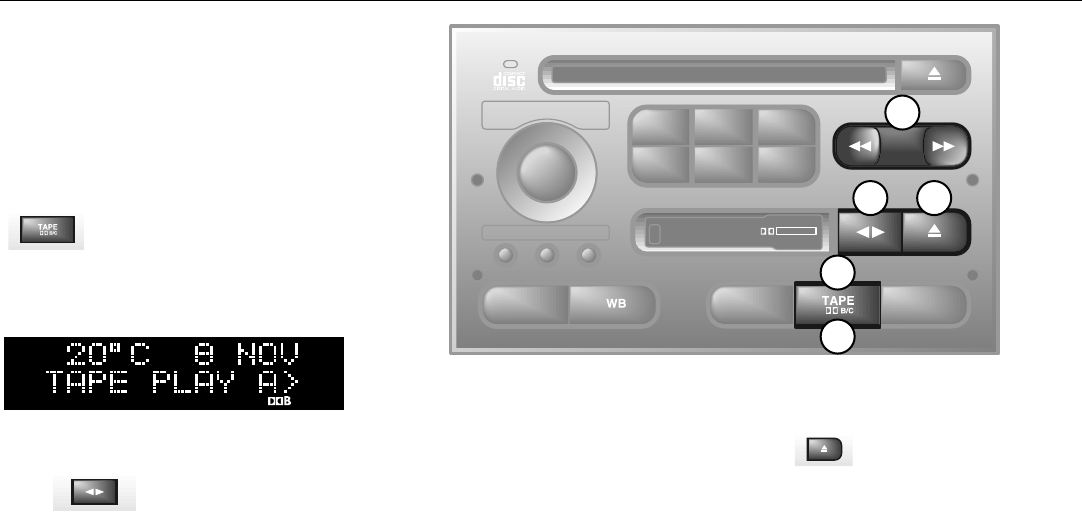
84 Saab 9-5 Audio System
Cassette player
Before playing a tape, make sure that the
label is secure and that the cassette is not
warped, otherwise the cassette can
become jammed in the deck. The cassette
player senses automatically whether the
tape is normal or metal (Type I or Type II).
TAPE (1)
Turn on the cassette player by pressing
or by inserting a cassette in the
deck, with the exposed tape to the right.
Playback will start with the side that is facing
up (indicated by A on the display). The dis-
play will now be as follows:
Playback direction (2)
To play the other side of the tape,
press .
The deck will automatically change the play-
back direction when the end of the tape is
reached, be it during playback, fast
forward/rewind or music search.
Dolby® noise reduction (3)
Press TAPE/DOLBY to switch on Dolby NR
B/C.
Dolby B/C should be on for playback of
tapes recorded with Dolby B/C, and off for
those recorded without Dolby B/C.
Eject button (4)
To stop playback of a tape, press the eject
button or select another source.
If you select another source without press-
ing the eject button, the tape will remain in
the deck but the head and pinch rollers will
be clear of the tape. The same applies if the
Audio System is switched off while a tape is
being played. Tapes can still be ejected
when the system is turned off.
IB1090
VOL
TRE
BALON
FADBAS
PULLPUSH
CD
RDM
RADIO
BAND
AS
SEARCH
213
546
DOLBY B NR
SEEK
3
5
2 4
1
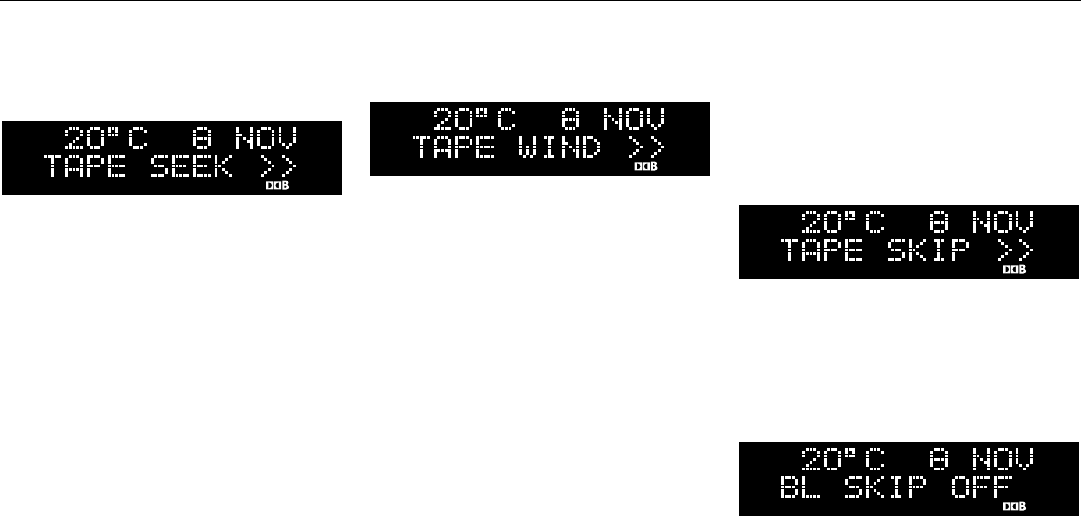
85Saab 9-5 Audio System
Music search forward/reverse (5)
To search forward for a track, press
SEEK >> and release quickly (within half a
second). The following will now appear on
the display:
To perform a backward search, press
<< SEEK instead.
A forward search will continue until a gap of
at least 4 seconds is found, or until you
press SEEK >> or SEEK (mid-segment).
Pressing and holding the button during a
search will initiate the fast-forward function.
Fast forward/rewind
Press and hold SEEK >> to start fast-
forward to the end of the tape. The following
will now appear on the display:
Press SEEK >> once to cancel fast-for-
ward.
Press and hold SEEK briefly to switch to
music search.
Fast rewind (<< WIND) is performed in the
same way as fast forward.
Auto music search (Blank skip)
To switch the Blank-skip function ON/OFF,
press and hold SEEK (mid-segment).
When the Blank-skip function is active (dis-
play: BL SKIP ON), unrecorded gaps that
are longer than 15 seconds will automati-
cally be skipped.
When auto music search is in progress, the
following will show on the display:
If a track has been recorded at an unusually
low level and is therefore identified incor-
rectly as a gap between tracks, it could ini-
tiate a spurious “auto music search.
To cancel such a search, press and hold
SEEK (mid-segment) during playback. The
following will now appear on the display:

86 Saab 9-5 Audio System
Type II (metal) tapes
The cassette has an automatic tape-type
selector.
Cleaning-due indicator
After 30 hours’ playing time, the following
message will appear on the display:
The message will be displayed for ten
seconds each time the cassette player is
selected.
A cleaning tape should be used to clean the
heads inside the cassette player to maintain
good reproduction and to prevent unneces-
sary wear.
To reset the playing-time meter:
1 Remove the current tape.
2 Load the cleaning tape and play it for the
required time.
3 Remove the cleaning tape and reload
the other one.
Tape care
Do not expose cassette tapes to direct sun-
light or to extremes of temperature as this
can damage the cassette and the tape.
Always keep cassettes in their boxes when
not in use.
If a cassette should become jammed in the
deck, seek help from an authorized Saab
dealer.

87Saab 9-5 Audio System
CD player
To select the CD mode, load a CD into the
deck or, if one is already loaded, press the
CD/RDM button.
Insert the CD, label-side up, and allow the
mechanism to load it automatically. Play-
back of the first track will start and the follow-
ing message will appear on the display:
A tiny, amber-colored LED indicator to the
left of the disc tray is illuminated when a disc
is loaded.
When all the tracks have been played, the
CD player will restart playback from track 1.
To cancel playback, press the eject, RADIO
or TAPE button.
Track search (1)
Press << SEEK or SEEK >> repeatedly to
move to preceding or following tracks.
Pressing << SEEK once will restart play-
back from the beginning of the current track.
Thus, to play the preceding track, press
<< SEEK twice.
Rapid play (passage search)
When << SEEK or SEEK >> is pressed and
held, rapid play will be initiated, with the time
and track showing on the display, e.g.:
If the button is depressed for more than
5 seconds, the rapid play will be even faster.
Rapid play stops when the button is
released.
NOTE
Do not use writeable CDs in your Audio
System, as in certain cases these types of
CD are only suitable for home use and
can therefore cause operational prob-
lems.
IB1096
VOL
TRE
BALON
FADBAS
PULLPUSH
CD
RDM
RADIO
BAND
AS
SEARCH
213
546
DOLBY B NR
SEEK
2
1
3

88 Saab 9-5 Audio System
Fast track search
Press SEEK (mid-segment) once to switch
between the CD-PLAY and CD-TRACK
modes.
The CD-PLAY and CD-TRACK modes
change the function of << SEEK and
SEEK >>. The selected mode will also be
active the next time the system is switched
on. Choose the mode that you find most
convenient:
Random playback (RDM) (2)
Press and hold the CD/RDM button to
select/deselect random playback of the cur-
rent disc. When this function is selected,
RDM will appear at the bottom of the dis-
play.
Press SEEK >> once to move from the cur-
rent track to the next during random play-
back.
Press << SEEK once to repeat the current
track during random playback.
Pressing and holding << SEEK or >> SEEK
will start Rapid play.
SCAN
To start the SCAN function, which enables
you to hear a sample of each track on the
disc, press and hold SEEK (mid-segment).
The display shows that SCAN is in progress
and which track is currently being sampled.
For instance, if you started SCAN while
playing the first track, the following display
will appear:
The sample playback starts 30 seconds
after the start of the track and lasts for 8 sec-
onds.
When all the tracks on the disc have been
scanned, the system will revert to playback
of the track that was playing when SCAN
was selected.
Press any segment of the SEEK button
during scanning to play the current track
from the beginning and simultaneously
cancel the SCAN function.
Eject (3)
Press to remove the disc.
If you press the eject button to open the tray
but do not remove the disc, the CD player
will automatically close the tray again after
10 seconds, without restarting playback.
CD PLAY Pressing and holding
<< (SEEK) or >> (SEEK)
briefly starts Rapid play
CD TRACK Pressing and holding
<< (SEEK) or >> (SEEK)
briefly starts Fast track
search

89Saab 9-5 Audio System
CD changer
(accessory)
Important! Always keep the sliding cover
closed to keep dust out of the CD changer,
so that it will continue to provide satisfactory
service for a long time.
To load the CD changer (which is installed
in the luggage compartment and can
accommodate six CDs) proceed as follows:
1 Slide the top right back.
2 Lift out the CD magazine.
3 Press back the catch on the magazine.
4 Withdraw one CD tray at a time and
swap/load the CD (label side up). Slide
the tray back into the magazine.
Note the position of the magazine for load-
ing (see picture).
Insert the entire magazine carefully inside
the CD changer and slide back the cover.
To select the CD changer
• If the Audio System is in the RADIO or
TAPE mode, press the CD/RDM button
twice.
• If the CD player is active, press the
CD/RDM button once.
If the CDs in the magazine have not been
changed, the system will start playback
from where it left off before.
If there is no magazine in the CD changer,
the following will appear on the display:
NOTE
Do not use writeable CDs in your audio
system, as in certain cases these types of
CD are only suitable for home use and
can therefore cause operational prob-
lems.
IB383
4
3
Changing a CD
IB1341
2
1
CD changer in luggage compartment,
Saab 9-5 Sedan
IB1208
CD changer in luggage compartment,
Saab 9-5 Wagon

90 Saab 9-5 Audio System
If the magazine in the CD changer is empty,
the following will appear on the display:
If the CD changer is activated right after a
magazine has been loaded, the following
will appear on the display:
The CD number will change as each CD is
played.
After a magazine has been loaded, play-
back will start with the first track on the first
CD when the CD changer is selected, and
the following will appear on the display: Selecting CDs (1)
When the CD changer is operating, the
radio preset buttons work for the six CDs in
the magazine. Press the button for the
corresponding CD.
If the selected CD is already being played,
playback will restart from the first track.
If the selected CD-tray is empty, the follow-
ing will appear on the display:
IB1104
VOL
TRE
BALON
FADBAS
PULLPUSH
CD
RDM
RADIO
BAND
AS
SEARCH
213
546
DOLBY B NR
SEEK
3
12
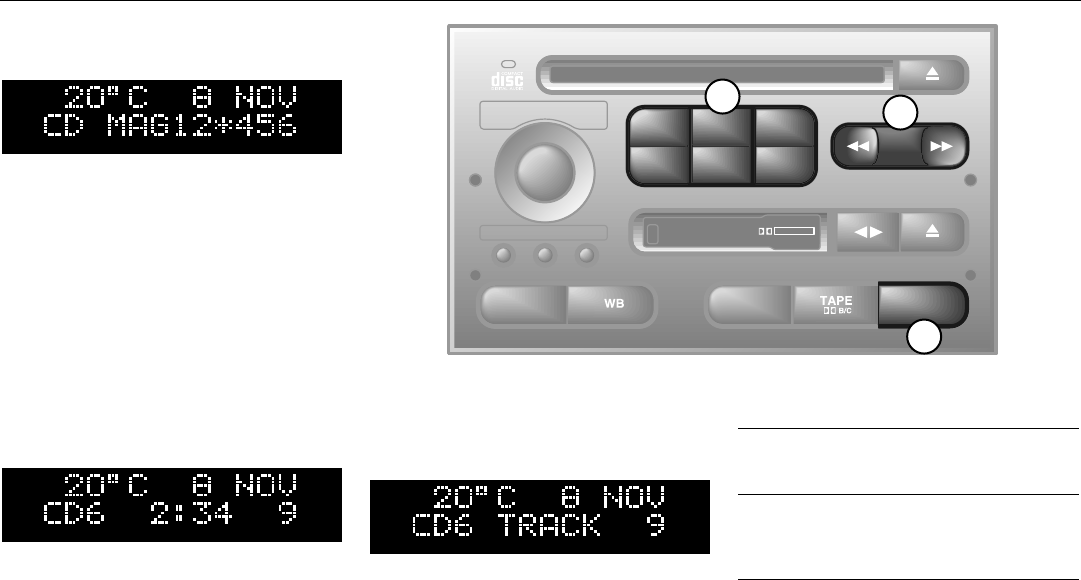
91Saab 9-5 Audio System
After two seconds, the status of the trays in
the magazine (i.e. loaded or empty) will be
shown on the display, e.g.:
If for some reason the CD selected by the
preset button cannot be played, playback of
the current CD will continue.
Track search (2)
Press << (SEEK) or (SEEK) >> repeatedly
to move to preceding or following tracks.
Pressing << (SEEK) once will restart play-
back from the beginning of the current track.
Thus, to play the preceding track, press
<< (SEEK) twice.
Rapid play
When << (SEEK) or (SEEK) >> is pressed
and held, rapid play will be initiated, with the
time and track showing on the display, e.g.:
If the button is depressed for more than
5 seconds, the rapid play will be even faster.
Rapid play stops when the button is
released.
Fast track search
Press SEEK (mid-segment) once to switch
between the CD-PLAY and CD-TRACK
modes.
The CD-PLAY and CD-TRACK modes
change the function of << (SEEK) and
(SEEK) >>. The selected mode will also be
active the next time the system is switched
on.
Choose the mode that you find most
convenient:
CD PLAY Pressing and holding
<< (SEEK) or >> (SEEK)
briefly starts Rapid play
CD TRACK Pressing and holding
<< (SEEK) or (SEEK) >>
briefly starts Fast track
search
IB1104
VOL
TRE
BALON
FADBAS
PULLPUSH
CD
RDM
RADIO
BAND
AS
SEARCH
213
546
DOLBY B NR
SEEK
3
12

92 Saab 9-5 Audio System
SCAN
Scanning the current CD:
To start the SCAN function, which enables
you to hear a sample of each track on the
disc, press and hold SEEK (mid-segment).
The display shows that SCAN is in progress
and which track is currently being sampled.
For instance, if you started SCAN while
playing track one, the following display will
appear:
The sample playback starts 30 seconds
after the start of the track and lasts for 8 sec-
onds.
When all the tracks on the disc have been
scanned, the system will revert to playback
of the track that was playing when SCAN
was selected.
Press any segment of the SEEK button
during scanning to play the current track
from the beginning and simultaneously
cancel the SCAN function.
Scanning the entire magazine:
Press and hold SEEK (mid-segment - two
chimes) to start a scan of the entire maga-
zine. A message similar to the following will
appear on the display:
The sample playback starts 30 seconds
after the beginning of the first track on each
CD and lasts for 8 seconds.
After the first track of each CD has been
sampled, the CD changer will revert to play-
back of the track that was playing when
SCAN was selected.
Press any segment of the SEEK button
during scanning to play the current track
from the beginning and simultaneously
cancel the SCAN function.
Random playback (RDM) (3)
Press and hold the CD/RDM button to
select/deselect random playback of the
CDs in the magazine. When this function is
selected, RDM will appear at the bottom of
the display.
Press (SEEK) >> once to move from the
current track to the next during random play-
back.
Press << (SEEK) once to repeat the current
track during random playback.
Pressing and holding << (SEEK) or
>> (SEEK) will start Rapid play.
To stop playback from the CD changer,
simply select once to move from the current
track to the next during random playback
(RADIO/TAPE/ CD). The CD changer will
now enter stand-by mode.
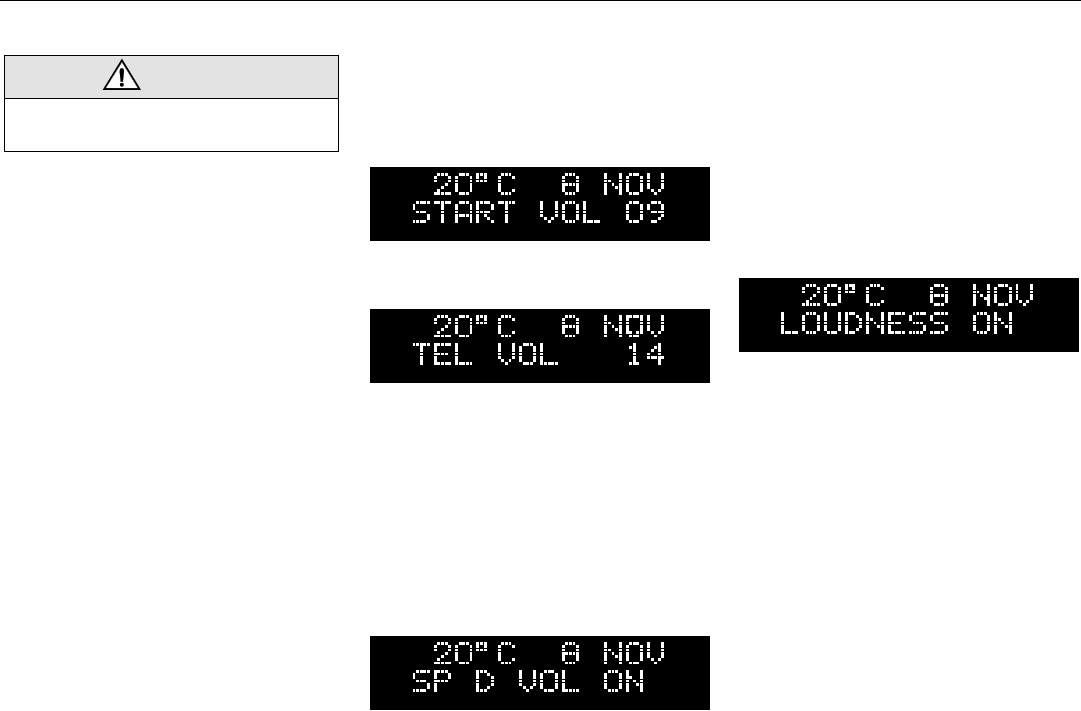
93Saab 9-5 Audio System
General functions
Volume-preset mode
To select the volume-preset mode, press
and hold the WB button at the same time as
you switch the Audio System on.
Use the << SEEK >> button to select the
desired function.
The following volume settings can be
preselected:
•STARTVOL - maximum volume level
when the Audio System is switched on
• TEL VOL - preset volume level when an
in-car phone is activated
• SP D VOL - speed-dependent volume.
The Audio System will automatically
adjust the volume level to suit the back-
ground noise, such as road noise, occur-
ring while the car is under way.
• LOUDNESS ON/OFF - boosting of the
highest and lowest frequency ranges to
enhance the sound image when the
volume is set to a low level.
Adjusting the volume
The default setting for START VOL is
volume setting 9, and that for TEL VOL is
volume setting 14 (the highest volume set-
ting is 30).
•Maximum START VOL
•TELVOL
To change the volume setting:
– Press and hold the WB button at the
same time as you switch on the Audio
System.
– Adjust the volume
– Wait 10 seconds or press one of the but-
tons on the bottom row of the Audio Sys-
tem, e.g. RADIO/BAND, to save the new
volume setting.
Speed-dependent volume
(SP D VOL) ON/OFF
To change the default setting:
The default setting for this function is ON.
– Press and hold the WB button at the
same time as you switch on the Audio
System.
– Select SP D VOL using << SEEK >>
– Select ON/OFF using the VOL control.
– Wait 10 seconds or press one of the but-
tons on the bottom row of the Audio Sys-
tem, e.g. RADIO/BAND, to save the new
default setting.
Loudness ON/OFF
To change the default setting:
The default setting for this function is ON.
– Press and hold the WB button at the
same time as you switch on the Audio
System.
– Select LOUDNESS using << SEEK >>
– Select ON/OFF using the VOL control.
– Wait 10 seconds or press one of the but-
tons on the bottom row of the Audio Sys-
tem, e.g. RADIO/BAND, to save the new
default setting.
WARNING
These functions should only be carried
out when the car is stationary.
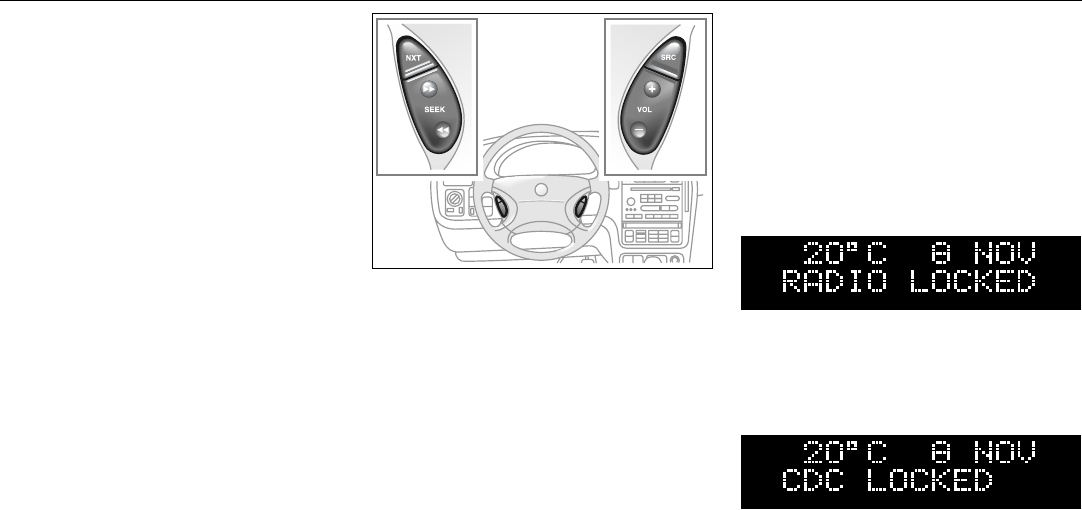
94 Saab 9-5 Audio System
Steering-wheel controls
To facilitate use of the Audio System and to
promote safer driving, most of the functions
can be operated using the integral remote
controls on the steering wheel.
Control functions:
NXT (NEXT):
RADIO mode: preselect buttons
1⇒2⇒...⇒ 6⇒1⇒...
TAPE mode: Play other side of tape.
CD mode: Inoperative.
CD-changer mode: Select CD in magazine
1⇒2⇒...⇒ 6⇒1⇒...
<< SEEK >>:
RADIO mode: Auto/manual tuning.
TAPE mode:
Music search/Fast forward or rewind.
CD/CD-changer mode:
Track search/Rapid play.
SRC (source)
Press repeatedly to switch between
RADIO ⇒ TAPE ⇒ CD ⇒ (CD changer)
⇒RADIO ⇒...
VOL +/-:
Volume adjust.
Security lock
The Audio System is equipped with an elec-
tronic security lock. The special code is
unique to the car in which the Audio System
is fitted.
Each time the Audio System is switched on,
a check is made to ensure that the codes
match.
If not, the following will appear on the dis-
play:
If a CD changer has been installed, it will
also have been security coded.
If the security code for the CD changer does
not match when the changer is selected, the
following will appear on the display:
If a CD changer is to be retrofitted or if you
wish to move the main Audio System
module and/or CD changer to another car
(Saab 9-5), you
must
consult an authorized
Saab dealer so that the modules can be
given the correct security codes.
IB385
Audio System controls on steering wheel

95Saab 9-5 Audio System
Technical data
• These specifications comply with the new IHF Standard
• Since the policy at Saab is one of continual improvement, we retain the right to alter
specifications and design without prior notice.
• Dolby noise reduction is produced under licence from Dolby Laboratories Licensing
Corporation
• ”Dolby” and the double-D symbol are trademarks of Dolby Laboratories Licens-
ing Corporation
Changes or modifications not expressly approved by the manufacturer for compliance
could void the user´s authority to operate the equipment.
Tone controls
Bass ______________________ ±10 dB at 100 Hz
Treble _____________________ ±10 dB at 10,000 Hz
Power output
Premium __________________ 150 W
110 W at 1% THD (total har-
monic distortion) and 13.5 V
Prestige __________________ 200 W
150 W at 1% THD (total har-
monic distortion) and 13.5 V
Radio module
Radio system _______________ PLL dual-synthesizer tuner
Number of presets:
FM ______________________ 3 x 6
AM ______________________ 2 x 6
Frequency range:
FM ______________________ 87.9 – 107.9 MHz
MW ______________________ 530 – 1710 kHz
WB ______________________ 162.40 – 162.55 MHz
Tuning steps:
Automatic seek tuning: _______ FM 200 kHz
AM 10 kHz
WB 50 kHz
Manual tuning: _____________ FM 200 kHz
AM 10 kHz
Frequency range (FM) ________ 40-15000 Hz
±1 dB
Distortion (FM) ______________ < 0.5%
Cassette player
Fast forward/rewind __________ < 120 seconds (C-60)
Frequency range _____________ 40 – 16000 Hz
±2 dB
Wow and flutter ______________ 0.2% WRMS
Signal-to-noise ratio __________ 45 dB
Dolby B/C NR effect __________ 8/16 dB
CD player and CD changer
1-bit system and 8 x oversampling
Frequency range _____________ 20-20000 Hz
±0.5 dB
Distortion __________________ < 0.008%
Dynamics __________________ > 80 dB (1 kHz)
CD-changer capacity__________ 6 discs
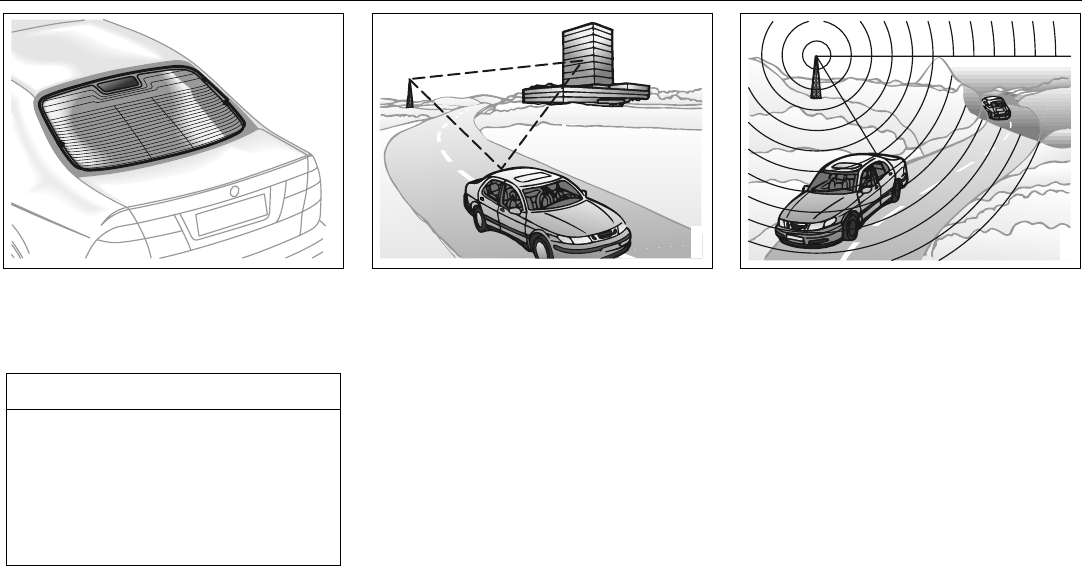
96 Saab 9-5 Audio System
Antennas
The Audio System has three antennas
incorporated in the rear window; two for FM
diversity and one for AM.
Fitting a car-phone antenna on the rear
window can cause interference to radio
reception.
Multipath propagation
Multipath propagation occurs when radio
waves from an FM transmitter are reflected
by, e.g. large buildings, causing them to
arrive slightly later than the direct waves.
This can create interference to radio recep-
tion. To avoid this problem as much as pos-
sible the system is equipped with two FM
antennas, so called FM diversity.
Shadow effect
Because FM radio waves travel in straight
lines from the transmitter, a shadow effect
can occur when tall buildings or hills
obstruct the propagation path from the
transmitter to the car.
NOTE
Refrain from placing hard or sharp
objects on the rear parcel shelf, to avoid
damaging the antenna leads.
Do not use sun protective film which con-
tains metal particles on the rear window,
this can be the cause of radio interfer-
ence.
IB386
IB389
IB387

97Saab 9-5 Audio System
Sources of FM interference
Interference to FM reception can be caused
by the electrical systems in other vehicles,
particularly if the signal from the transmitter
is weak.
Cross-modulation
When the radio is tuned to a weak transmit-
ter in the vicinity of a stronger one, the car’s
antennas will receive signals from both.
Such interference is apparent when the
unwanted broadcast can be heard faintly in
the background.
Radio waves, FM/AM
FM radio waves radiate in straight lines from
the transmitter. Because such waves do not
follow the curvature of the Earth, their
strength becomes weaker the further they
travel.
AM waves, on the other hand, are reflected
off the ionosphere, thus greatly extending
their range.
IB391
IB390
IB388
AMFM
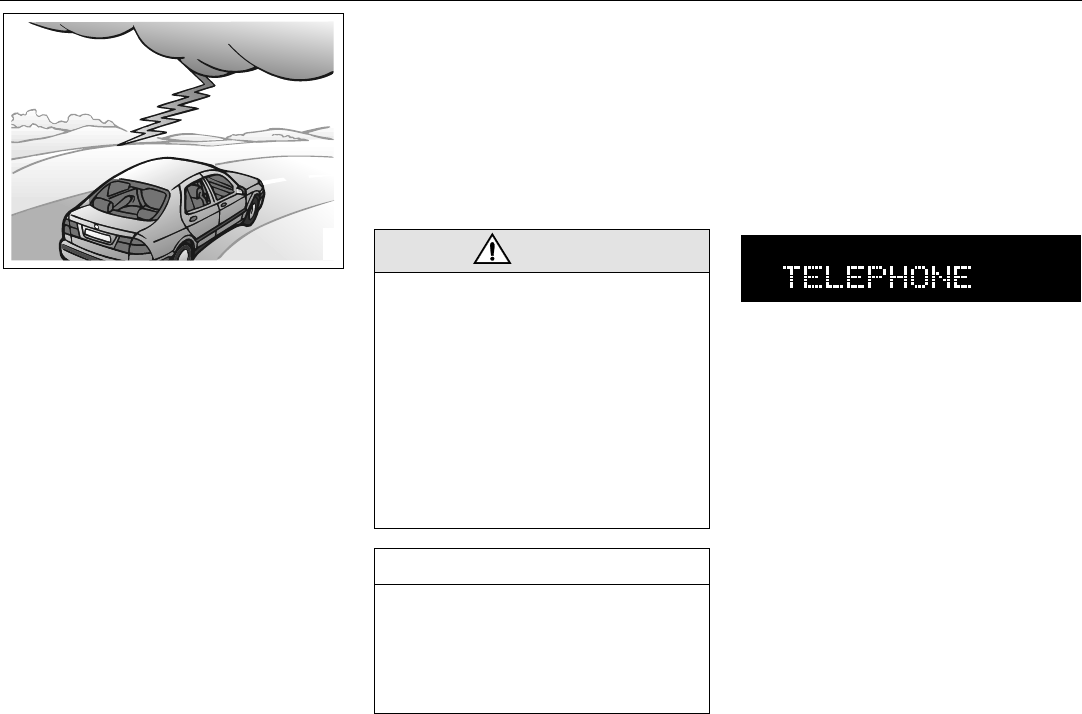
98 Saab 9-5 Audio System
Sources of AM interference
AM reception is prone to interference, e.g.
from electrical systems on other vehicles,
high-tension power lines and lightning.
Adjusting the frequency steps North
America/Europe
If the car is taken from Europe to North
America, the radio’s frequency steps can be
adjusted.
• Press and hold SEEK (mid-segment) and
switch the radio on at the same time.
The preset stations will be cancelled and
replaced by default frequencies.
Installation of car phone
(option)
Provision has been made on the Saab 9-5
for the installation of a hands-free car
phone.
A car-phone mount is available as an acces-
sory.
Your Saab dealer has details of proper
phone installation procedures.
Provision for hands-free phone
• Car phone connects to car’s circuitry.
• Microphone for hands-free phone use
incorporated in overhead panel at front.
• Audio System mute function when phone
activated.
• Phone conversation amplified through
Audio System speakers.
• TELEPHONE appears on the SID when
phone in use.
• Volume level for ongoing conversation
can be adjusted by volume controls on
steering wheel or on Audio System
module (see also ”Volume-preset mode”,
page 93).
• If the sound is distorted, adjust by means
of the volume control on
telephone set
.
• Phone battery charging when phone is in
its cradle.
Please refer to the instructions supplied with
the phone for details of how to make and
receive calls. In order to fully utilize the
hands-free function, certain circuits must be
available from the telephone to be installed.
Your authorized Saab dealer has this infor-
mation available.
WARNING
To prevent crashes while using a cell
phone:
• Don’t use the phone in distracting traf-
fic situations. Turn it off if traffic is
heavy.
• Dial sensibly, at a stoplight or safely off
the road.
• Consider installing hands-free or
speaker phone.
• Avoid stressful and intense phone
conversations.
NOTE
The A-pillar area (area beside the wind-
shield) and the headlining of your Saab
contain padding designed to reduce head
injuries. No modifications to these areas
should be made unless done by your
authorized Saab dealer.
IB392
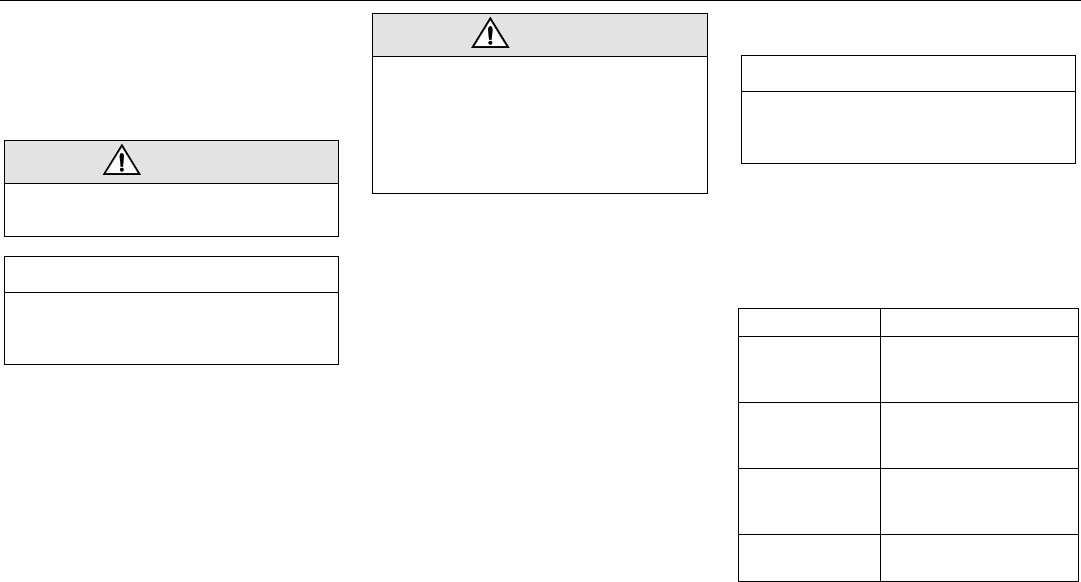
99Saab 9-5 Audio System
Mobile phones and
communications radios
Mobile phones and communications radios
that do not have a separate external
antenna radiate an electromagnetic field
inside the car.
Saab therefore recommends that a car
phone/radio transmitter should always be
connected to an external antenna.
An external antenna also provides
improved transmission/reception and a
greater range.
Mobile phones and communications radios
that are not supplied as standard equipment
by Saab can interfere with the car’s electri-
cal system and cause spurious fault codes
to be generated.
Fault codes
The Audio System has a built-in diagnostics
function. If a fault is detected, a fault code is
generated to help dealer technicians to
diagnose the fault. Below are the codes for
some faults that you might be able to rectify
yourself.
WARNING
The electromagnetic field inside the car
can be detrimental to health.
NOTE
The electromagnetic field can cause
interference to other electrical systems in
the car, such as the Audio System.
WARNING
Always consult an authorized Saab
dealer for installation guidance.
If you feel that any of the warnings or fault
indications are unclear, have the equip-
ment checked by an authorized Saab
dealer.
NOTE
Great care should be exercised in trying
to rectify a fault. If you are at all unsure,
contact an authorized Saab dealer.
Fault code Possible cause
CD/CDC
ERROR
12/17/19
CD is dirty, loaded
wrong side up or defec-
tive.
TAPE ERR 01 Tape broken or
mechanical fault in
deck.
TAPE ERR
02/03 Tape snarled up or
mechanical fault in
deck.
TAPE ERR 11 Cassette jammed: can-
not be loaded/ejected.

100 Saab 9-5 Audio System
OnStar System (US Option only)
Your vehicle may be equipped with OnStar,
a vehicle telematics communications and
navigation system. See the separate
OnStar owner’s manual supplied in your
vehicle’s document organizer.
WARNING
The CD player/CD changer is classified
as Class 1 laser equipment
• Service and repair work must only be
carried out by authorized technicians.
• If the casing is damaged, hazardous
laser radiation can occur.
NOTE
All work on the Audio System must be
carried out by an authorized Saab dealer.
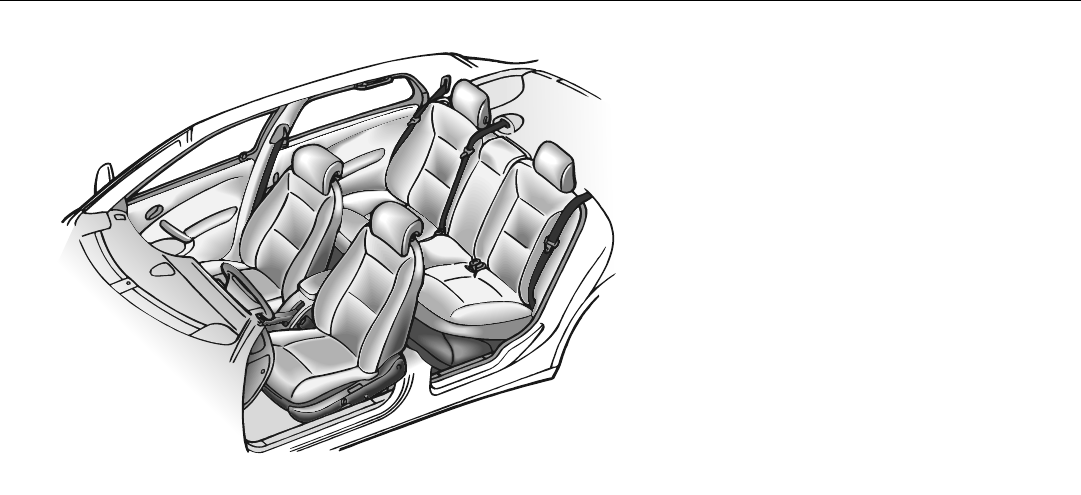
101Interior equipment and trunk
Interior equipment
and trunk
Seats ................................ 102
Steering-wheel
adjustment..................... 107
Rear-view mirrors ........... 108
Electric windows............. 110
Sunroof ............................ 111
Sun visors........................ 112
Ashtrays........................... 112
Glove compartment ........ 113
Cup holders..................... 115
Trunk................................ 116
Spare wheel and tools.... 126
Fuel filler flap................... 126
Opening the fuel filler flap
in an emergency............ 126
IB394
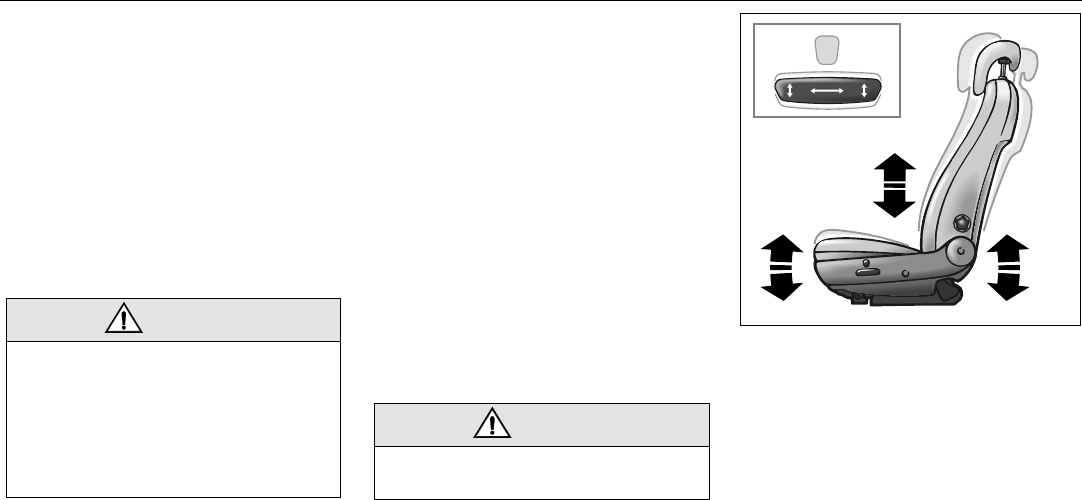
102 Interior equipment and trunk
Seats
Both front seats are electrically operated.
On certain models the driver´s seat is
equipped with a memory function.
To facilitate getting into the car, both seats
can be adjusted when either of the front
doors is open.
For safety reasons, if the door is closed, the
seat can only be adjusted when the ignition
is ON.
Note, however, that both seats can be
adjusted for 30 seconds after both doors
have been closed.
The following seat adjustments can be
made to achieve a comfortable driving
position:
•Height.
• Legroom.
• Backrest rake angle.
• Lumbar support.
• Head-restraint height.
We recommend that adjustments to the
driver’s seat be performed in the following
order:
1Height.
2 Legroom.
3 Seat tilt angle.
4 Backrest rake angle.
Lastly, adjust the steering wheel (see page
107).
Side airbags
(see page 28).
Height
To raise the seat, lift the lower control
straight up.
To lower the seat, press the lower control
down.
The same control can be used to adjust the
height of the front and rear edges of the seat
independently.
WARNING
The seats are actuated by powerful
motors. Take care that to ensure that
nothing can be trapped when adjusting
the seat.
Bear in mind that children can be injured
if they play with the electrically-operated
seats
WARNING
Never adjust the driver’s seat except
when the car is stationary.
IB401

103Interior equipment and trunk
Legroom adjustment
To adjust the legroom, push the lower con-
trol forward or back.
Backrest rake angle
To adjust the backrest, move the upper con-
trol forward or back.
Lumbar support
Turn the smaller wheel for stepless adjust-
ment of the lumbar support.
WARNING
The backrest should be upright during
driving, so that the safety belt, airbag and
backrest can provide optimum protection
in the event of emergency braking or an
accident.
IB403
IB402
IB1161

104 Interior equipment and trunk
Programmable driver’s seat (certain
models only)
In certain models the driver´s seat is
equipped with a programmable memory
function. This function also includes the
door mirrors.
Adjust the seat and door mirrors.
To save the settings, press and hold the M
button and, at the same time, press one of
the preselect buttons (1, 2 or 3). The SID will
sound a bell to confirm that the settings
have been saved.
To recall the programmed settings, press
the appropriate preset button, whereupon
the seat and mirrors will be adjusted auto-
matically.
To change the settings stored in a preset
button, adjust the seat and mirrors as before
and save the new settings by pressing M
and the appropriate preset button.
To facilitate reversing, the passenger side
door mirror can be tilted down automati-
cally, e.g. to show the curb. To do this,
select reverse and press the tiny button
adjacent to the door-mirror control. When
you deselect reverse, the mirror will return
to its original setting automatically (see
page 108).
Head restraint
The front seats in the Saab 9-5 are
equipped with Saab Active Head Restraints
(SAHRs). These reduce the risk of whiplash
injury if the car is hit from behind.
In the event of a rear-end collision, the body
is forced back against the backrest. This, in
turn, causes the mechanism to press the
head restraint forwards and upwards, to
maintain the head, neck and back align-
ment.
The SAHR is a mechanical system, actu-
ated by the body weight. The mechanism is
built into the top of the backrest, where it is
connected to the head restraint.
Because the SAHR is mechanically oper-
ated, it does not need to be replaced after a
collision has occurred.
IB400
IB404
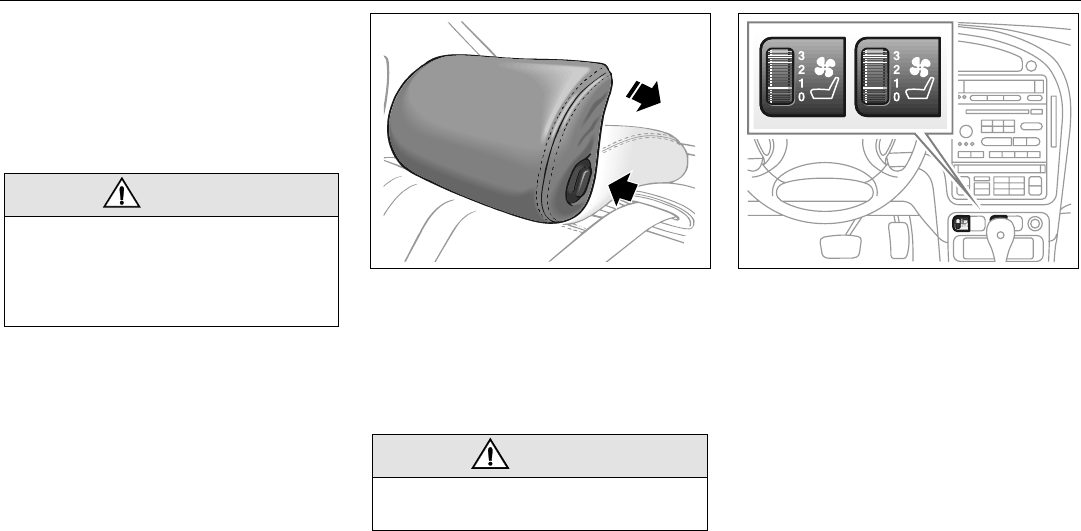
105Interior equipment and trunk
The head restraint can be raised or lowered
and is adjustable in various positions.
• Raising: grasp the head restraint on both
sides and pull it straight up.
• Lowering: press the catch on the left-hand
side of the attaching point and press down
the head restraint.
Rear-seat head restraints
9-5 Sedan: The rear head restraints have
three adjustment positions for passenger
comfort.
They can also be folded down to increase
the driver’s rearward vision when the seat is
unoccupied, see also page 116.
9-5 Wagon: The height of the rear head
restraints can be adjusted to provide opti-
mum passenger comfort.
Ventilated front seats (option)
Ventilated front seats, that enhance seating
comfort in hot weather, are available as an
option on cars equipped with leather-uphol-
stered and electrically adjustable seats.
Ventilated seats are equipped with two fans
that extract the moist air from between the
seat and the body.
The fans have three speeds and are OFF
when the switch is set to 0.
WARNING
Adjust the head restraint so that the head
is well supported and the center of the
head restraint is at ear height, thus reduc-
ing the likelihood of neck injury in an acci-
dent.
WARNING
The head restraint should not be folded
down when the seat is occupied.
IB460
IB405

106 Interior equipment and trunk
Electric heating, front seats (option)
Both front seats have adjustable and ther-
mostat-controlled heating of the seat cush-
ion and backrest, available as an option.
Heating is adjustable in three stages. In
position 0 it is turned off.
Electrically heated seat cushions in
the rear seat (option)
Electrically heated seat cushions for the two
outer seats in the rear are available as an
option.
The ON/OFF control button for the cushion
heating is located on the back of the center
console.
The warming-up time varies with the tem-
perature outside.
The button has an integral indicator that is
illuminated when the heating is on.
IB406
IB407
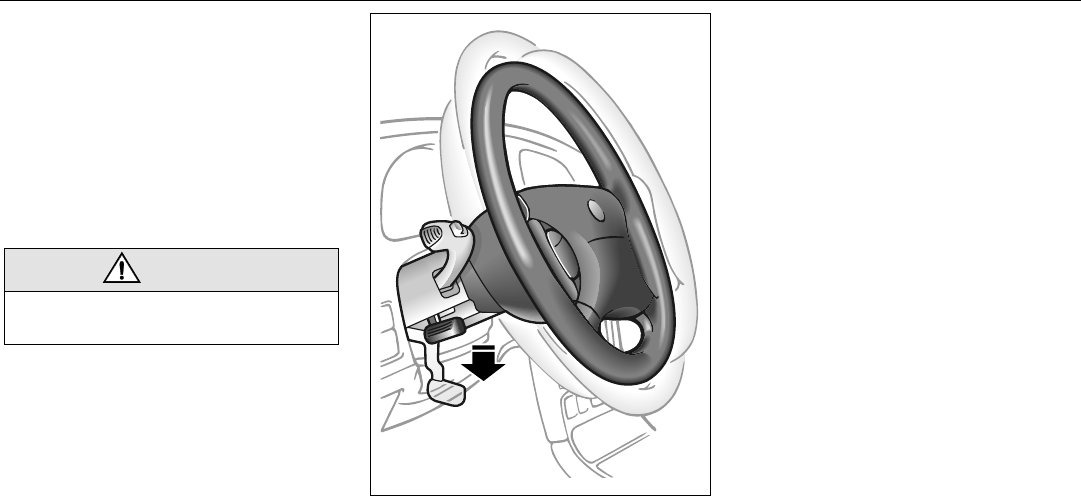
107Interior equipment and trunk
Steering-wheel
adjustment
Fore-and-aft and tilt adjustment of the steer-
ing wheel is possible.
Push down the lever to release the locking
mechanism. Move the steering wheel to the
desired position and then lift the lever to lock
it.
Make sure that the lever is fully locked
before driving off.
Horn
The horn is sounded by pressing the central
part of the steering wheel.
WARNING
Never adjust the steering wheel unless
the car is stationary.
IB408
To adjust the steering wheel
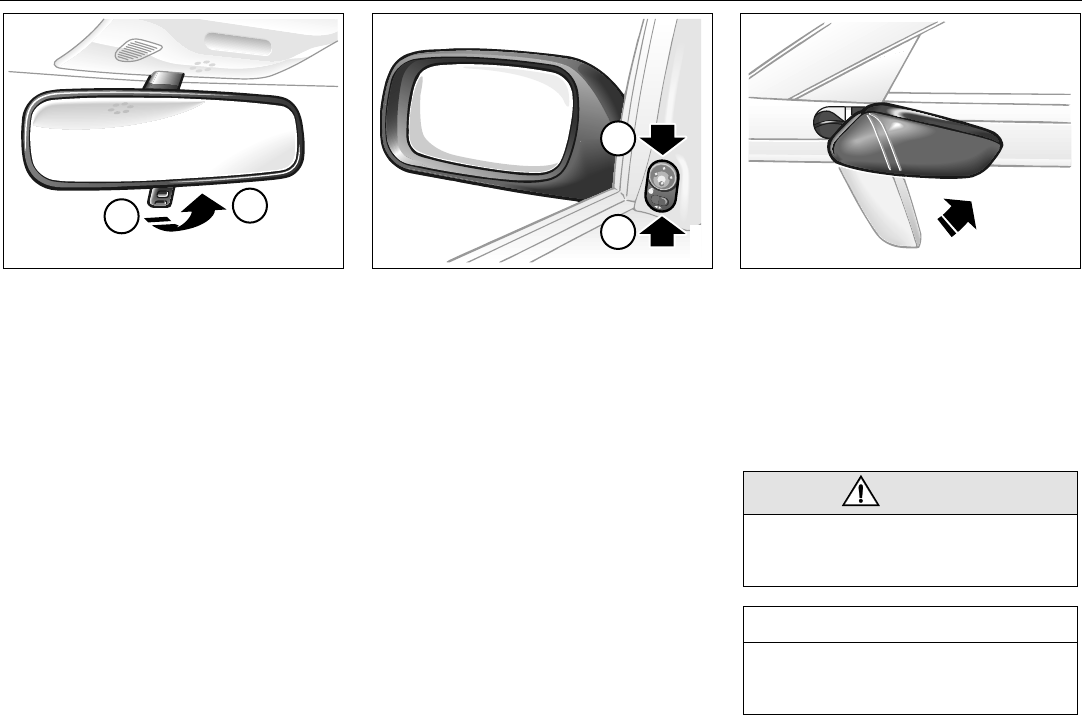
108 Interior equipment and trunk
Rear-view mirrors
The rear-view mirror has day/night positions
that can be selected by means of a knob
beneath the mirror. Adjust the mirror in day
position.
Door mirrors
The passenger side door mirror is of the
wide-angle ‘‘aspheric” type.
The adjusting switch is on the driver’s door.
If the car is equipped with a programmable
driver’s seat, the settings of the door mirrors
can also be stored in the preset buttons for
the seat (see page 104).
The mirrors are heated, and the heating
comes on and goes off with the rear-window
heater.
The door mirrors are designed to fold back
if knocked. They can also be fully retracted
for parking in tight spaces, such as on the
car deck of a ferry. Remember to fold them
out again before driving off.
WARNING
Take care not to trap your fingers
between the door and the mirror when
folding the mirror out again.
NOTE
The door mirrors must be fully retracted
before the car enters an automatic car
wash.
IB426
2
1
Rear-view mirror
1 Day position
2 Night position
IB1157
1
2
Adjusting the door mirrors
1 Select mirror
2 Use touch pad to adjust mirror
IB428
Door mirror folded in

109Interior equipment and trunk
Cars equipped with a programmable
driver’s seat also have a facility for angling
the nearside mirror down on reversing, e.g.
for a better view of the curb.
After selecting reverse, press the tiny button
adjacent to the door-mirror switch to tilt the
mirror. The mirror will be reset automatically
when reverse gear is deselected.
Rear-view mirror with auto dimming
function (option)
The interior rear-view mirror has two sen-
sors, one forward-facing and one rear-fac-
ing.
The system is activated when the for-
ward-facing sensor detects that it is dark
outside.
The rear-facing sensor detects, for exam-
ple, if the car following has not dimmed its
headlights. The rear-view mirror is then
darkened to prevent the strong light source
from dazzling the driver. This darkening is
stepless.
The mirror returns to its normal state when
the strong light source diminishes.
The auto dimming function can be turned
OFF with the switch on the lower edge of the
rear-view mirror.
The system is turned off when reverse gear
is engaged or selected.
Towing a trailer can cause the system to
malfunction, as the rear-facing sensor may
then be directed at the trailer.
IB568
Button for angling nearside mirror down
on reversing
IB1284
1
2
3
1 Forward-facing sensor
2 ON/OFF switch, auto dimming function
3 Rear-facing sensor

110 Interior equipment and trunk
Electric windows
The electric motors of the front windows are
equipped with overload protection (inte-
grated thermal protection). This protection
operates when the windows are wound
down automatically (switch pressed fully
down).
To open:
Front windows: press the front of the switch
Rear windows: Press the back of the switch.
The switches for the front windows have a
third position for automatic opening of the
window. Press the switch right down to
lower the window completely.
To cancel automatic lowering of the win-
dow, lift the switch briefly.
To close:
Front windows: Lift the front of the switch.
Rear windows: Lift the back of the switch.
The actuating motor will be switched off
automatically when the window is fully
closed or when the switch is released.
Child safety: rear windows (ON/OFF)
The window switches on the rear doors can
be rendered inoperative by the ON/OFF
switch in the panel on the center console.
When the switch is ON, the rear side win-
dows can be operated by the switch on each
rear door.
When the switch is OFF, the rear side win-
dows can only be operated from the panel
on the center console.
WARNING
Be alert to danger of fingers being
trapped when closing a window.
Always remove the ignition key when
leaving the car to avert the danger of
injury arising from unattended children
operating the windows.
IB429
1 Window switches
2 Switch for rendering rear-door window switches inoperative
IB445
Switch for rear side window

111Interior equipment and trunk
Sunroof
(Option)
The sunroof is operated by the switch on the
overhead panel above the rearview mirror.
The sunroof can be opened partially or fully.
To open:
• Slide the control towards the rear to open
the sunroof to the comfort position.
To open it fully, slide the control back a
second time. Press the control to stop it
earlier.
To close:
• Slide the control forwards until the sun-
roof is closed.
Ventilation position
• Press the middle of the control (when sun-
roof closed).
• To close: slide the control forwards.
To fully open the sunroof from the ventila-
tion position, slide the control back.
The sunroof incorporates an interior, man-
ual, sliding sun blind.
After the car has been waxed, the sunroof
may squeak or squeal on opening to the
ventilation position. If this should occur, fully
open the sunroof and, using washer fluid,
wash the seal along the front edge, together
with the paintwork that is in contact with the
seal when the roof is closed.
WARNING
Be alert to danger of fingers being
trapped when operating the sunroof.
Always remove the ignition key when
leaving the car, to avert the danger of
injury arising from unattended children
operating the sunroof.
IB430
13
2
Sunroof control
1 To open
2 To close
3 Ventilation position

112 Interior equipment and trunk
Emergency operation of sunroof
In an emergency (e.g. if there is an electrical
failure) the sunroof can be operated by a
screwdriver. Remove the cover at the front
of the sunroof opening, insert a screwdriver
in the groove, and rotate.
Rotate counterclockwise to close sunroof.
Sun visors
The car is equipped with double sun visors.
One section of the visor can be indepen-
dently pivoted to the side window.
A vanity mirror is provided on the back of the
sun visors. The vanity mirrors are illumi-
nated when the cover is raised.
Ashtrays
(Option)
The car is equipped with three ashtrays: one
in the instrument panel fascia, and one in
each rear door. A cigarette lighter is fitted
adjacent to the front ashtray, and there is
also one in the back of the center console.
Front ashtray
1 To open the ashtray, push gently on the
center/upper part of the front and
release to allow it to spring out.
2 Close the ashtray in the same way.
To remove the ashtray, open it and after that
pull left side out at an angle.
IB1180
Sun visor with vanity mirror
IB1285
1
2
Front ashtray
1 Press soft to open/close
2 Pull out one side at an angle
IB431
Manual operation of sunroof
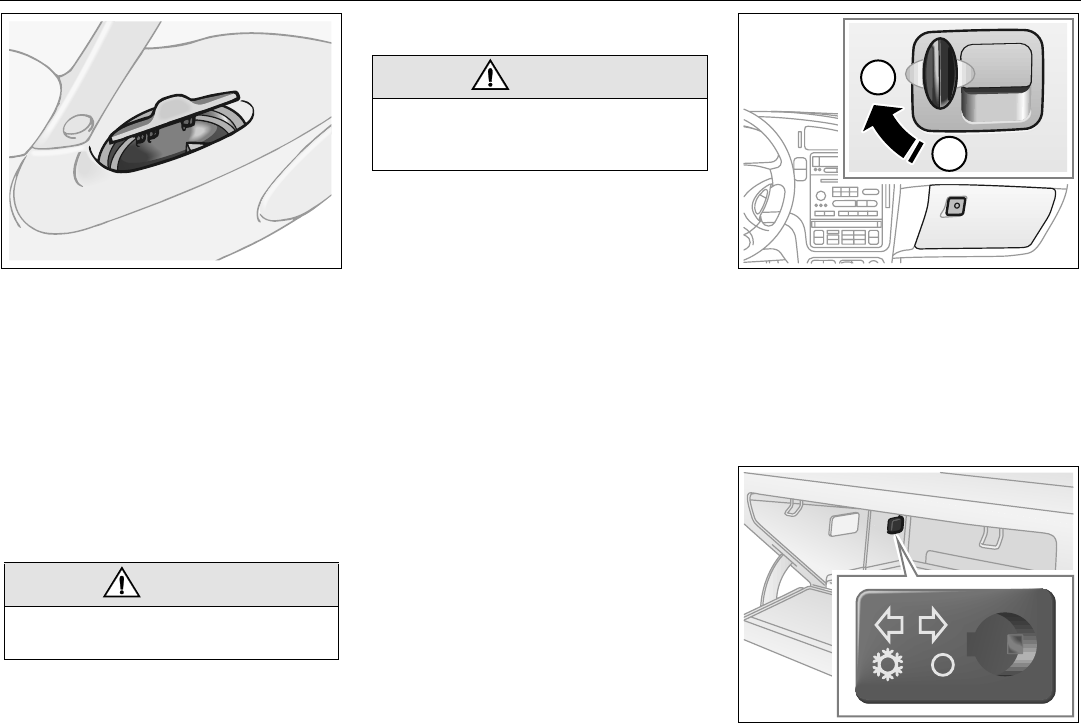
113Interior equipment and trunk
To refit, line up the slots on either side and
slide it closed.
Rear ashtrays
Open the lid to use ashtray.
To remove the ashtray, fully open the lid and
lift the ashtray straight out.
To refit the ashtray, make sure it engages
the two square recesses in the door trim.
The cigarette lighter sockets can also be
used for accessories (e.g. to charge a
mobile phone) when the ignition is ON.
Glove compartment
The glove compartment can be cooled by
the air conditioning (ACC) system. Cold air
can be directed to the glove compartment
for keeping drinks chilled, etc.
Slide the cover towards you to admit cold
air.
Additional storage facilities are provided
(see next page).
WARNING
The maximum combined load for the two
cigarette lighter sockets is 240 W (20 A).
WARNING
Keep the glove compartment closed
when not in use. The lid could cause
injury in the event of an accident.
IB1115
1
2
Glove compartment
1To lock
2 To unlock
IB434
Rear ashtray
IB1286
Sliding cover in glove compartment to
admit cold air

114 Interior equipment and trunk
IB436
IB437
IB439
IB440
IB441 IB438
On the back of the front seats
Center armrest for rear seat
At bottom of door pillars adjacent to
front-seat backrests
On leading edge of front seats
Console between front seats
In the doors
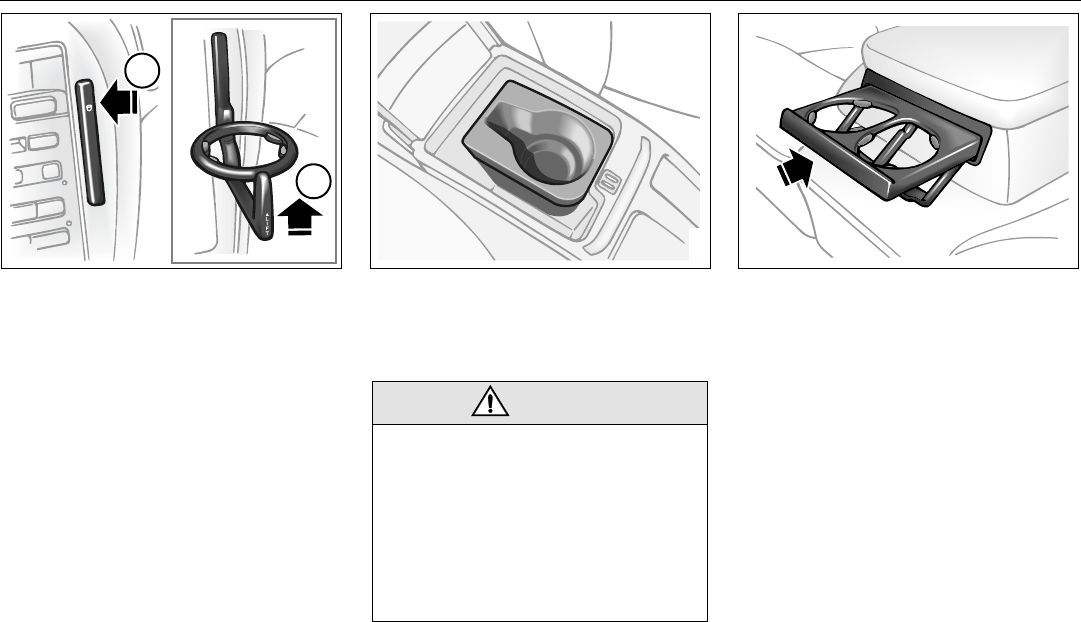
115Interior equipment and trunk
Cup holders
Cup holders are provided in the instrument
panel fascia, in the center console compart-
ment between the front seats, and in the
rear-seat armrest.
To access the cup holder in the instrument
panel, press the symbol and release.
To access the cup holder in the rear-seat
armrest, lower the armrest and press the
front edge of the holder. Close in the same
way.
The number of cup holders provided may
vary between models.
WARNING
• The cup holder should not be used to
hold cups made of china, glass or hard
plastic as these can cause injury in the
event of an accident.
• Use only for paper cups or aluminium
cans.
• Avoid spillage, particularly of hot
drinks
IB1153
1
2
Cup holder in center console
IB443
Cup holder in rear armrest
Press the edge to open/close.
IB444
Cup holder in fascia
1 Press symbol to open
2 Lift bottom to close
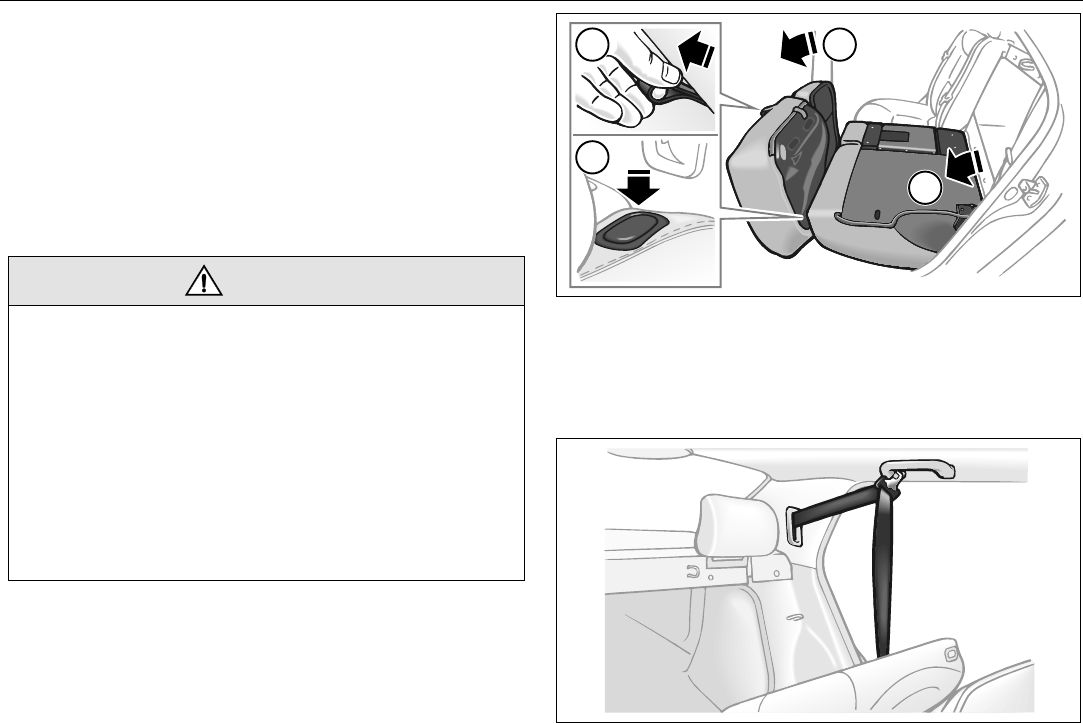
116 Interior equipment and trunk
Trunk
Folding the rear seat, 9-5 Sedan
The rear seat is split and the two sections can be folded indepen-
dently. Folding down of the rear seat is easier if the front seats are
not all the way back, and the rear head restraints are folded down.
1 Lift the seat cushion by pulling the loop located between the
cushion and the backrest.
2 Tip the seat cushion forward.
3 Press the button adjacent to the respective backrest to release it.
4 Fold down the backrest.
WARNING
• Rear-seat passengers should always ensure that the head
restraint is raised and in proper position.
• Keep hands well clear of all moving parts.
• Never place heavy objects on the rear window shelf. There is
always a danger of loose objects flying about and causing
injury if the car should brake suddenly or be involved in an
accident.
• Before folding up the backrest, hang the outer safety belts
onto the hook on the respective courtesy handle to prevent
them from becoming trapped.
• Check that the back rest release button (3) is flush with the
surround before entering the rear seat.
IB459
1 2
4
3
IB461
Outer safety belt hooked onto courtesy handle

117Interior equipment and trunk
WARNING
• Place heavy items closest to the backrest and stow smaller
and lighter items on top.
• Secure heavy and bulky items using the four tie down points
provided in the trunk. This will avert the danger of luggage
flying around if the car should brake suddenly or be involved
in an accident (see page 118).
• When the backrest is folded down or the trunk pass-through
hatch is open, even small items can be thrown around inside
the car. It is therefore advisable to secure these as well.
• Do not exceed the load capacity of the car, as this will alter its
handling characteristics (see page 226).
• Make sure that the seat cushions and backrests are properly
secured when folding them back to their normal position.
Check that the button (item 3 on page 116) is flush with the
surround before entering the back seat.
IB462
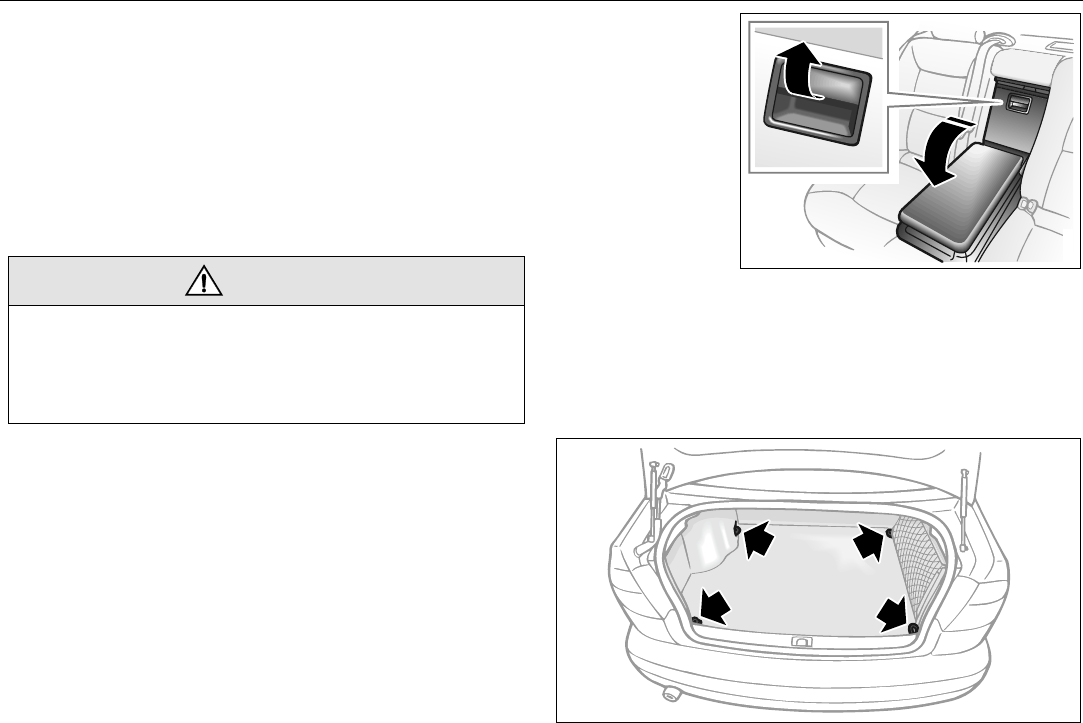
118 Interior equipment and trunk
Trunk pass-through hatch
A trunk pass-through hatch is incorporated in the rear-seat backrest
to enable long, narrow items to be carried inside the car.
Items should not weigh more than 33 lbs. (15 kg) nor be more than
2 yards (2 metres) in length. See the label on the hatch.
1 Fold down the armrest.
2 Raise the hatch by lifting the handle.
Before loading or unloading long items, switch off the engine and
apply the handbrake. This averts the danger of the car moving off
suddenly if a long item were to knock the gear or selector lever into
gear.
Tie Downs
Four tie downs for securing the load are fitted inside the trunk. Place
the load as far in as possible.
WARNING
• Anchor the load securely (e.g. using middle safety belt) to
avoid danger of injury resulting from displacement of load on
hard braking.
• Do not exceed the load capacity of the car, as this will alter its
handling characteristics (see page 226).
IB463
IB464

119Interior equipment and trunk
Folding the rear seat, 9-5 Wagon
Both the narrow and wide sections of the rear seat can be folded
separately. Folding is facilitated if the front seats are not located too
far back. The wide section cannot be folded separately if a cargo net
is mounted on the rear of the backrest.
1 Make sure that the head restraint is in the down position.
2 Put the safety belts for the outer seat places in their respective
belt clips, which are located near the backrest (see illustration).
3 Lift the seat cushion by pulling the loop located between the
cushion and the backrest.
4 Fold the narrow section (right) of the backrest forward by raising
the opening handle on the right-hand side.
5 Fold the wide section of the backrest forward in the
corresponding manner.
6 Adjust the front seats for optimal driving/passenger comfort.
Alternative location of the parcel shelf if this is removed:
• Folded up on the floor at the rear of the luggage compartment.
• On edge behind the backrests of the front seats.
NOTE
The safety belts for the outer seating positions should be put in
their respective belt clips near the backrest to prevent them being
pinched when the rear seat is raised to the upright position.
IB1211
IB1212
Safety belt located
in its belt clip

120 Interior equipment and trunk
Folding the narrow section of the backrest
The folding is facilitated if the front seat is not too far back.
1 Make sure that the head restraint is in the down position.
2 Put the safety belt in the belt clip near the backrest.
3 Lift the seat cushion by pulling the loop located between the
cushion and the backrest.
4 Fold the narrow section (right) of the backrest forward by raising
the opening handle.
5 Adjust the front seat for optimal passenger comfort.
WARNING
• Do not travel in the back seat without ensuring that the head
restraint is set at a suitable height.
• Never allow anyone to sit on a folded backrest.
• Always be aware of the risk of pinching when handling moving
parts of the seating.
• Never place heavy objects on the parcel shelf. There is always
a danger of loose objects flying about and causing injury if the
car should brake suddenly or be involved in an accident.
• Make sure that the backrests are locked when they are folded
back upright. Check that the two red warning-indication flags
are fully down. This indicates that the backrests are locked.
• Check that the safety belt lock is not trapped under the seat
cushions when these are raised back up.
• If the car is equipped with a pull-out cargo net on the rear of the
backrest, take extra care when folding the rear seat so that no
one is injured by the net’s storage cassette on the right-hand
side.
NOTE
The safety belts for the outer seating positions should be put in
their respective belt clips near the back rest to prevent them being
pinched when the rear seat is raised to the upright position, see
illustration page 119.
IB1213
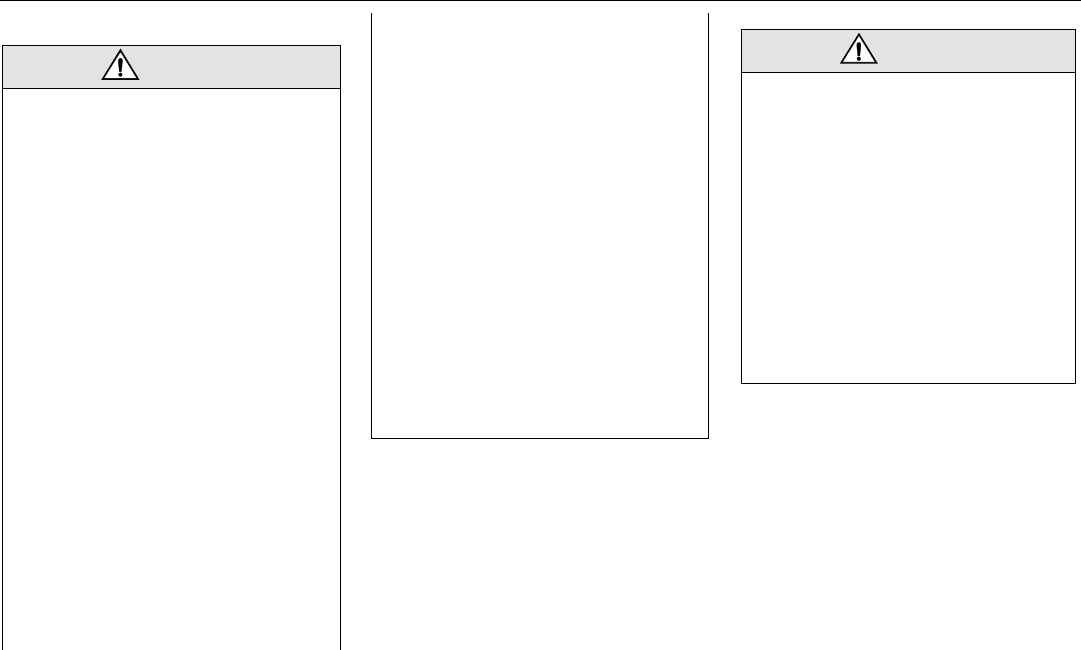
121Interior equipment and trunk
Load anchoring
WARNING
• Put heavy loads as low down and as
far forward as possible in the luggage
compartment, i.e. against the back of
the rear seat.
• Never stack cargo so high that any part
of the cargo lies above the edge of the
backrest, if a cargo guard (accessory)
is not being used.
• Always tie down the cargo so that it
cannot be thrown forward during
heavy braking or in the event of a
collision.
• Unsecured and heavy cargo can
increase the risk of injury during hard
braking, sudden avoidance maneu-
vers and in the event of a collision.
• For the best load anchoring, use the
special cargo bolt and load straps
(accessory).
• Load the cargo bolts evenly. Never
attach more than one strap to each tie
down eye.
• Provide protection on sharp edges to
prevent damage to the load straps.
• Never use the elastic floor net and
elastic side net when the rear seat is
folded down. These nets are only
intended to keep light objects tidy, not
for the anchoring of loads.
• If possible, avoid having the rear seat
folded down when driving with a heavy
load because the anchoring possibili-
ties are restricted when the rear seat is
in this position. That the rear seat is in
the upright position is a basic require-
ment for protection against cargo dis-
placement in the event of a collision.
• Cargo can intrude into the passenger
compartment during a sudden stop or
front crash if the outer safety belts are
not fastened. Check that the two red
warning-indication flags are fully
down. This shows that the backrests
are locked.
WARNING
• The driving characteristics of the car
can be affected because the center of
gravity is altered when there is a cargo
in the luggage compartment. There-
fore match the speed and driving style
according to how the car is loaded.
• An object weighing 55 lbs. (25 kg) cor-
responds to a weight of 2200 lbs.
(1000 kg) in a head on collision at
32 mph (50 km/h).
• Adjust the car’s load (passengers and
luggage) so that the gross vehicle
weight or the axle weight is not
exceeded, see page 226.
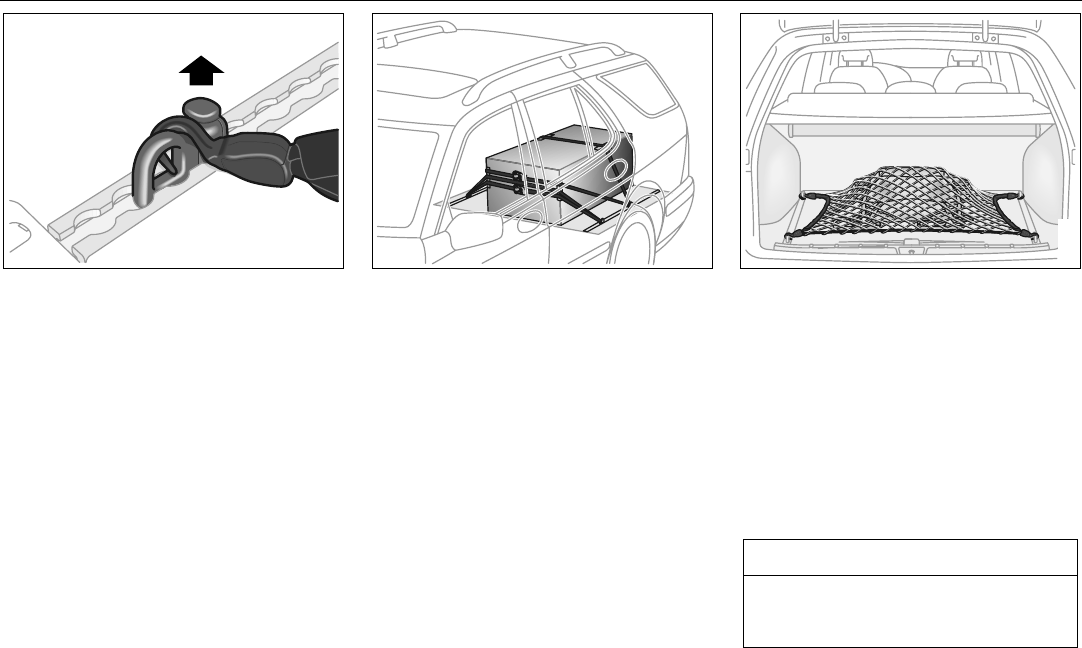
122 Interior equipment and trunk
On the floor of the luggage compartment
there are two longitudinal aluminium rails
(CargoTracks™) where special cargo bolts
can be mounted.
The protective strip on the CargoTracks™ is
removed by lifting its back edge and pulling
it straight upwards. Replace the strip by
pressing it down on the CargoTracks™.
When the cargo bolts are not being used the
protective strip should be in place.
The cargo bolts are mounted by lifting their
locks and inserting them into the rail. Each
cargo bolt is moved in the following way: pull
up its lock and at the same time move it for-
wards or backwards to the desired position.
Items for load anchoring:
• Cargo bolts (standard).
• Special load straps (accessory).
Items to keep light objects tidy:
• Elastic floor cargo net (accessory).
• Elastic side cargo net for the right-hand
side of the luggage compartment (acces-
sory).
The elastic nets may only be used to keep
light objects tidy, not for anchoring.
The floor net should be attached to the
cargo bolts that are mounted on the Car-
goTracks™. Place the tie down eyes as far
forward and as far back as possible on the
CargoTracks™.
The side netting should be attached to the
two tie down eyes which are included in the
accessory kit and to two of the eyes
mounted on the right-hand CargoTrack™
on the floor.
The cargo bolts, load straps and elastic nets
are stored in the two floor lockers on the
right- and left-hand side of the luggage com-
partment. The lockers are opened by lifting
the respective fabric loop.
NOTE
Do not place any objects so that the
demisting and antenna elements on the
inside of the window could be damaged.
IB1214
Cargo bolts mounted on the longitudinal
rails
IB1216
Example of cargo anchoring
IB1215
Elastic cargo net for lighter objects.
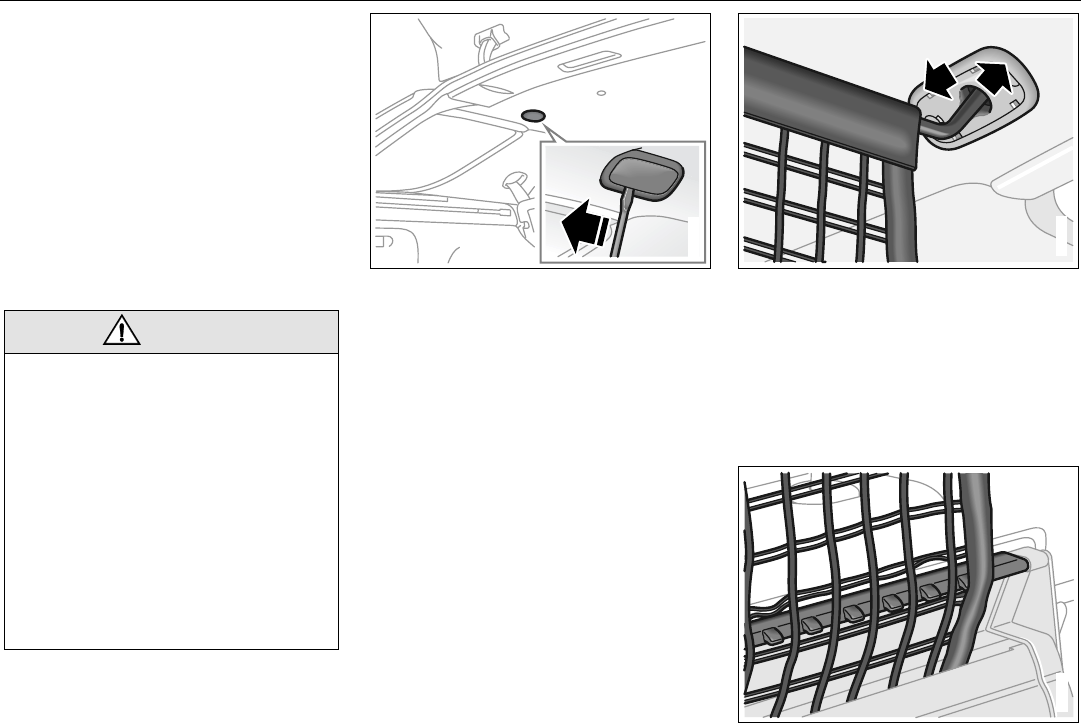
123Interior equipment and trunk
Cargo net (accessory)
The pull-out cargo net’s storage cassette is
mounted on the rear of the backrest.
1 Remove the covers near the two rear
fixing points in the roof. Carefully bend in
the lower edge of the cover with a screw-
driver.
2 Pull the cargo net out directly back-
wards.
3 Snap the net’s two fasteners into the two
fixing points on the roof.
4 Make sure that the hooks on the net’s
own storage cassette fit against the net
mesh.
The pull-out cargo net can also be used
when the whole rear seat is folded. There
are two front attachment points in the roof
for this purpose.
WARNING
• The cargo in the luggage compart-
ment must be anchored properly,
even if the cargo net is correctly in
position. The only purpose of the net is
to prevent objects from being thrown
about in the cabin during heavy brak-
ing or in the event of a collision.
• Take extra care when tipping the wide
section of the rear seat forwards if the
car has a pull-out cargo net on the rear
of the backrest. Make sure that no one
is injured by the cargo net’s storage
cassette on the right-hand side where
the backrest is already folded.
IB1217
Cover over the fixing point for the cargo
net
IB1218
Attaching the cargo net to the roof
IB1219
Hooks on the net’s storage cassette
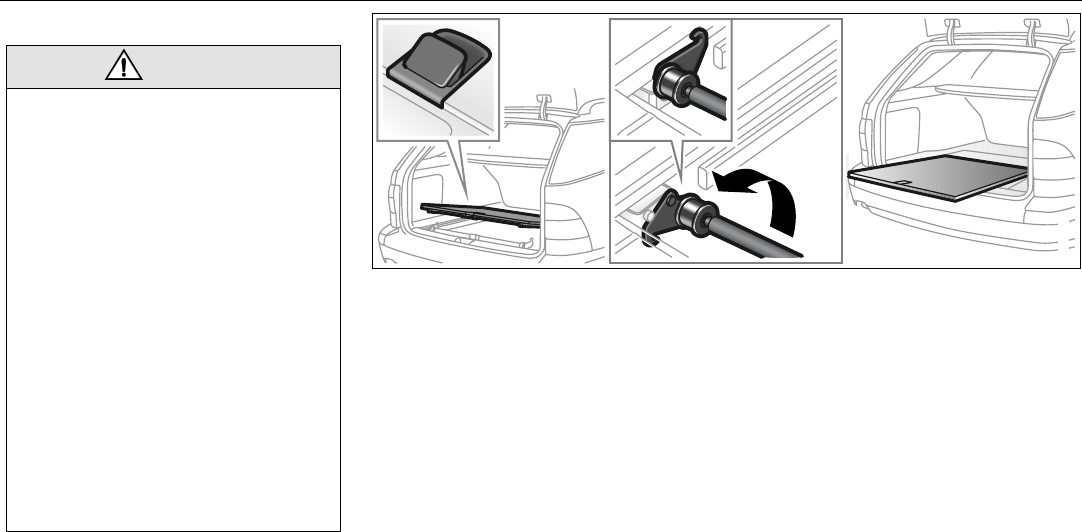
124 Interior equipment and trunk
Sliding floor (accessory)
The function of the sliding floor is to facilitate
loading and unloading.
Securing loads, see page 118.
When the car is parked and the floor is
pulled out, it can bear the weight of two
people (maximum 440 lbs./200 kg).
The maximum load that can be anchored by
anchorage straps and cargo bolts is
170 lbs./80 kg.
Setting up
1 Lift up the floor.
2 Fold out the support wheels.
3 Set the floor down on the support
wheels.
WARNING
To avoid personal injury take note of the
following:
• Do not leave children unsupervised
when the sliding floor is drawn out.
• Be aware of the risk of pinching when
handling the sliding floor.
• Never drive the car with the sliding
floor pulled out.
• Always use the car’s regular cargo
anchoring when transporting a cargo.
• Provide protection on sharp edges to
prevent damage to the anchoring
straps.
• The sliding floor must not be changed
or modified in any way.
• Put the sliding floor in the folded- down
position when it is not in use.
IB1220
Setting up the sliding floor

125Interior equipment and trunk
Loading/Unloading
1 Lift the handle and pull out the sliding
floor to the outer locking position. Make
sure that the floor is locked correctly.
2 Put on the cargo, but make sure that it
does not cover the handle.
3 Lift the handle and push in the floor to
the inner locking position. Make sure
that the floor is locked correctly.
4 Tie down the load with Saab’s load
straps according to the instructions, see
page 121.
When the floor is not in use
1 Lift up the floor.
2 Fold down the support wheels.
3 Lay down the sliding floor and make sure
that it is locked in its lower position.
IB1221
Loading
IB1222
Folding down the sliding floor

126 Interior equipment and trunk
Spare wheel and tools
The spare wheel, together with the jack and
jack handle, front towrope attachment eye
and toolkit, are stowed away underneath
the trunk.
Driving considerations with compact spare
wheel/tire fitted, see page 154.
Fuel filler flap
The fuel filler flap is opened by means of a
button on the driver’s door. The flap is
spring-loaded, so it opens slightly automat-
ically when released.
Refueling, see page 134.
Opening the fuel filler
flap in an emergency
If the fuel filler flap fails to open after the
button on the driver’s door has been
pressed, it can be opened manually from
inside the trunk.
9-5 Sedan:
Start by checking fuse 25 (see page 194).
A thin cable on the right-hand side in the
trunk is connected to the catch for the filler
flap. To open the flap, pull the yellow plastic
arrow on the end of the cable.
WARNING
Stow all tools carefully away after use, so
that they cannot get loose and cause
injury in the event of an accident.
IB465
Stowage of spare wheel and tools under
trunk floor
IB466
Button for releasing filler flap
IB467
To open fuel filler flap in an emergency
9-5 Sedan

127Interior equipment and trunk
9-5 Wagon:
Start by checking fuse 25 (see page 194).
On the right-hand side of the luggage com-
partment, in the storage locker, is a thin wire
that is tied to the locking arm of the filler flap.
To open the flap pull the yellow plastic arrow
attached to the end of the wire.
IB1231
To open filler flap in an emergency,
9-5 Wagon

128 Interior equipment and trunk

129Starting and driving
Starting and driving
IB597
Ignition switch ................. 130
Starting the engine.......... 131
Important considerations
for driving....................... 132
Refueling .......................... 134
Engine Break-In Period ... 137
Gear changing ................. 137
Cruise control .................. 145
Braking ............................. 146
Traction Control System. 147
Economical motoring...... 149
Driving in winter .............. 150
Driving in hot weather .... 151
Towing a trailer................ 152
Driving considerations
with compact spare
wheel/tire fitted.............. 154
Driving with the trunk
lid/tailgate open............. 154
Driving with a roof rack
load................................. 155
Driving with a load .......... 157
Towing the car................. 158
Jump starting .................. 160
Parking brake ................... 162
Parking.............................. 162

130 Starting and driving
Ignition switch
The combined ignition switch and
gear-lever lock is located in the center con-
sole between the front seats. The ignition
key can only be removed when reverse is
engaged (automatic transmission: selector
in ”P” position).
The key fits all the locks on the car. The key
number is specified on the small plastic
strap that comes with the keys when the car
is delivered. Keep a note of the key number
in a safe place, as you will need to quote it if
ordering a replacement key.
See also page 32.
LOCK position
Engage reverse and turn the key to LOCK.
Automatic transmission: select ”P”.
The gear lever is locked. This is the only position in which the key can be
removed.
The parking lights, hazard warning lights and interior lighting all work.
OFF position
Gear lever no longer locked.
Certain electrical circuits operational
ON position
All electrical circuits working. Do not leave the key in the ON position
when the engine is not running. Turn the key to OFF to switch off the
electrical circuits. In the ON position certain warning and indicator lights
come on as a check, and they normally are extinguished after about
3 seconds.
ST (starter) position
The starter operates when the key is turned to this position. When
released, the key will spring back to the ON position. If the engine fails to
start, the key must first be turned back to the position between OFF and
LOCK before the starter can be operated again.
When the starter motor is running, several electrical circuits are
disconnected to facilitate starting.
L
O
C
K
O
F
F
O
N
S
T
L
O
C
K
O
F
F
O
N
S
T
L
O
C
K
O
F
F
O
N
S
T
L
O
C
K
O
F
F
O
N
S
T
IB1120

131Starting and driving
If the car does not start
If the text “KEY NOT ACCEPTED” is shown
on the SID, after a failed start attempt, the
cause could be a fault in the transmitter in
the key, or in the receiver in the ignition lock.
The following should be done:
• Turn the key back to the LOCK position.
• Turn the key to ON.
• Press one of the buttons on the remote
control (the LED stops blinking).
• Start the engine.
Try another key. If this works, then the fault
is in the first key.
Contact an authorized Saab dealer for
checking and rectification.
Starting the engine
Do not run the starter motor for more than
25 seconds at a time. Wait 20-30 seconds
before running the starter again, to give the
battery time to recover.
Avoid racing the engine or putting a heavy
load on it before it has warmed up. Drive
away as soon as the oil warning light has
been extinguished to enable the engine to
attain its normal temperature as quickly as
possible.
It is possible for air to enter the lubricating
system in conjunction with an oil or oil-filter
change, or if the car has been stored for
some time. This air can cause the hydraulic
cam followers to emit a ticking noise, which
can persist for up to 15 minutes after start-
ing. Although this is quite normal and does
not indicate any malfunction, it is advisable
not to exceed 3,000 rpm before the noise
has disappeared.
The hydraulic cam lifters are completely
service free; the valve clearance is set up at
the factory and will not need any subse-
quent adjustment.
Starting the engine
The engine has an automatic choke and
should be started as follows:
Cars with manual gearbox
To start the engine the clutch pedal must
be fully depressed.
1 Depress the clutch pedal fully but do not
touch the accelerator.
2 Start the engine. Let the ignition key
spring back as soon as the engine has
started and is running smoothly – at very
low temperatures, you may need to run
the starter for up to 25 seconds.
Let the engine idle for about 10 seconds. Do
not open the throttle wide for at least
2-3 minutes after starting.
Cars with automatic transmission
1 The selector lever must be in the P or N
position.
2 Keep your foot on the brake pedal.
3 Start the engine. Let the ignition key
spring back as soon as the engine has
started and is running smoothly – at very
low temperatures, you may need to run
the starter for up to 25 seconds.
Let the engine idle for about 10 seconds. Do
not open the throttle wide for at least
2–3 minutes after starting.
NOTE
Take care not to spill drinks or to drop
crumbs over the ignition switch. If dirt or
liquid gets into it, the switch may not
operate properly.
WARNING
• Always remove the key before leaving
the car.
• Always apply the parking brake before
removing the ignition key.
WARNING
• Carbon monoxide (CO) is a colorless,
odorless, poisonous gas. Be alert to
the danger of CO – always open the
garage doors before starting the
engine in the garage.
• There is also a danger of CO poison-
ing if the exhaust system is leaking.

132 Starting and driving
Useful tips on cold climate starting
If the engine has failed to start after several
attempts in very cold weather, press and
hold the accelerator down to the floor and
run the starter for 5–10 seconds. This will
prevent the engine being flooded (exces-
sively rich fuel-air mixture).
Now start the engine in the normal way – do
not touch the accelerator.
If the engine stalls immediately after starting
(e.g. if the clutch was released too quickly),
do not touch the accelerator when restarting
the engine.
Limp-home mode
The car’s engine-management system
includes a diagnostic function that checks
numerous internal functions after the
engine has been shut off. If a fault is
detected in the throttle system, the
engine-management system puts the throt-
tle system into the limp-home mode. This
limits idling control, disables the cruise-con-
trol system and limits the capacity of the A/C
compressor.
If the limp-home mode is in operation
(“Engine malfunction” light on, see below)
and the outside temperature is close to or
below freezing, you may need to use some
throttle on starting (some pressure on the
accelerator).
If the diagnostic system has detected a fault
in the engine-management system, the
“Engine malfunction” light on the main
instrument panel will come on (see page
49), indicating that you should have the car
checked as soon as possible by an autho-
rized Saab dealer.
Important
considerations for
driving
The engine-management system in the
Saab 9-5 is called Saab Trionic T7. The
system manages the ignition, fuel injection
and turbo boost pressure.
The Trionic T7 system developed by Saab
is an intelligent engine-management
system designed to achieve optimum driv-
ability under differing driving conditions.
The system makes adjustments automati-
cally, for instance, if the car is being driven
at altitude (oxygen-deficient air), for differ-
ent grades of fuel (AON 87–93) and for dif-
ferent load conditions.
1 Starting and driving
• Refrain from using full throttle before
the engine has warmed up (before
needle in mid-range on temperature
gauge).
• A safety function prevents the engine
from revving faster than 6,000 rpm by
limiting the induction air.
2 Stopping the engine
• Do not rev the engine immediately
before switching it off - stop the engine
when it is idling.
3 Regulating the boost pressure
• The system is optimized for fuel with an
octane rating of AON 90. One of the
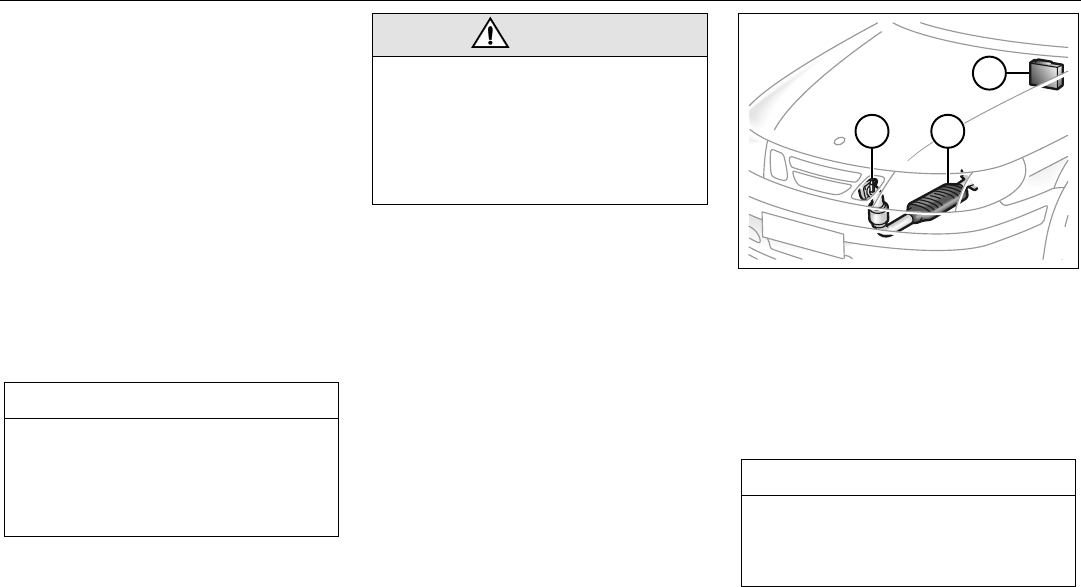
133Starting and driving
advantages of the system is that it
enables the engine to be run safely on
lower-grade fuel, although not lower
than AON 87.
• The maximum boost pressure is
adjusted automatically to the knocking
or pinging tendency of the engine.
Occasional, short-lived knocking when
the engine is under a heavy load is per-
fectly normal; the extent will depend on
the grade of fuel in the tank.
• Isolated instances of knocking are
more likely to occur with low-octane
fuel. This controlled form of knocking,
followed by a reduction in the boost
pressure, is a sign that the wastegate is
functioning and is perfectly safe for the
engine.
Important considerations with cata-
lytic converters
The catalytic converter is an emission-con-
trol device incorporated in the car’s exhaust
system. It consists of a metal canister with a
honeycomb insert, the cells of which have
walls coated in a catalytic layer (mixture of
precious metals).
NOTE
If constant knocking occurs every time a
load is put on the engine, this indicates a
malfunction in the system.
Have the car checked without delay by an
authorized Saab dealer.
WARNING
If the engine is being run with the car on a
rolling road or dynamometer, to ensure
adequate cooling, air must be blown into
the engine compartment and under the
car at a rate equivalent to the ram-air
effect that would be obtained at the corre-
sponding road speed.
NOTE
Use only unleaded gasoline. Leaded gas-
oline is detrimental to the catalyst and
oxygen sensor and will seriously impair
the function of the catalytic converter.
IB661
2
1
3
Oxygen-sensor-controlled
injection system
1 Engine control module
2 Oxygen sensor (lambda probe)
3 Catalytic converter
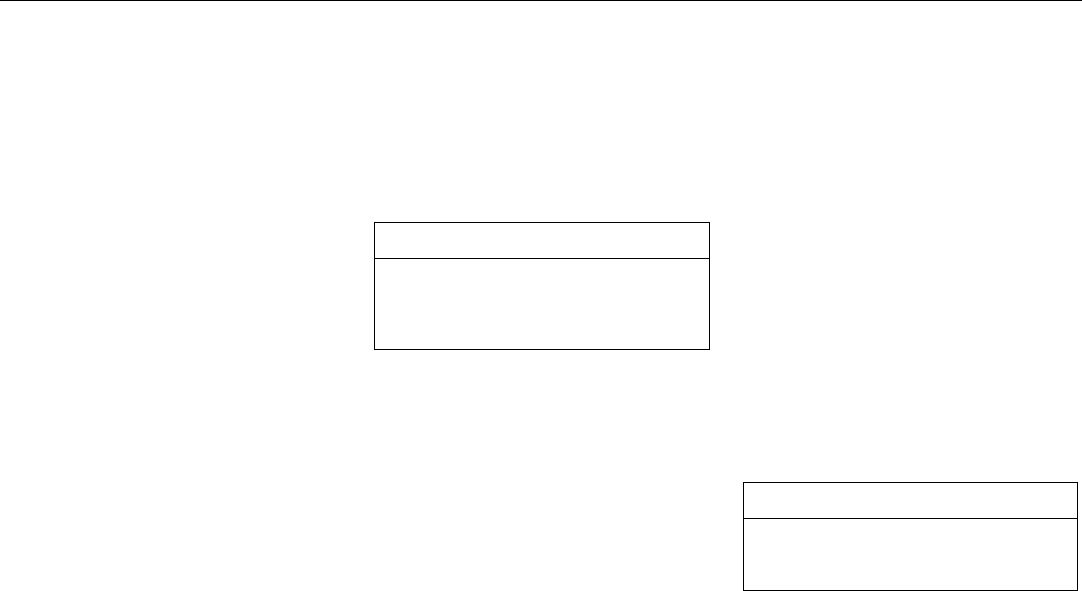
134 Starting and driving
To ensure that the catalytic converter con-
tinues to function properly, and also to avoid
damage to the converter and its associated
components, the following points must be
observed:
• Have the car serviced regularly in accor-
dance with the service program. The fuel
and ignition systems are particularly
important in this context.
• Always be alert to any misfiring of the
engine (not running on all cylinders) and
any loss of power or performance. At the
first sign of a malfunction, reduce speed
and take the car to an authorized Saab
dealer as soon as possible.
• If the engine fails to start (in very cold
weather or if the battery is flat), the car can
be jump started (manual gearbox only) or
started using jump leads to a donor bat-
tery. However, as soon as you have
started the engine, it is important that it
runs on all cylinders. If it is misfiring, allow
it to idle for up to fi ve m inutes to gi ve i t t ime
to settle and run smoothly. If, after this
time, the engine still fails to run properly,
turn off the engine and get in touch with an
authorized Saab dealer for advice.
• Never park the car on dry grass or other
combustible material. The catalytic con-
verter gets very hot and could therefore
start a fire.
• Never drive off if the engine is misfiring.
• If you jump start the car when the engine
is already up to normal temperature, the
engine must start to run on all cylinders.
Stop jump-starting if the engine fails to
start immediately.
Failure to follow these directions could
result in the catalytic converter and associ-
ated components being damaged, and
could represent a breach of the warranty
conditions.
V6 engine: When starting the engine from
cold an electrical pump is activated. This
pump pumps air into the exhaust system so
that the catalytic converter will reach its
normal operating temperature more rapidly.
The pump is active for 30-60 seconds.
Refueling
Always use the correct grade of fuel:
unleaded AON 87-93.
Saab recommends:
• AON 90 for 4-cylinder engines
• AON 93 for V6-engines and 2.3 Aero,
(see page 228).
If fuel containing a mixture of alcohol is
used, the following restrictions apply:
Methanol: max. 5% by volume.
Ethanol: max. 10% by volume.
MTBE: max. 15% by volume.
The fuel filler cap is located in the right rear
quarter panel.
Switch off engine.
Open fuel door
Insert the fuel-pump nozzle beyond the
flange on the filler pipe. Do not withdraw the
nozzle while filling is in progress.
Cease refuelling the first time the pump
stops.
Fuel-tank capacity: 18.5 US gal. (70 liters)
Screw on the filler cap and keep turning until
it has clicked at least three times.
The most effective way to prevent conden-
sation forming in the tank (and thus avoid
NOTE
If the car runs out of fuel, it is possible for
air to get into the fuel system. If this
happens, the catalytic converter may
overheat and be damaged.
NOTE
Do not overfill. Fuel should not come right
up the filler pipe as expansion room is
needed.
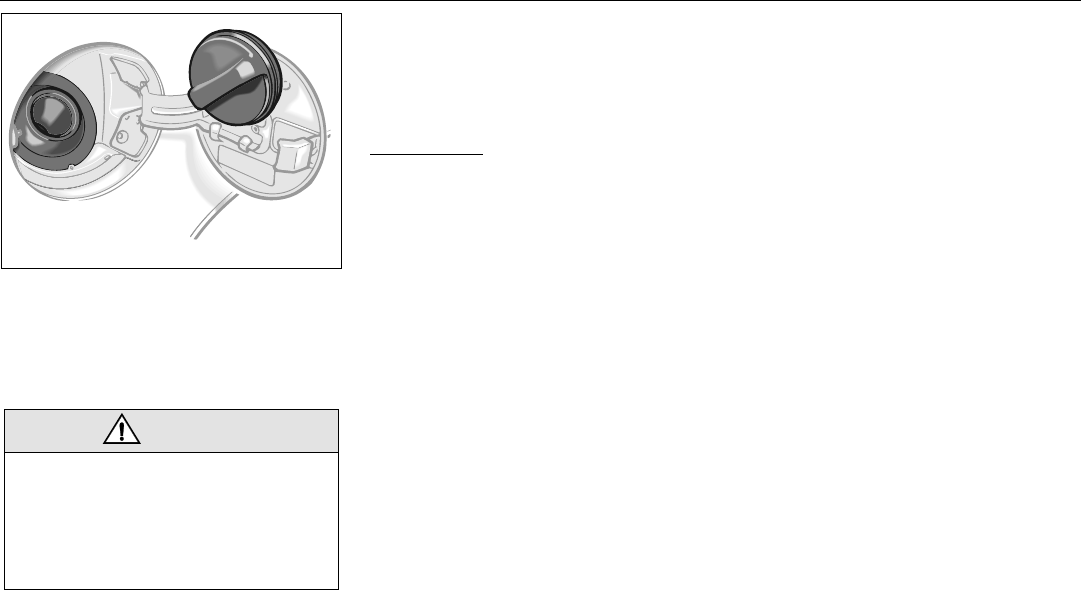
135Starting and driving
possible running problems) is to keep the
tank well filled.
Before the onset of freezing temperatures in
winter, it may be advisable to add gasoline
anti-freeze to the fuel a few times to dispel
any condensation in the system.
Opening the fuel filler flap in an emergency,
see page 126.
Recommended fuel:
The engine in your Saab 9-5 is designed to
operate on unleaded gasoline that has an
octane rating of 87 or higher. Octane rating
is determined according to the formula:
where MON is the Motor Octane Number,
and RON is the Research Octane Number.
The average of these two values is the
octane rating of the gasoline as it appears
on the pump at a retail gas station. This
value is sometimes referred to as the
"Anti-Knock Index" (AKI) or the "Average
Octane Number" (AON).
To avoid deposit formation on the fuel injec-
tors which can cause poor driveability, use
only quality gasolines that contain deter-
gents and corrosion inhibitors. Because
gasolines sold at retail gas stations vary in
their composition and quality, you should
switch to a different brand if you begin expe-
riencing driveability and/or hard starting
problems shortly after refueling your car. In
recent years, a variety of fuel additives and
alcohols or oxygenates have been blended
with gasoline. These types of gasolines may
be found in all parts of the United States and
Canada, but particularly in geographic
areas and cities that have high carbon mon-
oxide levels. Saab approves the use of such
"reformulated" gasolines in its products,
which help in reducing pollution from all
motor vehicles, provided that the following
blending percentages are met by such
fuels:
• Up to 10% ethanol by volume, with corro-
sion inhibitors.
• Up to 15% MTBE by volume (methyl ter-
tiary butyl ether).
• Up to 5% methanol by volume, with an
equal amount of a suitable co-solvent and
added corrosion inhibitors.
Other, less common, fuel additives used by
some gasoline dealers are also acceptable,
provided that the resultant gasoline is not
more than 2.7% oxygen by weight.
Some Canadian and U.S. gasolines contain
an octane enhancing additive called meth-
lycyclopentadienyl manganese tricarbonyl
WARNING
• Never use fuel for any purpose other
than as engine fuel.
• Fuel is highly flammable and can
cause severe burns. Never use an
open flame in the vicinity of gasoline
and do not smoke when refuelling.
MON + RON
2
IB470
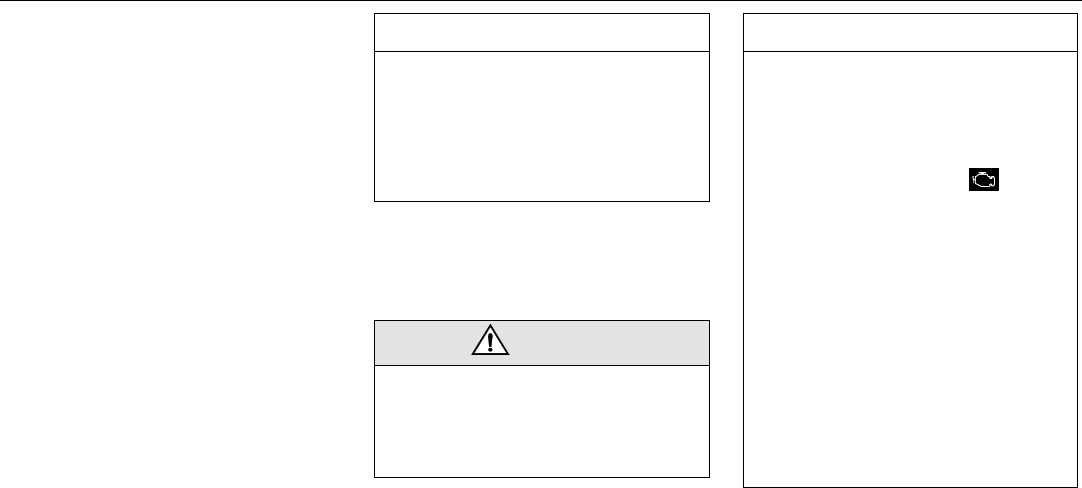
136 Starting and driving
(MMT). If such fuel is used, your emission
control system performance may deterio-
rate and the malfunction indicator lamp on
your instrument panel may turn on. If this
occurs, return to your authorized Saab
dealer for service.
However, these blended gasolines are reg-
ulated and should never exceed these rec-
ommended blend percentages and service
station operators should know if their gaso-
lines contain detergents and oxygenates,
and have been reformulated to reduce vehi-
cle emissions. Nevertheless, if you begin to
notice a problem with the way your car starts
or runs shortly after it has been refueled, try
a different brand of gasoline.
Fuel
Use the correct type of fuel. The fuel filler
cap is located in the right rear fender. Do not
lift the nozzle while filling is in progress.
NOTE
Higher concentrations of methanol than
listed above, or the use of methanol-
blended gasoline without suitable
co-solvents and corrosion inhibitors,
can damage your car’s fuel system,
leading to the need for repairs which are
not covered by Saab’s product warranty.
WARNING
Gasoline is highly flammable and can
cause severe burns. Never use an
exposed flame in the vicinity of gasoline.
Never smoke when filling the vehicle up
with gasoline.
NOTE
The engine control module (ECM) mon-
itoring the engine parameters also
stores fault codes.
Under certain circumstances, this may
cause constant illumination of the
“Engine malfunction” lamp , thus
indicating a fault that must be checked
by your Saab dealer.
NOTE: always observe the following two
measures:
• Make sure that the fuel filler cap is
screwed on correctly before the
engine is started. Screw on the fuel
filler cap until you hear 3 distinct
clicks.
• Avoid driving with the fuel low level
indicator illuminated. The symbol
illuminates when less than approxi-
mately 2 gallons (8 litres) of fuel
remains in the tank.

137Starting and driving
Engine Break-In Period
Pistons, bores and bearings need time to
obtain uniform, wear-resistant surfaces.
If a new engine is driven too hard, this grad-
ual process of bedding-in will not be possi-
ble and the life of the engine will be short-
ened.
During the first 1,200 miles (2,000 km), do
not exceed 5,000 rpm.
In addition, refrain from driving the car at full
throttle, other than for brief instances,
during the first 1,800 miles (3,000 km).
Wearing in new brake pads
New brake pads take time to bed in, about
90 miles (150 km) if the car is driven largely
under stop-and-go conditions or about
300 miles (500 km) of highway driving.
To extend the useful life of the pads, avoid
hard braking as much as possible during
this period.
Brake-pad wear indicators
The outer brake pads on the front wheels
have acoustic wear-indicators. When 3 mm
remains on the pad, a scraping or screech-
ing noise is heard during braking. The brake
pads should be changed as soon as possi-
ble.
Brake pads should only be replaced by
an authorized Saab dealer.
Gear changing
Manual gearbox
To start the engine the clutch pedal must
be fully depressed.
The gear positions are marked on the gear
lever. Before reverse (R) can be engaged,
you must lift the ring underneath the
gear-lever knob.
To change gear, fully depress the clutch
pedal and then release it smoothly. It is
inadvisable to drive with your hand resting
on the gear lever, as this can increase the
wear on the gearbox.
When changing down from 5th to 4th gear,
ease the gear lever straight back, without
applying any lateral pressure. This will pre-
vent 2nd gear being engaged by mistake,
which can result in overreving and possible
damage to the engine.
Before engaging reverse, wait till the car is
at a standstill, release the accelerator and
fully depress the clutch. From neutral, press
the gear lever firmly to the right before
easing it back into reverse.
Shift-up indicator for improved fuel
economy (U.S. models only)
Cars equipped with a manual transmission
have a "Shift-up" light on the instrument
panel. The light begins to work after the
vehicle is warmed up and provides you with
a good indication when to shift to a higher
gear.
It is not necessary or recommended to
follow the shift-up recommendations in all
driving conditions, for example, when driv-
ing in heavy urban traffic or steep downhill
grades.
However, shifting with the light should result
in improved fuel economy. Therefore, for
reduced fuel consumption and better
energy conservation, you should make a
habit of shifting before or when the shift-up
light comes on.
Towing
Towing of cars with manual gearbox, see
page 158.
IB471
13
2
5
R
4
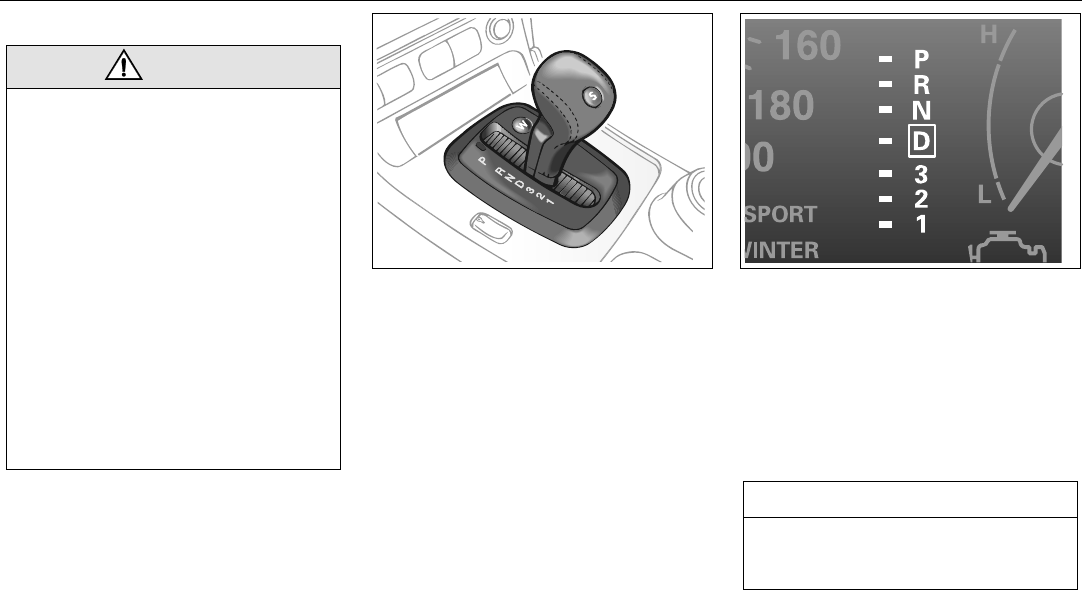
138 Starting and driving
Automatic transmission
The electronic control module for the auto-
matic transmission receives information on
engine torque and road speed, and also
controls the hydraulic pressure in the trans-
mission to ensure that gear changing is as
smooth as possible.
The position of the selector lever is shown
by the symbols adjacent to the lever and
also by an indicator on the main instrument
panel.
The ignition key can only be removed when
the selector lever is in the P position.
When the car is stationary, the engine must
be at idling speed when the selector lever is
moved. You must have your foot on the
brake pedal to move the lever out of park.
If the accelerator is depressed while the
lever is moved, this will result in abnormal
wear in the transmission.
WARNING
• Make it a habit to keep your foot on the
brake when selecting a drive position,
to prevent the car creeping forward (or
backward if reverse is selected).
• The car must be at a standstill before
P, R or N is selected. You have to have
your foot on the brake pedal to move
the lever out of P. If the car is still
moving when a drive position is subse-
quently selected, this could cause an
accident or damage the automatic
transmission.
• Never park the car with the selector
lever in a drive position, even if the
parking brake is on.
• Always select "P" position and apply
the parking brake when leaving the
vehicle unattended.
NOTE
After selecting a drive position, pause to
allow the gear to engage before you
accelerate.
Selector lever
IB472
IB1280
Selector-lever indicator on main instru-
ment panel

139Starting and driving
The detent button on the selector lever has
to be pressed before the selector can be
moved between certain positions.
Three modes for the automatic transmis-
sion can be selected: Normal, Sport and
Winter.
The Normal mode, which provides the best
fuel economy, is the default setting when
the engine is started.
When the Sport mode is selected, the
throttle angle is altered to provide more
power at the same throttle setting. The
transmission also changes up later than in
Normal mode to provide higher perfor-
mance. In this mode, the SPORT indicator
will appear on the main instrument panel
(see page 144).
The Winter mode is intended for use when
pulling away and driving on icy roads. In this
mode, the transmission starts in 3rd gear, to
provide better grip, and the WINTER indica-
tor appears on the main instrument panel.
When the ignition is turned to OFF, the auto-
matic transmission will automatically revert
to Normal mode (see page 144).
Adaptive gear-change pattern is a trans-
mission function in the Normal and Sport
modes which matches gear changing to
current driving conditions. The transmission
control module senses the load on the
engine and selects one of three available
gear-change patterns, and so avoids
unnecessary changing up or down.
Lock-up function
The automatic transmission has a lock-up
function, which renders the torque con-
verter inoperative in 3rd and 4th gears, the
result of which is to reduce the engine speed
and, hence, fuel consumption.
When the lock-up function comes into oper-
ation, it may give the impression of an over-
drive being engaged.
Kick-down
When the accelerator is pressed down hard,
a change-down to the next gear will be
effected to provide maximum acceleration,
e.g. for overtaking.
The change-up to the next gear again will
take place either when the accelerator is
released or when maximum engine speed is
reached.
IB474
PRND321
Detent positions for selector movement
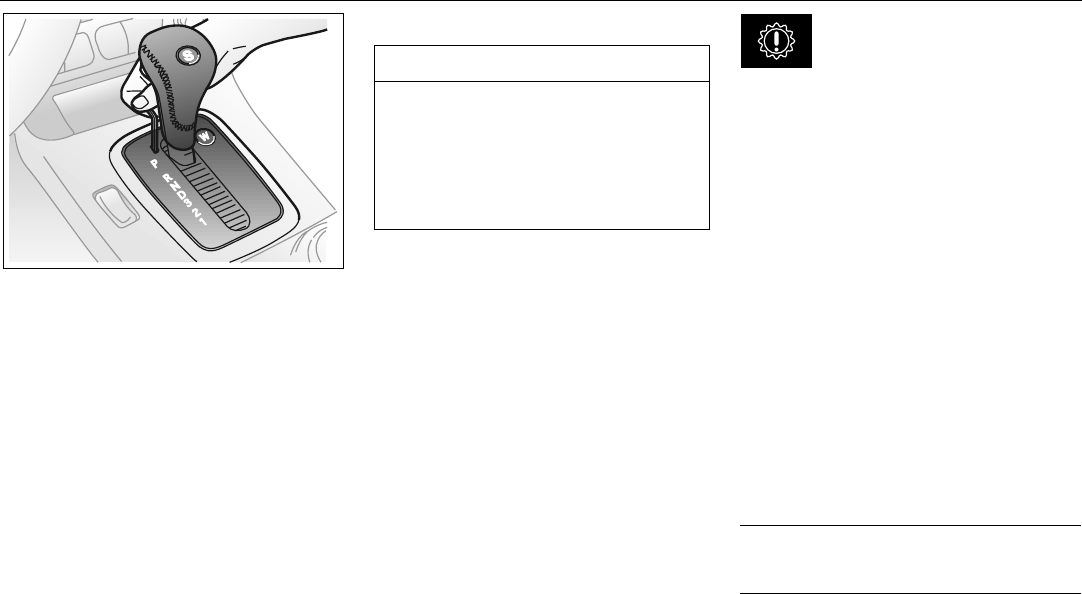
140 Starting and driving
Shift Lock override
1 Apply the parking brake
2 Make sure the key is in position ON
3 Use a small tool such as a screwdriver
and push the lever (see picture) down-
wards so that the detent button can be
pressed approx. 10 mm
4 Move the selector out of position P to N
5 Remove the tool
6 Release the parking brake if the car is to
be moved immediately; otherwise keep
it applied
Check fuse No. 1 (see page 194). If the fuse
is OK, check the battery regarding the volt-
age.
If the problem was cured by changing the
fuse or battery, you do not have to contact a
Saab dealer.
If the fuse blows again as soon as the Shift
Lock feature is activated you should contact
your Saab dealer.
Fault indicator, automatic
transmission
If ”Fault indicator, automatic transmission”
indicator appears on the main instrument
panel, the system has detected a fault in the
automatic transmission or its control
module (see page 50).
This also means that the Limp-home mode
has been selected, to guard against further
damage being done to the transmission. In
this mode, the automatic transmission
starts in 4th gear, and gear changes (if nec-
essary) will have to be made manually.
It is not possible to select the SPORT or
WINTER mode when the Limp-home mode
is active.
You should have the automatic transmis-
sion checked as soon as possible by an
authorized Saab dealer.
The following gears will be engaged in the
respective selector positions when the auto-
matic transmission is in the Limp-home
mode:
NOTE
Due to electrical problems it may not be
possible to move the selector out of the
park position, even if the ignition is ON. If
for some reason the selector has to be
moved out of the park position (i.e. to tow
the car a short distance) do as described
below.
Position R D 3 2 1
Gear Reverse 4th 4th 3rd 3rd
IB1122

141Starting and driving
Overheated transmission fluid
If the automatic-transmission fluid should
overheat, the following message will appear
on the SID:
”TRANSMISSION OVERHEATING”. If this
happens, stop the car and wait for the mes-
sage to be extinguished. Continue driving in
a locked gear that produces an engine
speed of about 3,000 rpm.
Overheating of the automatic-transmission
fluid can occur when the car is towing a
heavy load, such as a camping trailer in hilly
country, with the wrong gear selected,
resulting in abnormally frequent gear
changing. Try selecting position 1, 2 or 3.
High ambient temperatures can also
increase the temperature of the transmis-
sion fluid or the oil cooler may be faulty.
Contact an authorized Saab dealer (see
also page 152).
Towing
Towing of cars with automatic transmission,
see page 158.
NOTE
If the control module has actuated the
Limp-home function for the automatic
transmission, the car will remain in 4th
gear when D is selected, making it very
sluggish. To overcome this, move the
selector lever to position 2.
WARNING
Remember to use engine-braking (selec-
tor position 1, 2, or 3) to spare the brakes
when you are driving on a long or steep
downhill slope. Select the same gear as
you would on the corresponding uphill
slope.
Brake failure can result from overheated
brakes!
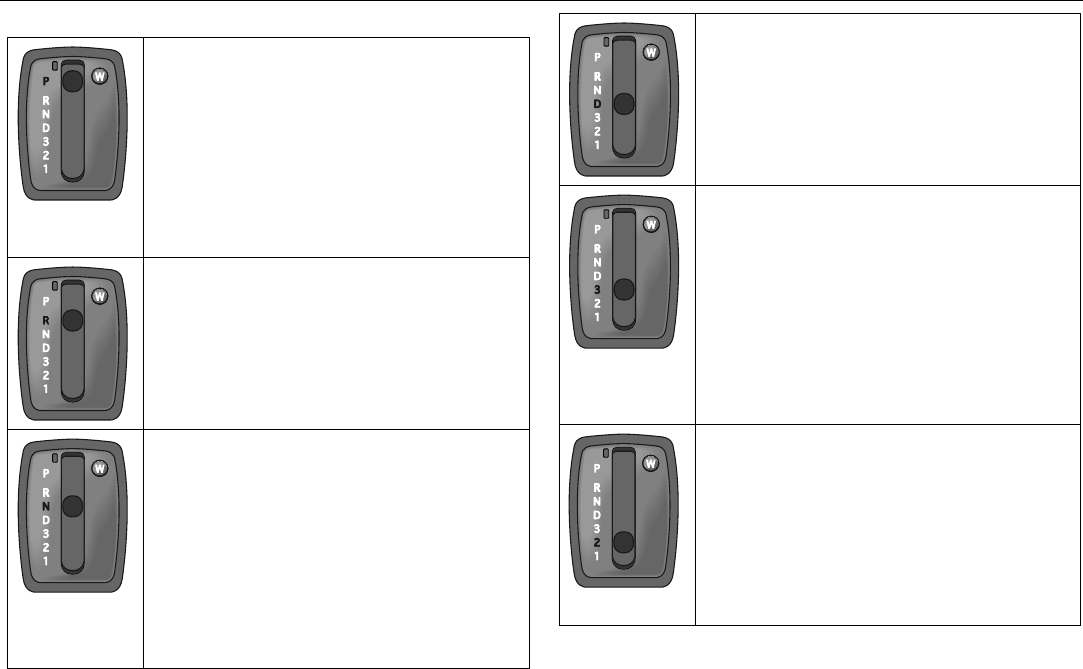
142 Starting and driving
Selector positions
P
To shift out of the P position you must
depress the brake pedal and the ignition
must be ON.
The parking position (P) must only be selected
when the car is at a complete standstill. The
selector lever is locked and the transmission is
mechanically immobilized. Always apply the
parking brake after parking the car.
The engine can be started. The key can be
removed.
R
The reverse (R) position must only be selected
when the car is at a complete standstill. The
detent-release button must be pressed before
the selector lever can be moved to R. Wait until
reverse gear has engaged (car starts to creep)
before touching the accelerator.
N
In the Neutral position (N), the transmission is
disengaged from the engine. The engine can be
started, but first ensure that the parking brake is
on, to prevent the car from moving off unexpect-
edly.
To prevent the engine and transmission from
becoming hotter than necessary, select N for
stops other than brief ones, e.g. if stuck in a traf-
fic jam.
The normal drive position (D) is recommended
for waiting at traffic lights.
D
The Drive position (D) is the position for normal
motoring. Gear changes between 1st and 4th
will take place automatically, the timing of which
is determined by the throttle (accelerator) posi-
tion and the speed of the car.
After moving the selector lever to D, pause to
give the gear time to engage (car starts to pull).
3
In position 3, 4th gear is locked out. The car will
start in 1st gear and normal gear changing (up
and down) will take place automatically between
gears 1, 2 and 3.
Position 3 is recommended on roads with fre-
quent bends and in congested traffic.
Moving the selector lever from D to 3 will effect
a change-down to 3rd gear, which will give better
engine-braking.
Do not move the selector to position 3 at speeds
in excess of 90 mph (150 km/h).
2
Position 2 is recommended in hilly country. This
gear enables the performance of the engine to
be exploited better and also provides effective
engine-braking. Normal gear changing (up and
down) between 1st and 2nd gear will take place
automatically. Third and 4th gears are locked
out.
Do not move the selector to position 2 at speeds
in excess of 70 mph (110 km/h).

143Starting and driving
If the gear selector lever is moved from position D to 1, a
change-down to 3rd gear will occur at about 110 mph (180 km/h).
A change-down to 2nd gear will occur at about 75 mph (120 km/h)
and to 1st gear at about 40 mph (65 km/h).
When position 1 is selected, all the other gears will be locked out.
Manual gear-changing is not recommended on slippery roads.
Adaptive gear-change patterns
Adaptive gear-change patterns are selected automatically depend-
ing on the engine load and the present temperature of the transmis-
sion. The function is available in Normal and Sport modes.
The changes occur at a higher engine speed and the car remains in
the same gear for longer, if the transmission control module senses
that the load has not decreased. These gear-change patterns pre-
vent unnecessary changing up and down, when for example driving
up long slopes with a trailer or caravan, and to prevent overheating
the transmission oil. The adaptive gear-change function is also
selected automatically when the transmission oil becomes too hot,
to protect the transmission itself from serious damage and to lower
the oil temperature.
The adaptive gear-change pattern function is deselected when:
• Winter mode is selected.
• The engine is switched off.
• The load is reduced so much that the function is no longer
required.
• “Fault indicator, automatic transmission” appears on main
instrument panel, see page 140.
1
Position 1 should be used when maximum
engine-braking is required on steep downhill
slopes and to avoid frequent gear-changing on
steep climbs.
Do not move the selector to position 1 at speeds
in excess of 37 mph (60 km/h).
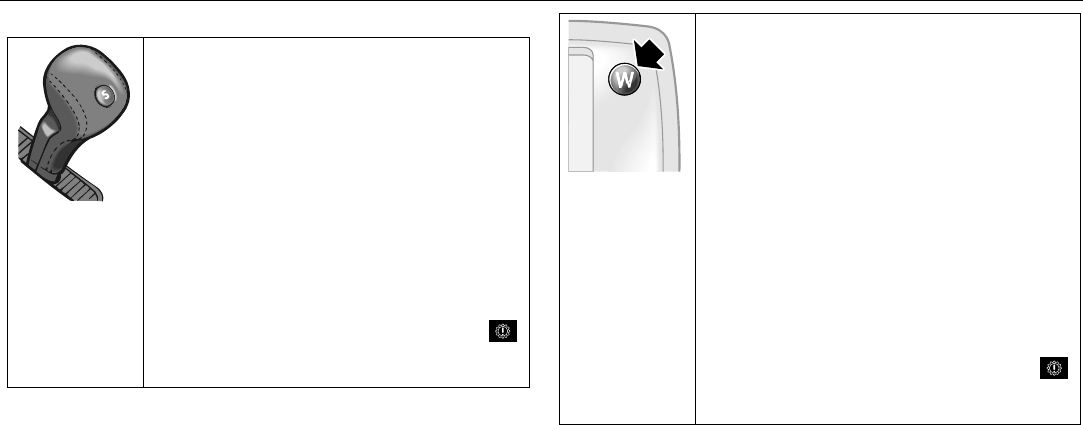
144 Starting and driving
SPORT and WINTER modes
To select Sport mode, press the ”S” button on
the selector lever when the selector lever is in
position N, D, 3, 2 or 1.
In this mode, gear changes will take place at
higher engine speeds than in Normal mode, in
other words, the transmission will change up
later and change down earlier for the same throt-
tle (accelerator) position.
The Sport mode will be deselected if:
• The S button is pressed.
• The selector lever is moved to position P or R.
• The engine is switched off.
• The Winter mode is selected.
• “Fault indicator, automatic transmission”
appears on main instrument panel, see page
140.
The Winter mode facilitates pulling away and
driving on icy roads. Third gear is selected auto-
matically for pulling away to reduce wheelspin.
Winter mode can be selected when the engine
is running by pressing the ”W” button on the
selector-lever surround. It cannot be selected
when the selector lever is in position 2 or 1.
Note: It is still possible to use kick-down in the
Winter mode, in which case a change-down to
1st or 2nd will take place.
The Winter mode will be deselected if:
• The W button is pressed.
• The engine is switched off.
• The selector lever is moved to position 2 or 1.
• Kick-down is activated.
• The automatic-transmission fluid overheats.
• “Fault indicator, automatic transmission”
appears on main instrument panel, see page
140.

145Starting and driving
Cruise control
The system is operated by means of the
controls on the stalk switch:
• ON/OFF (switch on/off).
• RES/– (Resume preset speed).
• SET/+ (to set the desired speed).
• CANCEL (Cancel operation of system,
e.g. to reduce speed temporarily).
When the system is ON, the CRUISE indi-
cator light will appear on the main instru-
ment panel and will be extinguished when
the system is switched OFF. If CANCEL is
selected, CRUISE will flash once.
To set the desired speed
Move the switch to ON. Accelerate to the
desired speed (minimum speed: 25 mph
(40 km/h)) and press SET/+.
To increase the preset speed
Accelerate to the desired speed and press
SET/+.
You can also increase the speed of the car
using the SET/+ button. Press it once to
increase the speed by 1 mph (1.6 km/h) or
hold it in and release when the desired
speed is reached.
Temporary increase in speed
Press the accelerator to override the preset
speed, e.g. for overtaking.
When you release the accelerator, the
system will revert to the preset speed.
To cancel temporarily
Move the control stalk to CANCEL
(spring-loaded position before OFF posi-
tion). This will disengage the system but the
preset speed will be retained in the system
memory. (The memory is deleted when the
engine is switched off.)
To re-engage the system
To revert to the preset speed, slide the
switch to RES/–. This will only operate when
the car’s speed is above 25 mph (40 km/h).
To reduce the preset speed
The cruise-control system will always disen-
gage automatically the moment that either
the brake pedal or the clutch pedal is
depressed.
It is also possible to reduce the speed by
means of the RES/– button.
Sliding the button to RES/– once will reduce
the speed by 1 mph (1.6 km/h). Holding the
button in the RES/– position will effect a
gradual reduction in speed until the button
is released.
Disengaging the system
The system will be disengaged:
• When the brake or clutch pedal is
depressed.
• When the switch is moved to CANCEL.
• When the switch is moved to OFF.
• When the engine is switched off.
• When the selector lever is moved to posi-
tion N (cars with automatic transmission).
WARNING
• Do not use the Cruise-control system
on wet or icy roads, in dense traffic or
on winding roads.
• Set the control to OFF when you do
not want to use the system, to prevent
the system being activated inadvert-
ently.
IB475
Cruise-control switches
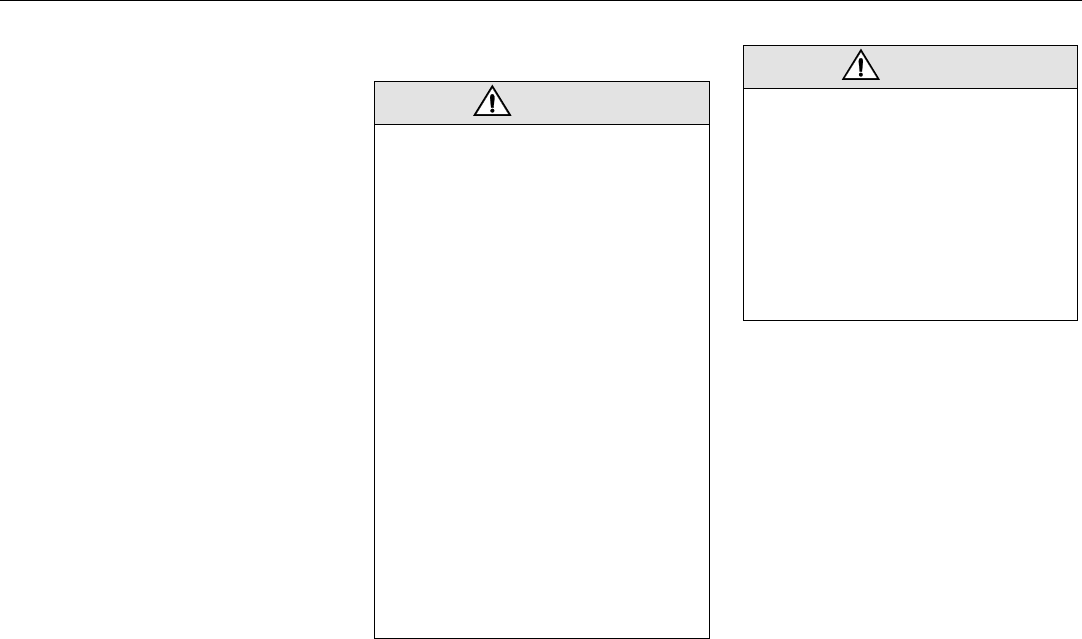
146 Starting and driving
Braking
To avoid the brakes becoming overheated,
(e.g. when negotiating long descents with a
drop of several hundred feet), select a low
gear to use the braking effect of the engine.
If the car has automatic transmission, move
the selector lever to position 1 or 2.
When driving fast, you can help to prolong
the life of the brakes by thinking ahead and
braking harder for short periods, rather than
braking more moderately over long
stretches.
Brake pad wear indicators
The outboard brake pads on the front
wheels incorporate pad-wear indicators.
When the lining is down to 3 mm, the pad
will produce a screeching, squealing or
scraping noise when the brakes are applied.
New pads should be fitted without delay.
Brake pads should only be replaced by
an authorized Saab dealer.
To ensure optimum brake performance,
it is recommended that you use only
Saab original brake pads.
ABS brakes
ABS (antilock braking system) modulates
the brake pressure to the respective
wheels. Wheel sensors detect if a wheel is
about to lock, and the control module
reduces the pressure to that wheel and then
increases it once more until the tendency is
detected again.
The brake system is equipped with an Elec-
tronic Brake-force Distribution device
(EBD), which distributes the brake pressure
between the front and rear wheels, in such
a way as to achieve optimum braking perfor-
mance irrespective of the car’s speed and
load.
The ABS system has a built-in diagnostic
function which will switch on the Anti-lock
brake warning light if a fault is detected in
the system (see page 48).
WARNING
• It is prudent to try your brakes from
time to time, especially when driving in
heavy rain, on roads with a lot of sur-
face water, or in snow or slush. In such
conditions, the brakes may take
longer than normal to take effect. To
rectify this, touch the brake pedal peri-
odically to dry the brakes out.
The same applies after the car has
been washed or when the weather is
very humid.
• The brakes are power assisted and it
should be kept in mind that the servo
unit only provides the power assis-
tance when the engine is running.
• The brake pressure required when the
engine is off,( e.g. when the car is on
tow) is roughly four times the normal
pedal force required. The pedal also
feels hard and unresponsive.
• We advise against using wheels with
open wheel covers in winter, as the
brake components are then more
exposed both to slush, road salt and
grit.
WARNING
• The additional safety afforded by the
ABS system is not designed to allow
drivers to drive faster but to make
normal driving safer.
• To stop as quickly as possible, without
loss of directional stability, whether
the road surface is dry, wet or slippery,
press the brake pedal down hard-
without letting up, declutching
simultaneously, and steer the car to
safety.

147Starting and driving
The ABS system will not reduce the braking
distance on loose gravel or on snow or ice
but, because the wheels cannot lock up,
some steering control is retained.
When the ABS system is working, i.e. mod-
ulation of the brake pressure is in progress,
the brake pedal will pulsate and a ticking
noise will be heard. All this is perfectly nor-
mal.
Press the pedal down hard (you cannot
press too hard) and steer the car to safety.
Do not release the brake pedal before the
car has come to a halt or the danger is
past!
That is critical.
If the road is slippery, the ABS system will
operate even when only light pressure is
applied to the pedal. This means that you
can brake gently to test the condition of the
road and adapt your driving accordingly.
It is well worth practicing the use of ABS
brakes on a skid pan or other suitable facil-
ity.
Traction Control System
How the system works
The traction control system (TCS) is
designed to prevent wheelspin. This
enables the car to achieve the best possible
grip and, hence, maximum tractive effort,
together with greater stability.
The TCS system uses information from the
ABS system’s wheel sensors to detect
when the front (driving) wheels are rotating
faster then the rear wheels. It then monitors
whether one driving wheel is rotating faster
than the other. If so, the faster wheel is
retarded until both wheels are rotating at the
same speed.
If the two front wheels are rotating at the
same speed but are turning faster than the
rear wheels, the torque from the engine is
reduced to eliminate the difference.
The process continues until all the wheels
are rotating at the same speed.
The advantages of the TCS system become
most apparent when the cohesion between
the front wheels and the road surface is so
low that one or both of the wheels would
lose their grip were the car not equipped
with the TCS, e.g.:
• When the car is pulling away or accelerat-
ing with the front wheels on different sur-
faces (e.g. one slippery and one dry). The
TCS then functions like an electronic dif-
ferential lock.
• When the car is pulling away or accelerat-
ing on a slippery road, in which case the
Braking with ABS brakes
When the system is operating, the brake
pedal will pulsate gently and the system
will make a ticking noise
IB476
IB477
Braking with ABS – evasive steering

148 Starting and driving
TCS eliminates wheelspin. The same
applies when the car is reversing.
• On cornering, if there is a tendency for the
inner front wheel to rotate faster than the
other wheels.
• On overtaking.
TCS OFF
The TCS OFF indicator on the main instru-
ment panel will come on:
• If a fault has been detected and the
system has therefore been switched off.
• If there is a fault in the ABS system.
• If the system has been switched off man-
ually.
The indicator light will also come on for
4 seconds when the ignition key is turned to
ON, while an internal system check is per-
formed.
TCS indicator
The indicator light will come on for
4 seconds when the ignition key is turned to
ON, while an internal system check is per-
formed.
The TCS light in the tachometer comes on
when the system is operative, i.e. when the
wheels are not rotating at the same speed.
The fact that the TCS system is operative
indicates that the limit for grip has been
exceeded and that the driver must exert
greater care.
Turning the TCS off
The TCS is switched on automatically when
the engine is started.
The system can be switched off manually by
the TCS button, whereupon TCS OFF on
the main instrument panel will come on. The
TCS system cannot be switched off if the car
is travelling faster than 35 mph (60 km/h).
It may be necessary to switch off the system
if the car has become bogged down, for
instance. Press TCS to switch it on again.
If a fault is detected in the ABS system, the
TCS will be switched off automatically.
The cruise-control system will automatically
be disengaged after one second if it is active
when the TCS starts to operate.
WARNING
In normal driving, the TCS system
enhances the safety of the car, but it does
not mean that the car can be driven faster.
The same care and prudence normally
applied should be displayed on cornering
and when driving on slippery roads.
IB478

149Starting and driving
Economical motoring
Factors affecting fuel consumption
Fuel consumption is greatly affected by the
general driving conditions, the way in which
the car is driven and at what speeds, the
weather, the state of the road, the condition
of the car, etc.
Breaking-in
Fuel consumption may be somewhat higher
during the break-in period (the first 3,000–
4,000 miles (5,000–7,000 km) than stated
under ”Technical data”.
Weather conditions
Fuel consumption can be as much as 10 %
lower in summer than in winter. The higher
consumption in cold weather is explained by
the longer time it takes for the engine to
reach normal operating temperature, and
for the transmission and wheel bearings to
warm up. Fuel economy is also affected by
the distance driven: short journeys of
3-5 miles (5-8 km) do not give the engine
enough time to reach normal temperature.
Strong winds can also affect fuel consump-
tion.
How to read the graph on the right:
If fuel consumption with the engine at
normal temperature is 28 mpg
(10l/100 km), the actual fuel consumption 3
miles (5 km) after the engine has started
from cold will be:
– 23.5 mpg (12l/100 km) at outside temp.
of 68°F (20°C) (increase of 20%).
– 17.7 mpg (16l/100 km) at outside temp.
of 32°F (0°C) (increase of 60%).
– 14 mpg (20l/100 km)) at outside temp. of
–4°F (–20°C) (increase of 100%).
As can be seen, both the distance travelled
by the car and the outside temperature have
a major impact on fuel consumption after
the engine has started from cold. Thus, if the
car is mainly used for short journeys of
3–5 miles (5–8 km), the fuel consumption
will be 60–80 % higher than normal.
Driving technique
• To obtain the best running economy, not
only regarding fuel consumption but gen-
eral wear also, regular service is required.
• High speed, unnecessary acceleration,
heavy braking and much low gear work all
gives rise to higher fuel consumption.
• Frequent gear changing in traffic, starting
in cold weather, the use of studded tires
and roof racks, and towing a trailer all
increase fuel consumption.
• Do not run the engine when the car is sta-
tionary.
IB311
Percentage increase in fuel consumption
of engine starting from cold compared to
engine at normal temperature.

150 Starting and driving
If idling, it will take much longer before the
engine becomes hot. Engine wear is
greatest during this warming-up phase.
Therefore drive away as soon as possible
after the engine is started and avoid high
revving.
• Driving in a low gear results in higher fuel
consumption than in a high gear because
of the higher engine speed for a given
road speed. Always change up to a higher
gear as soon as traffic conditions allow
and use the highest gear as much as pos-
sible.
• Check the air pressure in the tires once a
month. Incorrect pressures increase tire
wear. It is better to have slightly higher
pressure than lower.
• Check fuel consumption regularly.
Increased consumption can indicate that
something is wrong and that the car
needs to be checked by an authorized
Saab dealer.
Practical trials on the roads have demon-
strated that substantial savings in fuel con-
sumption can be made if the above advice
is heeded.
Road conditions
Wet roads increase fuel consumption, as do
unpaved roads and driving in hilly country
(the amount of fuel saved driving downhill is
less than the additional amount required to
climb the hill).
Engine block heater (standard
equipment in Canada, accessory in
U.S.)
The following are just some of the benefits
to the car and the environment of using an
engine block heater:
• Lower fuel consumption.
• Reduced wear on the engine.
• Inside of car warms up faster.
• Exhaust emissions substantially reduced
over short runs.
The engine heater is effective at outside
temperatures up to +15-20°C. The warmer
it is outside, the shorter the time the engine
heater needs to be connected. Longer than
1.5 hours is unnecessary.
If the car is equipped with a removable,
electrical cabin heater that is not in use, this
should be stored in the luggage compart-
ment.
Driving in winter
Before starting a journey in cold weather,
check that the wiper blades have not
become frozen to the glass. Brush any snow
away from the air intake for the heater
system (opening between hood and wind-
shield).
Periodically during the winter, add gasoline
anti-freeze to the fuel to dispel any conden-
sation in the fuel tank which could freeze
and cause problems in the system. Keep
the tank well filled to reduce the risk of con-
densation forming.
If the car is parked outside in freezing
weather, fuel additives (gasoline
anti-freeze) will not do any good as any con-
densation in the fuel tank will freeze. Con-
densation is caused by changes in the out-
door temperature or by the car being parked
alternately in a garage and outside.
It is particularly important when the roads
are slippery that the brakes and tires be in
good condition.
The car is equipped with tires designed to
provide optimum grip on both wet and dry
roads, although this has been achieved at
the expense of somewhat reduced grip on
snow and ice. For regular driving on snow
and ice, we therefore recommend that
winter (snow) tires be fitted.
Winter (snow) tires, particularly studded
tires (where use is legally permitted), gener-
ally make driving safer on snow and ice.
If winter tires are fitted, the same type must
be fitted on all wheels. Your Saab dealer will
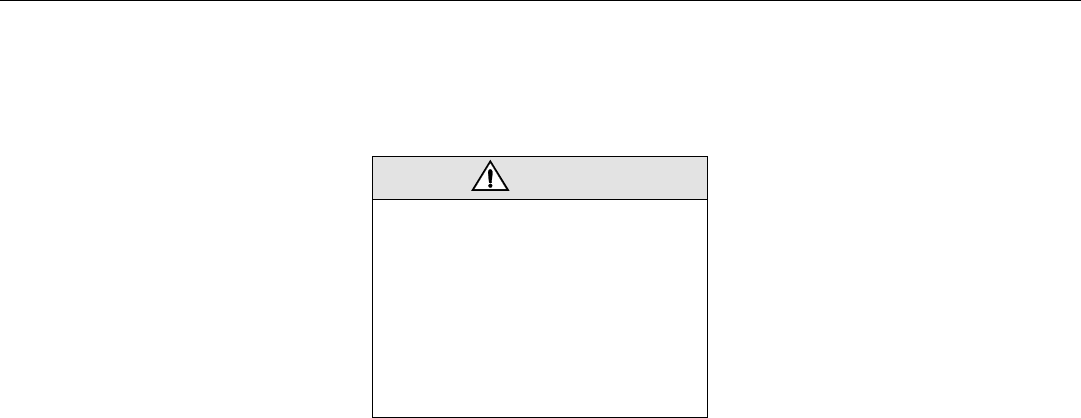
151Starting and driving
be pleased to advise you on the best tires for
your car.
Remember that tires age. It may therefore
be necessary to change them before they
reach the legal wear limit, as they gradually
lose their friction properties.
The best response if the car gets into a
front-wheel skid is to freewheel (manual
gearbox only), i.e. disengage the clutch (so
that the wheels are neither driven or
retarded by the engine.
If the car has automatic transmission, ease
up on the accelerator and steer carefully in
the desired direction.
In a rear-wheel skid, steer in the same direc-
tion that the rear of the car is moving.
Tire chains
If you want to fit tire chains (where legally
permitted) they should only be fitted to the
tires recommended under ”Specifications”
(see page 233).
Consult your Saab dealer for details of
approved tire chains.
Driving in hot weather
• Always check the coolant level before
starting a journey. The level should be just
below the MAX mark.
• At the end of a journey, if the engine has
worked hard, allow it to idle for two or
three minutes before switching it off.
If the needle on the temperature gauge
enters the red zone:
1 Bring the car to a standstill but leave the
engine running. Do not remove the cap
on the expansion tank even if the tank is
empty. If the needle on the temperature
gauge continues to rise while the engine
is idling, switch off the engine.
2 Wait until the needle has dropped back
to indicate normal temperature (roughly
midway, in the white zone) before stop-
ping the engine. If the coolant needs top-
ping up, unscrew the cap on expansion
tank carefully.
Top up, as necessary, ideally with a
50/50 mixture of Saab-approved coolant
and water. If only water is available, use
that, but remember to have the coolant
mixture checked as soon as possible.
WARNING
• Do not exceed 30 mph (50 km/h)
when tire chains are fitted.
• Check the links frequently for wear.
• Tire chains can reduce the directional
stability of the car.
• Tire chains must not be used on the
rear wheels.
• Check that the chains do not contact
the wheel-arch liner at full lock.
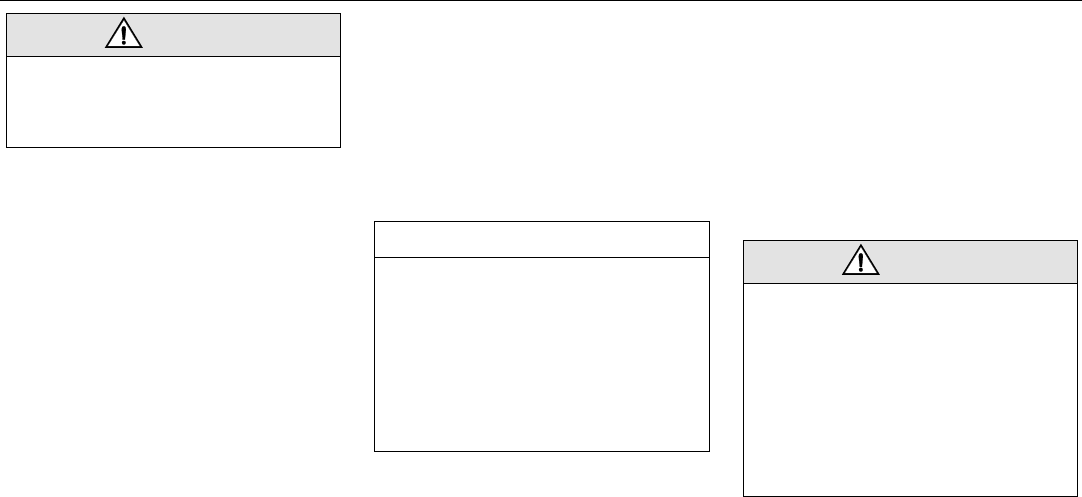
152 Starting and driving
3 As soon as possible, have the cooling
system checked by an authorized Saab
dealer.
Towing a trailer
Trailer hitch attachment
Trailer hitch attachments are available as
accessories. These are designed for a max-
imum trailer weight of 2000 lbs. (900 kg).
Use only the electrical trailer hitch socket
provided in the spare wheel area in the lug-
gage compartment for connecting the trailer
electrics.
Trailer weight
Maximum recommended trailer weights for
different gradients, with a view to comfort
and drivability for manual and automatic
cars, are shown on the drawing.
Make sure you are familiar with the law
regarding speed limits for towing, maxi-
mum trailer weights, trailer-braking
requirements, and also any special
driving-licence provisions
(see also page 227).
The specified trailer weights and gradients
assume that the journey starts at the hill and
therefore apply only to short periods.
WARNING
Always undo the expansion tank filler cap
carefully, releasing the pressure and any
vapor before removing the cap com-
pletely.
NOTE
Use only a genuine Saab trailer hitch,
since other models can damage the car’s
bodywork and electrical system (or in
Canada, a high quality hitch designed to
fit the car, available from a trailer hitch
specialist).
Consult an authorized Saab dealer for
guidance on how to connect the trailer
hitch electrical system.
WARNING
When towing a trailer, do not attempt to
negotiate a hill having a gradient in
excess of 15%. The weight distribution
over the front wheels of the car will be
insufficient to prevent wheelspin, making
further progress impossible.
In addition, the parking brake may not
always be able to hold the car and trailer
securely, with the result that the wheels
can start to slide downhill.
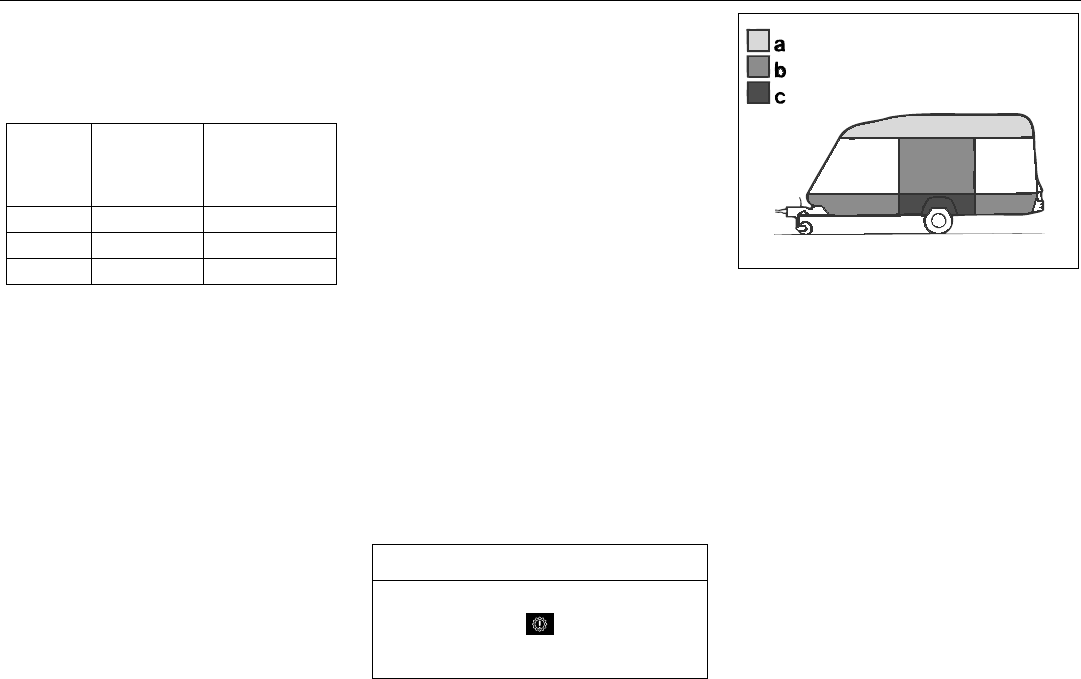
153Starting and driving
Recommendations for cars with auto-
matic transmission.
The following time limits are based on the
capacity of the cooling system in warm
weather, i.e. approximately 104°F (40°C).
When negotiating long hills, bear the follow-
ing important considerations in mind:
If TRANSMISSION OVERHEATING
appears on the SID, stop the car as soon as
it is safe to do so and wait until the warning
has been extinguished. When continuing
your journey, select a locked gear (1, 2 or 3)
that will allow you to drive at an engine
speed of about 3,000 rpm (see page 142).
Do not drive continuously with the WINTER
mode selected in hilly country when you are
towing a trailer, as this will increase fuel con-
sumption and risk overheating the transmis-
sion.
Trailer hitch load
The weight distribution on the trailer makes
a lot of difference to the handling properties
of the car and trailer combination. As
regards single-axle trailers, whenever pos-
sible, concentrate the load over the wheels
and keep it as low as possible.
The trailer should be loaded so that the
maximum load on the towbar ball is 5% to
7% of the trailer weight with a maximum per-
missible tongue weight of 165 lbs. (75 kg).
Note that this load must be added to the total
load for the car. If this now exceeds the
specified load capacity, the load in the lug-
gage compartment will have to be reduced
by a corresponding amount.
Driving considerations
Always take extra care when towing a
trailer, as the car’s handling will be different
and its braking effect reduced. The trailer’s
braking system and suspension also have a
considerable effect on these characteris-
tics.
If the car is equipped with automatic trans-
mission, select position 1 when ascending
or descending steep hills.
Gradient
of hill, % Maximum
trailer
weight, lbs.
(kg)
Maximum dura-
tion, minutes
6-7 2000 (900) unlimited
8-9 2000 (900) 15 max
10-15 1000 (450) 15 max.
NOTE
If the “Fault indicator, automatic trans-
mission” indicator comes on, cease
towing until the problem has been recti-
fied.
IB106
Distribution of load in trailer
a Light
b Moderate
cHeavy
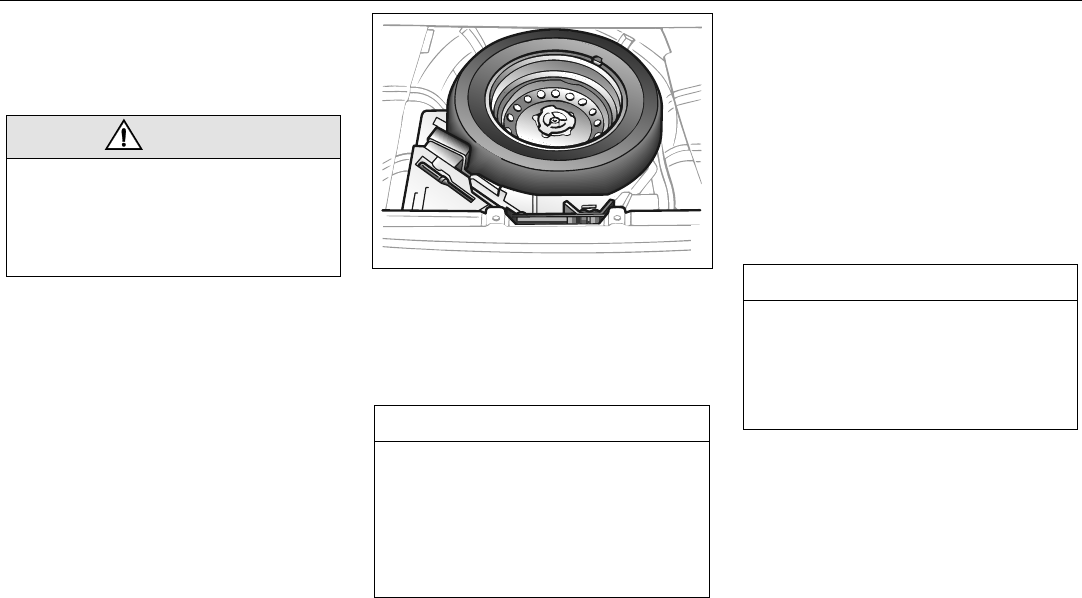
154 Starting and driving
Driving considerations
with compact spare
wheel/tire fitted
The following should be observed when the
compact spare wheel (T115/70 R16) is
fitted:
The compact spare is light and easy to
handle when changing the wheel. Do not
drive further than necessary with the com-
pact spare fitted – the maximum life of the
wheel is only just over 2000 miles
(3,500 km). Have the standard wheel
repaired and refitted as soon as possible.
The car’s ground clearance is reduced with
the compact spare fitted. Note that only one
compact spare wheel may be used at any
time. Take care not to hit the curb and do not
fit snow chains. Leave the wheel cover off,
so that the warning text is readily visible.
Driving with the trunk
lid/tailgate open
Avoid driving with the trunk lid/tailgate partly
or fully open, since exhaust fumes can be
drawn into the cabin.
If you must drive with the trunk lid/tailgate
open, all windows and the sunroof (if fitted)
must be closed and the cabin fan on at its
highest speed setting.
Driving in deep water
WARNING
Do not exceed 50 mph (80 km/h) as the
tire can overheat and adversely affect the
handling of the car.
The tire should be inflated to 60 psi
(420 kPa).
NOTE
To avoid damaging a punctured alloy
wheel it can be placed outside up in the
spare-wheel well but only while driving to
the closest workshop.
A general rule is that all heavy loads must
be well secured in the luggage compart-
ment, see page 118 and 121.
NOTE
Do not drive in water deeper than
12 inches (30 cm) and do not drive faster
than at idling speed. Water can otherwise
be sucked into the engine. The engine will
be damaged if water enters the intake
system.
IB465

155Starting and driving
Driving with a roof rack
load
The maximum permissible roof load is
220 lbs. (100 kg).
Note that the roof load is included in the
car’s maximum permissible load (see page
226).
Strong, sturdy roof carriers designed spe-
cially for the car are available from your
Saab dealer. Always secure the roof load
safely.
Fitting the roof carriers (accessory)
9-5 Sedan
The carrier feet are marked with a top view
of the car and arrow indicating their posi-
tions.
1 Slip the plastic cover onto the adjustable
foot of the carrier (foot with knob for
tightening) to protect the paintwork
during assembly.
2 Open all the doors.
Fold back the rubber strip and find the
fixing holes.
3 Start on the left-hand side of the car.
Rest the carrier carefully across the roof,
with the rigid foot towards you. Hold the
foot clear of the roof to avoid damaging
the paintwork.
Fold back the rubber strip and insert the
pins on the foot into the fixing holes.
Make sure that the rubber strip comes
inside the plastic cover on the carrier.
Repeat the procedure with the other car-
rier.
4 Close the doors on the left-hand side of
the car gently, to hold the carrier feet in
place.
5 Now go around to the other side of the
car and remove the plastic cover from
the carrier’s adjustable foot. Fold back
the rubber strip and insert the pins on
the foot into the fixing holes. Do the
same with the other carrier and close the
doors gently.
6 Tighten each carrier by turning the knob
clockwise (by hand). Tighten just
enough to bring the foot up against the
edges of the fixing holes.
Remove the carriers when not in use, as
they increase fuel consumption.
The instructions that accompany the carri-
ers also include advice on driving with a roof
load - we strongly recommend that you read
them carefully.
WARNING
• A roof load will affect the car’s center
of gravity and aerodynamics. Be
aware of this when cornering and driv-
ing in crosswinds.
• Suit your speed to the prevailing con-
ditions.
IB480
IB481

156 Starting and driving
Fitting the roof carriers (accessory)
9-5 Wagon
1 Clean the car’s roof rails.
2 Check the markings on the cross mem-
bers to see which is the front and which
is the rear roof carrier.
3 Place the cross members on the roof
rails, on their respective sides of the
centre supports. The cross members
must not be placed beyond the front or
rear joint on the rail. Ensure that the dis-
tance between the cross members is at
least 28 inches (700 mm).
If a roof box is to be fitted, the cross
members must be positioned so that the
tailgate can be opened fully without hit-
ting the roof box.
4 Using your thumb, press the bracket so
that it lies snugly against the outside of
the roof rail. Make sure that the roof car-
riers are seated centrally on the rubber
spacers and that these sit correctly on
the roof rail. Pull the spacers down
slightly on the inside of the roof rail.
5 Center the roof carriers so that they pro-
trude equally on both sides.
6 Tighten the roof carriers by hand.
Ensure that the tightening knobs are
upright once the roof carriers have been
tightened.
7 Make sure the roof carriers are securely
in place.
IB1294
IB1295

157Starting and driving
Driving with a load
The driving characteristics of the car are
affected by the way it is loaded.
• Place heavy loads as far forward and as
low as possible in the trunk.
• Secure the load to the tie downs, see
page 118.
• The load should be such that the car´s
total weight or axle weight are not
exceeded, see page 226.
• Heavy loads mean that the car’s centre of
gravity is further back. As a result, the car
will sway more during evasive steering.
• Never exceed the permissible load in the
roof box, even if there is room for more.
• Ensure that the tire pressure is correct –
slight overinflation is preferable to under-
inflation.
• The braking distance of a loaded car is
always greater. Keep your distance from
the vehicle in front.
Tire pressure, see page 235 and back
cover.
Tires
The tire pressure should match the current
load and speed of the car; see the back
cover or the tire pressure label on
page 235.
The tire pressures given apply to cold tires,
that is tires that are the same temperature
as the outside air temperature.
The tire pressure increases as the tires
become warm (e.g. during highway driving)
with approximately 0.3 bar (4 psi). When
the temperature of the tires changes by 50°
(10°C), the tire pressure will change 0.1 bar
(2 psi).
Never reduce the pressure of a hot tire. If the
tires are hot when you check them, only
increase the pressure, if necessary.
Underinflated tires wear more quickly than
slightly overinflated tires.
If a valve is leaking, simply unscrew it and fit
a new one.
Important! Remember to adjust the tire
pressures if you change the load in the car
or intend to drive at substantially lower or
higher speeds than normal.
NOTE
Check the tire pressure at least once a
month. Underinflation is the main cause
of:
• Damage to the wheels.
• Premature tire wear.
• Damage to the sidewalls.
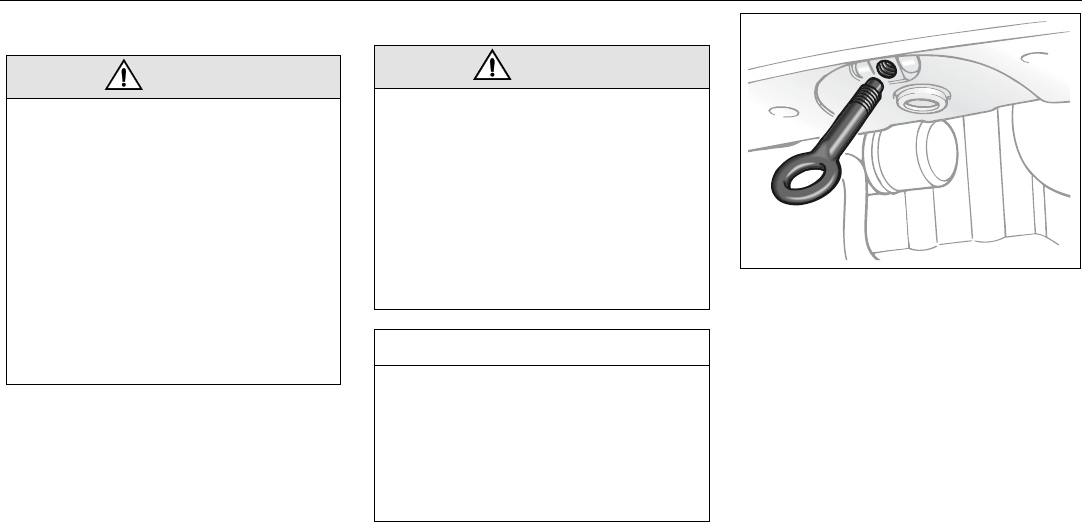
158 Starting and driving
Towing the car Front towing eye
The front towing eye is stored with the spare
wheel.
The attachment point (tapped hole) for the
towing eye is midway along the engine sub-
frame at the front of the car.
Remove the plastic plug and screw in the
towing eye securely.
To ensure that the towing eye is in far
enough, insert the handle of the wheel
wrench through the eye for additional lever-
age.
WARNING
• Remember that the brake servo does
not operate when the engine is off.
Much greater pressure than normal
will therefore be required to operate
the brake pedal.
• Nor does the steering servo operate
when the engine is off. The steering
will therefore be much heavier than
usual.
• The towing vehicle should always be
heavier than the vehicle on tow.
• Never allow passengers to ride in the
car being towed.
WARNING
• Make sure that the towing eye at the
front is screwed in tightly.
• The towing eye is only designed for
use when the car is being towed on the
road. It must not be used to pull the
car out of a ditch, for example. If the
towing eye were to shear suddenly, it
could cause serious injury.
• Always seek professional help if the
car needs to be recovered.
NOTE
• Do not drive the car with the front
towing eye in position. If it catches the
curb, for example, the engine sub-
frame could be damaged.
• Refit the plastic plug in the hole when
the towing eye has been removed, to
keep dirt out of the threads.
IB482
Front towing eye
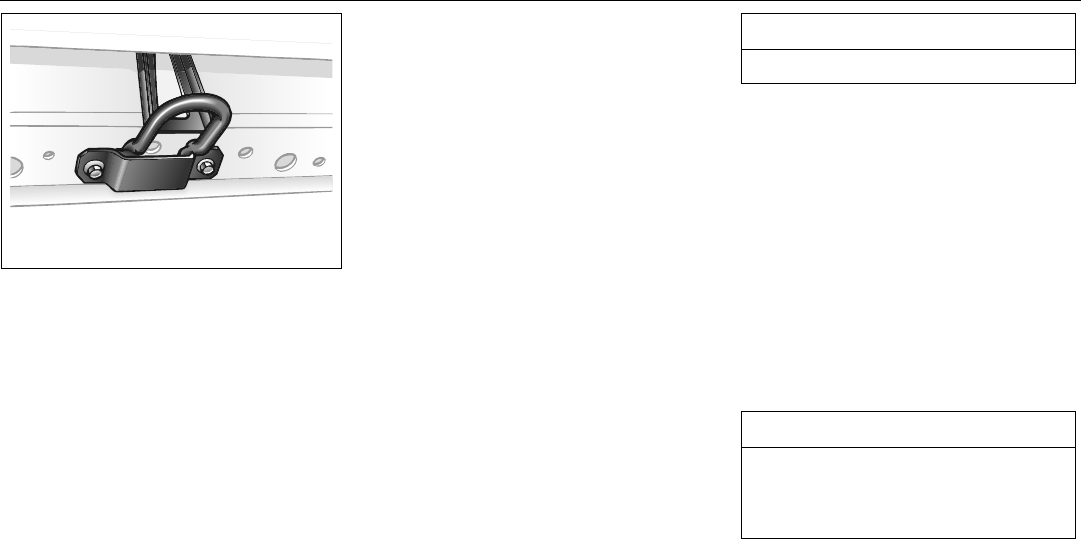
159Starting and driving
Rear towing eye
The car has a permanently mounted towing
eye at the back. If the car is equipped with a
trailer hitch, this can be used instead of the
towing eye.
Considerations when towing the car
with manual transmission
Gear lever in neutral and parking lights on.
Drive carefully and do not exceed the
speed limit for vehicles being towed.
Always try to keep the towrope taut by
gently applying the brake, as necessary.
This will avoid the towrope being jerked
violently.
Considerations when towing the car
with automatic transmission
Selector lever at N (neutral) and parking
lights on.
Drive carefully and do not exceed the
speed limit for vehicles being towed.
Always try to keep the towrope taut by
gently applying the brake, as necessary.
This will avoid the towrope being jerked
violently.
1 Selector lever in position N.
2 Always observe the speed limit for
vehicles in tow. Whatever the speed
limit, the car must not be towed at a
speed exceeding 13 mph (20 km/h) nor
for a distance of more than 18 miles
(30 km). If the car needs to be trans-
ported over a longer distance, a tow
truck should be called out.
Failure to follow these guidelines can result
in damage.
Cars with automatic transmission cannot be
bump started. In an emergency, it is possi-
ble to start the engine using jump leads (see
the section, ”Jump starting” on page 160).
NOTE
The car must be towed front first.
NOTE
If the car is to be towed with the front
wheels off the ground, make sure the
parking brake is off, as this acts on the
rear wheels.
IB483
Rear towing eye

160 Starting and driving
Jump starting
If your battery has run down, you may want
to use another vehicle and some jumper
cables to start your Saab. Follow the steps
below to do it safely.
To jump start your vehicle:
1 Check the other vehicle. It must have a
12-volt battery with a negative ground
system.
2 Get the vehicles close enough so the
jumper cables can reach, but be sure the
vehicles are not touching each other. If a
poor connection on the negative jumper
cable should exist, it is possible for
damage to be caused to electrical sys-
tems/components of either vehicle
should inadvertent contact be made.
You would not be able to start your car
and bad grounding could damage elec-
trical systems.
3 Turn off the ignition on both vehicles.
Turn off all lights that are not needed,
and radios. This will avoid sparks and
help save both batteries and it could
save your radio.
4 Open the hood and locate the battery.
Find the positive (+) and negative (-) termi-
nals on the battery.
WARNING
Batteries can cause injury. They can be
dangerous because:
• They contain acid that can burn you.
• They contain gas that can explode or
ignite.
• They contain enough electricity to
injure you.
If you do not follow these steps exactly,
some or all of these things can hurt you.
NOTE
Ignoring these steps could result in costly
damage to your vehicle that would not be
covered by your warranty.
Trying to start your car by pushing or pull-
ing it could damage your vehicle, even if
you have a manual transmission. If you
have an automatic transmission, your
vehicle cannot be started by pushing or
pulling it.
NOTE
If the other system is not a 12-volt system
with a negative ground, both vehicles can
be damaged.
WARNING
You could be injured if the vehicles roll.
Set the parking brake firmly on each vehi-
cle. Put an automatic transmission in P
(Park) or a manual transmission in Neu-
tral.
NOTE
If you leave your radio on, it could be
badly damaged. The repairs would not be
covered by your warranty.
+
–
+
–
IB484
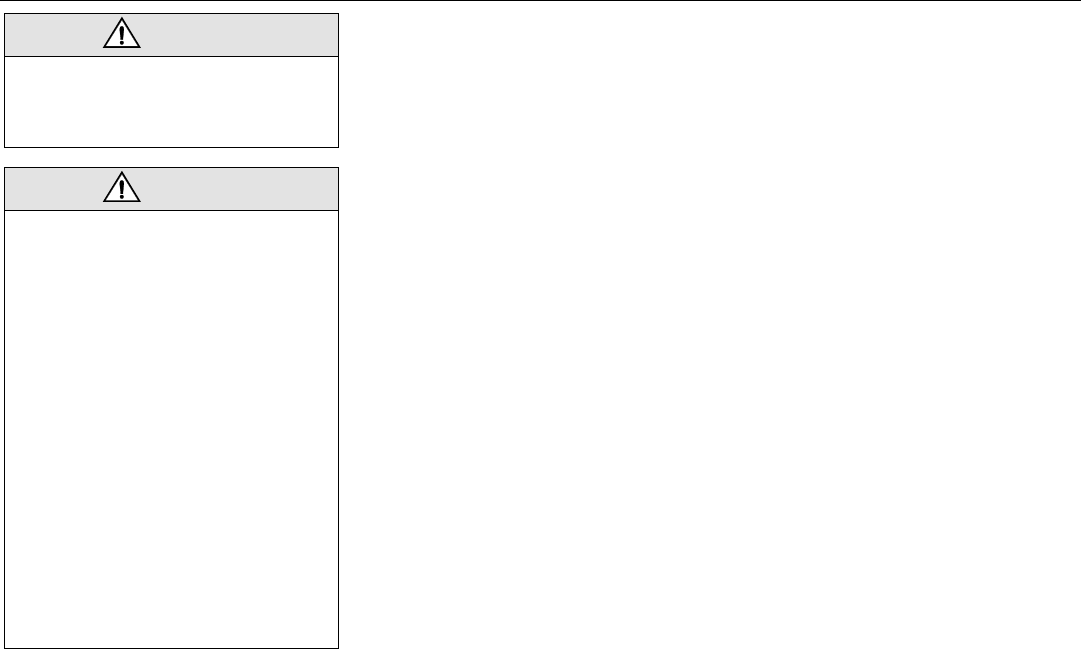
161Starting and driving
5 Check that the jumper cables do not
have loose or missing insulation. If they
do, you could get a shock and also the
vehicles could be damaged.
Before you connect the cables, here are
some basic things you should know.
Positive (+) will go to positive (+) and
negative (-) will go to negative (-) or a
major metal engine part with a good
ground. Do not connect (+) to (-) or you
will get a short that could injure you or
would damage the battery and maybe
other parts as well.
6 Connect the red positive (+) cable to the
positive (+) terminal of the vehicle with
the discharged battery.
7 Do not let the other end touch metal.
Connect it to the positive (+) terminal of
the good battery. Use a remote positive
(+) terminal if the vehicle has one.
8 Now connect the black negative (-)
cable to the good battery’s negative ter-
minal.
Do not let the other end touch anything
until the next step. The other end of the
negative cable does not go to the dead
battery. It goes to a major metal part with
a good ground on the engine of the vehi-
cle with the discharged battery.
9 Attach the cable at least 18 inches
(45 cm) away from the discharged bat-
tery, but not near engine parts that
move. The electrical connection is just
as good there, but the chance of sparks
getting back to the battery is much less.
10 Start the vehicle with the good battery
and run the engine for a while.
11 Try to start the vehicle with the dis-
charged battery. If it does not start after
a few tries, it probably needs service.
12 Remove the cables in reverse order to
prevent electrical shorting. Take care
that they do not touch each other or any
other metal.
WARNING
An electric fan can start up even when the
engine is not running and can injure you.
Keep hands, clothing and tools away from
any underhood electric fan.
WARNING
Using a match or flame of any kind near a
battery can cause battery gas to explode.
You can suffer burns or be blinded. Use a
flashlight if you need more light.
Be sure the battery has enough water.
The battery installed in your new Saab
has filler caps. Be sure the right amount
of water is there. Add distilled or boiled
water if the level is too low. If you don’t,
explosive gas could be present.
Be sure the electrolyte in the battery is not
frozen. Discharged batteries will freeze.
When connecting jumper cables to a
frozen battery, gas from the chemical
reaction inside the battery can build up
under the ice and cause an explosion.
Battery fluid contains acid that can burn
you. Do not get it on you. If you acciden-
tally get it in your eyes or on your skin,
flush the area with water and get medical
help immediately.

162 Starting and driving
Parking brake
The parking brake is situated between the
front seats and acts on the rear wheels.
When the parking brake is on, the indicator
light on the main instrument panel will be on.
To release the parking brake, lift the lever
slightly, press the release button and
release the lever by pushing down on it.
Parking
• Park where the vehicle will not create an
obstruction or a hazard to other road
users.
• Do not park on dry grass or other combus-
tible material. The catalytic converter gets
very hot and could start a fire.
• Apply the parking brake.
• Engage reverse (automatic transmission:
move selector lever to P (Park)), and
remove the ignition key.
• Lock the car.
WARNING
• Always apply the parking brake when
parking.
• Always apply the parking brake before
removing the ignition key.
• Do not use the parking brake when the
car is moving.
WARNING
Do not leave children or pets unattended
in the car. In warm, sunny weather, the
temperature inside the car can reach
160–180°F (70–80°C).
IB360

163Starting and driving
Parking on a hill
When parking on a steep hill, turn the front
wheels so that they will be blocked by the
curb if the car should move.
Long-term parking
If the car is not going to be used for some
time, e.g. 3–4 months, the following steps
are recommended:
• Run the engine to normal temperature
before long-term parking.
• Drain the washer-fluid reservoir and
hoses.
• Wash and wax the car. Clean the rubber
seals on the hood, luggage compartment
lid and doors, and lubricate them with
glycerol (glycerin).
• After washing the car, dry the brake discs
by taking the car out on the road and
applying the brakes a few times.
• Fill the fuel tank with fuel to prevent con-
densation forming in it.
• Top up the coolant and check the anti-
freeze before the onset of winter.
• Park the car in a dry, covered and
well-ventilated building. Leave the park-
ing brake OFF!
• Disconnect the negative (-) battery lead.
If frost is likely to occur during the
long-term parking, remove the battery
and store it away from the frost.
• Ideally, the car should be put up on
blocks, with the wheels off the ground. If
this is not possible, inflate the tires to
about 43 psi (300 kPa).
• Leave all the windows open a crack and
cover the car with a fabric tarpaulin - not
one made of plastic.
123
IB485
1Pointing downhill and
against the curb
– Turn the wheels into
the curb and edge the
car forward until the
wheels touch the curb.
2Pointing uphill and
against the curb
– Turn the wheels away
from the curb and edge
the car back until the
wheels touch the curb.
3Pointing uphill or
downhill – no curb
– Turn the wheels
towards the edge of the
road. If the car should
start rolling, it will not run
into the road.

164 Starting and driving

165Car care and technical information
Car care and
technical
information
Hood release handle ....... 166
Engine compartment,
4-cyl. engine................... 167
Engine compartment,
6-cyl. engine................... 168
Emission control systems 169
Engine............................... 170
Engine oil ......................... 171
Transmission fluid........... 173
Coolant ............................. 174
Brake and clutch fluid..... 175
Power steering fluid ........ 176
Battery .............................. 177
Drive belts........................ 179
Wipers and washers ....... 180
Changing bulbs............... 182
Fuses................................ 192
Wheels.............................. 198
Compact spare wheel ..... 202
Flat spotting..................... 206
Air conditioning (A/C
system)........................... 206
Safety belts ...................... 207
Upholstery and trim ........ 208
Textile carpeting.............. 208
Washing the car .............. 209
Waxing and polishing...... 209
Engine compartment ....... 210
Touching up the paint ..... 210
Anticorrosion treatment.. 211
For long trips.................... 213
Recovery and/or recycling
of automotive materials. 213
Headlamp aiming............. 214
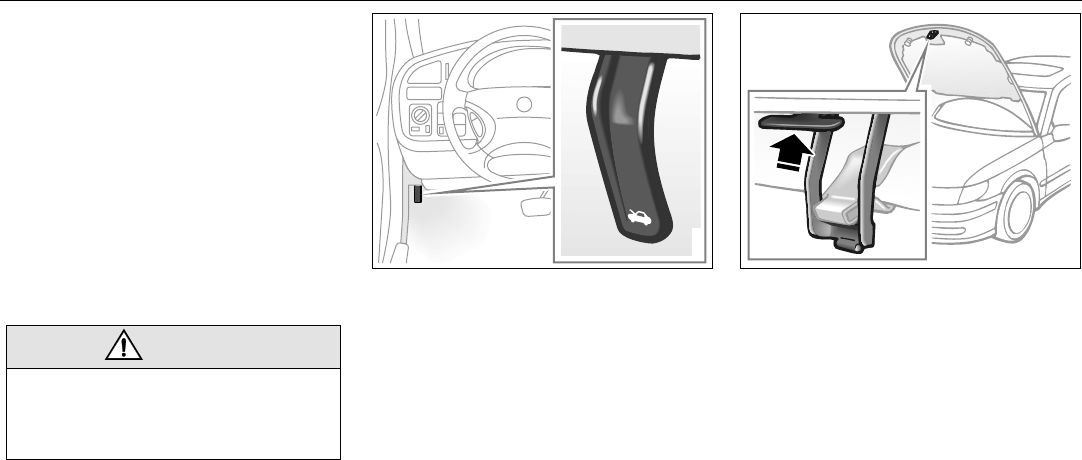
166 Car care and technical information
Hood release handle
The hood release handle is located under-
neath the instrument panel. To open the
hood:
1 Pull the release handle.
2 The front of the hood will now spring up,
providing access to the secondary
safety catch.
3 Push the catch upwards, lifting the hood
at the same time. The hood can now be
lifted right up.
To close the hood, release it from a height
of about 8 in (20 cm). Do not press down on
it.
In cold weather, when the mechanism is
stiff, the hood might need to be released
from twice the height to lock properly.
Check that the hood is now closed securely.
WARNING
Make sure not to hold your fingers
between the hood and the hood safety
catch if you lay the hood down but not
closing it.
IB487
IB486
Hood release handle Hood secondary safety catch

167Car care and technical information
Engine compartment, 4-cyl. engine
8 7910 6
2 43
5
IB488
1
Engine compartment, 4-cyl. engine
1 Engine-oil dipstick/filler cap
2 Reservoir, brake/clutch fluid
3 Fuse box
4 Expansion tank, coolant
5 Washer-fluid filler cap
6Battery
7 Dipstick, automatic transmission fluid
8 Turbo unit
9 Ignition discharge module
10 Reservoir, power-steering fluid

168 Car care and technical information
Engine compartment, 6-cyl. engine
10 79 8
1 32 54
6
IB576
Engine compartment, 6-cyl. engine
1 Engine-oil dipstick
2 Engine-oil filler cap
3 Reservoir, brake/clutch fluid
4 Fuse box
5 Expansion tank, coolant
6 Washer-fluid filler cap
7Battery
8 Dipstick, automatic transmission fluid
9 Ignition discharge module
10 Reservoir, power-steering fluid

169Car care and technical information
Engine families
Saab cars imported into the United States
and Canada meet all applicable emission
control standards. The engine family and
appropriate tune-up specifications are iden-
tified on a label affixed to the left front inner
fender.
These engine families meet applicable EPA
Federal Standards, California State Stan-
dards and Canadian Federal Standards and
are equipped with the following systems:
• Sequential multiport fuel injection system.
• Three way catalytic converter.
• Crankcase emissions control system.
• Evaporative emission control system.
• On-Board diagnostic (OBD II) system.
Emission control
systems
The systems for controlling emissions to the
atmosphere require regular checking and
adjustment at the intervals specified in the
service program.
In addition to meeting the exhaust emission
regulations and thereby helping to keep the
environment clean, a correctly tuned engine
will also give maximum fuel economy.
Saab Trionic engine management
system
The Saab Trionic engine management
system is a unique Saab development that
combines sequential multiport fuel injection,
electronic distributorless ignition and turbo-
charger boost pressure control into one sys-
tem.
The Trionic engine control module (ECM)
monitors many different engine parameters
such as:
• Intake manifold pressure.
• Intake air temperature.
• Crankshaft position.
• Engine coolant temperature.
• Throttle position and
• The oxygen content of the exhaust gases.
The ECM receives information regarding
engine knocking from a sophisticated feed-
back function in the ignition discharge unit.
By processing all of this information, the Tri-
onic system can control fuel injector open-
ing duration, ignition timing and turbo-
charger boost pressure to provide excellent
engine performance while maintaining low
emissions and fuel consumption.
NOTE
The Trionic engine management systems
continuously monitors the operation of
these systems and have on-board diag-
nostic capabilities (OBD II).
If the “Engine malfunction” lamp in
the main instrument illuminates, this indi-
cates that the Trionic ECM has detected
a problem. The car will continue to oper-
ate, but performance may be diminished.
You should have your car checked by a
Saab dealer as soon as possible.

170 Car care and technical information
ORVR (Onboard Refueling Vapor
Recovery)
Hydrocarbon vapors formed when refueling
will be recovered by the car and not
released into the atmosphere. The hydro-
carbons are absorbed in a evaporative
emission canister. When the engine is sub-
sequently started, the evaporative emission
canister is gradually purged as air is sucked
into it through a shut-off valve. The hydro-
carbon/air mixture passes through the evap
canister purge valve and into the engine
where it is burned.
When refueling, make sure you screw the
filler cap on and keep turning until it has
clicked at least 3 times. Otherwise, it is pos-
sible for the CHECK ENGINE light to illumi-
nate and a “TIGHTEN FUEL FILLER CAP“
message to appear on SID.
Refueling, see page 134.
Engine
2.3-liter engine
The 2.3-liter model is a transverse, 4-cylin-
der in-line engine with twin overhead cam-
shafts and 4 valves per cylinder.
This engine is equipped with balance shafts
that reduce engine vibration to a minimum.
The balance shafts are chain driven and
rotate at twice the speed of the crankshaft.
They produce forces and torques that are
opposed to those generated by the pistons
and connecting rods, an effect that occurs
twice for each revolution of the engine.
Engine noise is also reduced as the
counter-rotating shafts counteract the vibra-
tion from the moving parts of the engine.
The transmission, located on the right
(viewed from the front), is integrated with
the engine. All models have front-wheel
drive.
3.0-liter V6 engine
The 3.0-liter engine is a transverse, V6
engine with each bank of cylinders having
double overhead camshafts and 4 valves
per cylinder.
The transmission, located on the right
(viewed from the front), is integrated with
the engine. All models have front-wheel
drive.
IB601
Balance shafts, 4-cyl. engine

171Car care and technical information
Engine oil
Checking the oil level
Check the engine-oil level regularly. This
should be done after the engine has been
run to normal temperature and then allowed
to cool for 2–5 minutes, with the car stand-
ing on level ground. Remove the dipstick
and wipe it clean before checking the level.
4-cylinder engine
The oil level must not be allowed to drop
below the MIN mark on the dipstick, nor
should oil be filled beyond the MAX mark, as
this can lead to excessive oil consumption.
The distance between the MIN and MAX
marks on the dipstick corresponds to a
volume of approximately 1.05 qts (1 liter).
When necessary, add oil of the recom-
mended grade via the dipstick tube.
V6 engine
The oil level must not be allowed to drop
below the MIN mark on the dipstick, nor
should oil be filled beyond the MAX mark, as
this can lead to excessive oil consumption.
The distance between the MIN and MAX
marks on the dipstick corresponds to a
volume of approximately 1.05 qts (1 liter).
Top up, as necessary, with oil of the recom-
mended grade.
IB491
Engine-oil filler cap and dipstick,
4-cylinder engine
IB1123
Engine-oil dipstick and filler cap,
V6 engine
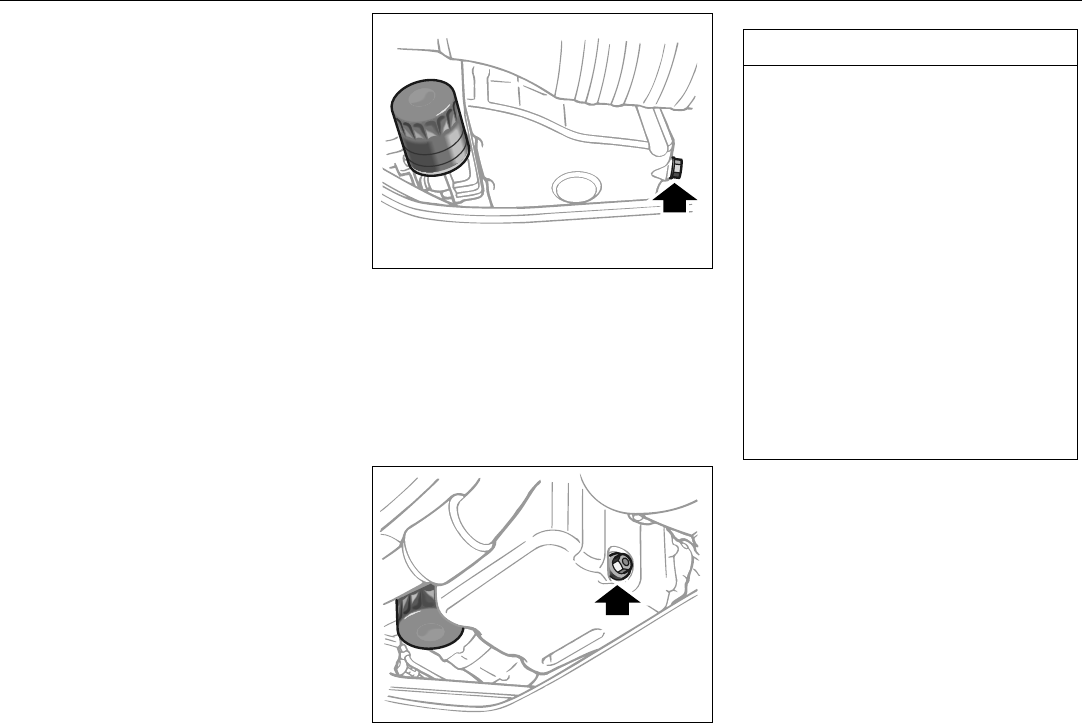
172 Car care and technical information
Oil changing
The engine oil must be changed in accor-
dance with the service program, see page
218.
Oil volume and grade, see page 229.
Oil changing should be carried out on a
warm engine. Unscrew the drain plug in the
bottom of the sump and leave the oil to drain
into an oil tray or other suitable receptacle
for at least ten minutes. Take care, as the oil
may be hot.
After the oil has been drained, unscrew and
remove the oil filter. Fit a new filter and
tighten it by hand before adding new oil.
Refit the drain plug with a new washer.
Run the engine to normal temperature and
check the oil level.
NOTE
Change of engine oil and oil filter may be
required more frequently (5000-mile
intervals (8,000 km)) if any one of the fol-
lowing conditions apply to the car:
• Most trips are less than 5 to 10 miles (8
to 16 km). This is particularly important
when outside temperatures are below
freezing.
• Most trips include extensive idling
(such as frequent stop-and-go driving).
• Most trips are through dusty areas.
• You frequently tow a trailer or use a car-
rier on top of your vehicle.
• If the vehicle is used for delivery ser-
vice, police, taxi or other commercial
applications.
IB493
Drain plug and oil filter, 4-cylinder engine
IB494
Drain plug and oil filter, V6 engine

173Car care and technical information
Transmission fluid
Manual transmission
Check and top up the fluid in accordance
with the service program.
If original fluid cannot can be obtained for
topping up (see page 231), automatic trans-
mission fluid Dexron III (synthetic fluid) can
be used. If so, the car should be taken to an
authorized Saab dealer as soon as possible
to have the reason for low fluid level cor-
rected and original fluid installed.
Automatic transmission
Check the fluid level as follows:
1 Stand the car on level ground and apply
the handbrake. The automatic transmis-
sion fluid must be at normal running tem-
perature, approximately 175°F (80°C).
This can be achieved by driving the car
for about 30 min on the open road.
2 With the engine idling, move the selector
lever to D and wait for at least
15 seconds. Next, move the selector
lever to R and wait for 15 seconds again.
Finally, move the selector lever to P. Let
the engine idle.
3 Wipe the dipstick clean with a lint-free
cloth and put it back.
4 With the fluid at normal temperature, the
level should be between the MAX and
MIN marks on the dipstick. Top up, as
necessary, with Texaco Texamatic
Dexron III automatic transmission fluid
(mineral oil-based), adding it through
the dipstick pipe. The distance between
the MIN and MAX marks on the dipstick
corresponds to a volume of approxi-
mately 0.4 qts (0.4 liter).
If the outside temperature is below 50°F
(10°C), the fluid will not reach the specified
temperature of 175°F (80°C). In this case,
the correct fluid level may be 0.8 in (20 mm)
below the MAX mark.
WARNING
• Prolonged and repeated exposure of
the skin to engine oil can cause seri-
ous skin disorders.
• Avoid prolonged skin contact when-
ever possible. Wash the affected area
thoroughly with soap and water after
any contact.
• Keep oil out of reach of children.
• Do not touch the turbocharger or
manifold. These get very hot when the
engine has been running.
• Do not spill oil on hot parts of the
engine as this could cause a fire.
• Protect the environment. Do not dis-
pose of oil in the ground or down a
drain. Dispose of all used oil and oil fil-
ters at an appropriate disposal facility.
NOTE
If there is a smell of burning fluid or the
fluid is black, change the fluid.
+80°
MIN
MAX
+80°
IB495
Dipstick for automatic-transmission fluid
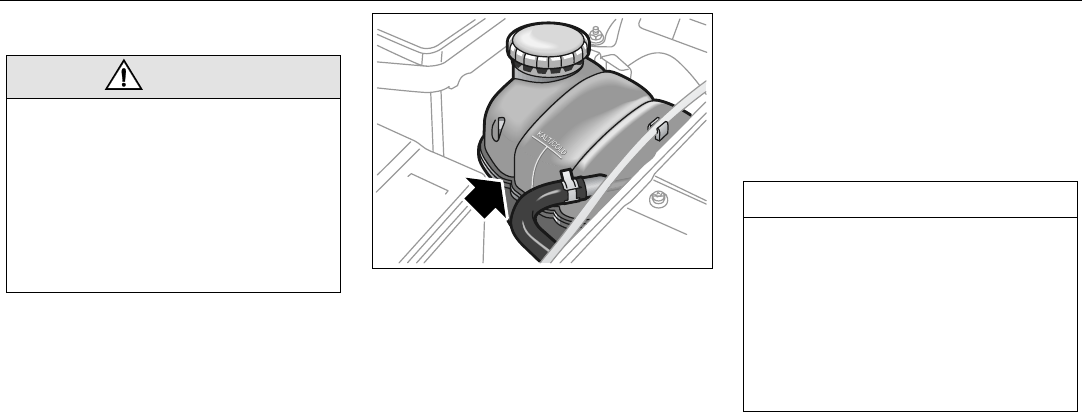
174 Car care and technical information
Coolant
The expansion tank is transparent to facili-
tate checking of the coolant level.
When the engine is cold, the coolant must
not lie over the KALT/COLD mark on the
expansion tank.
If the message “FILL COOLANT FLUID” is
displayed on the SID, check the level of fluid
in the expansion tank.
Top up, as necessary, with equal parts of
clean water and Saab-approved coolant.
If the expansion tank is empty when coolant
is added, run the engine to normal temper-
ature and top up again, as necessary.
Coolant
The cooling system is charged at the factory
with coolant containing a 50% concentra-
tion of a combined antifreeze and corrosion
inhibitor. A weaker mixture will result in
reduced anticorrosion protection. For pro-
tection against freezing in very cold
weather, a stronger concentration will be
needed.
A 60% concentration of antifreeze will pro-
vide protection at temperatures down to
-58 F (-50°C).
The corrosion-inhibiting properties of the
coolant deteriorate over time, but
Saab-approved coolant can be used for
year-round protection. Change the coolant
as specified in the service program and use
only Saab-approved coolant – other makes
may need changing more frequently and
may damage the system.
WARNING
• Proceed with caution if the radiator is
boiling when you open the hood.
Never remove the expansion-tank
filler cap when the radiator is boiling.
Loosen the cap carefully, and let the
engine cool before removing the cap.
• The cooling system is pressurized –
hot coolant and vapor can escape
when the filler cap is released.
NOTE
Always mix the antifreeze with the
appropriate volume of water before
adding it to the cooling system.
If pure antifreeze is added, the engine
could still freeze and be damaged. This is
because the antifreeze will not mix
properly with the coolant before the
thermostat has opened to allow full
circulation.
IB1338
Coolant expansion tank
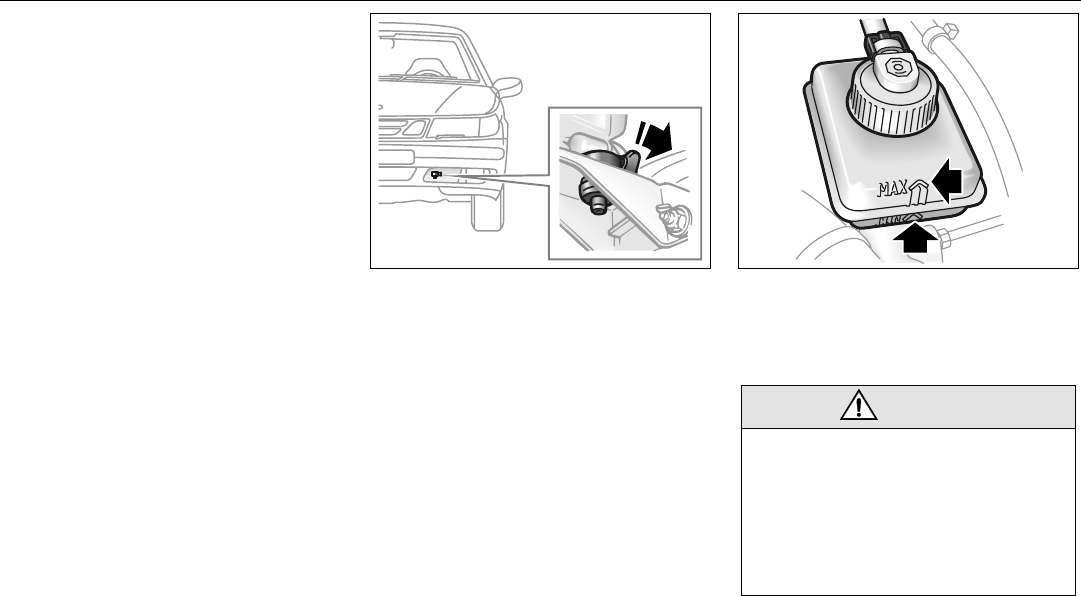
175Car care and technical information
Changing the coolant
(Usually carried out as part of the Saab orig-
inal service by an authorized Saab dealer)
1 If the engine is hot, open the expan-
sion-tank filler cap carefully to release
the pressure, but do not remove it com-
pletely. Place a suitable receptacle
under the radiator and undo the drain-
cock.
2 Remove the filler cap on the expansion
tank.
3 The system takes about two minutes to
drain. Close the draincock.
4 Mix the antifreeze and water to the
required strength in a suitable container.
Use only Saab-approved coolant.
5 Add the coolant slowly to the expansion
tank. This will take about two minutes,
as the air needs time to escape.
6 Screw on the filler cap and fully tighten
the drain cook. Run the engine to normal
temperature. Top up the coolant, as nec-
essary, until the level is just below the
MAX mark on the tank.
7 Check the coolant again after a few days
and top up as necessary.
Brake and clutch fluid
Checking the fluid level
The combined brake and clutch-fluid reser-
voir is transparent to facilitate checking of
the fluid level.
WARNING
Brake fluid deteriorates as it becomes
old. Because it is hygroscopic, it absorbs
water from the air and, in time, could allow
vapor to form in the brake system, thus
reducing its performance. It is therefore
important that brake fluid be changed reg-
ularly, as specified in the service pro-
gram.
IB498
Radiator draincock
IB1188
Brake and clutch-fluid reservoir

176 Car care and technical information
The level should be between the MAX and
MIN marks. Top up, as necessary, with
DOT 4 fluid. Do
not
use DOT 5 brake fluid.
Use only new brake fluid from a sealed con-
tainer.
Check that there are no leaks in the brake
system.
The brake fluid level will fall somewhat as
the brake pads wear. The MAX level in the
reservoir corresponds to the amount of
brake fluid required with new brake pads. If
the fall in fluid level is moderate, due to
normal brake pad wear, topping up is not
necessary.
Changing of the brake fluid should be
carried out by an authorized Saab dealer.
The vehicle´s regular braking system is
adjusted automatically, but the parking
brake has to be adjusted manually. This
work, involving adjustment of the parking
brake cables and brake pads, must only be
carried out by an authorized Saab dealer.
It is not possible to detect, through abnormal
pedal or parking brake-lever travel, whether
brake pads are worn and need replacing. It
is therefore essential that brake pads be
checked regularly, as specified in the ser-
vice program.
Brake pad wear indicators
The outboard brake pads on the front
wheels incorporate pad-wear indicators.
When the lining is down to 0.11 in (3 mm),
the pad will produce a screeching, squeal-
ing or scraping noise when the brakes are
applied. New pads should be fitted without
delay.
Brake pads should only be changed by
an authorized Saab dealer. To ensure
optimum brake performance, use only
Saab original brake pads.
Power steering fluid
Check the level of the power steering fluid in
the reservoir regularly, in accordance with
the service program.
The wheels should point forward during the
check.
Clean around the cap before it is
unscrewed. Clean the dipstick. Screw in the
cap completely again before checking the
level.
The oil should lie between the MAX and MIN
marks when the oil temperature is about
70°F (+20°C). If the oil is colder the level can
be lower, and in higher temperatures the
level can be higher, both of which are
acceptable.
Top up with ”Power Steering Fluid
CHF 11S” (part number 3032380).
IB501
Power steering fluid reservoir

177Car care and technical information
Battery The battery is provided with a cover to pro-
tect it from radiated heat. If the battery is
exposed to high temperatures, its life will be
shortened. To remove the cover, pry out the
edge a little, located at the rear of the cover.
The cover fits the standard battery installed
in the car. If a new battery is to be fitted,
make sure that its dimensions are the same
as the standard one.
The fluid level and the charge level should
be checked regularly.
The best way to check the charge is to use
a hydrometer.
Tap water contains salts and minerals that
accelerate the corrosion of the battery elec-
trodes, which can shorten the life of the bat-
tery.
The specific gravity of the electrolyte when
the battery is fully charged is 1.28. A specific
gravity of 1.18 roughly indicates a 50%
charge (see also page 230).
If frequent short journeys are made, the bat-
tery may need to be given a booster charge.
This can be done either using a battery
charger or by taking the car for a long run.
A car with a standard equipment specifica-
tion and a fully charged battery can be left
for up to 40 days and still have a sufficient
charge for starting. If extra equipment is fit-
ted, such as a car phone, the charge may
only be sufficient for about 15 days.
WARNING
• The battery emits hydrogen which,
when mixed with the oxygen in the air,
forms a highly explosive gas. Avoid
causing sparks and keep open flames
well away from the vicinity of the bat-
tery.
• The battery contains corrosive sulfuric
acid. Always wear a face mask or
goggles when working on the battery.
• If battery acid gets into the eyes or
splashes the skin or clothing, wash
affected area liberally with water.
If acid gets into the eyes or a large
quantity makes contact with the skin,
seek medical help.
NOTE
Never use tap water to top up the battery.
NOTE
A discharged battery can freeze and frac-
ture. Batteries should therefore always be
stored away from frost.
IB1173
Correct fluid level in battery

178 Car care and technical information
Charging/replacing the battery
Connect the positive lead to the positive (+)
battery terminal (red), and the negative lead
to a good ground point, e.g. the lifting lug at
the front of the engine.
To remove the battery, always disconnect
the negative (black) lead first and reconnect
it last when fitting the new battery.
The battery size must comply with DIN
53735 MFI 230/2.16.
NOTE
To avert the danger of short-circuiting
between the positive (+) terminal on the
battery and the inlet manifold on the
engine, always disconnect the negative
(-) battery lead first and reconnect it last.
NOTE
• Never reverse the polarity of the bat-
tery by connecting the leads to the
wrong terminals. The red, positive
lead connects to the positive (+) termi-
nal, and the black, negative lead to the
negative (-) terminal.
• Serious damage can be done to the
car’s electrical system if a battery or
alternator lead is disconnected while
the engine is running.
• The nut on the battery clamp should
be tightened to a torque of 10 Nm.
IB564
Correct position for battery clamp
IB1125
Battery
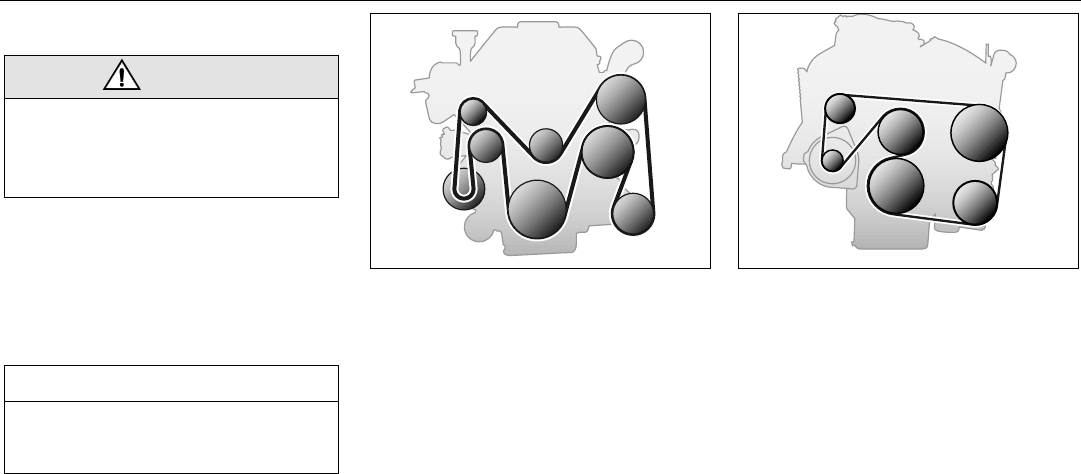
179Car care and technical information
Drive belts
The alternator is situated on the right-hand
side of the engine, adjacent to the bulkhead.
It is driven via a Poly-Vee-belt from the
crankshaft pulley.
The Poly-Vee-belt also drives the water
pump, the A/C compressor and the steering
servo pump.
The belt tension is critical and is adjusted
automatically by the belt tensioner.
See also page 47, ”Warning, charging”.
WARNING
• Keep hands and clothing well clear of
drive belts when engine is running.
• Always stop engine before inspecting
drive belts.
NOTE
Serious damage can be done to the car’s
electrical system if an alternator lead is
disconnected while the engine is running.
IB542
Routing of the Poly-Vee-belt:
4-cylinder engine with A/C
IB543
Routing of the Poly-Vee-belt:
V6 engine with A/C

180 Car care and technical information
Wipers and washers
Check and clean all wiper blades regularly.
We recommend Saab washer fluid for
cleaning.
If poor wiper performance is experienced,
clean the windshield with Saab washer fluid.
This is particularly important if the car has
been through an automatic car wash, as
these sometimes leave a wax coating on the
windshield.
If wiper performance is still unsatisfactory,
fit new blades.
Changing the windshield wiper
blades
Lift the wiper arm off the windshield
1 Depress the catch.
2 Pull the complete blade assembly down
to free it from the wiper arm, and then lift
it off the arm.
Changing headlamp-wiper blades
1 Lift the wiper arm off the headlamp.
2 Release the wiper blade by pulling it
straight down, at right angles to the
wiper arm.
To fit the new blade, slot the blade into the
retainer on the wiper arm, and press it firmly
home.
IB506
2
1
IB505

181Car care and technical information
Washers
The washer-fluid reservoir holds 6.4 quarts
(6 liters). When "WASHER FLUID LEVEL
LOW" comes up on the SID, the reservoir is
down to about 1 quart (1 liter) of fluid. Add
at least 50% of washer- fluid to water to pre-
vent freezing and for effective cleaning.
Washer jets
The washer jets can be adjusted and, if
necessary, unclogged by means of a pin.
IB507
Washer-fluid filler cap
IB1126
Cleaning/adjusting the washer jets

182 Car care and technical information
Changing bulbs
Check that the new bulb is working when finished.
Some bulbs are of the ”Long-Life” type. Make sure the same type is
fitted when changing one of these.
Headlamp aiming, see page 214. Headlamp bulb for high beam
1 Unscrew the cover from the back of the lamp unit.
2 Unplug the connector.
3 To remove the spring clip, push it in and then move it to the right.
4 Remove the bulb.
5 Without touching the glass with your fingers, insert the new bulb.
6 Line up the bulb with the guide in the reflector and secure it with
the spring clip.
7 Plug in the connector.
8 Screw on the cover.
WARNING
Before changing a bulb in the engine bay, switch off the engine to
avoid danger of fingers and hands being injured by moving parts.
The radiator fan can start up even when the engine is switched off.
NOTE
• Do not fit bulbs with a higher rating than 55 W.
• Switch off the ignition before changing a bulb, to avoid possible
short-circuiting.
IB510

183Car care and technical information
Headlamp bulb for low beam
1 Unscrew the cover from the back of the lamp unit.
2 Unplug the connector.
3 To remove the spring clip, push it in and then move it to the right.
4 Remove the bulb.
5 Without touching the glass with your fingers, insert the new bulb.
6 Line up the bulb with the guide in the reflector and secure it with
the spring clip.
7 Plug in the connector.
8 Screw on the cover.
IB509
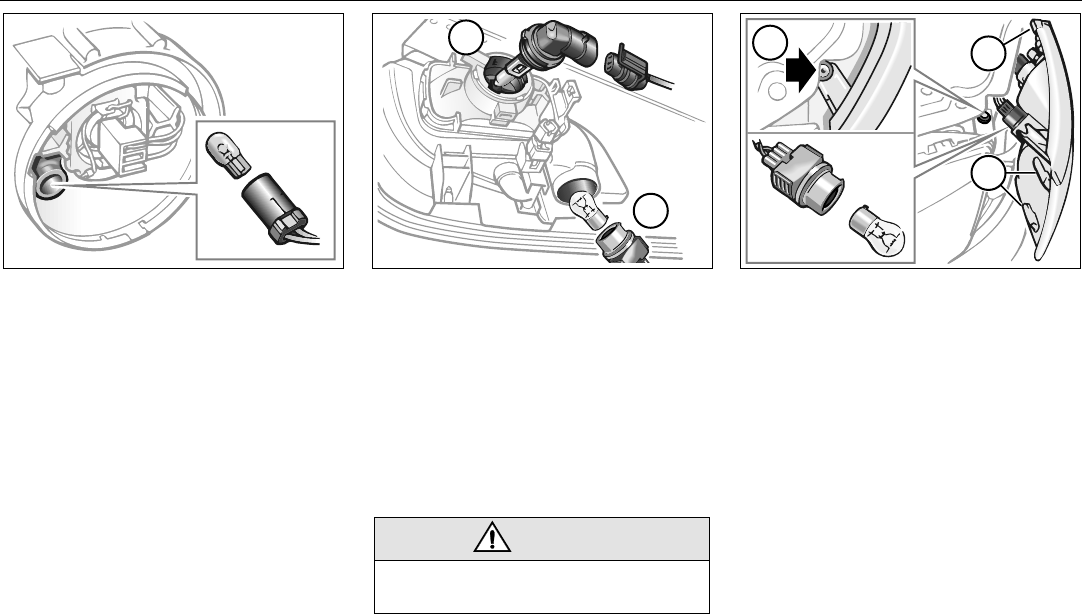
184 Car care and technical information
Parking-light bulb
The parking-light bulb is adjacent to the bulb
for low beam.
1 Unscrew the cover from the back of the
lamp unit.
2 Withdraw the bulb holder.
3 Change the bulb.
Front fog lights / cornering lights
1 From under the front bumper, grip the
bulb holder and twist counterclockwise.
2 Unplug the connector.
3 Change the bulb.
Refit in the reverse order.
Front turn signal bulbs
To change the bulb, the complete lamp unit
has to be removed.
1 Loosen the screw (1). There is no need
to remove it completely.
2 Carefully pull out the lamp unit.
3 The bulb holder has a bayonet fitting.
Grip the holder and twist it counterclock-
wise.
4 Withdraw the bulb holder from the lamp
unit.
5 The bulb also has a bayonet fitting.
Press in the bulb and twist it counter-
clockwise.
6 Fit the new bulb and check that it is cor-
rectly seated.
WARNING
Never crawl under a car that is supported
only by a jack.
IB511
Parking-light bulb
IB1127
1
2
IB1128
12
3
Front turn signal bulb
1 Retaining screw
2 Bayonet pin
3 Plastic lugs
Front fog lights and cornering lights
1 Front fog light
2 Cornering light
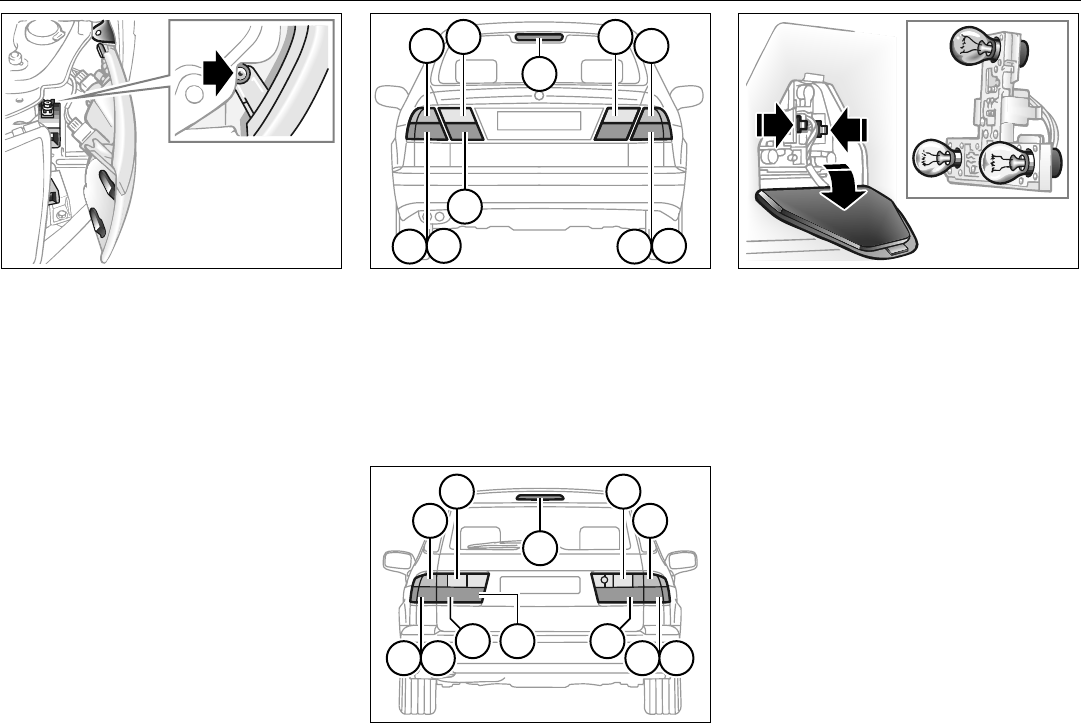
185Car care and technical information
When refitting the lamp unit, check that the
bayonet pin and the two plastic lugs engage
their respective slots. Hold the lamp unit in
position, and tighten the screw (1).
Rear light cluster, 9-5 Sedan
The bulbs for the lamps in the rear light clus-
ter are accessed from the luggage compart-
ment.
1 Lower the flap (Velcro fastening).
2 Squeeze the two plastic lugs and
remove the bulb holder.
3 The bulb has a bayonet fitting. Press in
the bulb and twist it counterclockwise.
4 Change the bulb.
IB1129
IB1296
1
2323
5
6
41
4
Rear light clusters
1 Direction indicators
2 Tail lights
3 Stop lights
4 Reversing lights
5 Rear fog light
IB516
IB1234
14
2 3 2
61
4
25 23

186 Car care and technical information
Trunk lid light and taillights,
9-5 Sedan
Before changing bulbs in the trunk, you
must first release the trim at the foot of the
trunk. This involves removing the handle
and the three trim fasteners (studs).
1 Unscrew the handle on the inside of the
tailgate.
2 Using the peg in the top of the screw-
driver handle, push in the button in the
centre of the studs.
3 Remove the studs.
Changing bulbs
1 Squeeze the plastic lug and electrical
connector together and remove the bulb
holder.
2 The bulb has a bayonet fitting. Press in
the bulb and twist it counterclockwise.
3 Change the bulb.
Refitting the trim
1 Reset the studs by pushing back the
center buttons so that they protrude by
0.2 inch (5 mm).
2 Insert the studs through the trim and tail-
gate panel. Press the center buttons in,
flush with the collar.
3 Screw the handle back onto the trunk.
High-mounted stop lights, 9-5 Sedan
The bulbs can be accessed after the panel
in the rear headlining has been removed.
1 Remove the panel by carefully pushing
in the two clips, one at the time.
2 Release the bulb holder, which is
retained by a clip at either end.
3 Withdraw the bulb gently straight back.
4 Push in the new bulb.
5 Refit the bulb holder.
6 Replace the panel by carefully pushing
the panel towards the headlining so that
the two clips engage their respective
slot.
IB517
IB518
32 23
1
IB519
High-mounted stop lights
1Panel
2Retaining clips
3Bulbs

187Car care and technical information
Tailgate bulbs, 9-5 Wagon
1 Turn the lock a quarter turn (90°) with a
screwdriver or the ignition key.
2 Open and remove the cover.
3 Take out the bulb holder by twisting it
slightly counterlockwise.
4 Press in the bulb and twist it
counterclockwise.
5 Change the bulb.
6 Check that the new bulb is working.
Reassembly:
1 Place the two “hinges” in the recess in
the tailgate.
2 Then push the “hinges” into the recess
and close the cover.
3 Turn the lock a quarter turn.
Rear lights clusters, 9-5 Wagon
1 Open the tailgate.
2 Remove the two covers and undo the
screws.
3 Grip the screw mounting and pull the
whole lamp unit sideways until it is
loose (it can be quite tight).
4 Take out the bulb holder by twisting it
slightly counterclockwise.
5 Press in the bulb and twist it counter-
clockwise.
6 Change the bulb.
7 Check that the new bulb works.
IB1227
IB1228
IB1229

188 Car care and technical information
Reassembly:
1 Locate the two front attachments and
press the front part of the light unit
straight into the body panel.
2 Tighten the screws and replace the
cover.
Loading lighting, 9-5 Wagon
1 Pull down the glass cover at the outer
edge.
2 Bend one of the contacts so that the
bulb can be removed.
3 Change the bulb.
On refitting, insert the connector-end of the
lamp fitting first.
License-plate light
1 Undo the two screws and remove the
lamp glass.
2 Withdraw the bulb.
3 Change the bulb.
4 Check the seal before fitting the glass.
IB1230
IB1335
IB520

189Car care and technical information
Side direction indicators
1 Slide the lamp fitting forward and pull out
the back.
2 Remove the bulb.
3 Change the bulb.
On refitting, make sure that the spring in the
lamp fitting engages the edge of the open-
ing in the body panel.
Courtesy lights (doors and floor)
and luggage-compartment lighting
1 Insert a screwdriver carefully into the
slot in the end of the lamp fitting. Ease
the fitting off to gain access to the bulb.
2 Bend out one of the contacts and
remove the bulb.
3 Change the bulb.
On refitting, insert the connector-end of the
lamp fitting first.
Dome light, front
1 Ease the leading edge of the glass out
of the overhead panel by inserting a
small screwdriver alternately in each of
the two slots.
2 Release one of the contacts and remove
the bulb.
3 Fit the new bulb.
IB521
IB522
IB523

190 Car care and technical information
Dome light, rear
1 Remove the entire overhead panel:
ease out the trailing end first, and then
both front edges.
2 Fit the new bulb.
Glove-compartment illumination
1 Insert a small screwdriver in the slot in
the end of the lamp fitting and ease it out
to gain access to the bulb.
2 Bend out one of the contacts and
remove the bulb.
3 Fit the new bulb.
On refitting, insert the connector-end of the
lamp fitting first.
Other bulbs
If any other bulbs need changing, you are
advised to take the car to an authorized
Saab dealer.
IB524
IB525
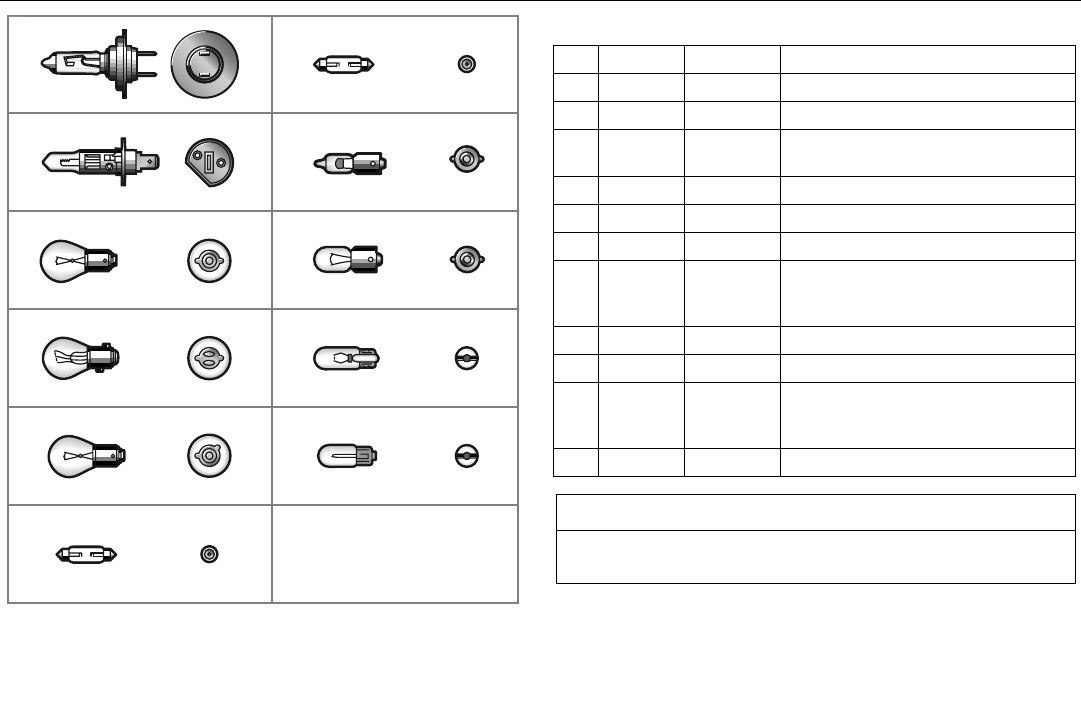
191Car care and technical information
Bulb table
A special kit containing spare bulbs and fuses is available as an
accessory from your Saab dealer.
# Wattage Cap
1 55 H7 Headlamp
2 55 H1 Fog light
3 21 Ba 15s Reversing lamp; side reversing
lamp; rear fog lamp; cornering lamp
4 21/5 BAY 15d Stop/tail lamp
5 PY 21 yel BAU 15s Direction indicator, front/rear
6 10 SV 8.5 Dome light; luggage compartment
7 5 SV 8.5 Dome light, front; glove compart-
ment; courtesy lights; safety belt
reminder
8 5 halogen Reading light, overhead panel
9 4 Ba9 Reading light, rear
10 5 W 2.1 x
9.5d Side indicators; high-mounted stop
light (9-5 Sedan); parking lights;
number-plate illumination
11 1,2 W 2 x 4.6d Switches; front ashtray
NOTE
Do not interchange. Always use the correct Wattage bulb accord-
ing to application.
IB1336
1
2
3
4
5
6
7
8
9
10
11

192 Car care and technical information
Fuses
The fuses are housed in two fuse panels:
one at the end of the instrument panel on the
driver’s side, and one under the hood.
To check if a fuse has blown, first remove it
from the panel (see below). If the filament is
broken, the fuse has blown.
A special tool for removing fuses is provided
at the bottom of the fuse panel. Simply push
the tool onto the fuse, squeeze and remove
the fuse.
WARNING
To avert the risk of short-circuiting and/or
fire breaking out in the electrical system,
the following advice should be heeded:
• Always consult an authorized Saab
dealer before modifying or adding any
electrical equipment. Failure to do so
can result in the electrical system
being damaged.
• Never replace a fuse with one having
a higher/lower rating than specified
(see page 194). The color of the fuse
indicates its amperage.
• If the same fuse blows repeatedly,
have the electrical system checked by
an authorized Saab dealer.
IB527
Fuse panel in instrument panel
IB528
Fuse box under the hood
IB144
Sound fuse / Blown fuse

193Car care and technical information
Maxi fuses
The Maxi fuses are housed in the fuse box
under the hood. These fuses can be
checked in the same way as the other fuses.
The Maxi fuses are designed to protect the
car’s electrical system from being dam-
aged. Each Maxi fuse protects a number of
electrical circuits and functions and there-
fore has a higher rating (amperage) than the
standard fuses. No spare Maxi fuses are
supplied with the car.
DICE / TWICE
DICE = Dashboard Integrated Central Elec-
tronics
TWICE = Theft-Warning Central Electronics
DICE and TWICE are electronic control
modules that monitor and control a variety
of functions, including:
DICE controls (among other things):
• Front lights and interior lighting.
• Instrument illumination.
• Intermittent wiper operation.
• Electric heating of rear window and door
mirrors.
• Cooling fans.
TWICE controls (among other things):
• Central locking.
• Car alarm (Anti-theft system).
• Engine immobilizer.
• Autochecking of lights.
• Electric heating of rear seat.
• Safety belt reminder.
• Electrically adjustable passenger seat.
The DICE and TWICE control modules are
linked to a data bus, which is basically an
information carrier that allows information to
be exchanged between all the control mod-
ules and components connected to the bus.
If a fault occurs in any of these components,
diagnostic faults codes are set in the rele-
vant control module, which facilitates fault
diagnosis at the Saab dealer.
The scan tool connector for fault diagnosis
is located under the instrument panel on the
drivers side.
NOTE
If a Maxi fuse blows, it means that there
is a major fault in the electrical system.
Have the car checked without delay by
an authorized Saab dealer.
IB529
Maxi fuses under the hood
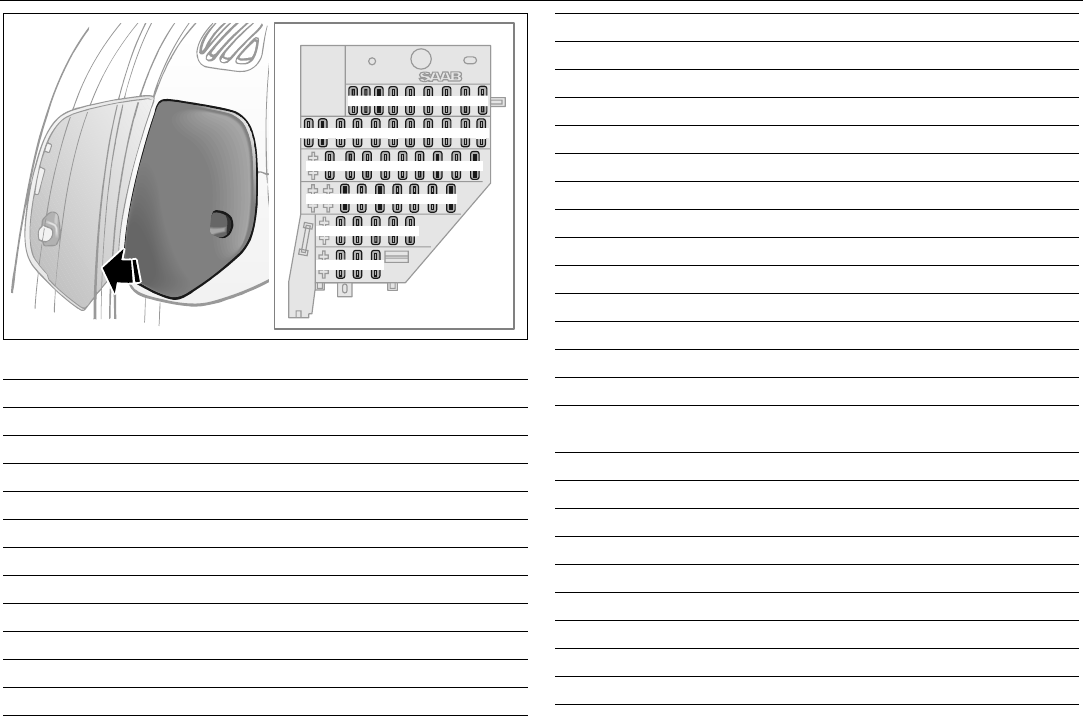
194 Car care and technical information
Fuse panel in instrument panel
# Amp Function
A 25 Trailer lights
B 10 Automatic transmission
C 7,5 Electric door mirrors; DICE
1 15 Brake lights; shift-lock override
2 15 Reversing lights
3 10 Parking lights, left
4 30 Parking lights, right
5 7,5 DICE / TWICE
6 30 Electric windows, right
6B 5 Stop lights, trailer
7 10 Fuel injection
8 15 Trunk lighting; door lighting; SID; car phone
9 15 Audio System; diagnostic instrument
10 15 Memory function, door mirrors; heating, rear seat
11 30 Central locking; electrically adjusted passenger seat
12 7,5 Automatic transmission
13 20 Audio System, amplifier
14 30 Ignition system, engine
15 15 Preheated oxygen sensor (catalytic converter)
16 20 DICE (direction indicators)
16B – –
17 20 Engine-management system
18 7,5 Door-mirror heating
19 20 Fuel pump
20 15 ACC; interior lighting; rear fog light
21 10 Audio System; rear-view mirror with auto dimming
function
22 40 Interior fan; air pump (V6 only)
23 15 Sunroof
24 40 Rear-window heating
25 30 Electrically adjustable driver’s seat; fuel-filler flap
26 7,5 ABS brakes; ACC
27 10 Engine-management system
28 7,5 Airbag (SRS)
29 7,5 Automatic transmission
30 7,5 Starter motor
IB530
BC123456
A
14
12
11
10
9
8
713
6B 15 16
23 24
22
21
20
19
18
17
16B
54 25 26 27 28 29 30 31
36
35
34
33
32
39
38
37
55
52
53
56
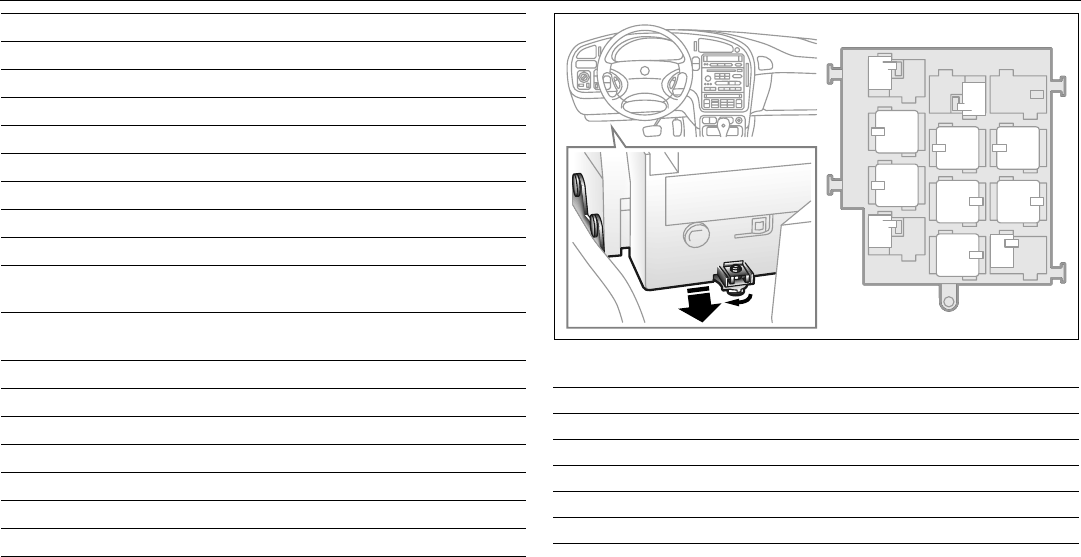
195Car care and technical information
Relay panel under instrument panel Relay panel under instrument panel (cont.)
31 7,5 Cruise control; water valve
32 15 Ventilated front seats
33 7,5 Direction-indicator switch
34 30 Cigarette lighter
35 15 Daytime running light
36 30 Electric windows, left
37 30 Windshield wipers; fog lights, front
38 30 Electric heating, front seats
39 20 Limp-home solenoid (automatic transmission)
52-5
6Spare fuses
# Function
A
B Electric heating of rear seat
C
D
E Main relay (engine management system)
F Fuel filler flap
G Fuel pump
H Ignition switch
I Rear-window / door mirrors heating
J Reversing lights
KStarter relay
L Limp-home function
IB531
ABC
D
G
EF
HI
KL
J
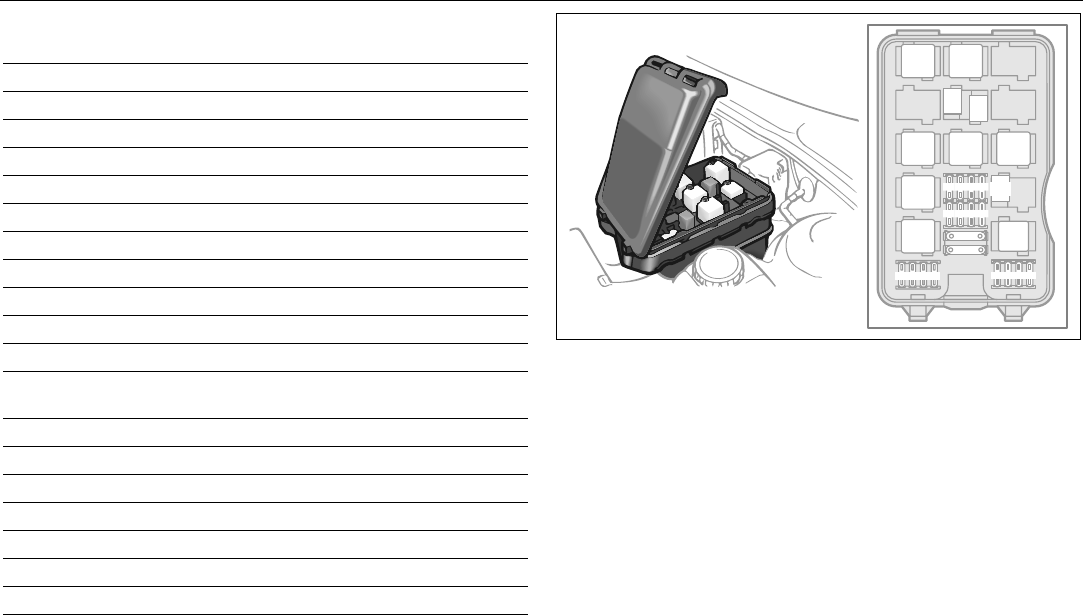
196 Car care and technical information
Fuse box under hood
Fuses
# Amp Function
1 60 ABS (Maxi fuse)
2––
315Horn
4 10 Rear window wiper (9-5 Wagon)
5 15 Fog lights (front spoiler)
6 30 Radiator fan, high speed
7 15 Low beam headlight, right
8 15 High beam headlight, right
9 15 Low beam headlight, left
10 15 High beam headlight, left
11 10 Headlight beam-length adjustment (certain markets
only); headlamp washers / wipers
12 Spotlights (accessory)
13 15 Autochecking of lights
14 10 A/C; car alarm siren
15 30 Radiator fan
16 – –
17 – –
18 – –
IB532
18 17 16 15
14 13 12 11 10 9 8 7
6 5 4 3
1
2
10.1
3
5.2
5.1
2
987
11
1213

197Car care and technical information
Relays
# Function
1 Washer, front/rear
2 Low beam headlight
3 High beam headlight
4 Extra lights (accessory)
5.1 Horn
5.2 – –
6 Wiper, rear (9-5 Wagon)
7 Radiator fan, low speed
8 Radiator fan, high speed, left fan
9 A/C-compressor
10.1 Front fog lights
10.2 Headlamp wipers
11 Windshield wipers
12 Radiator fan, high speed, right fan
13 Autochecking of headlights
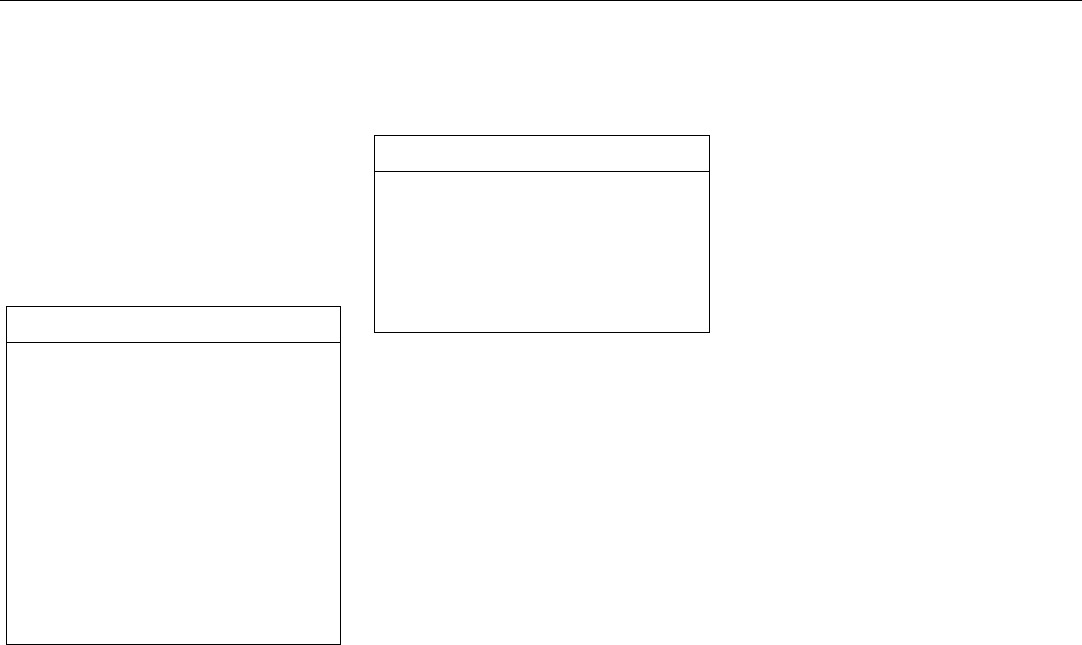
198 Car care and technical information
Wheels
Alternative wheels and tires
If you wish to fit other tires or wheels than
those supplied with the car, consult your
Saab dealer first as to the possibilities avail-
able.
Wheels/tires combinations that are not
approved by Saab can negatively affect the
car´s directional stability, steering and brak-
ing in both wet and dry conditions.
Do not assume that a wheel/tire combina-
tion will function properly just because it will
bolt on.
The wheels and tires have been carefully
matched to the characteristics of the car and
play a key role in its outstanding roadhold-
ing and handling.
Tire pressure
Tires need to be inflated to suit the load car-
ried and the maximum speed the car will be
driven (see the recommended tire pres-
sures on the back cover). Note that all
values apply to cold tires. For tires with an
aspect ratio less than /60, increase the tire
pressure by 3 psi (20 kPa) for rough roads
with potholes to minimize the risk of rim
damage.
Never reduce the pressure of a hot tire. If the
tires are hot when you check them, only
increase the pressure, if necessary.
Soft tires will cause faster wear than
over-pressurized tires. They also increase
fuel consumption.
If a valve is leaking, simply unscrew it and fit
a new one.
Important! Remember to adjust the tire
pressures if you change the load in the car
or intend to cruise at a substantially higher
or lower speed than normal.
NOTE
For wide wheels and/or low-profile tires,
bear in mind the following:
• Tires and wheels can be damaged in
potholes etc.
• Springs and dampers can be over-
loaded.
• The wheels can come into contact with
chassis and body components.
• The speed and load limits for the tires
must not be exceeded; see page 199.
• Wheels larger than 17” must not be fit-
ted. The maximum permissible offset
is 49 mm.
NOTE
Check the tire pressures at least once
per month.
Underinflation is the main cause of:
• Tires wearing out prematurely.
• Damage to the sidewalls.
• Damage to the wheels.

199Car care and technical information
Rotating tires
Because the car has front-wheel drive, the
front tires tend to wear faster than the rear
ones. New tires should always be fitted in
pairs, so that tires on the same axle have the
same amount of tread.
If swapping the complete set, e.g. winter
tires for summer tires, mark the tires
removed to ensure that they go back in the
same position (e.g. FL for front left, RL rear
left, etc.).
Store wheels lying flat or hanging – never
standing upright.
Tire markings
An example of the meaning of the different
markings in a tire size is given below for a
tire size of:
205/65 R15 94 V
Winter tires
Winter (snow) tires are recommended for
winter climates where the majority of your
driving will be done on snow and ice. Winter
tires should be fitted to all four wheels to
maintain a proper balance. Your Saab
dealer can advise you as to the correct size
tire for your car (if different from the original
size) and also supply Saab approved winter
tires.
Tire quality grading (cars sold in
U.S.)
New tires must be graded and labeled in
accordance with new Federal regulations.
Standard tests are conducted to measure
performance in the areas of traction and
temperature resistance. Refer to the tire
sidewall for the specific quality grades of the
tires provided on your new Saab. Compact
spare tires are exempt.
DOT QUALITY GRADES
• Treadwear
• Traction AA, A, B, C
• Temperature A, B, C
All passenger car tires must conform to Fed-
eral safety requirements in addition to these
grades.
WARNING
When fitting just one new pair of tires,
these should be fitted to the rear wheels,
as these are more critical to the direc-
tional stability of the car (e.g. on braking
or in a skid). The existing rear wheels
should therefore be moved to the front.
Always move left rear to left front and right
rear to right front, so that the direction of
rotation remains the same.
205 Tire section width, mm
65 Aspect ratio, i.e. the section height
is 65% of the section width
R Radial ply
15 Wheel rim diameter 15 in at bead
seats
94 Tire load code
V Speed marking
Speed ratings
S Tire approved for speeds up to
100 mph (180 km/h)
T Tire approved for speeds up to
118 mph (190 km/h)
H Tire approved for speeds up to
130 mph (210 km/h)
V Tire approved for speeds up to
150 mph (240 km/h)
W Tire approved for speeds up to
167 mph (270 km/h)
Y Tire approved for speeds up to
186 mph (300 km/h)

200 Car care and technical information
Uniform Tire Quality Grading (US)
Quality grades can be found where applica-
ble on the tire sidewall between tread shoul-
der and maximum section width. For exam-
ple:
Treadwear 200 Traction AA
Temperature A
Treadwear
The treadwear grade is a comparative
rating based on the wear rate of the tire
when tested under controlled conditions on
a specified government test course. For
example, a tire graded 150 would wear one
and one half (1 1/2) times as well on the gov-
ernment course as a tire graded 100. The
relative performance of tires depends upon
the actual conditions of their use, however,
and may depart significantly from the norm
due to variations in driving habits, service
practices and differences in road character-
istics and climate.
Traction
The traction grades, from highest to lowest,
are AA, A, B and C. These grades represent
the tire’s ability to stop on wet pavement as
measured under controlled conditions on
specified government test surfaces of
asphalt and concrete. A tire marked C may
have poor traction performance. Wear indicators
The tires incorporate wear indicators in the
form of smooth, treadless strips across the
width, which become visible when only
1.6 mm of tread remains. As soon as the
indicators become visible, new tires should
be fitted without delay.
Make sure you are familiar with the legal
limit for minimum tread depth in your
country and also any regulations gov-
erning the use of winter tires.
WARNING
The traction grade assigned to a tire is
based on straight-ahead braking, traction
test and does not include acceleration,
cornering, hydroplaning or peak traction
characteristics.
SG840
Wear indicators

201Car care and technical information
Temperature
The temperature grades are A (the highest),
B, and C, representing the tire’s resistance
to the generation of heat and its ability to dis-
sipate heat when tested under controlled
conditions on a specified indoor laboratory
test wheel. Sustained high temperature can
cause the material of the tire to degenerate
and reduce tire life, and excessive temper-
ature can lead to sudden tire failure. The
grade C corresponds to a level of perfor-
mance which all passenger car tires must
meet under the Federal Motor Vehicle
Safety Standard No. 109.
Grades B and A represent higher levels of
performance on the laboratory test wheel
than the minimum required by law.
Date code
Tires should be regarded as perishable
goods. As the tires age, the rubber becomes
progressively harder, and the roadholding
ability of the tires diminishes. This is partic-
ularly on winter tires.
Tires now have a date-code marking for the
year of manufacture. The first two digits
denote the week number and the last digit
the year. The ”<” symbol points to the year.
Accordingly, a date code of 157 signifies
that the tire was manufactured in week 15,
1997.
WARNING
The temperature grade for a tire is estab-
lished for a tire that is properly inflated
and not overloaded. Excessive speed,
underinflation, or excessive loading,
either separately or in combination, can
cause heat buildup and possible tire fail-
ure.
IB533
Date code
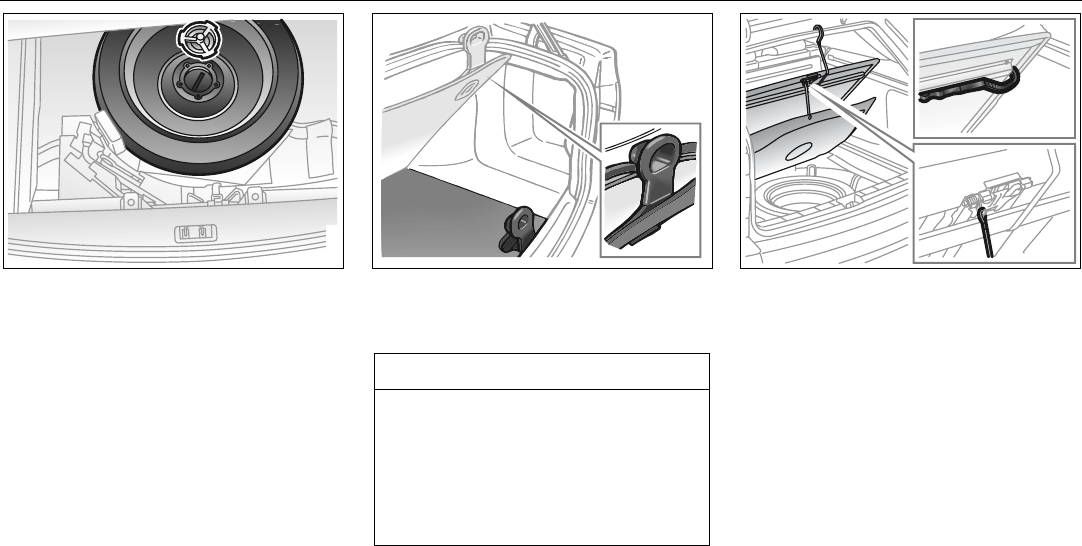
202 Car care and technical information
Compact spare wheel
The compact spare is light and easy to
handle when changing the tire. Its use is
only permitted when a standard tire has sus-
tained a puncture. The maximum life of the
tire is only 2000 miles (3,500 km).
Do not exceed 50 mph (80 km/h) with the
compact spare fitted.
The compact spare should be inflated to
60 psi (420 kPa). Carry the punctured tire in
the spare-wheel well under the luggage-
compartment floor.
Have the standard tire repaired and refitted
as soon as possible (see also page 154).
The spare wheel, together with the jack and
jack handle, front towrope attachment eye
and toolkit, is stowed away underneath a
panel in the luggage-compartment floor.
If you need to change a wheel, remove the
tool kit first and then the spare wheel.
The panel over the spare wheel can be held
open by hooking the handle onto the rubber
seal.
In the Saab 9-5 Sedan, there is a holder for
a warning triangle (accessory) in the lug-
gage compartment trim. In the Saab 9-5
Wagon, there is space for a warning triangle
underneath the panel in the luggage com-
partment floor.
NOTE
To avoid damaging a punctured alloy
wheel it can be placed outside up in the
spare-wheel well but only while driving to
the closest workshop.
A general rule is that all heavy loads must
be well secured in the luggage compart-
ment, see page 118 and 121.
IB534
Panel hooked back, 9-5 Sedan
IB1232
Hanging up the cover and spare wheel
compartments mats, 9-5 Wagon
IB1186
Spare wheel (under panel in luggage
compartment)

203Car care and technical information
Changing a wheel
WARNING
• The car jack is designed solely for use
in changing a wheel or fitting snow
chains. It must not be used to support
the car during repair work or servicing.
• Never crawl under a car that is
supported only by a jack.
• Special care must be taken if the car is
on a slope – use wheel chocks!
• Position chocks, one ahead and one
behind, the wheel that is diagonally
opposite to the one to be changed.
• Switch on the hazard warning lights if
the car is on a road.
• Apply the handbrake and leave the car
in gear (1st or reverse). Automatic
transmission: move selector to the
P position.
• Ensure that everybody is out of the car
before jacking it up.
• Never start the engine while the car is
jacked up.
• The jack must stand on a firm, level
surface.
• Stow the jack in the place provided for
it under the panel in the floor of the lug-
gage compartment. Secure it properly
to avert injury to passengers in the
event of an accident.
• Do not use the jack for any purpose
other than for jacking up the car.

204 Car care and technical information
To jack up the car, apply the jack to one of
the special jacking points under the sills. If a floor jack is used, it can be applied to the
standard jacking points used by the dealer.
A floor jack can lift both front wheels or both
rear wheels off the ground simultaneously.
A jack stand must then be applied under-
neath the front of the engine subframe (at
the fixing point for the towrope-attachment
eye) or to the rear towrope-attachment eye
(or under the trailer hitch, if fitted). 1 Put the car in 1st gear (automatic trans-
mission: move selector to the P position)
and apply the parking brake.
2 Wind the jack up to a suitable height
before placing it under the recess in the
sill.
Make sure that the jack fully engages
the recess in the sill and that the base of
the jack is steady and flat on the ground.
3 Remove the wheel cover (where appli-
cable).
Loosen the wheel bolts by half a turn.
NOTE
Apply the jack only to the jacking points
indicated.
Position for jack
IB1130
Jacking points for a trolley jack
IB536

205Car care and technical information
4 Wind the jack to raise the wheel clear of
the ground. Remove the wheel bolts and
lift off the wheel.
5 Fit the wheel and screw in the bolts in the
sequence shown (opposite pairs).
Tighten the bolts enough for the bolts
and wheel to be seated correctly.
6 Lower the car and tighten the wheel
bolts to the correct torque in the
sequence shown (opposite pairs).
Tightening torque
Light-alloy wheels: 80 ft.lbs. (110 Nm)
Steel wheels: 80 ft.lbs. (110 Nm)
Do not overtighten the bolts using a per-
cussion nut tightener: not only can this
damage the wheels but it can also make
it impossible to undo the bolts using the
wheel wrench in the car’s toolkit.
7 Check-tighten the wheel bolts after a
few miles.
Tightening torque
Light-alloy wheels: 80 ft.lbs. (110 Nm)
Steel wheels: 80 ft.lbs. (110 Nm)
We advise against using wheels with open
wheel covers in winter, as the brake compo-
nents are then more exposed both to slush
and to road salt and grit.
NOTE
When refitting wheel covers (where
applicable), make sure that the valve
protrudes through the hole in the wheel
cover.
IB538
Removing the wheel cover
IB539
Tightening sequence, wheel bolts

206 Car care and technical information
Flat spotting
All tires get hot, especially on long journeys
or when the car is driven hard. After the car
has been parked with hot tires and the tires
have cooled down, a flat spot can appear in
the tire, where it is in contact with the
ground. The same can occur if the car has
not been moved for a long time.
Flat spots can give rise to vibration that can
be felt through the steering wheel, similar to
that experienced when the wheels need bal-
ancing. Flat spots of this type disappear
once the tires get hot again, usually after
10–15 miles (20–25 km) of driving at cruis-
ing speed.
Air conditioning
(A/C system)
Fault diagnosis
If a fault occurs in the A/C system, there are
a number of checks you can perform your-
self. If the fault persists, however, have the
system checked by an authorized Saab
dealer.
Important!
When the A/C system is running, the intake
air is dehumidified, and the resultant con-
densation is drained off through two outlets
underneath the floor of the car in the vicinity
of the front doors. It is therefore perfectly
normal for water to be seen dripping from
these outlets when the car is parked. The
warmer the ambient air and the higher the
humidity, the greater will be the amount of
condensation formed.
Inadequate cooling:
a Make sure that the temperature and
air-distribution controls are in the
appropriate settings.
b Check that the condenser (forward of
the radiator) has not become clogged
with dirt and insects.
c Make sure that the drive belt for the com-
pressor is not slipping.
d Check the fuses for the ventilation fans
and compressor.
NOTE
• The A/C system is designed for use
with R134a refrigerant.
• Refrigerant handling requires special
equipment and special procedures for
charging and draining the system.
• All repairs and adjustments on the A/C
system must be carried out by a Saab
dealer authorized for this kind of work.
• Never mix R134a and R12 refriger-
ants.
WARNING
• The A/C system is pressurized. Do not
break any connections or undo A/C
system components.
• Escaping gas can cause blindness or
other injury.

207Car care and technical information
Maintenance
• The drive belt for the compressor should
be inspected under the regular service
program.
• Clean dirt and insects away from the con-
denser and radiator to prevent clogging.
When washing the car, use the hose to
spray the radiator and condenser (located
forward of the radiator) from both sides
(both from the front of the car and from
inside the engine bay). Do not use a pres-
sure washer.
Caution: Do not use the hose when the
engine is hot.
Other than in extremely cold weather, do not
screen the radiator, e.g. with netting, as this
will greatly diminish its cooling capacity.
Note: The A/C system will only operate
when the outdoor temperature is above the
freezing point (0°C, 32°F).
Safety belts
Regularly check the function of the safety
belts as follows:
• Hold the diagonal strap and pull it sharply.
The safety belt should lock and it should
not be possible to withdraw it further.
Check the anchorage points in the floor.
They must not have suffered rust damage.
There must be no frayed threads in the web-
bing.
Safety belts must not come into contact with
substances such as polishes, oils or other
chemicals. If the straps are dirty, wash them
with warm water and a detergent or have
them replaced.
WARNING
If the car is involved in a collision, the
safety belts, belt pretensioners and other
components must be inspected by an
authorized Saab dealer.
Never make any alterations or repairs to
the safety belt yourself but visit an autho-
rized Saab dealer.

208 Car care and technical information
Upholstery and trim
To remove fluff or hairs from the seat uphol-
stery or headlining, use a moist, lint-free
cloth or a special lint remover (brush or
roller). Remove any dirty marks using a
cloth moistened with lukewarm soapy
water.
When using a stain remover, always work
from the outside towards the center to avoid
leaving a ring. If a soiled ring or spot should
remain, it can usually be removed using
lukewarm soapy water or water alone.
Wet patches left by spilt soft drinks or thin oil
must be wiped off immediately using an
absorbent material, such as kitchen paper,
and treated with stain remover.
Alcohol is recommended for removing
grease or oil stains, and a semi-stiff brush
may also be used.
Cleaning and caring for leather
upholstery
The principal reason for treating leather
upholstery is to maintain its elegant appear-
ance and to provide it with a protective film.
Discoloration caused by dust and wear
mainly affects the lighter shades, although
this is not detrimental to the leather –
indeed, the patina resulting from use is often
considered desirable in leather. But if the
leather is allowed to become too grubby, it
can start to look shabby.
It is a good idea to clean and recondition the
leather twice a year – in conjunction with a
general spring-cleaning of the car – after the
winter and in the autumn, for instance. In
hot, dry climates, the leather will need to be
treated more frequently.
Moisten a soft cloth in a mild soap solution.
Carefully apply this damp (not wet) cloth to
the leather, working in light, circular move-
ments until the leather is clean. Repeat the
procedure using clean water and then leave
the leather to dry thoroughly. Finally, treat
the leather with a leather conditioner.
Apply the leather conditioner using a soft
cloth and the same circular movements as
described above. After it has dried, polish
the leather with a soft, dry cloth. Follow the
directions given above. Do not use hot
water, unknown abrasive polishes, sol-
vents, sprays or soaps that might scratch
the leather.
Textile carpeting
Vacuum clean the carpeting regularly. Car-
pets can also be cleaned using a brush, or
carpet shampoo applied with a sponge. Do
not use vacuum cleaners outdoors unless
they are properly grounded.

209Car care and technical information
Washing the car
Wash the car frequently. When the car is
new, wash the bodywork by hand, using just
cold water – a brush attachment on the end
of a hose is ideal. Do not use automatic car
washes for the first five or six months,
before the paintwork has hardened prop-
erly. Thereafter, use a high quality car wash
soap added to lukewarm water.
Remove any bird droppings without delay,
as these can discolor the paintwork and
prove difficult to polish out.
Use a soft cloth moistened with methyl alco-
hol to remove splashes of tar or asphalt. Do
not use strong cleaners, as these can dry
out the paintwork.
The underside of the car also needs wash-
ing regularly, and this should be done extra
thoroughly at the end of winter. Clean the
underside of the car by hand if the car is usu-
ally washed in an automatic car wash with-
out special facilities for underbody cleaning.
Never wash or leave the car to dry in the
sun, but wipe it dry with a chamois leather
immediately after washing to avoid smears
and streaks.
Clean the window glass inside and out using
a high quality window cleaner. This is partic-
ularly important when the car is new, as
upholstery and trim have a tendency to
sweat a little at first.
Keep the glass well cleaned, as this helps to
prevent misting.
Waxing and polishing
Do not wax a new car during the first three
or four months. In fact, there is no need to
polish the car before the paintwork has
started to go dull through oxidation. Other
than in exceptional cases, do not use abra-
sive polishes containing a cutting agent on
a new car. Always wash the car thoroughly
before waxing or polishing.
NOTE
Avoid using any alcohol-based cleaners
on the front and rear light clusters, as
these can cause cracking of the lenses.
NOTE
• The door mirrors must be fully
retracted before the car enters an
automatic car wash.
• Remove fixed antennas, e.g. for
mobile phone, before putting car
through an automatic car wash.
• Try your brakes on leaving a car wash.
Wet brake discs reduce the braking
effect.

210 Car care and technical information
Engine compartment
Clean the engine compartment using an
engine detergent and rinse with hot water.
Cover the headlights and do not aim the
spray nozzle on the
•Radiator.
• Throttle cable.
• Throttle housing.
• Other engine controls.
• The alternator.
• Ignition system and other electrical com-
ponents.
Additional care should be taken if using a
high-pressure washer. Hold the nozzle at
right angles to the area to be cleaned, which
is particularly important when spraying
labels.
Do not use gasoline as a cleaning agent or
solvent when carrying out repairs or mainte-
nance. Saab recommends the use of envi-
ronmentally safe degreasing agents.
Touching up the paint
Damaged paintwork should be treated as
soon as it is discovered: the longer it is left,
the greater the risk of corrosion. The
anti-perforation warranty does not cover
corrosion resulting from untreated defects.
Paintwork damage sustained in a collision is
usually extensive and can only be properly
restored by professionals.
However, you can repair small scratches
and stone-chip damage yourself. The nec-
essary tools and materials, such as primer,
touch-up paint and brushes, are available
from your Saab dealer.
In the case of minor flaws in the paintwork,
where the metal has not been exposed and
an undamaged layer of paint remains,
touch-up paint can usually be applied
directly, after any dirt has been scraped
away using a pointed knife.
If corrosion has already set in, e.g. as a
result of stone-chip damage, use a pointed
knife to scrape off all surface rust. If possi-
ble, the damaged area should be taken
back to the bare metal. The metal should
then be primed with two thin coats of primer
applied by brush.
After the primer has dried, apply several thin
layers of topcoat enamel until the surface of
the repaired area is flush with the surround-
ing paintwork.
IB1334
Surface-treatment composition
1 Body panel
2 Zinc (certain panel sections only) 7.5 µm
3 Phosphate coating
4 Cathodic ED 28 µm
5 Intermediate coat 35 µm
6 Metallic base 15 µm
7 Clear enamel /solid enamel 40 µm

211Car care and technical information
Stir both primer and touch-up enamel thor-
oughly before use and allow each coat to
dry before applying the next.
Two-coat enamel
As the name implies, two-coat enamel is
applied in two operations. The first coat, the
base color, contains the pigment, metal
flakes and binder. The second coat consists
of a clear enamel, which provides the final
gloss for the paintwork and protects the
base from moisture and environmental con-
taminants.
Touch-up stone-chip damage as follows:
1 Thoroughly clean the damaged area.
2 Apply the primer, base color and finally,
the enamel. To achieve the best finish,
apply two or three coats of primer.
Anticorrosion treatment
The entire car is corrosion-protected at the
factory in different stages by an electrolytic
immersion coating and a polyester-based
protective coating to protect against corro-
sion caused by stones flung up by the
wheels. A thin penetrating anti-rust oil is
also applied in cavities and body members.
In addition to conventional anti-corrosion
treatment like painting, underbody treat-
ment and cavity treatment, most of the body
panel surfaces are galvanized. These
include the hood, the doors and the under-
body.
The anti-corrosion treatment on the under-
side of the car and inside the wheel arches
is particularly exposed to constant wear and
possible damage, the degree of which will
obviously depend on driving conditions.
What causes rust?
Steel body panels of automobiles are sub-
ject to rusting whenever air and moisture
manage to penetrate the protective finish,
and body panels may rust through if the pro-
cess is unchecked. Rusting can occur wher-
ever water is trapped or where the car’s
panels are continuously damp. Damage to
paint and undercoating by stones, gravel
and minor accidents immediately exposes
metal to air and moisture. Road salts used
for de-icing will collect on the bottom of the
car and promote rusting. Areas of the coun-
try with high humidity have great potential
for rust problems, especially where salt is
used on roads or there is moist sea air.
Industrial pollution (fallout) may also
damage paint and promote rusting.

212 Car care and technical information
Preventive maintenance
The following procedures are necessary to
help protect against rusting. Refer also to
the terms and conditions of the Sheet Metal
Coverage described in the warranty book-
let.
1Wash the car frequently, and wax at
least twice a year. Under adverse con-
ditions, where there is a rapid buildup of
dirt, sand or road salt, wash your car at
least once a week. After extreme expo-
sure to salted snow or slush, evidenced
by a white film on the car, wash the car
immediately. Frequent washing will pre-
vent paint damage from acid rain and
other airborne contaminants such as
tree sap and bird droppings. If any of
these contaminants are noticed on the
car the finish should be washed immedi-
ately.
• Begin washing by rinsing the entire car
with water to loosen and flush off heavy
concentrations of dirt (include the
underbody).
• Sponge the car with a solution of either
a good quality car soap or mild general
purpose (dish washing) detergent and
water.
• Rinse car thoroughly with clean water.
• After washing, check and clear all
drains in doors and body panels.
• Wipe the car dry, preferably using a
chamois.
2Clean the underside of the car during
the winter. Use high pressure water to
clean the car’s underside (floor panels,
wheel wells) at least at mid- winter and
in the spring.
3Inspect the car frequently for leaks or
damage, and arrange for needed
repairs promptly. After washing or after
heavy rain, check for leaks. When wash-
ing the car inspect body surfaces for
paint damage. While checking for leaks,
lift the floor mats and check beneath
them. Water can collect in these areas
and remain for prolonged periods. Dry
any wet areas including the floor mats.
Have leaks repaired as soon as possi-
ble.
Use touch-up paint to repair small
scratches or minor finish damage. Areas
where metal is exposed will rust quickly
and MUST be repaired immediately by
touch-up or professional repainting.
Rust must be removed, the bare metal
primed and painted. Major body
damage should be repaired immediately
and new panels or exposed areas
should be undercoated with anti- corro-
sion material.
Repairs of this type are the owner’s
responsibility and are not covered under
warranty.
4Inspect the undercoating and touch
up if necessary. Pay particular atten-
tion to the fenders and wheel housings,
which are exposed to abrasion by flying
gravel, etc. If the composition has worn
or flaked off, the steel must be thor-
oughly cleaned and dried before a fresh
coat is applied. The cleaning is best
done with a scraper and a steel wire
brush, followed by washing with solvent.
Apply the new coating thinly, as other-
wise it may run off or fall off when dry.

213Car care and technical information
For long trips
Before setting off on a long journey, it is
advisable to have your car checked over by
your Saab dealer.
Obtain a few important items to take along
on your journey such as spare bulbs, wiper
blades, fuses, a Poly-Vee-belt and the like.
You can check some points yourself before-
hand:
• Make sure that the engine is in good con-
dition.
• Check that no oil or gasoline leaks out of
the engine or gearbox/transmission.
• Inspect the Poly-Vee-belt and replace it if
it shows any signs of hard wear.
• Check the battery charge.
• Check the tires for tread pattern and air
pressure, including the compact spare
wheel.
• Check the brakes.
• Check all bulbs.
• Check for the presence of the tool kit and
the jack in the car.
Recovery and/or
recycling of automotive
materials
A typical car consists of metals (65–75%),
plastics (10–14%), rubber (5%) and small
quantities of glass, wood, paper and tex-
tiles.
Some of these materials can be recycled,
while others can be recovered in chemical
processes for reuse in new products or as a
source of energy.
While the Saab 9-5 was still at the draw-
ing-board stage, Saab engineers were
giving serious consideration to how the
maximum quantity of materials could be
reclaimed from the car on its eventual
scrapping. To facilitate sorting, plastic parts,
for instance, have been marked to identify
the precise nature of the plastic.
Approximately 90% of the materials in the
car can be recycled or recovered, where
facilities exist.
Before the car is scrapped, all the oils and
other fluids that could pollute the environ-
ment should be recovered from the car. It
may be of interest in this context to learn that
the refrigerant used in the Saab 9-5’s A/C
and ACC systems (R134a) contains neither
CFCs nor any other chlorine compounds.
1 A-pillar trim: PP, PP/EPDM
2 Windshield trim: PP, PP/EPDM
3 Seals: EPDM
4 C-pillar trim: PP
5 Rear light cluster: PMMA
6 Corner infill panel: PPO/PA
7 Rear bumper, cellular core: expanded PP;
sheathing: PP/EPDM
8 Side-window casing: PP/EPDM
9 Fuel tank: PE
10 Side trim: PVC
11 A-pillar upholstery trim: PC/ABS, textile
12 Rearview mirror: ABS
13 Sill scuff plate: PP/EPDM
14 Wheel-arch liner: PP
15 Wheel cover: PA
16 Direction-indicator lamp lens: PMMA
17 Washer-fluid reservoir: PE
18 Front spoiler: PP/EPDM
19 Front bumper, cellular core: expanded PP;
sheathing: PP/EPDM
20 Fan shroud: PP
21 Radiator grille: ABS
22 Scuttle panel finisher: PC/ASA

214 Car care and technical information
Headlamp aiming
The vehicle is equipped with vertical and
horizontal aim indicators. The aim has been
preset at the factory and should normally
not need further adjustments. This is true
even though your vertical and horizontal
aim indicators may not fall exactly on the "0"
(zero) marks on their scales.
If your headlamps are damaged in an acci-
dent, the headlamp aim may be affected. If
you believe your headlamps need to be
re-aimed, we recommend that you take it to
your Saab dealer for service, however, it is
possible for you to re-aim your headlamps
as described in the following procedure.
WARNING
Before checking/adjusting the headlamp
aiming, switch off the engine to avoid
danger of fingers and hands being injured
by moving parts.
The radiator fan can start up even when
the engine is switched off.
IB526
ABS Acrylonitrile-butadiene-styrene
ASA Acrylonitrile-styrene (acrylic
plastic)
EPDM Ethylene-propylene rubber
PA Polyamide (plastic)
PC Polycarbonate (plastic)
PE Polyethylene
PMMA Polymethyl methacrylate
POM Acetal plastic
PPO Polyphenylene oxide (plastic)
PP Polypropylene
PUR Polyurethane
PVC Polyvinyl chloride
1
2
34
5
6
7
9
8
10
11
12
13141516
19
18
20
21
17
22

215Car care and technical information
To check the aim, the vehicle should be
properly prepared as follows:
• Place the vehicle on a level pad or sur-
face.
• The vehicle should be unladen and fuel
tank full, and one person or 160 lbs.
(75 kg) on the drivers seat.
• The vehicle should not have any snow, ice
or mud attached to it.
• Tires should be inflated to the prescribed
pressure.
• Rock the vehicle to stabilize the suspen-
sion.
Open the hood and locate the vertical aim
level (B) that you can see through the top of
the headlamp lens.
If you find that the headlamp needs adjust-
ment follow these steps:
1 Locate the vertical aiming device (A).
2 Turn the vertical aiming screw with a
0.24 in. (6 mm) Hexagonal Allen socket
until the bubble inside the level is cen-
tered between the two red lines (zero).
3 Check the horizontal aim (1) and adjust
as necessary with a 0.24 in. (6 mm)
Hexagonal Allen socket. Turn the hori-
zontal aiming device (2) until the arrow
aligns with the zero (0) mark.
4 Recheck the vertical aim to make sure it
is still correct after the horizontal aim
adjustment. Readjust as necessary.
NOTE
To make sure that your headlamps are
aimed properly read all instructions
before beginning. Failure to follow these
instructions could cause damage to
headlamp parts or a not correctly aimed
headlamp.
IB1168
A B
Vertical adjustment
A Vertical aiming device
B Vertical aim level
IB1167
12
Horizontal adjustment
1 Horizontal aim
2 Horizontal aiming device

216 Car care and technical information

217Maintenance and owner assistance
Maintenance and
owner assistance
Maintenance schedule..... 218
Owner assistance ............ 219
Reporting Safety Defects
(U.S.A.) ............................ 220
Reporting Safety Defects
to the Canadian
government .................... 220
Saab Original Service
Program M2000 USA,
Canada, 9-5 Models) ...... 221
IB1131

218 Maintenance and owner assistance
Maintenance schedule
The Maintenance Schedule prescribes a
service program to the purchaser/operator
of a Saab that is reasonable and necessary
to ensure the proper emission control sys-
tems function, safety and reliability of the
Saab automobile in normal use. Additional
maintenance is recommended for specific
components when the car is operated under
certain severe conditions. Proper mainte-
nance is always good advice!
Authorized Saab dealers are equipped and
trained to meet your Saab’s service needs.
They regularly receive up-to-date Saab ser-
vice manuals and parts and technical ser-
vice bulletins from Saab and are able,
through their franchise agreement, to attend
Saab service schools, obtain Saab special
tools and technical assistance and pur-
chase original equipment service and
replacement parts.
Today’s complex automobiles should only
be entrusted to the most knowledgeable
service professionals. A Saab dealer is your
best choice.
Service intervals
The maintenance schedule is comprised of
a "First Service" at 1,000 miles (1,600 km),
followed by services at every 10,000 miles
(16,000 km) thereafter (10,000, 20,000,
30,000 miles/ 16,000, 32,000, 48,000 km,
etc.).
Engine oil and filter changes
Changing the engine oil and filter is required
at every service point. Use only a Saab
approved long-life oil filter and engine oils
meeting the SAE viscosity ratings and API
service classifications stated in the Specifi-
cation section of this Owner’s Manual. The
use of extra additives in the oil is not neces-
sary and is not recommended, and may be
harmful to turbochargers.
More frequent oil changes are recom-
mended if your vehicle is operated under
the following conditions:
• Extensive idling
• Stop-and-go driving
• Driving in cold climates over repeated
short trips without sufficient engine
warm-up, see page 172.
If your driving habits match this description,
have the engine oil and filter changed in-
between normal services at 5,000 mile
(8,000 km) intervals. The Warranties and
Service Record Booklet has provisions to
record extra oil changes.
NOTE
The "First Service" will be done by your
Saab dealer at no charge and should be
done as close as possible to the sched-
uled mileage (1,000 miles/1,600 km).
The engine oil and filter must be changed
at this service.

219Maintenance and owner assistance
Service record retention
Service instruction coupons and record
stubs are provided in the Saab Warranties
and Service Record Booklet which accom-
panies this Owner’s Manual. The coupons
are arranged in the order that normal ser-
vice should be performed. The edge of each
coupon is shaded to correspond to the type
of service point:
• Striped - "First Service"
• Blue - Oil change/inspection service
• Black - Major service
Note that in Canada a combined service
and warranty book is used, but not service
coupons.
When scheduled services are performed,
your dealer will tear out the applicable
coupon and use it to check off the opera-
tions performed and enter it into the service
file at the dealership. The servicing dealer’s
stamp, along with the date and mileage at
which the service was done, should be
entered on the corresponding stub which
remains in your booklet. The booklet is your
permanent record of the services per-
formed. It also includes a log sheet for
unscheduled repairs.
It is advisable to retain receipts and, if pos-
sible, copies of shop work orders for all ser-
vice and repair work, wherever performed.
Service costs
Dealer pricing practices and labor for ser-
vice work vary. Saab’s recommended ser-
vice times for each service point do not
include the labor required to replace wear
items, such as wiper blades, brake pads or
tires. Nor is labor to perform other service or
repairs found to be necessary as a result of
the inspections included in these times.
Additional labor and parts will be charged
for such work when necessary, except as
covered under an applicable Saab warranty
or any optional extended service contract.
Transmission fluid changes or suspension
alignment, when necessary, are also addi-
tional.
Dealer charges for general shop material,
regulated hazardous waste removal, recy-
cling expenses or other operation costs may
also be applied to service and repair
invoices and are apt to vary by dealer and
locality.
Owner assistance
Warranties and service problem
assistance
For complete information about all applica-
ble warranties, including the New Car War-
ranty, Perforation Warranty, Vehicle Emis-
sion Warranty and Emission Perforation
Warranty, consult the Warranties and Ser-
vice Record Booklet which accompanies
this Owner’s Manual. It also contains owner
assistance information including Saab
Roadside Assistance. If the booklet is lost or
misplaced, a new one may be ordered
through a Saab dealer or by contacting
Saab.
In the U.S. there is a national Customer
Assistance Center at Saab Cars USA, Inc.
The toll-free number to call from all 50 states
is 1-800-955-9007.
In Canada, please call the Saab Customer
Assistance Centre at 1-800-263-1999.
A list of authorized Saab sales and service
dealers is available for those planning to
travel in the United States and Canada.
Canadian or U.S. travelers may call the
Customer Assistance Center in the country
in which they are traveling.

220 Maintenance and owner assistance
Change of Address Notification
(U.S.)
Two change of address cards are provided
at the end of the Warranties and Service
Record Booklet. Knowing your current
address allows Saab to contact you in the
event of a recall or service campaign.
Please help us keep our records up to date
for your own peace of mind.
Service information
Factory Service Manuals for the Saab 9-3
and 9-5 car lines can be ordered through the
dealer. These are comprehensive manuals
comprised of several sections in multiple
ring-type binders, geared to use by profes-
sional technicians.
Sections may be ordered individually. Con-
sult your Saab dealer for prices and for a list-
ing of available sections for your model.
Reporting Safety
Defects (U.S.A.)
If you believe that your vehicle has a defect
which could cause a crash or could cause
injury or death, you should immediately
inform the National Highway Traffic Safety
Administration (NHTSA) in addition to noti-
fying Saab Cars USA, Inc.
If NHTSA receives similar complaints, it
may open an investigation, and if it finds that
a safety defect exists in a group of vehicles,
it may order a recall and remedy campaign.
However, NHTSA cannot become involved
in individual problems between you, your
dealer, or Saab Cars USA, Inc.
To contact NHTSA, you may either call the
Auto Safety Hotline toll-free at 1-800-424-
9393 (or 202/366-0123 in Washington D.C.
area) or write to: NHTSA, U.S. Department
of Transportation, Washington, D.C. 20590.
You can also obtain other information about
motor vehicle safety from the Hotline.
Reporting Safety
Defects to the Canadian
government
If you live in Canada, and believe that your
vehicle has a safety defect, you should
immediately notify Transport Canada, in
addition to notifying General Motors of
Canada Limited.
You may write to Transport Canada at Box
8880, Ottawa, Ontario, K1G 3J2.
In addition to notifying Transport Canada in
a situation like this, we certainly hope you
will notify us. In Canada, please call our
Saab Customer Assistance Centre at
1-800-263- 1999.
Or write:
General Motors of Canada Limited
Customer Assistance Centre,
1908 Colonel Sam Drive,
Oshawa, Ontario, L1H 8P7.

221Maintenance and owner assistance
Saab Original Service Program M2000 USA, Canada, 9-5 Models)
* These are the minimum required Emission Control System maintenance steps. Saab urges that all recommended maintenance procedures be performed
according to this program.
(a.) Engine oil and filter should be changed at least once a year. Intermediate oil and filter changes (halfway between indicated intervals) suggested for
cars primarily used for driving in dense city traffic or for repeated short trip operation without sufficient warm up.
*** Camshaft drive belt replacements (V6) prior to 100,000 miles will be performed at no charge by an authorized U.S. or Canadian Saab dealer.
** Service intervals: Refer to the Warranties & Service Record Book for service intervals beyond 100,000 miles (160,000 km).
Service Intervals **
Miles = U.S. Cars
Kilometers = Canadian Cars
1,000
(1,600 km)
10,000
(16,000 km)
20,000
(32,000 km)
30,000
(48,000 km)
40,000
(64,000 km)
50,000
(80,000 km)
60,000
(96,000 km)
70,000
(112,000 km)
80,000
(128,000 km)
90,000
(144,000 km)
100,000
(160,000 km)
Service # 1234567891011
Engine and engine compartment
E Engine oil and filter (a.) !!!!!!!!!!!
R Engine coolant freezing point and level """ "" "" "
R Engine coolant flush and replace (max. 3-year intervals) !!!
R Engine coolant system, hoses and cap " """""""""
R Drive belt, condition """"" ! """"
R Camshaft drive belt (V6) *** !
E Spark plugs !*!*!*
Application/type of service (col. 1) Service Procedure
E = emission service "= Check - top up, adjust or replace if necessary
R = regular maintenance != Replace
#= Lubricate

222 Maintenance and owner assistance
* These are the minimum required Emission Control System maintenance steps. Saab urges that all recommended maintenance procedures be performed
according to this program.
(b.) Change automatic transmission fluid at more frequent intervals (20,000; 50,000; 80,000 miles, etc.) if car is driven in dense city traffic where the outside
temperature regularly reach 90°F or higher, or if car is used in a mountainous/high altitude area or for trailer towing.
Service Intervals **
Miles = U.S. Cars
Kilometers = Canadian Cars
1,000
(1,600 km)
10,000
(16,000 km)
20,000
(32,000 km)
30,000
(48,000 km)
40,000
(64,000 km)
50,000
(80,000 km)
60,000
(96,000 km)
70,000
(112,000 km)
80,000
(128,000 km)
90,000
(144,000 km)
100,000
(160,000 km)
Service # 1234567891011
Engine and engine compartment (cont.)
E Evaporative emission system including filler cap, vapor
lines, EVAP canister and canister purge valve
"
R Fuel system: leaks and damage """"""""""
E Fuel filter !
E Engine air cleaner element !*!*!*
R Exhaust system and mountings; leaks and condition """"""""""
Electrical
R Battery: state of charge and electrolyte level; clean termi-
nals if necessary
"""""""""""
R Head, fog, brake, tail, turn signal, warning lights instru-
ment panel, backup and marker lamps
"""""""""""
Transmission
R Automatic transmission fluid change (b.) !!!
R Automatic gearbox oil level """""""""""
R Manual gearbox oil level """
R Outer and inner driver joint boots """"""""""
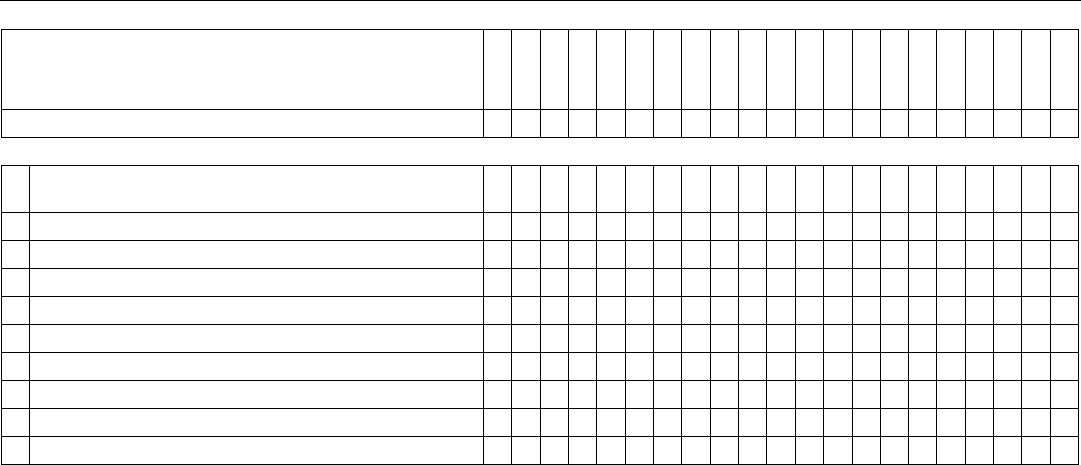
223Maintenance and owner assistance
(c.) Check wheel alignment if irregular or premature tire wear is apparent.
Service Intervals **
Miles = U.S. Cars
Kilometers = Canadian Cars
1,000
(1,600 km)
10,000
(16,000 km)
20,000
(32,000 km)
30,000
(48,000 km)
40,000
(64,000 km)
50,000
(80,000 km)
60,000
(96,000 km)
70,000
(112,000 km)
80,000
(128,000 km)
90,000
(144,000 km)
100,000
(160,000 km)
Service # 1234567891011
Chassis
R Ball joint clearance, outer and inner steering joints and
rubber boots
""""""""""
R Front suspension, rear axle mountings; retighten "
R Shock absorbers and bushes; tightness and condition """
R Tire pressure, tread depth and wear (c.) """""""""""
R Rotate tires, front to rear """"""""""
R Brake pads and discs; wear and condition """"""""""
R Brake lines and hoses """""""""""
R Brake fluid level and renewal (max. 2-year intervals) """ ! "" ! "" ! "
R Check handbrake function """""""""""
R Power steering fluid level """""""""""
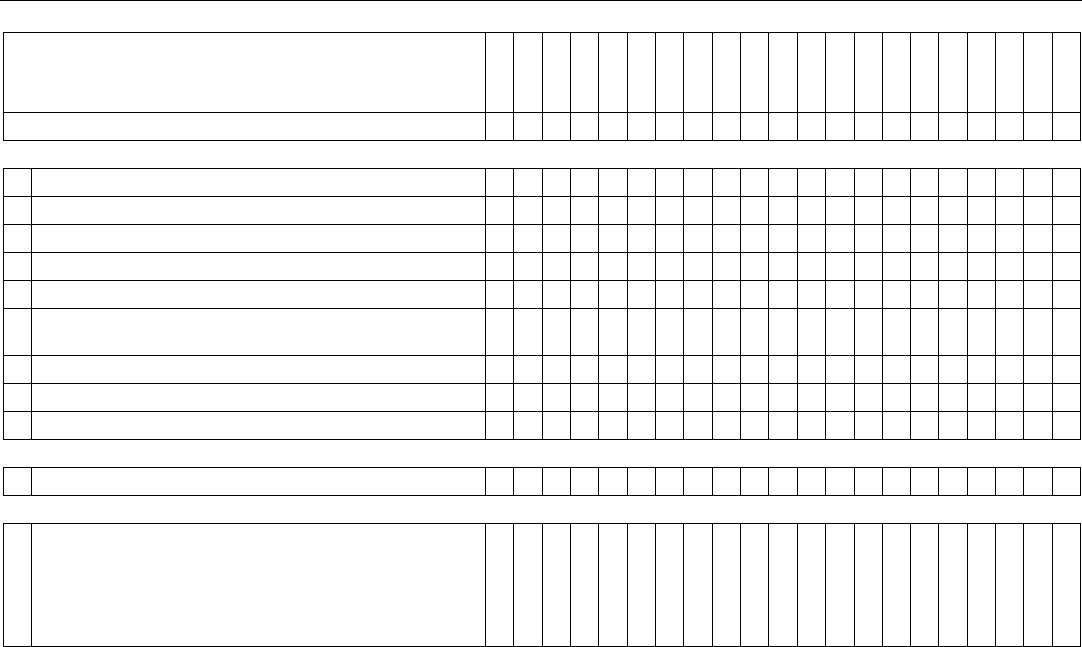
224 Maintenance and owner assistance
Service Intervals **
Miles = U.S. Cars
Kilometers = Canadian Cars
1,000
(1,600 km)
10,000
(16,000 km)
20,000
(32,000 km)
30,000
(48,000 km)
40,000
(64,000 km)
50,000
(80,000 km)
60,000
(96,000 km)
70,000
(112,000 km)
80,000
(128,000 km)
90,000
(144,000 km)
100,000
(160,000 km)
Service # 1234567891011
Chassis (cont.)
RToe-in """
R Cabin air filter !!!
R Cabin air absorptive filter !
R Door hinges, stops and locks ###
R Airbag system, SRS warning lamps, visual inspection """""""""""
R Safety belts; operation and visual inspection of belt for
tears and fraying
"""""""""""
RWipers """""""""""
R Washer system: check and top-up """""""""""
R Reset service indicator """"""""""
Customer programming
R Carry out systems programming per customer request "
Road test
R Check performance of drive train, steering and brakes
and verify tire balance.
Check function of instruments and controls, including
horn, windshield wipers, cruise control and climate sys-
tem.
Note any noises or problems for correction.
"""""""""""
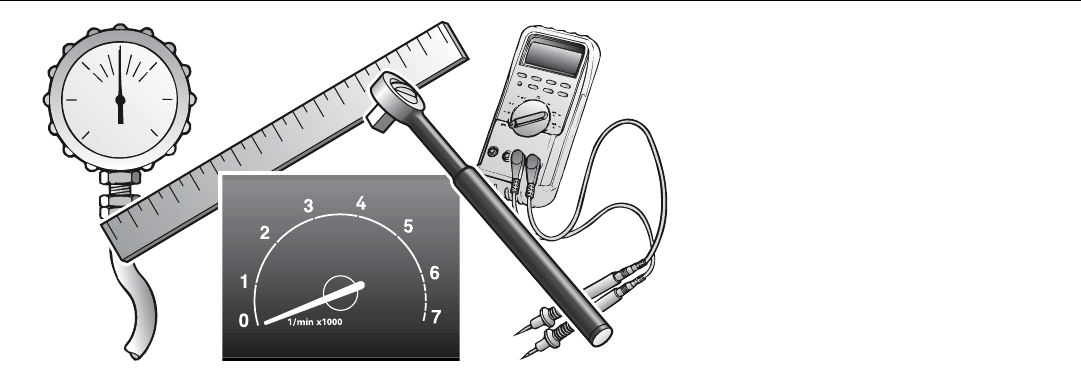
225Specifications
Specifications
General.............................. 226
Engine............................... 228
Fuel.................................... 228
Electrical system.............. 230
Drive belts......................... 231
Manual gearbox................ 231
Automatic transmission.. 232
Suspension....................... 232
Steering............................. 232
Brake system.................... 233
Wheels and tires .............. 233
Plates and labels.............. 235
IB603

226 Specifications
General
Overall length, including bumpers:
9-5 Sedan_______________________ 189.2 in (4805 mm)
9-5 Wagon ______________________ 189.3 in (4808 mm)
Overall width, including door mirrors ____ 80.4 in (2042 mm)
Maximum height:
9-5 Sedan_______________________ 57.0 in (1449 mm)
9-5 Wagon ______________________ 58.9 in (1497 mm)
Wheelbase _______________________ 106.4 in (2703 mm)
Ground clearance __________________ approx. 6.6 in
(167 mm)
Track:
Front __________________________ 59.9 in (1522 mm) *)
Rear ___________________________ 59.9 in (1522 mm) *)
Turning circle (curb to curb) ___________ 35.4 ft (10.8 m)
Turning circle (measured at vehicle extrem-
ities) ___________________________ 37.4 ft (11.4 m)
Number of seats (incl. driver) _________ 5
*)
Specified track applies to wheel sizes:
6 x 15 & 6.5 x 16
Gross vehicle weight
(GVW)
Maximum train
weight
(GVW + max. trailer
weight)
Maximum axle load,
front
Maximum axle load,
rear
Permissible load (in addition to driver) = GVW minus curb weight
The maximum permissible axle load, front or rear, must not be exceeded.
The maximum permissible axle load, front or rear, must not be exceeded.
Chassis number in engine bay
Weight ready for driving (i.e. with full fuel
tank, washer-fluid reservoir, standard
tools and spare wheel) ______________ 3470–3820 lbs.
(1575–1735 kg)
Gross vehicle weight (GVW) ___________ 4480–4750 lbs.
(2030–2155 kg)
Maximum axle load:
Front ___________________________ 2500 lbs. (1135 kg)
Rear, 9-5 Sedan___________________ 2310 lbs. (1050 kg)
Rear, 9-5 Wagon __________________ 2480 lbs. (1125 kg)
Weight distribution:
Curb weight, front/rear ______________ 60/40%
GVW, front/rear ___________________ 50/50%
Maximum roof load __________________ 220 lbs (100 kg)
IB541
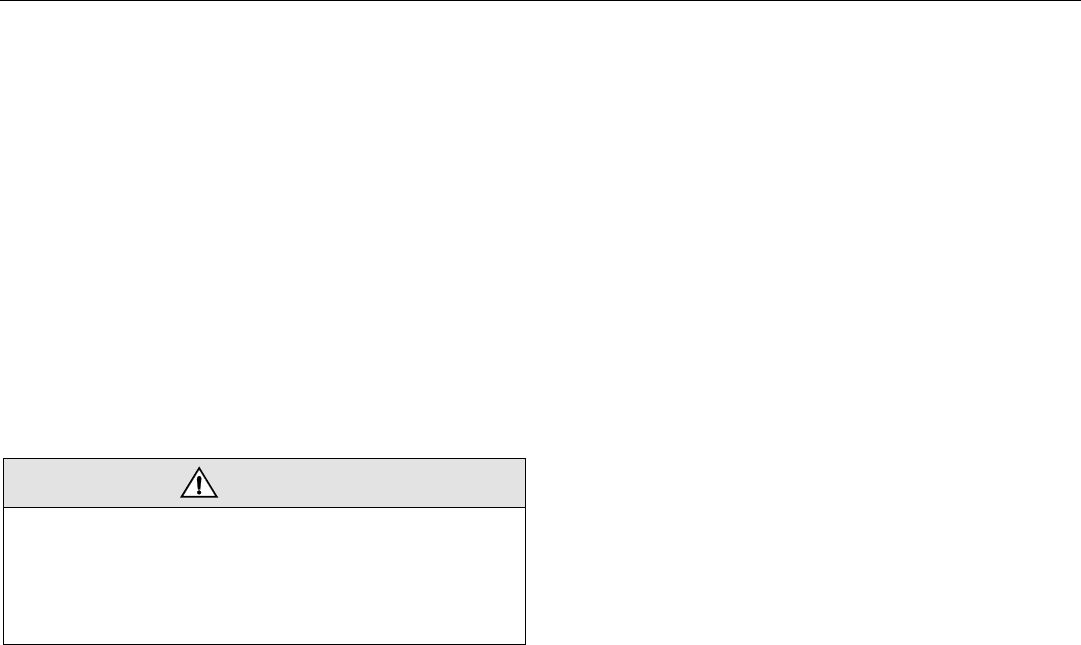
227Specifications
Trailer:
Luggage compartment
Volume (SAE):
9-5 Sedan_______________________ 15.9 cu.ft.
(450 litres)
9-5 Wagon, rear seat upright ________ 31.4 cu. ft.
(890 litres)
9-5 Wagon, rear seat folded _________ 73.0 cu. ft.
(2067 litres)
Maximum permissible luggage-compart-
ment load:
At curb weight + 4 passengers at 154 lbs.
(70 kg) _________________________ 176 lbs (80 kg)
Luggage compartment, length, 9-5 Sedan:
Rear seat upright _________________ 43.0 in (1092 mm)
Rear seat folded down _____________ 67.5 in (1714 mm)
Luggage compartment, length, 9-5 Wagon:
Rear seat upright _________________ 42.8 in (1087 mm)
Rear seat folded __________________ 61.2 in (1732 mm)
WARNING
The GVW and maximum axle loads must not be exceeded. Note
that if some accessories (e.g. towbar, CD changer) are fitted, the
available load capacity is reduced by the weight of these.
When carrying a load in the luggage compartment, make sure that
it is tied down securely, particularly when part or all of the rear seat
is folded down.
Maximum towing speed, trailer with brakes 60 mph (100 km/h)
Trailer with brakes _________________ Maximum weight:
2000 lbs (900 kg)
Trailer without brakes ______________ Maximum weight:
1000 lbs (450 kg)
Maximum load on ball hitch __________ 165 lbs (75 kg)
The above speed and weight restrictions are those specified by
Saab Automobile.
Note that local restrictions may apply to trailer speeds and
weights (see page 152).

228 Specifications
Engine Fuel
4-cylinder ________________________ Four cylinders, twin
overhead cam-
shafts, 16 valves
and two balancer
shafts.
6-cylinder ________________________ V-6 engine, double
overhead cam-
shafts on each cyl-
inder bank,
24 valves
Cylinder bores ___________________ 3.54 in (90 mm)
Stroke:
4-cylinder engine _________________ 3.54 in (90 mm)
6-cylinder engine _________________ 3.34 in (85 mm)
Swept volume:
4-cylinder engine _________________ 139.7 cu.in
(2.290 litres)
6-cylinder engine _________________ 180.6 cu.in
(2.962 litres)
Idling speed:
4-cylinder _______________________ 825 rpm
6-cylinder _______________________ 700 rpm
Antifreeze ________________________ Saab-approved
antifreeze
Coolant capacity:
4-cylinder _______________________ 7.6 qts (7.4 litres)
6-cylinder _______________________ 7.4 qts (7.2 litres)
Fuel grade ________________________ Unleaded gasoline
AON 87–93.
For optimum performance Saab recom-
mend the following fuel grades:
2.3t_____________________________ AON 90
2.3 Turbo Aero and V6-models________ AON 93 *)
*) If AON 90 is used and the ambient temperature is above
77 – 86°F (25– 30°C) some decrease in engine power can occur
to some extent.
Fuel-tank capacity __________________ 18.5 gal. (70 litres)

229Specifications
Engine oil
Oil specification
:
Oil for gasoline engines is classified in accordance with the API
standard (American Petroleum Institute) into the grade classes
SH (since 1993) and SJ (since 1996). The SJ class fulfils more
stringent requirements and has a lower level of phosphorous.
These grade classes are most often combined with the corre-
sponding classes for diesel engines. The class designations for
diesel engines begin with the letter “C” (Commercial). For exam-
ple, a grade combination suitable for both types of engine could
be API SH/CD or SJ/CF.
Under ACEA nomenclature, oils are divided into Class A for gas-
oline engines and Class B for diesel-engined passenger cars.
There is a further class for heavy diesel engines. Each class is
divided into three grades: 1, 2 and 3, where grades 2 and 3 nor-
mally encompass semi and fully-synthetic oils.
In the same way as in the API system, gasoline and diesel
engine specifications are combined for products that can be
used in both types of engine. For example, a grade designation
could be ACEA A2/B2 or ACEA A3/B3.
To afford Saab engines the best protection with regard to lubri-
cation, the ability to dissolve residues and the neutralization of
combustion products, we recommend the following oil grades:
API SH/CD/CF or SJ/CD/CF.
ACEA A2/B2 or A3/B3.
These oils contain the additives required for the engine to
function well. We advise against the use of further addi-
tives.
Viscosity
:
The viscosity of oil is classified according to the SAE standard.
Nowadays, multigrade oils are always used in car engines. The
properties of these oils facilitate starting the car in cold weather
but mean that the oil is also viscous enough to coat all moving
parts under high pressures and with high outside air tempera-
tures.
Multigrade oils are graded with two viscosities, e.g. 10W-30,
where the 10W meets certain viscosity requirements at -20°C,
while the 30 fulfils requirements at a temperature of 100°C.
Basic recommendations for Saab engines:
•SAE 10W-30 or 10W-40.
SAE 5W-30 can also be recommended but in which case the oil
must be semi of fully-synthetic and fulfil ACEA grade require-
ments A3/B3.
Oils which are less viscous, such as 0W/-40/50 are becoming
more common and may be used. However, the oil must be
fully-synthetic, of a well known brand, and fulfil ACEA grade
requirements A3/B3.
This viscosity makes starting in cold weather easier.
Oil capacity incl. filter (on changing):
4-cylinder ________________________ 4.1 qts (4.0 litres)
6-cylinder ________________________ 4.6 qts (4.5 litres)

230 Specifications
Engine variants Electrical system
2.3t Ecopower
Rating, EEC at 5500 rpm ___________ 170 hp (125 kW)
Maximum torque, EEC at 1800 rpm ___ 207.2 ft.lb
(280 Nm)
Compression ratio ________________ 9.35:1
2.3 Turbo Ecopower (“Aero“ model engine),
manual transmission
Rating, EEC at 5500 rpm ___________ 230 hp (169 kW)
Maximum torque, EEC at 1900 rpm 259.0 ft.lb.
(350 Nm)
Compression ratio ________________ 9.3:1
2.3 Turbo Ecopower, (“Aero“ model engine)
automatic transmission
Rating, EEC at 5500 rpm ___________ 230 hp (169 kW)
Maximum torque, EEC at 1900 rpm 244.2 ft.lb.
(330 Nm)
Compression ratio ________________ 9.3:1
3.0t Ecopower
Rating, EEC at 5000 rpm ___________ 200 hp (147 kW)
Maximum torque, EEC at 2100 rpm ___ 229.4 ft.lb
(310 Nm)
Compression ratio ________________ 9.5:1
Voltage ___________________________ 12 V
Battery capacity ____________________ 60 Ah or 70 Ah
Starter motor ______________________ 1.4 kW
Alternator rating ____________________ 130 A/14 V
Firing order:
4-cylinder ________________________ 1-3-4-2
6-cylinder ________________________ 1-2-3-4-5-6
Spark plugs:
2.3t ____________________________ NGK
BCPR 6ES-11
2.3 Turbo ________________________ NGK
PFR 7H-10
6-cylinder ________________________ NGK
BKR 7ES-11
Electrode gap ______________________ 0.0394 +0.00394 in
(1.0+0.1 mm)

231Specifications
Drive belts Manual gearbox
Engine variants Outside length
4-cylinder with A/C system, poly-V-belt __ 102.84 in
(2612 mm)
6-cylinder with A/C system, poly-V-belt __ 79.53 in
(2020 mm)
Drive belt, 4-cylinder with
A/C system Drive belt, 6-cylinder with
A/C system
IB542
IB543
Type _____________________________ All-synchromesh
5-speed with final
drive and differen-
tial
Oil _______________________________ Saab synthetic
manual gearbox oil
Oil capacity ________________________ 1.9 qts (1.8 litres)
Oil volume (on changing) _____________ 1.6 qts (1.5 litres)
Clutch type ________________________ Hydraulic, single
dry-plate clutch of
diaphragm-spring
type
Speed (mph / km/h) at 1000 rpm in 5th gear:
4-cylinder ________________________ 27–28 / 43–44

232 Specifications
Automatic transmission Suspension
Steering
Type ____________________________ Electronically con-
trolled 4-speed,
fully automatic with
hydraulic torque
converter, planetary
gear set and inte-
gral final drive
Lock-up function in
selector positions 3
and 4
Selector-lever positions ______________ P R N D 3 2 1
Transmission-fluid capacity, dry transmis-
sion (incl. torque converter and oil cooler) 7.5 qts (7 litres)
If fluid change required, approximately
3.5 litres can be drained through the drain
plug in the transmission casing
Transmission fluid __________________ Texaco Texamatic
Dexron III (mineral
oil based)
Clutch type _______________________ Hydraulic plate
clutches, brake
bands and one-way
couplings
Speed (mph / km/h) at 1000 rpm in 4th gear:
4- and 6-cylinder _________________ 29 / 46–47
Spring type, front and rear ____________ Coil springs
Maximum deflection of springs:
Front ___________________________ 7.09 in (180 mm)
Rear ___________________________ 7.87 in (200 mm)
Dampers, front and rear ______________ Gas-filled dampers
Steering __________________________ Power-assisted
steering of
rack-and-pinion
type; telescopic
steering-column
shaft with universal
joints
Number of turns, lock to lock ___________ 2,9
Power-steering fluid _________________ Power-steering
fluid CHF 11S

233Specifications
Brake system Wheels and tires
Footbrake (ABS) ___________________ Hydraulic disc
brakes with vacuum
servo unit. Diago-
nally split circuits;
ventilated discs on
front wheels. EBD
function, see page
146.
Handbrake _______________________ Acts on rear wheels
Brake fluid ________________________ DOT 4
Brake-fluid capacity _________________ 0.925 qts (900 ml)
Disc diameter:
Front __________________________ 11.34 in (288 mm)
Front, 9-5 2.3 Turbo Aero ___________ 12.05 in (306 mm)
Rear ___________________________ 11.26 in (286 mm)
Total friction area of brake pads:
Front __________________________ 36.3 in2 (234 cm2)
Rear ___________________________ 15.5 in2 (100 cm2)
Wheel size ________________________ 6.5 x 16 or 7 x 17
9-5 2.3 Turbo Aero___________________ Use 6.5 x 16 or
7 x 17 only
Tire size (summer tires):
6.5 x 16 wheels ___________________ 215/55 R16
7 x 17 wheels _____________________ 225/45 R17
Tire size (winter tires):
6 x 15 wheels (not 9-5 2.3 Turbo Aero)__ 195/65 R15 M+S
6.5 x 16 wheels ___________________ 205/55 R16 M+S
Recommended wheels for snow chains_ 6 x 15 (not 9-5 2.3
Turbo Aero) or
6.5 x 16
Compact spare:
Wheel___________________________ 4 x 16
Tire_____________________________ T115/70 R16
Pressure_________________________ 60 psi (420 kPa)
Maximum life _____________________ 2,200 miles
(3500 km)
Maximum speed __________________ 50 mph (80 km/h)

234 Specifications
NOTE
Snow chains
Snow chains must not be fitted to the rear wheels and must be
used on the following tire/wheel combinations:
Wheel Tire
6 x 15_________ 195/65 R15 M+S (not 9-5 2.3 Turbo Aero) or
205/65 R15 M+S (not 9-5 2.3 Turbo Aero)
6.5 x 16________205/55 R16 M+S or
215/55 R16
Max. speed is 30 mph (50 km/h).
Consult your authorized Saab dealer of approved snow chains.
NOTE
Wheels larger than 17” must not be fitted.
The wheel offset must not exceed 49 mm.
Vehicles with 12.05 in (306 mm) front brake discs must not use
15” rims.
Front-wheel alignment: toe-in, measured
between rims:
Front __________________________ 0.0585±0.0195 in
(1.5±0.5 mm)
Rear ___________________________ 0.0866±0.0585 in
(2.2±1.5 mm)
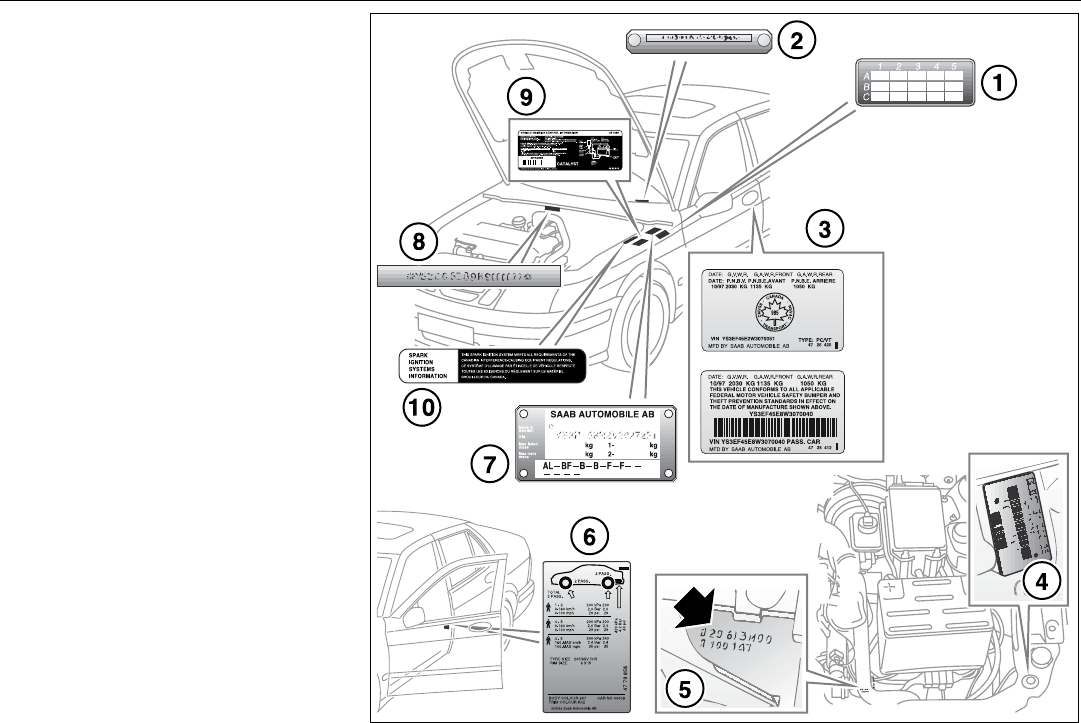
235Specifications
Plates and labels
When consulting your Saab dealer, it may be
necessary to quote the car’s V.I.N., engine
and gearbox numbers.
1 Modification identity plate.
2 V.I.N. number, inside windshield.
3 Certification label.
4 Gearbox number.
5 Engine number.
6 Tire pressures and color codes
(body & trim), label.
7 Chassis number plate.
8 Chassis number, stamped on body.
9 Vehicle Emission Control Information.
10 Spark ignition system information
(Canada only).
4728473
CANADAUS
IB1366

236 Specifications
1 Region ___________ Y = Northern Europe
2 Country __________ S = Sweden
3 Manufacturer _____ 3 = Saab Automobile AB
4 Product line ______ E = 9-5
5 Model series ______ D = 9-5 with driver’s and
passenger-side airbags
F = 9-5 SE with driver’s and
passenger-side airbags
H = 9-5 Aero with driver’s and
passenger-side airbags
M = 9-5 Griffin with driver’s and
passenger-side airbags
6 Body version _____ 4 =
5 = 4-door
5-door
7 Gearbox __________ 5 = Manual 5-speed
8 = Automatic 4-speed
8 Engine variant _____ E =
G =
Z =
2.3t
2.3 Turbo
3.0t
9 Check digit ________ 0-9/X
10 Model year ________ Y = 2000
11 Factory ___________ 3 = Trollhättan
12 Serial number ______ 000001-999999
position:1234567891011 12
||||||||||| |
V.I.N.: YS3EF48E6Y3045842
| | ||||
1 23456= identification codes for certain chassis details
IB541

237Specifications
Several of the systems in your Saab
car can be adjusted to better fit your
individual needs
Some functions are governed by legal
requirements and cannot therefore be
reprogrammed.
Consult an authorized Saab dealer for fur-
ther information.
Car alarm/central locking system:
• The sound level of the siren when locking/
unlocking, HIGH or LOW.
• The number of blinks when locking/
unlocking, 1 to 7.
• Automatic locking of the trunk when the
car is driven, 1 to 8 mph (2-14 km/h), YES
or NO.
• Preclude the unlocking of the trunk while
the car is driven, YES or NO.
• Automatic locking of the trunk after
1 second-4 minutes if it has not been
opened, YES or NO.
• Automatic locking of the trunk when it is
closed, YES or NO.
Automatic Climate Control (ACC):
• Indoor temperature can be
increased/decreased relative to the
selected temperature.
• Delayed start of fan after starting the car,
to reduce risk of fogging windshield.
• Temperature at which the defroster mode
is automatically selected.
• Response time for the fan speed when
the selected temperature is changed.
• Temperature at which the air distribution
switches from defroster mode to
defrost/floor mode.
• Last manual selection will be selected the
next time the car is started.
Saab Information Display:
• Outdoor temperature display can be
adjusted.
• Days remaining to next service can be
activated/counted or not.
• Delete “Test Brake Light“ message on
SID at start-up.
Miscellaneous:
• Select the on-time for heated rear seat.
• Coolant temperature gauge adjustment
can be increased/decreased.
• Fuel level gauge adjustment can be
increased/decreased.
• Additional sweep of the wipers after wind-
shield washer function (ON or OFF).
• Follow me home on-time can vary from 20
to 50 seconds.
• Night panel illumination deactivation
speed for the speedometer can be
adjusted.

238 Specifications
Following adjustments can be done
by the driver:
Automatic Climate Control (ACC):
To alter the preprogrammed “AUTO“ start
up mode with your own preferences you can
manually select the desired settings for:
• Temperature.
• Fan speed.
•Air distribution.
See “Programming I“ on page 73 and “Pro-
gramming II“ on page 74.
Saab 9-5 Audio System (see page 93):
• Maximum starting volume (when the
radio is switched on).
• Telephone volume (if the car is equipped
with a phone connected to the audio sys-
tem).
• Speed dependent volume (volume
increases or decreases with vehicle
speed).
• Loudness.
Alarm system:
The glass breakage sensor can be tempo-
rarily disabled, see page 39.
Daytime Running Lights:
To disable, turn off the ignition and pull out
fuse 35, see page 194.

239Specifications
Afterheater, V6-engine cars
The afterheater enables a comfortable temperature to be main-
tained inside the car even after the engine has been switched off.
The heater can be activated up to 10 minutes after the engine has
stopped, although the coolant temperature must be at least 40°C for
the heater to operate.
To start the heater:
1 The ignition should be OFF.
2 Press and hold the AUTO button on the ACC panel for about a
second, until a chime is sounded and the following appears on
the SID:
”AFTERHEATER
ACTIVATED”.
After five seconds, the SID will indicate how much heat is available
(0 – 100%).
To switch off the heater:
1 Press the OFF button on the ACC panel.
The heater will also be switched off if the ignition is turned ON.
The following settings will be in force when the heater is running:
• Air distribution in AUTO mode.
• Recirculation not active but can be selected manually.
• Fan speed is automatic and cannot be changed.
• Only the fan speed is shown on the display. If AUTO is pressed,
the system selections will be indicated.
The following controls do not operate while the afterheater is on:
• Rear-window heating.
• ECON.
• User presets.
Some of the functions can be reprogrammed. For further informa-
tion, please consult your Saab dealer (see page 237).

240 Specifications

241Index
Index
A
A/C system, fault diagnosis ________ 206
A/C system, maintenance _________ 206
ABS brakes ____________________ 146
ACC ___________________________ 67
ACC functions ___________________ 70
ACC, automatic climate control ______ 67
ACC, calibration _________________ 75
ACC, condensation _______________ 76
ACC, programming _______________ 73
ACC, useful tips _________________ 75
Adjusting the steering wheel _______ 107
Adjustment, seats _______________ 102
Afterheater, V6-engine cars _______ 239
Air conditioning (A/C),
fault diagnosis and maintenance __ 206
Air distribution, ACC ______________ 72
Airbag _________________________ 23
Alarm __________________________ 38
Alarm functions __________________ 41
Alarm signals _________________ 38, 41
Alternator ______________________ 179
Alternator drive belt __________ 179, 231
Alternator rating _________________ 230
Anticorrosion treatment ___________ 211
Antidazzle rear-view mirror ________ 109
Ashtrays ______________________ 112
Audio System ___________________ 77
Audio System, quick guide _________ 79
Autochecking of lights on starting ____ 52
Automatic climate control (ACC) _____ 67
Automatic transmission,
technical data _________________ 232
B
Battery ________________________ 177
Battery charging/replacing _________ 178
Battery, boost starting ____________ 160
Belt guide ______________________ 12
Boost starting using jump leads ____ 160
Booster cushion __________________ 21
Brake and clutch fluid ____________ 175
Brake-fluid reservoir _____________ 175
Brakes, technical data ____________ 233
Bulbs, changing _________________ 182
Bulbs, table of __________________ 191
C
CD changer _____________________ 89
CD player ______________________ 87
CHECK messages _______________ 58
CHECKING _____________________ 58
Calibration, ACC _________________ 75
Cancelling the programmed settings __ 73
Car alarm _______________________ 38
Car care _______________________ 165
Car phone, installation _____________ 98
Cargo net, 9-5 Wagon ____________ 123
Carpeting, care of _______________ 208
Cassette player __________________ 84
Catalytic converter,
important considerations _________ 133
Central locking ___________________ 32
Change language in SID ___________ 60
Change of address notification _____ 220
Changing a wheel _______________ 203
Changing bulbs _________________ 182
Changing the coolant _____________ 175
Changing the wheels round ________ 199
Changing wiper blades ___________ 180
Chassis number _________________ 235
Chassis number, key to ___________ 236
Child safety _____________________ 18
Child safety locks, rear doors _______ 35
Child seat, integral ________________ 21
Cleaning, engine bay _____________ 210
Clock _______________________ 59, 60
Colour code, body _______________ 235
Colour code, trim ________________ 235
Compact spare wheel ____________ 202
Condensation, ACC _______________ 76
Coolant _______________________ 174
Coolant, changing _______________ 175
Cruise control __________________ 145
Cup holder _____________________ 115
D
DICE/TWICE ___________________ 193
Dampers ______________________ 232

242 Index
Date code, tires _________________ 201
Dim-dipped beam ________________ 61
Direction indicators _______________ 62
Door handles ____________________ 32
Door mirrors ___________________ 108
Doors, locks & luggage compartment _ 31
Drive belt ______________________ 231
Drive belt, alternator _____________ 179
Drive belts _____________________ 231
Drive belts, length _______________ 231
Driver’s seat, programmable _______ 104
Driving in hot weather ____________ 151
Driving with a load _______________ 157
E
Electric heating seat _____________ 106
Electric heating, front seats ________ 106
Electric windows ________________ 110
Electrical system, technical data ____ 230
Electrically heated rear seat _______ 106
Electronic starting interlock _________ 33
Emergency operation of sunroof ____ 112
Emission control systems _________ 169
Engine bay, 4-cyl ________________ 167
Engine bay, 6-cyl ________________ 168
Engine bay, cleaning _____________ 210
Engine number _________________ 235
Engine oil, grade ________________ 229
Engine, description __________ 170, 171
Engine, technical data ____________ 228
Engine, temperature gauge _________ 53
Engine-oil level, checking _________ 171
Expansion tank, coolant __________ 174
F
Fault codes, Audio System _________ 99
Flat spot, tire ___________________ 206
Fluid level, automatic transmission __ 173
Folding the rear seat, 9-5 Sedan ____ 116
Folding the rear seat, 9-5 Wagon ___ 119
Follow-me-home function __________ 61
Frequently asked questions on airbag 26
Front fog lights ___________________ 63
Frost warning ____________________ 55
Fuel __________________________ 134
Fuel consumption ________________ 54
Fuel filler flap ___________________ 126
Fuel gauge _____________________ 53
Fuel grade _____________________ 228
Fuse box under hood ____________ 196
Fuse panel _____________________ 192
Fuses _________________________ 192
G
Gearbox number ________________ 235
Gearbox oil, checking ____________ 173
Gearbox, technical data, __________ 231
Glove compartment ______________ 113
H
Handbrake _____________________ 162
Hazard warning lights _____________ 63
Head restraint __________________ 104
Headlight flasher _________________ 61
Headlights ______________________ 61
Holidaying abroad _______________ 213
Hood _________________________ 166
Horn __________________________ 107
I
Immobilizer _____________________ 33
Indicator and warning lights _________ 46
Indicator lights ___________________ 46
Instrument illumination _____________ 62
Instruments and controls ___________ 45
Integral child seat ________________ 21
Interior equipment _______________ 101
Interior lighting ___________________ 64
Interior rearview mirror ___________ 108
K
Key ___________________________ 32
Key to chassis number ___________ 236
L
Labels __________________________ 8
Leather upholstery, care of ________ 208

243Index
Light horn ______________________ 61
Light switches ___________________ 61
Luggage-compartment lighting ______ 64
M
Main instrument panel _____________ 46
Main/dipped beam ________________ 61
Maintenance schedule ___________ 218
Manual gearbox, technical data ____ 231
Maxi fuses _____________________ 193
Milometer ______________________ 52
Motoring abroad ________________ 213
N
Night Panel _____________________ 59
O
Oil capacity, engine ______________ 228
Oil change, engine ______________ 172
Oil specification _________________ 228
OnStar ________________________ 100
Outdoor temperature ______________ 54
Owner assistance _______________ 219
P
Paintwork, touching-in ____________ 210
Parking lights ____________________ 61
Plates and labels ________________ 235
Poly-V-belt _____________________ 179
Power steering _________________ 176
Power-steering fluid ______________ 176
Programming I, ACC ______________ 73
Programming II, ACC _____________ 74
Programming the ACC ____________ 73
Q
Questions on function of airbag ______ 26
Quick guide, Audio System _________ 79
R
Radio __________________________ 82
Rear fog light ____________________ 62
Rear seat, 9-5 Sedan, folding ______ 116
Rear seat, 9-5 Wagon, folding ______ 119
Rear-seat head restraints _________ 105
Rear-view mirror, antidazzle _______ 109
Rearview mirrors ________________ 108
Reclamation ___________________ 213
Refuelling _____________________ 134
Relay panel ____________________ 195
Remote control __________________ 32
Remote-control battery, changing ____ 35
Reporting safety defects __________ 220
Reprogramming of systems _______ 237
Reservoir, power-steering fluid _____ 176
Rev counter _____________________ 52
Reversing lights __________________ 63
Roof load ______________________ 155
Running-in _____________________ 149
S
SID ____________________________ 54
SRS (airbag) ____________________ 23
SRS, supplementary restraint system _ 23
Saab 9-5 Audio System ____________ 77
Saab Information Display (SID) ______ 54
Safety belts _____________________ 12
Safety belts, care of ______________ 207
Safety-belt pretensioners ___________ 12
Safety-belt reminder ______________ 12
Seats _________________________ 102
Securing a load __________________ 36
Selector lever indication,
automatic transmission ___________ 54
Service costs ___________________ 219
Service information ______________ 220
Service intervals ________________ 218
Service record retention __________ 219
Settings, seats __________________ 102
Side airbags _____________________ 28
Signalling, horn _________________ 107
Sliding floor, 9-5 Wagon __________ 124
Snow chains ___________________ 150
Spare wheel ____________________ 202
Spare wheel and tools ____________ 126
Spark plugs ____________________ 230
Speed rating ___________________ 198
Speedometer _________________ 52, 53

244 Index
Starting in cold weather, ACC _______ 73
Starting in hot weather, ACC ________ 73
Steering wheel adjustment ________ 107
Steering, technical data ___________ 232
Stone-chip damage, repairing ______ 210
Storage compartments ___________ 113
Sun visors _____________________ 112
Sunroof _______________________ 111
Suspension ____________________ 232
Suspension, technical data ________ 232
Switches _______________________ 61
Systems, adjustment _____________ 237
T
TCS OFF _______________________ 51
Table of fuses __________________ 194
Tachometer _____________________ 52
Tailgate, opening _________________ 36
Tank gauge _____________________ 53
Technical data __________________ 225
Temperature control, ACC _________ 69
Temperature gauge, engine ________ 53
Temperature zones, ACC __________ 69
Textile carpeting ________________ 208
Through-load hatch ______________ 118
Tie Downs _____________________ 118
Tightening torque, wheel studs _____ 203
Tire markings ______________ 198, 199
Tire pressure _______________ 157, 198
Tires _____________________ 198, 233
Tools _________________________ 126
Touching-in the paintwork _________ 210
Towbar attachment ______________ 152
Towbar load ____________________ 153
Towing the car __________________ 158
Towing, automatics ______________ 158
Traction _______________________ 147
Trailer weights __________________ 227
Trionic ________________________ 169
Trip computer ___________________ 54
Trip meter ______________________ 52
Trunk _________________________ 116
Trunk lid, opening ________________ 36
Turbo, points to note _____________ 132
U
Under the hood, 4-cyl ____________ 167
Under the hood, 6-cyl ____________ 168
Upholstery and trim ______________ 208
Upholstery and trim, care of _______ 208
Useful tips, ACC _________________ 75
V
Vanity mirrors __________________ 112
Ventilated front seats _____________ 105
Viscosity, engine oil ______________ 228
W
Warning labels ____________________ 8
Warning light, AIR BAG ____________ 26
Warning lights ___________________ 46
Washers ______________________ 180
Washers, windshield _____________ 181
Washing the car _________________ 209
Waxing and polishing ____________ 209
Wear indicators, tires _____________ 200
Wheels and tires ____________ 198, 233
Wheels and tires, sizes ___________ 233
Window-glass sensor, car alarm _____ 39
Windshield washers _______________ 65
Windshield wipers ________________ 65
Wiper blades, headlamp __________ 180
Wiper blades, replacing ___________ 180
Wipers and washers __________ 65, 180
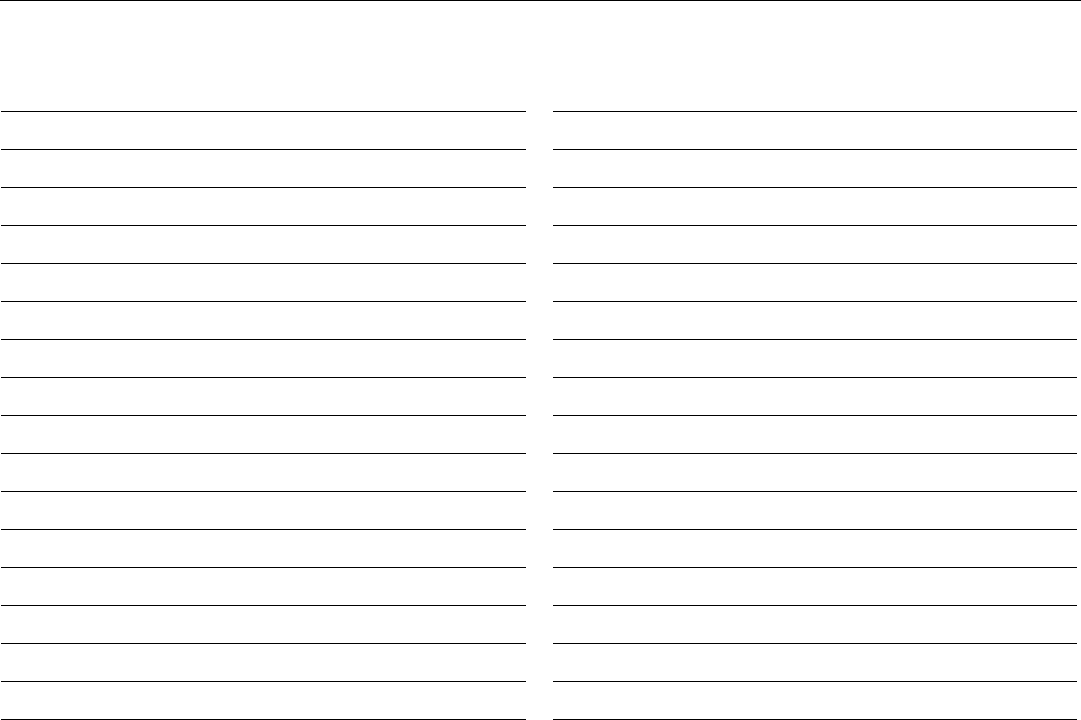
245Notes
Notes
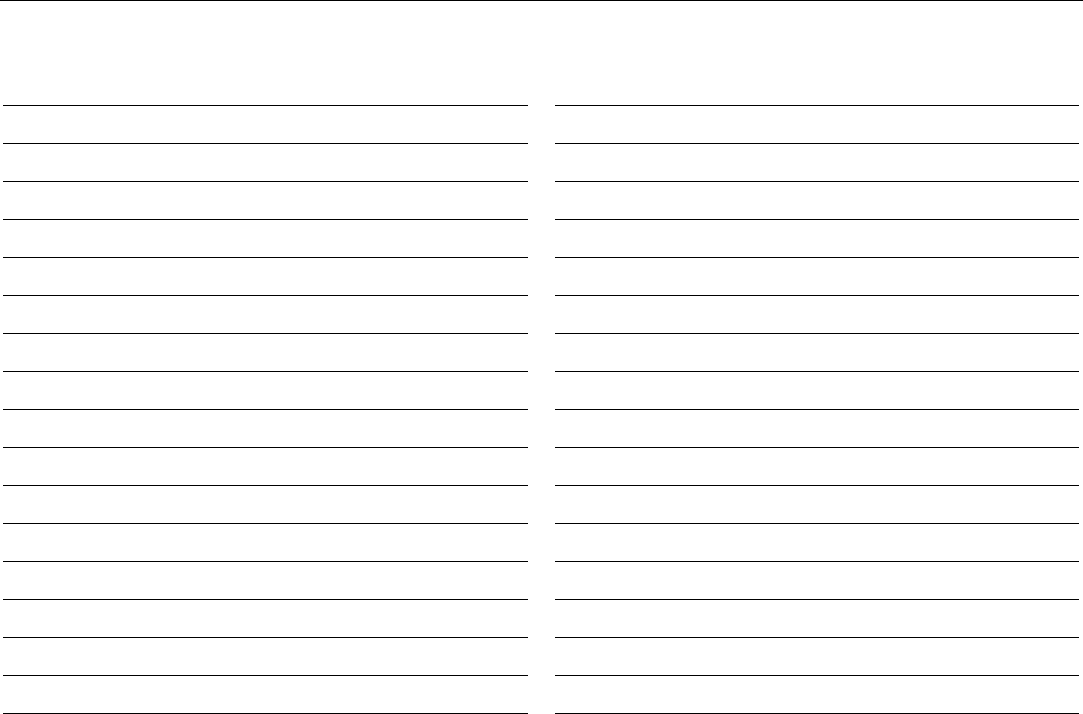
246 Notes
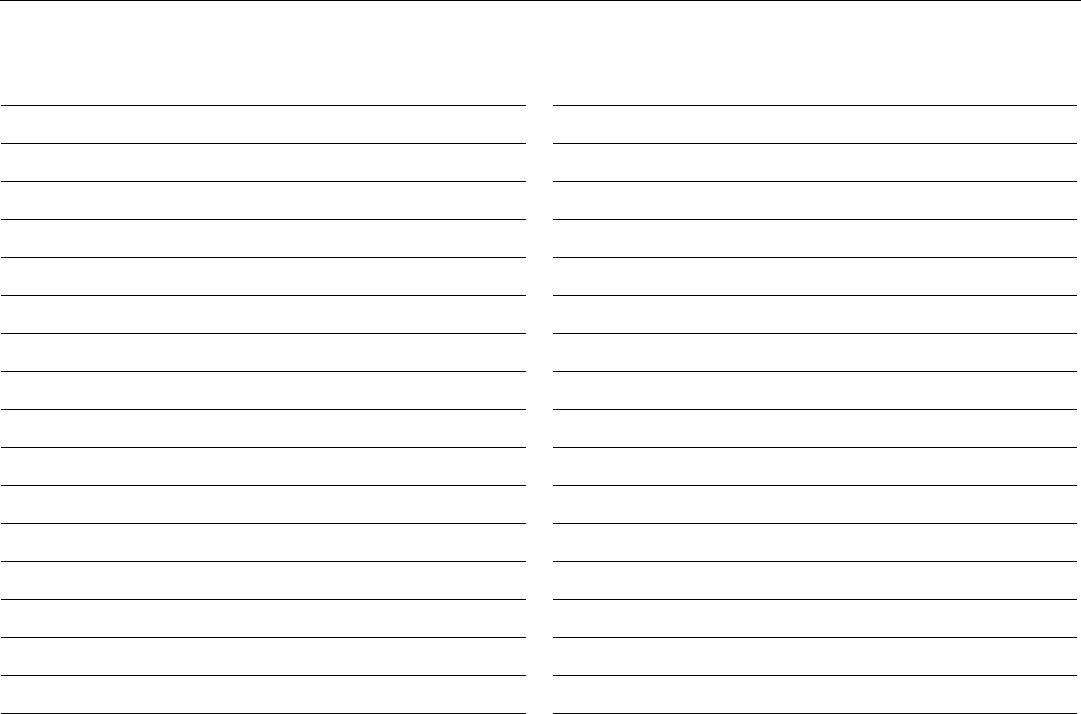
247Notes
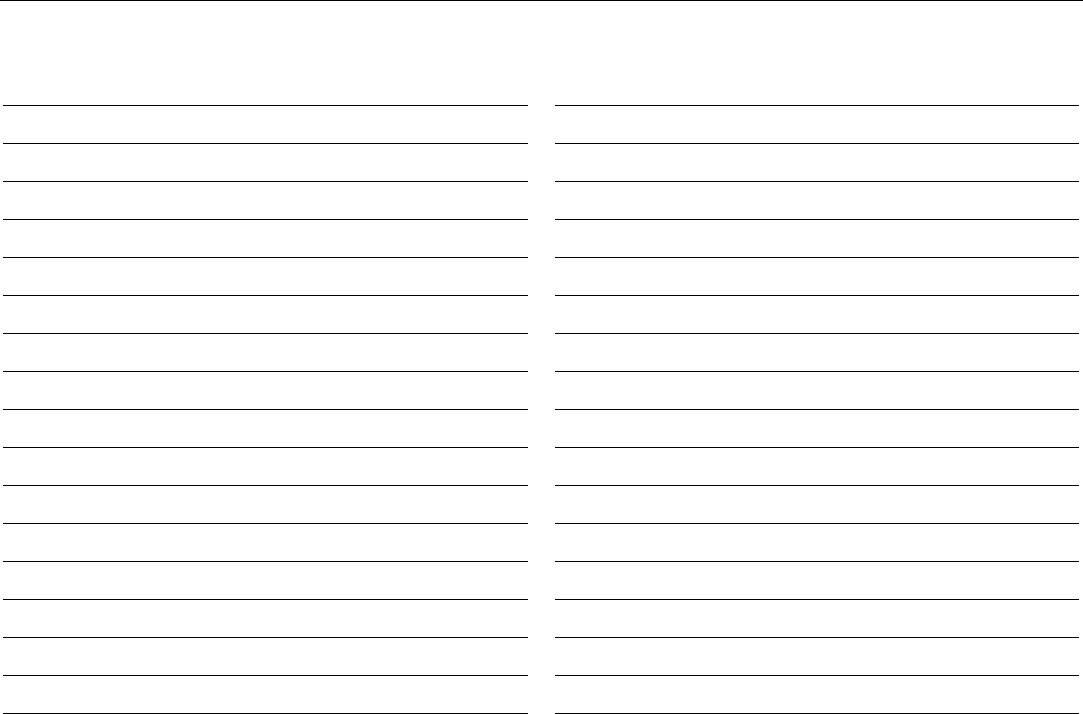
248 Notes

249Notes
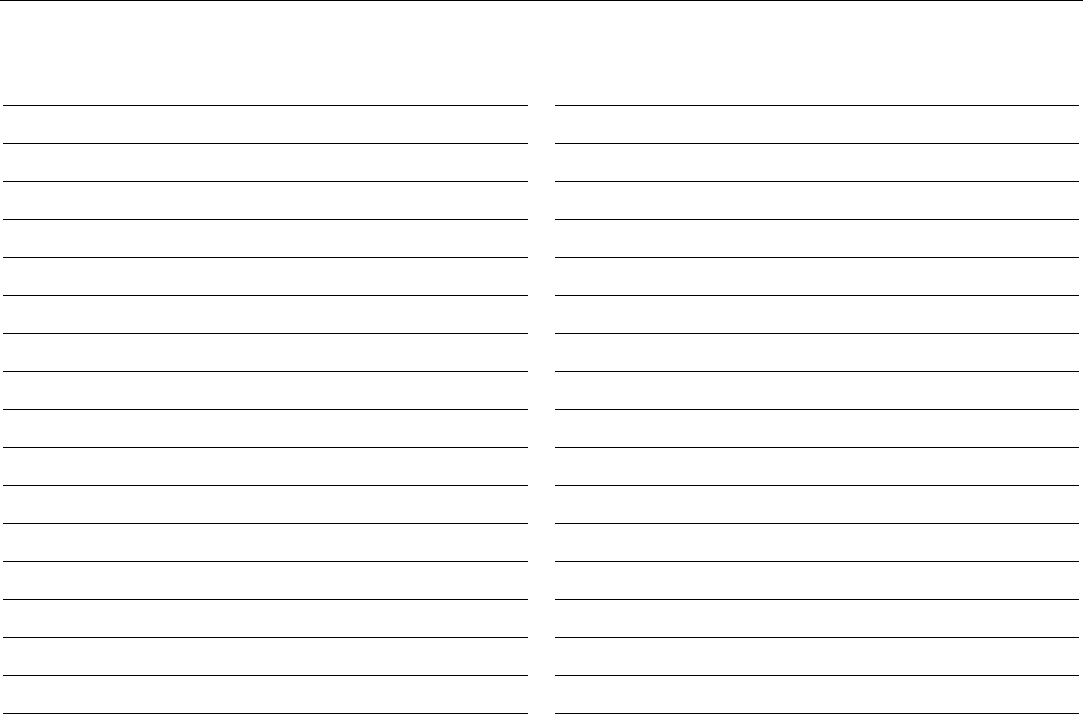
250 Notes
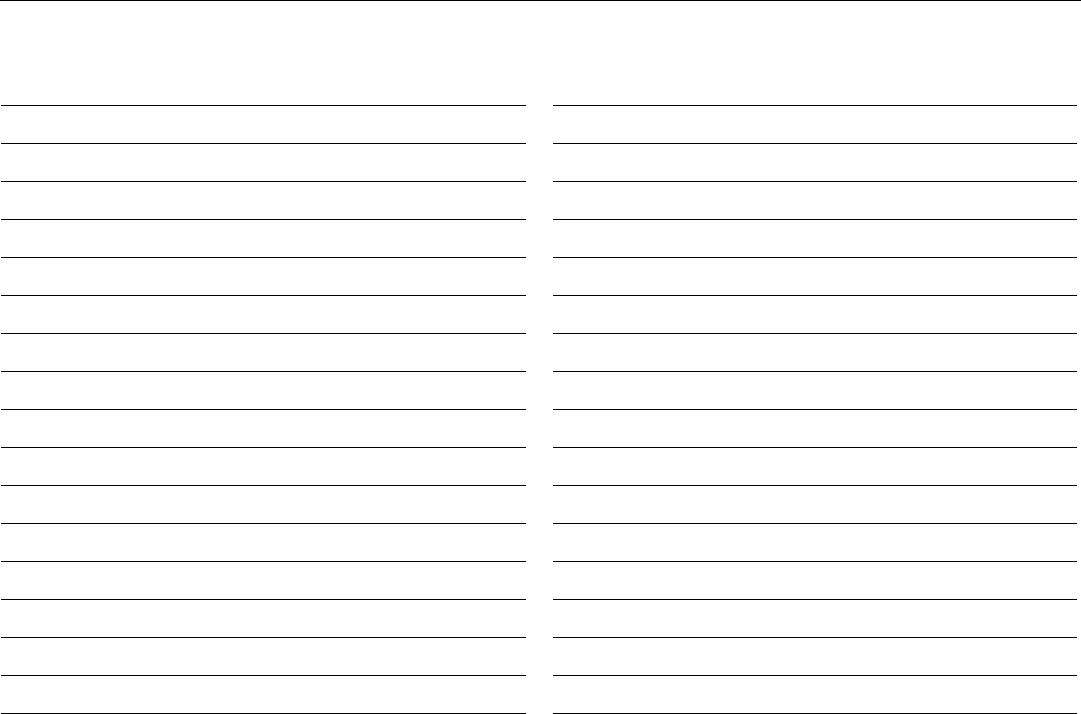
251Notes
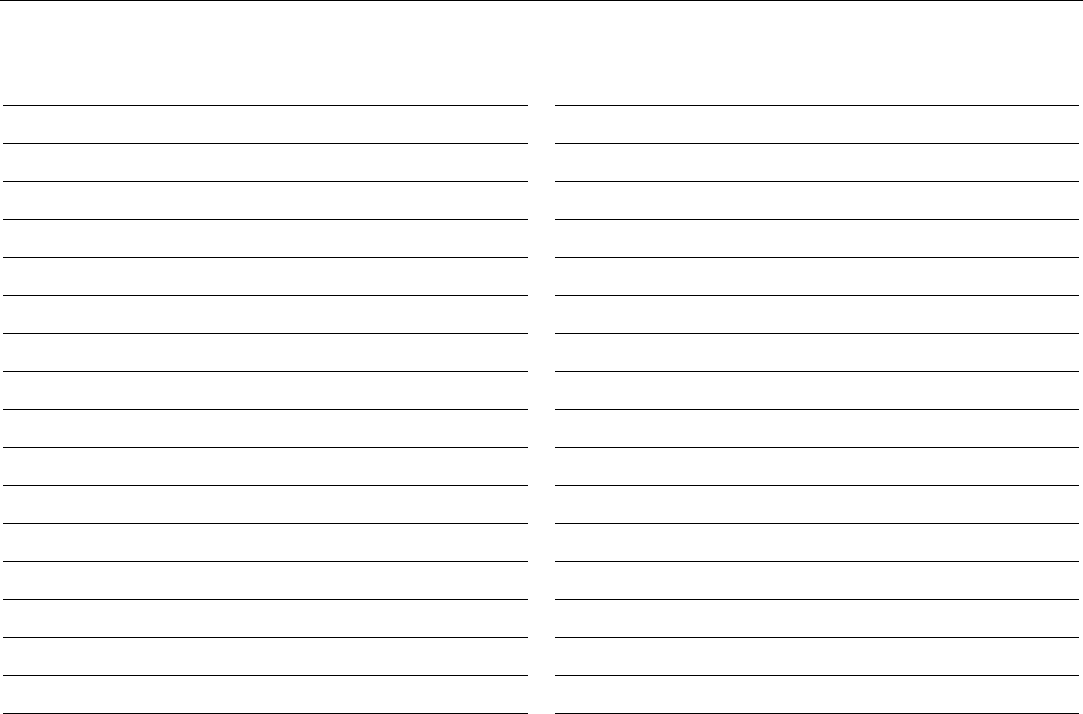
252 Notes
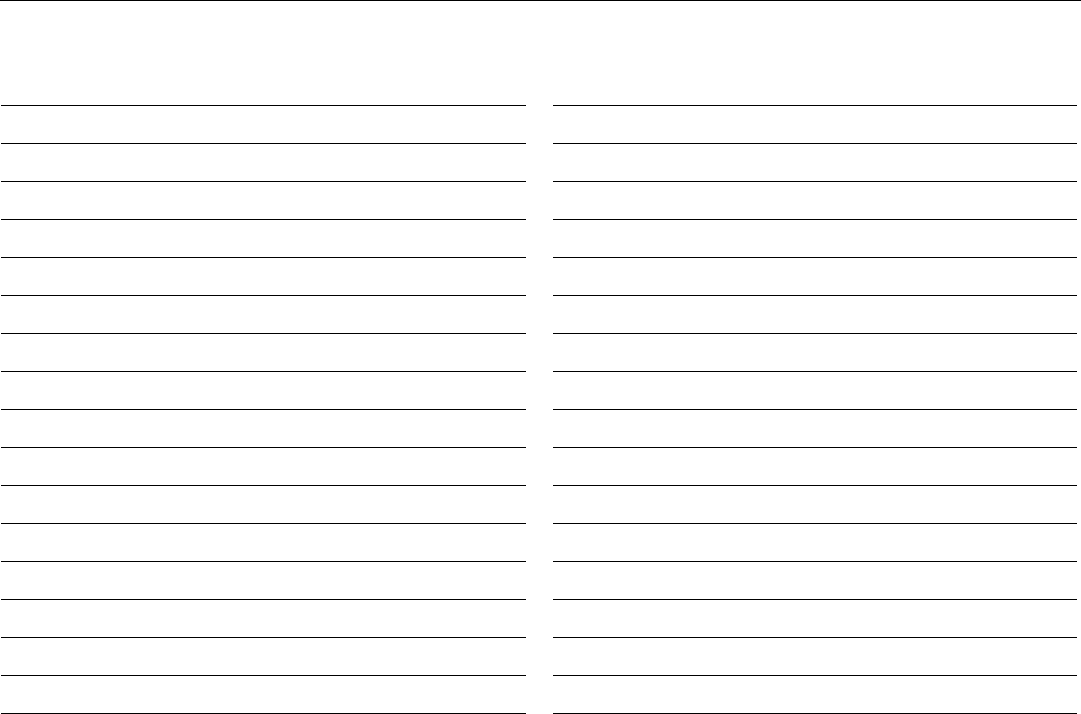
253Notes
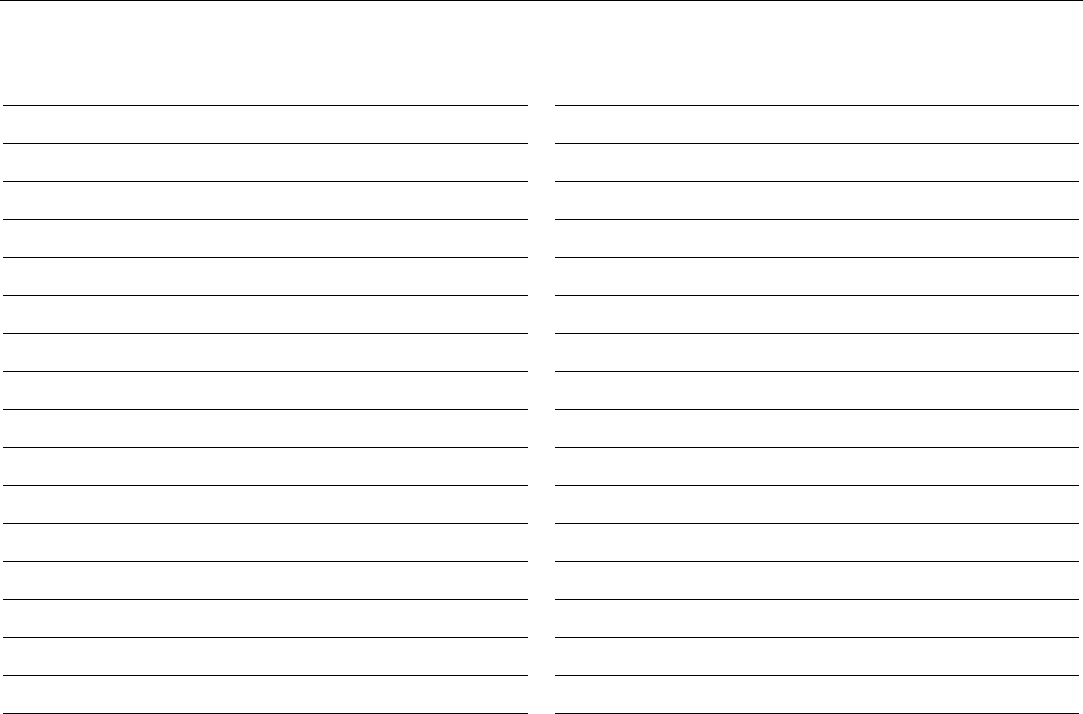
254 Notes
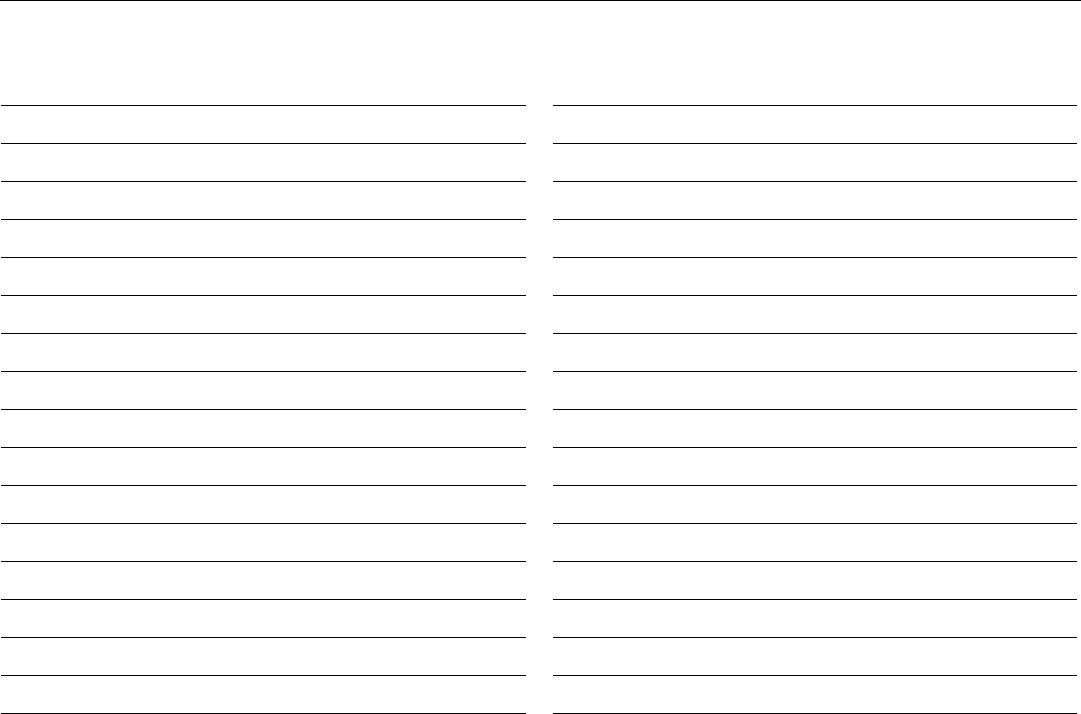
255Notes

256 Notes

